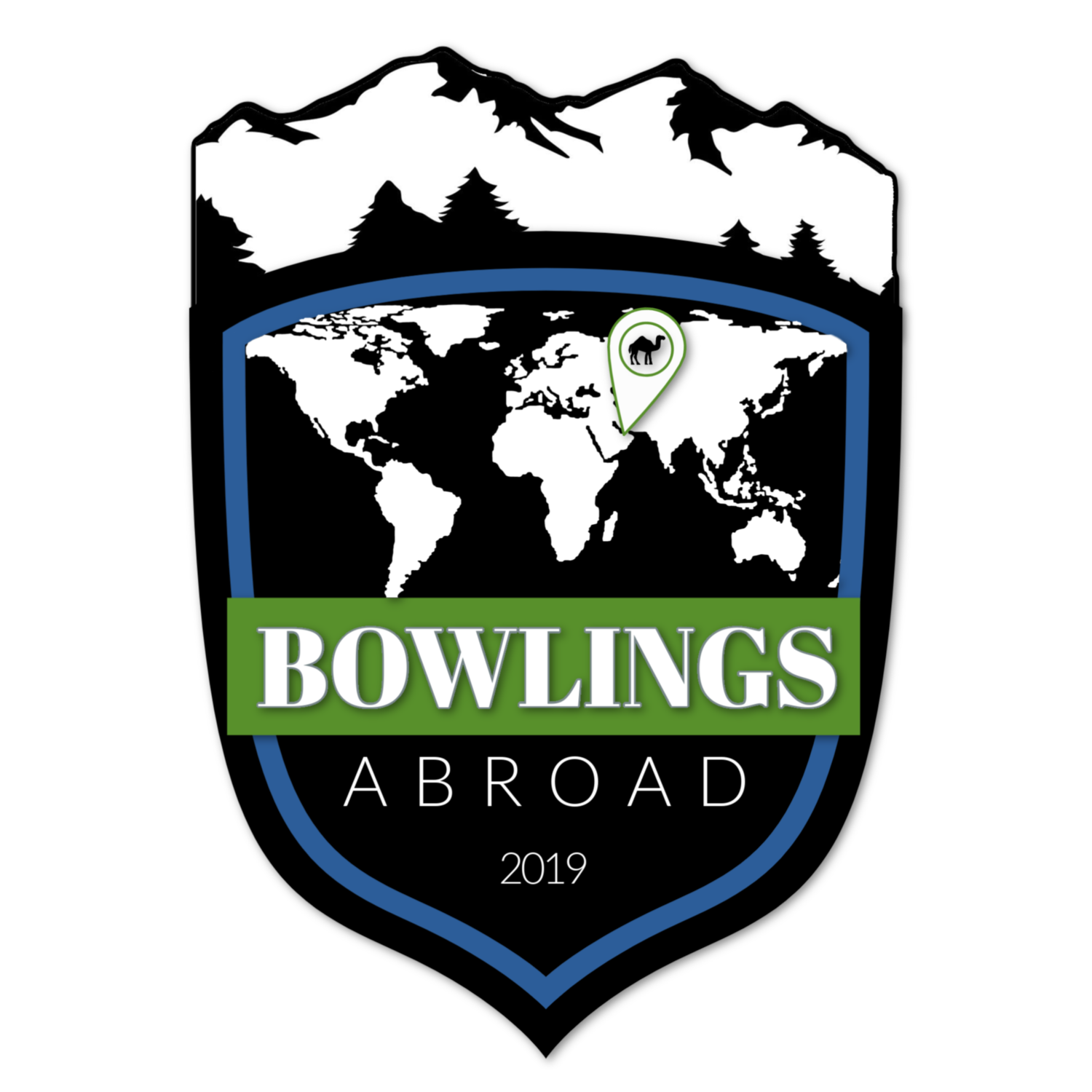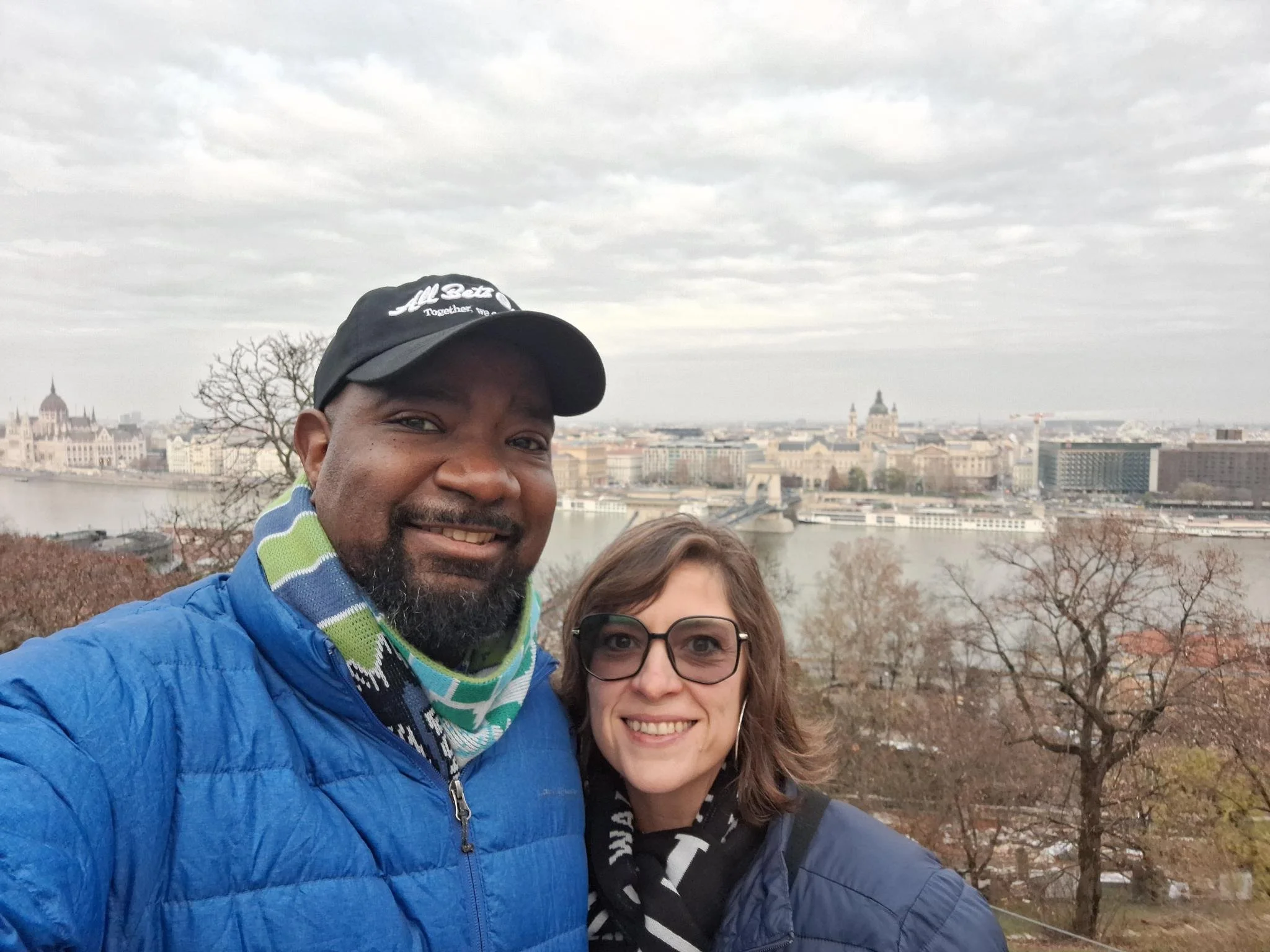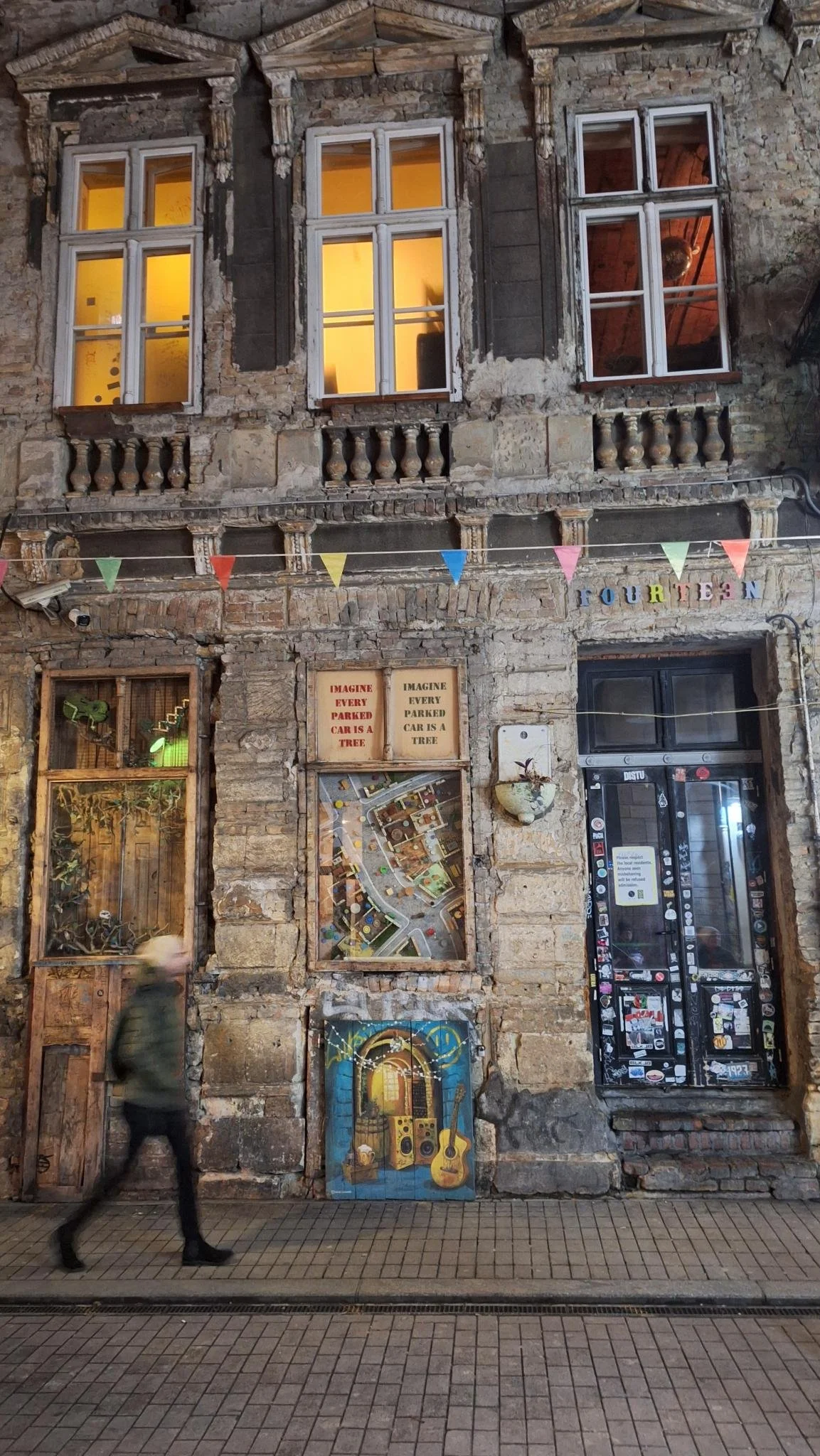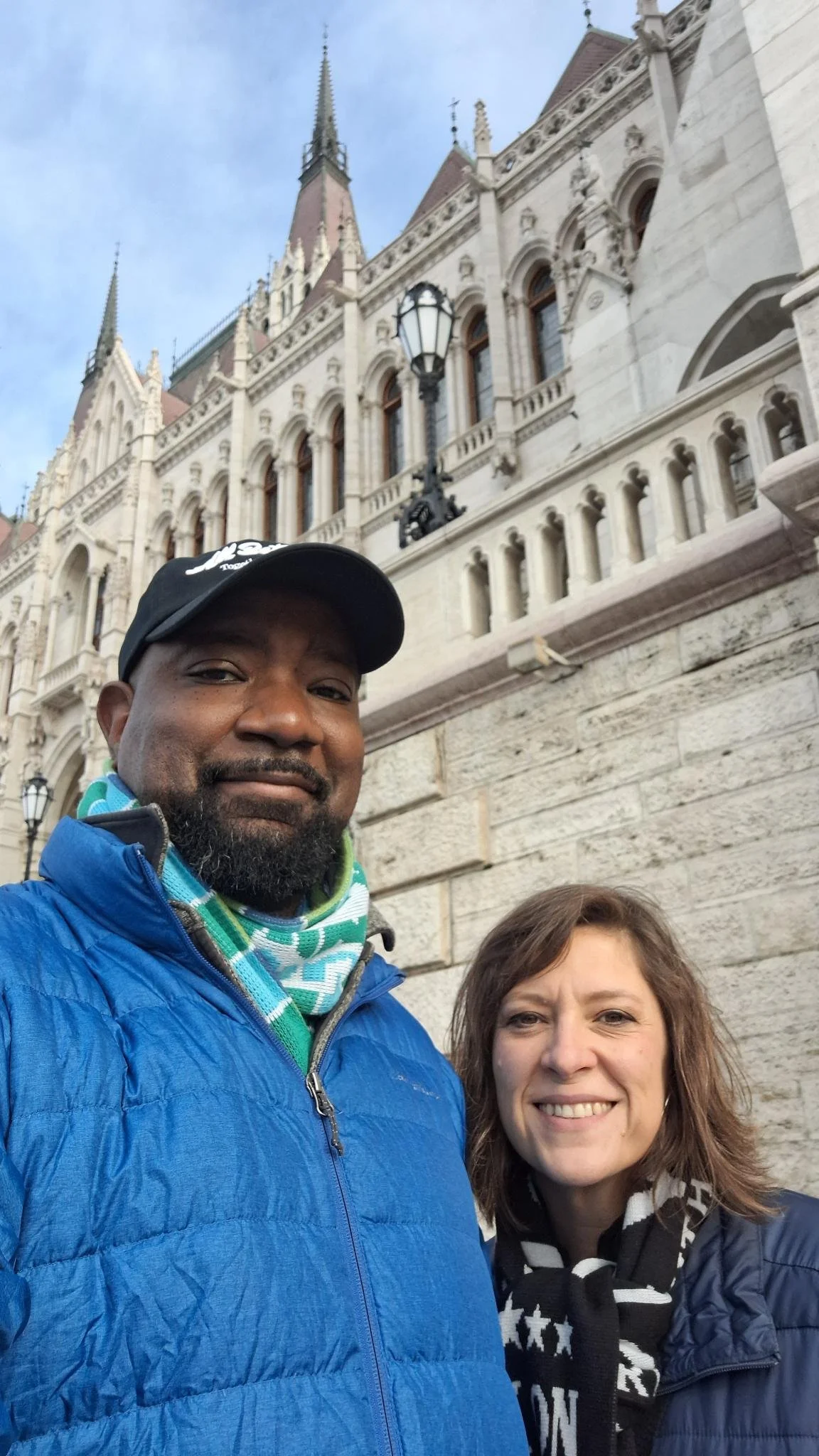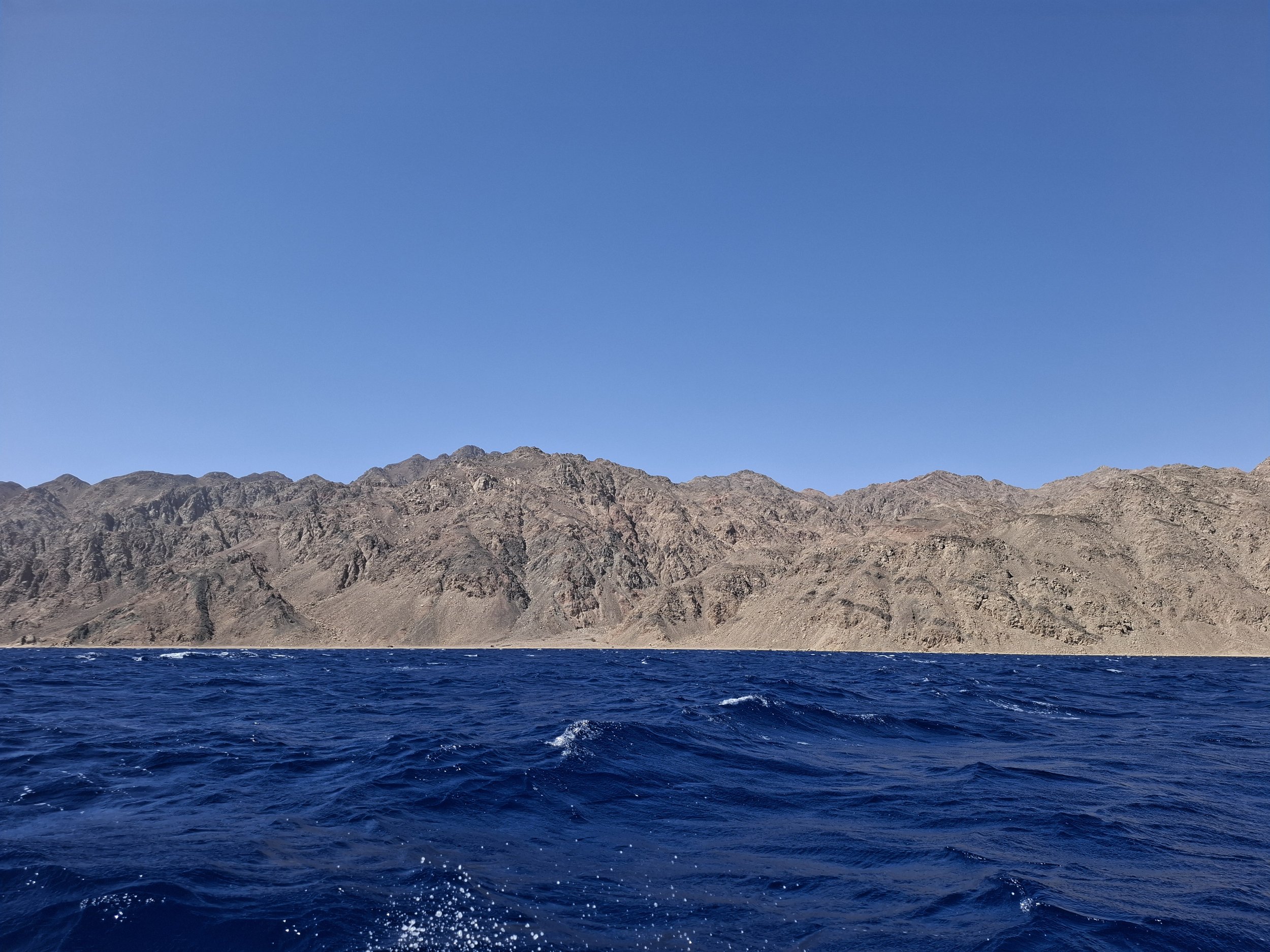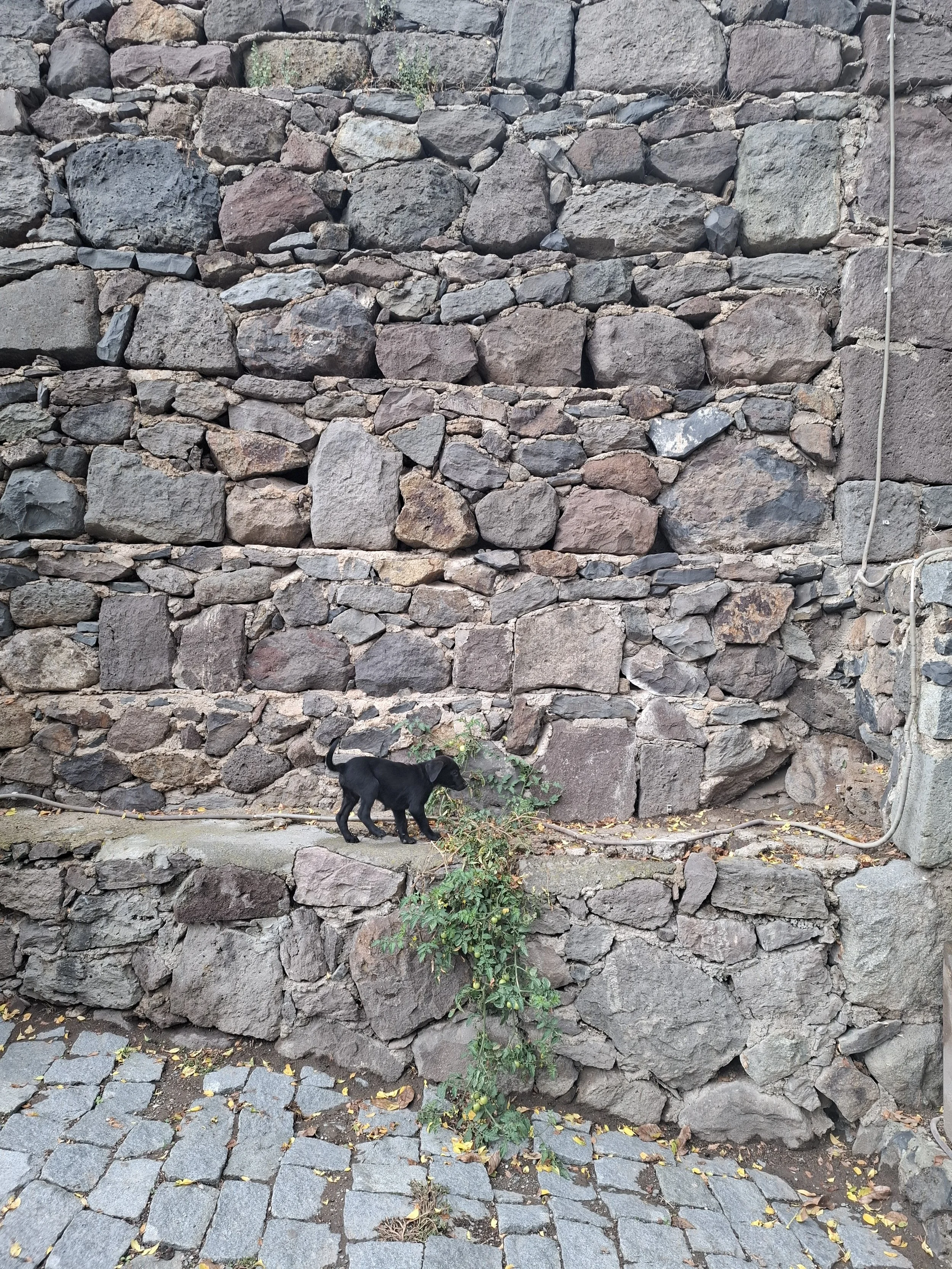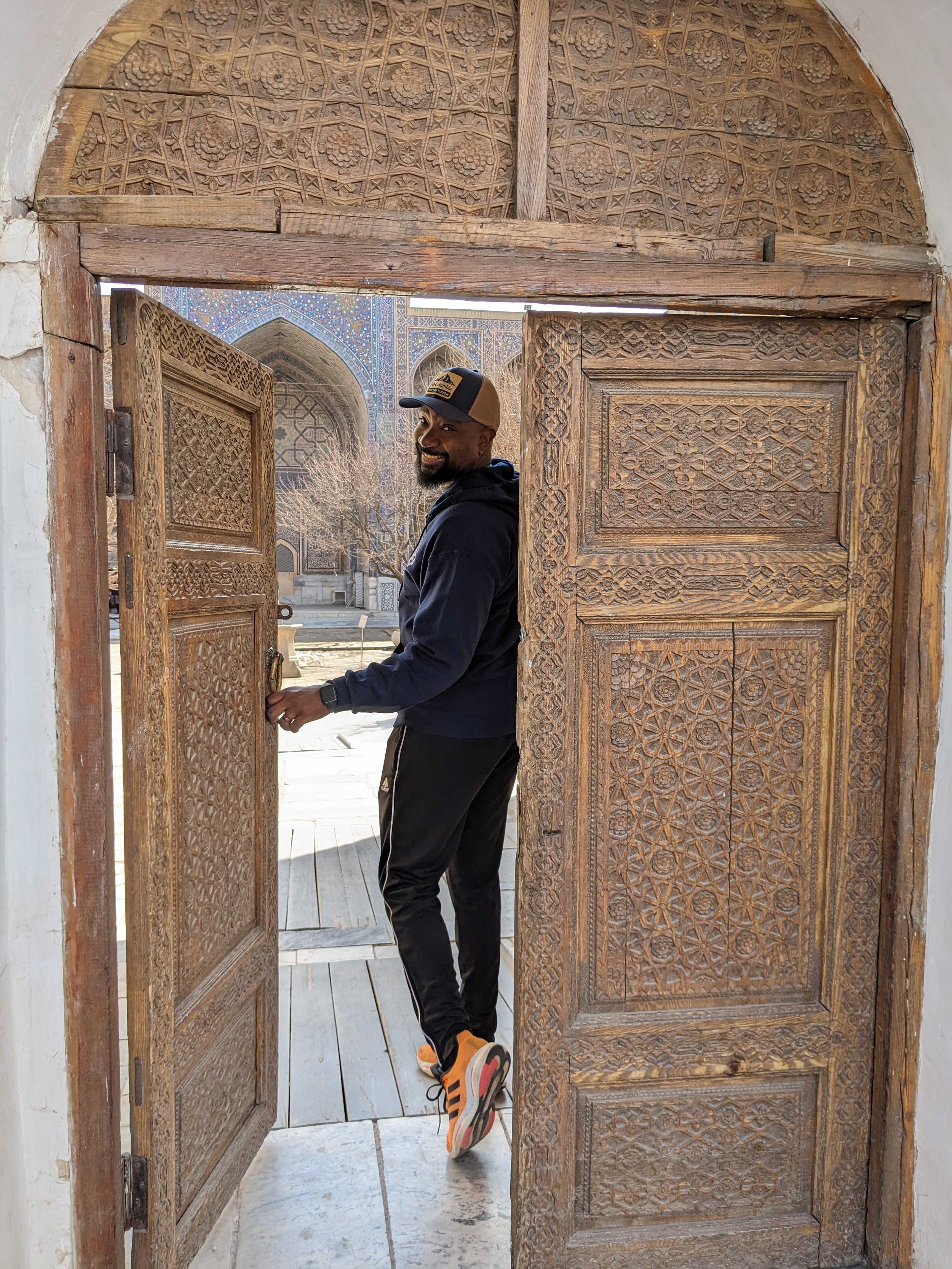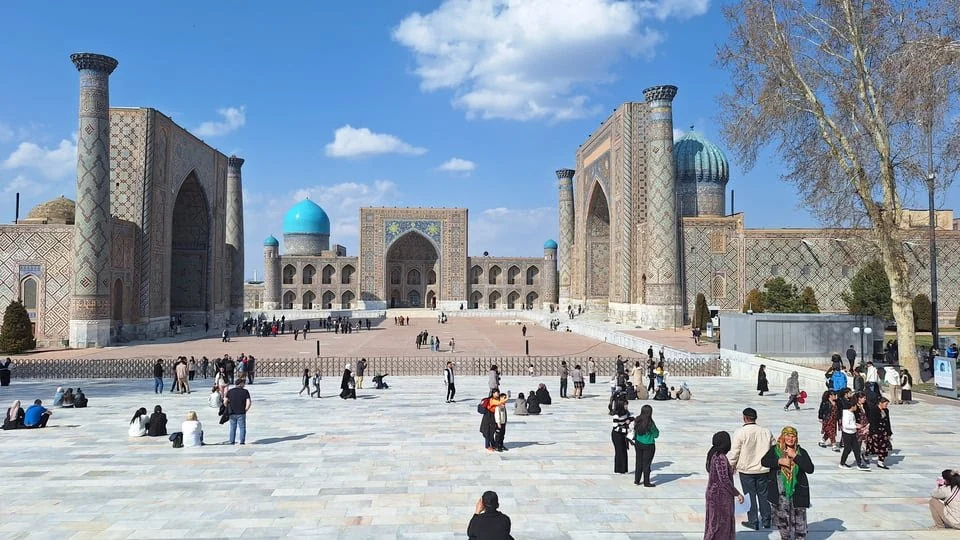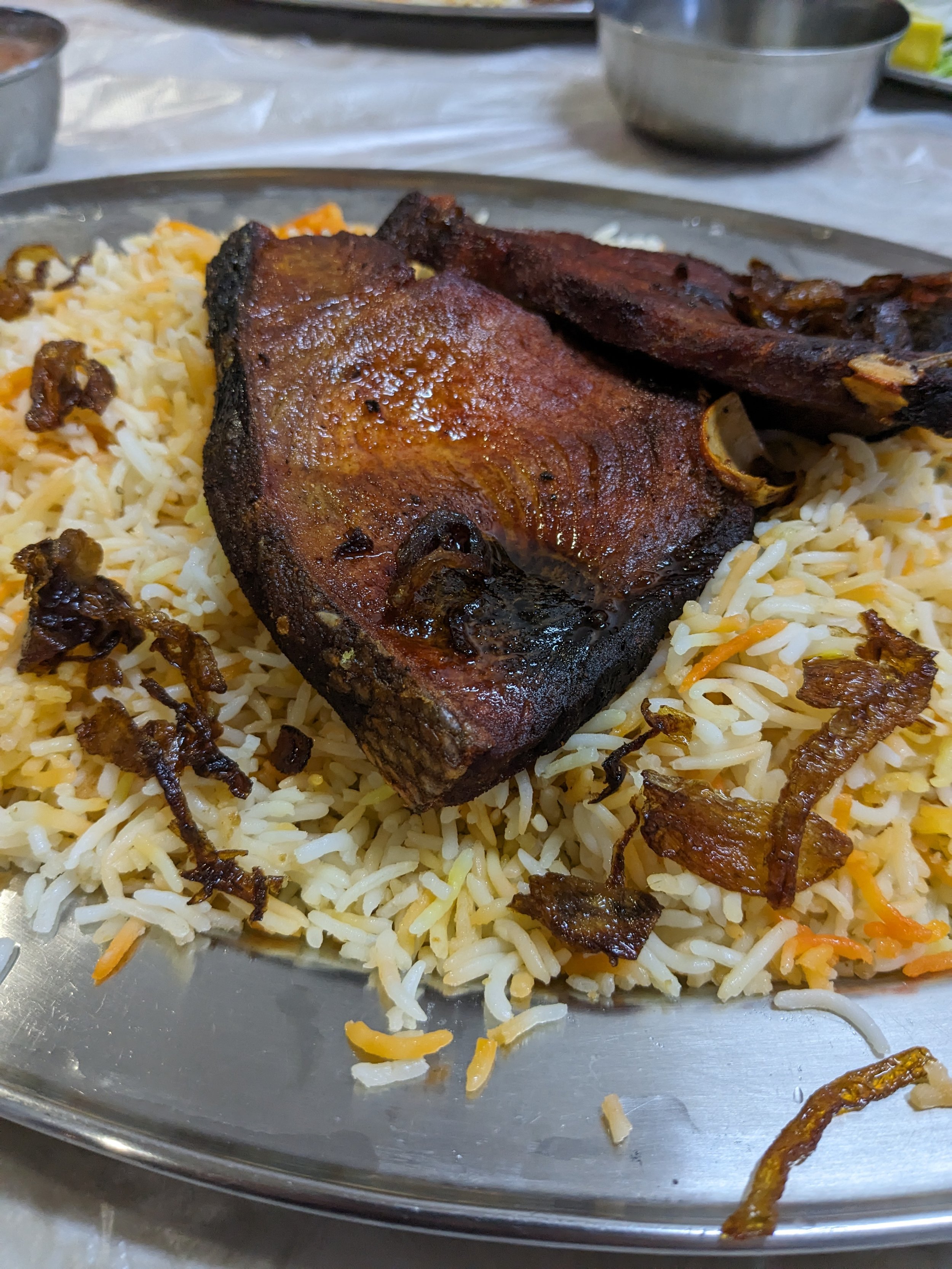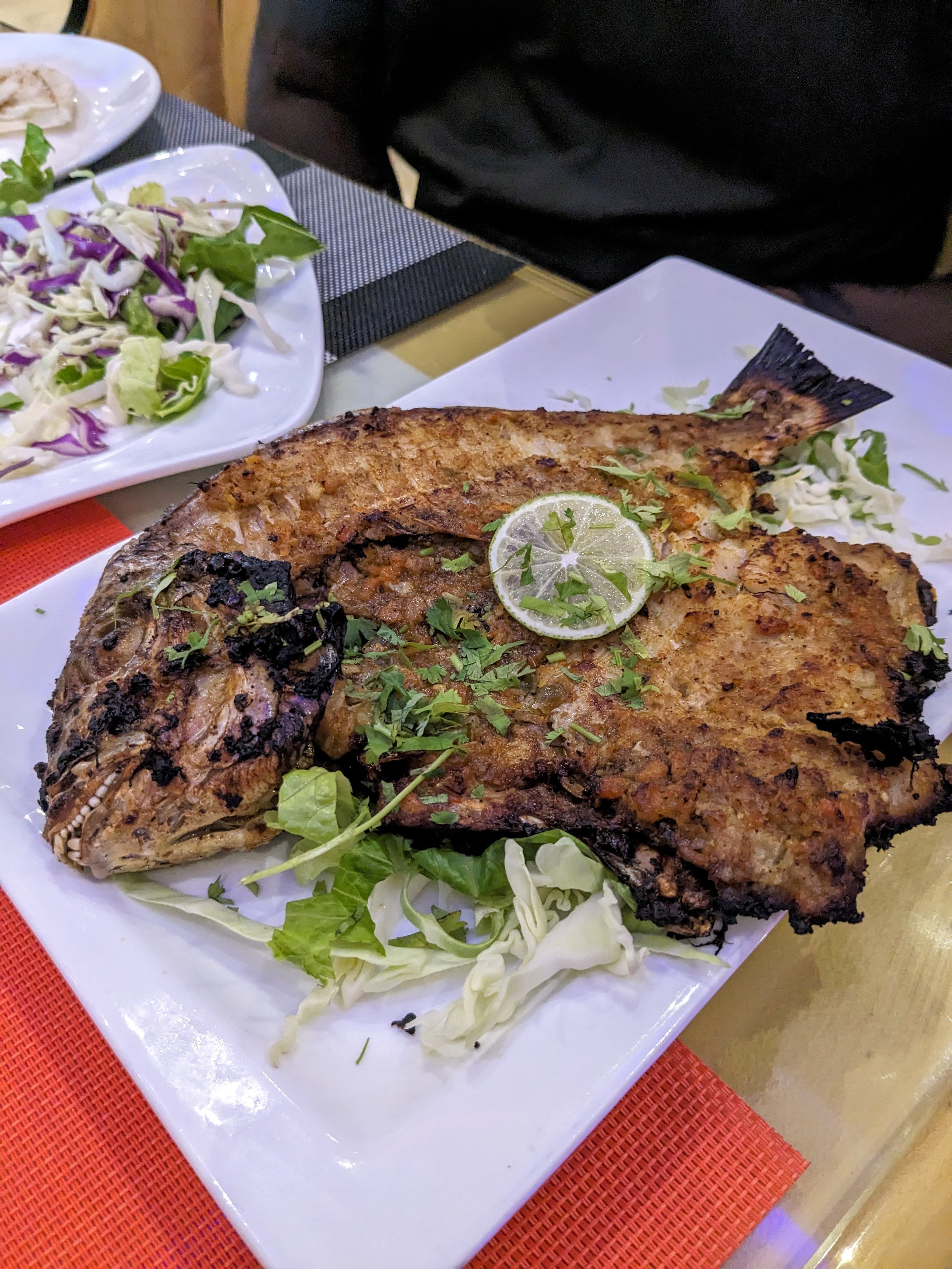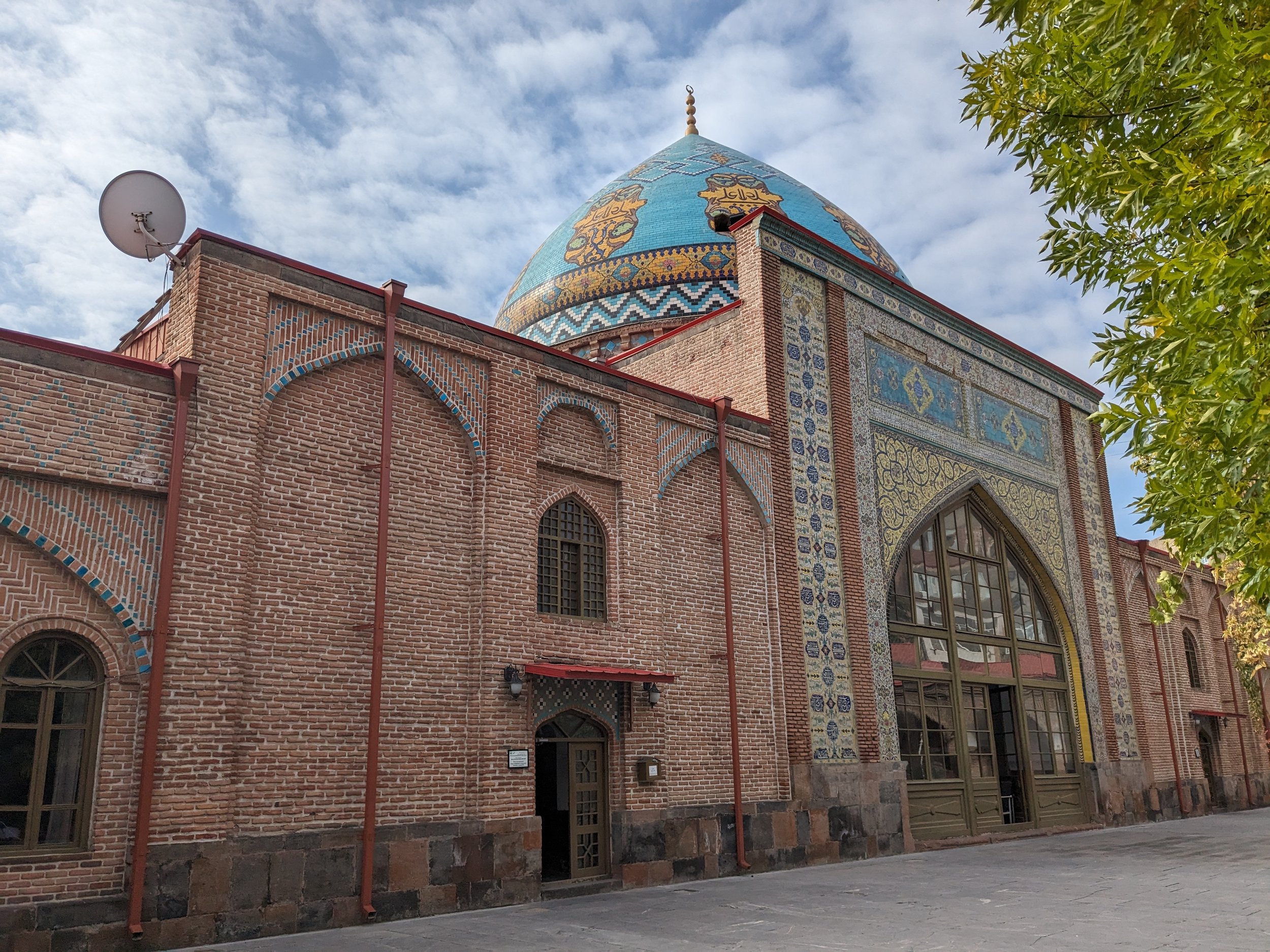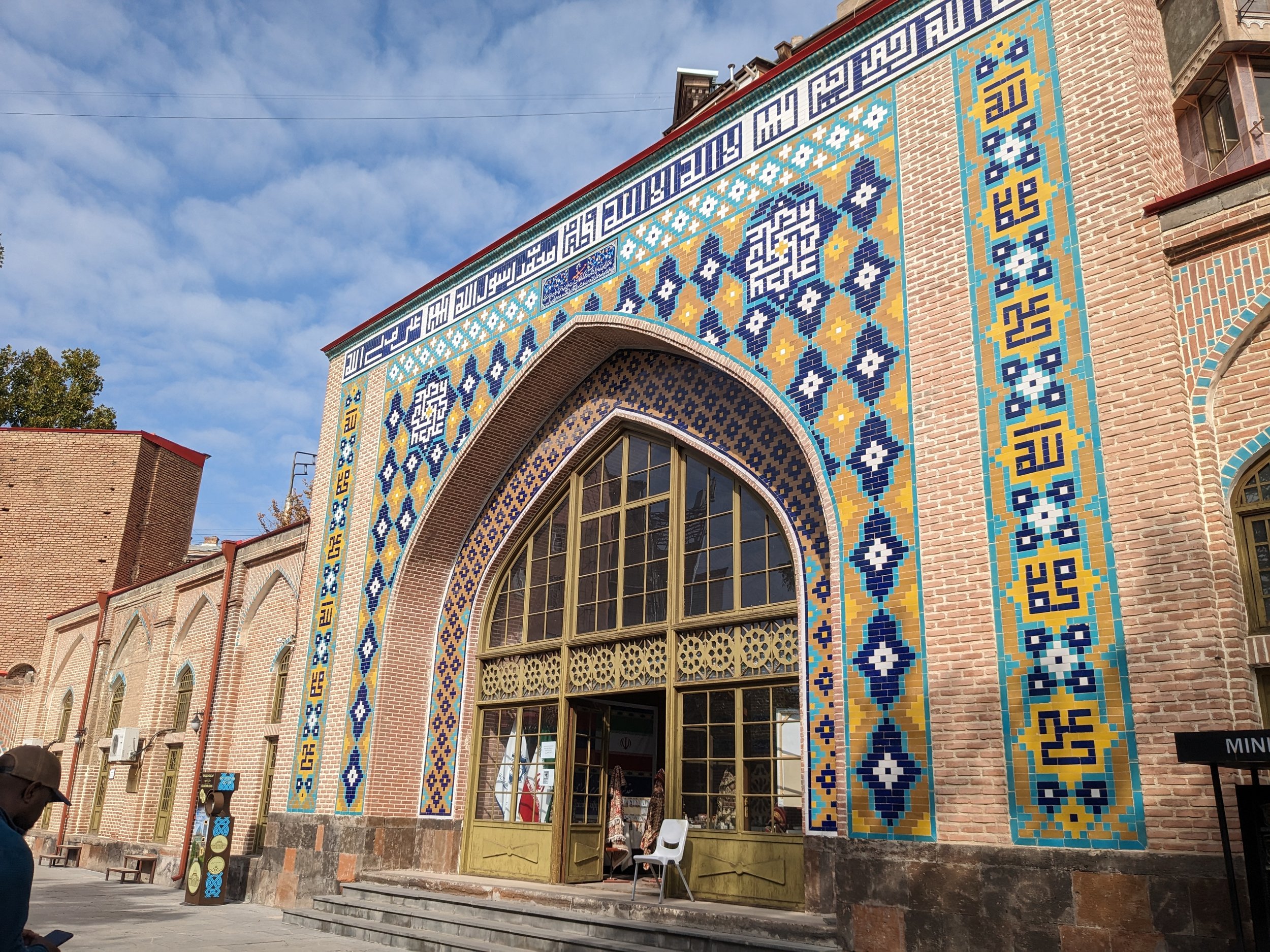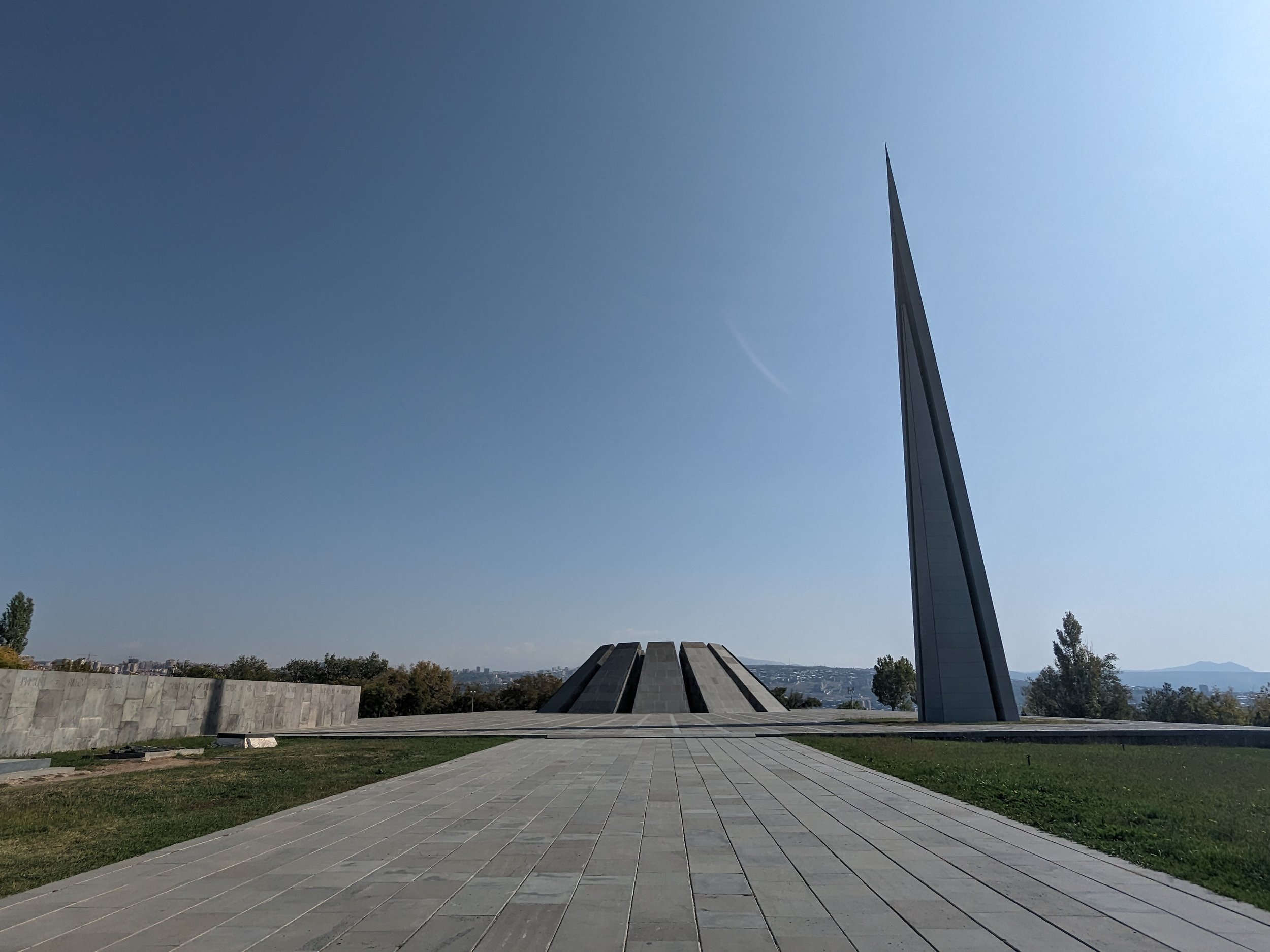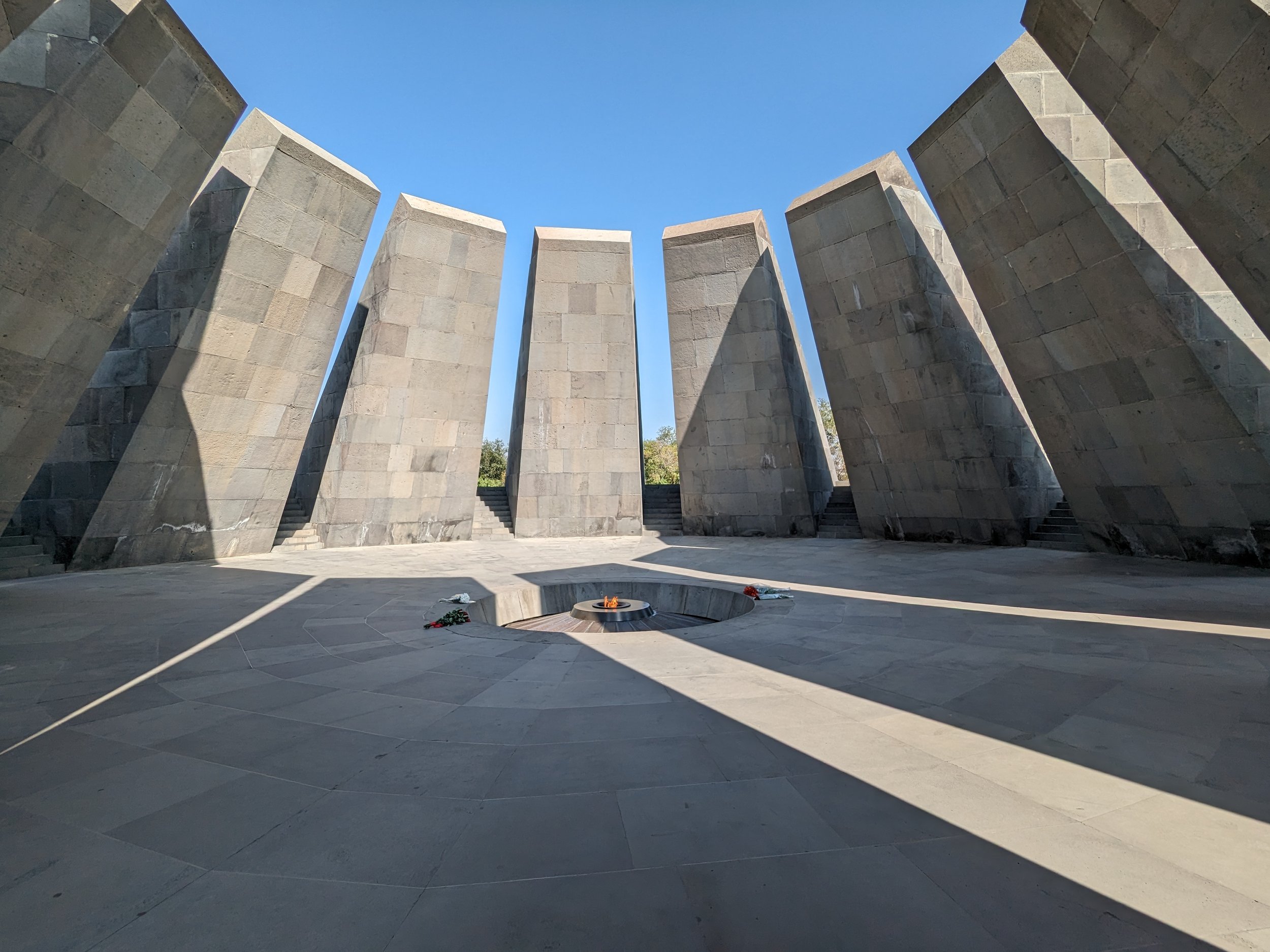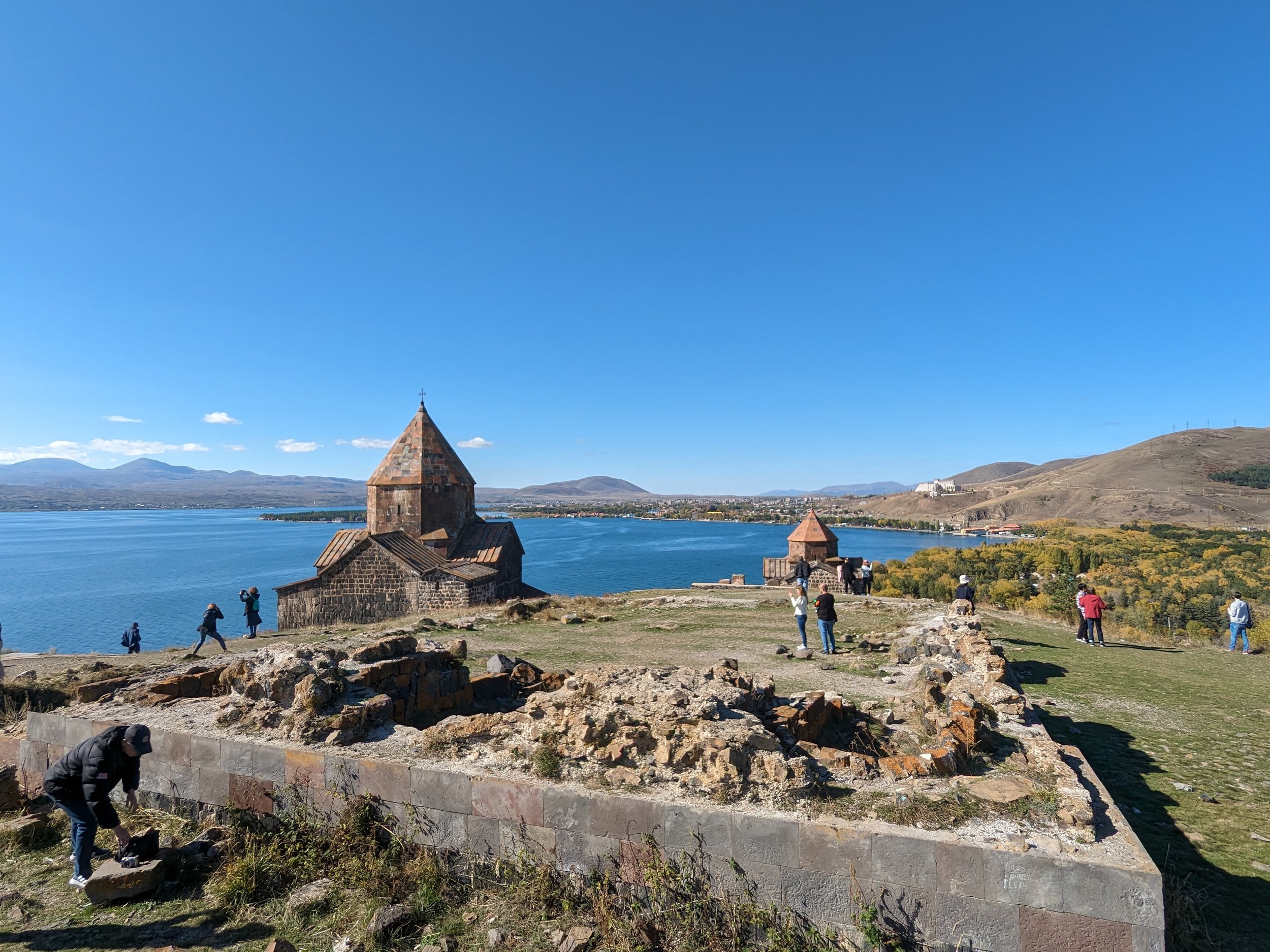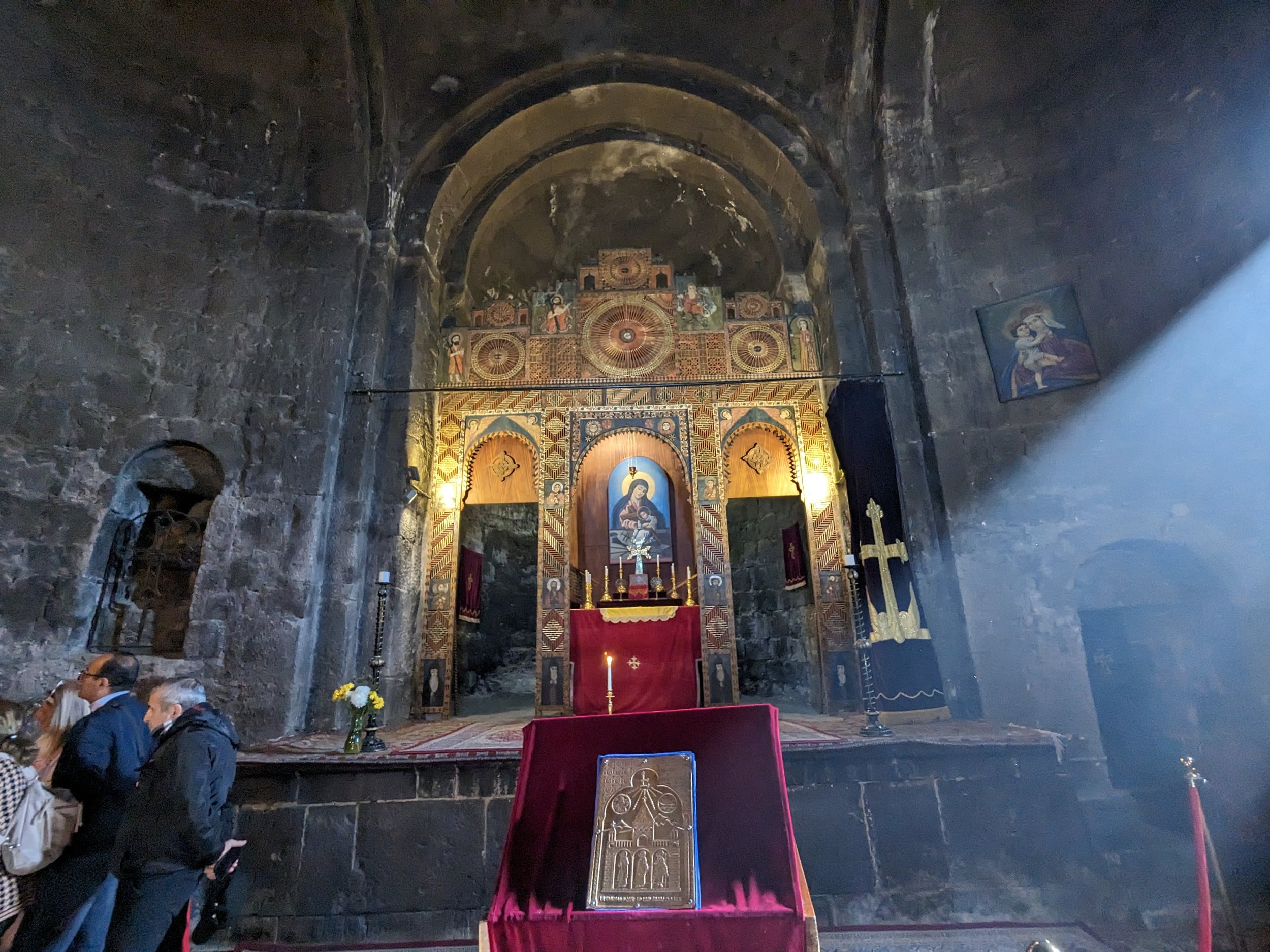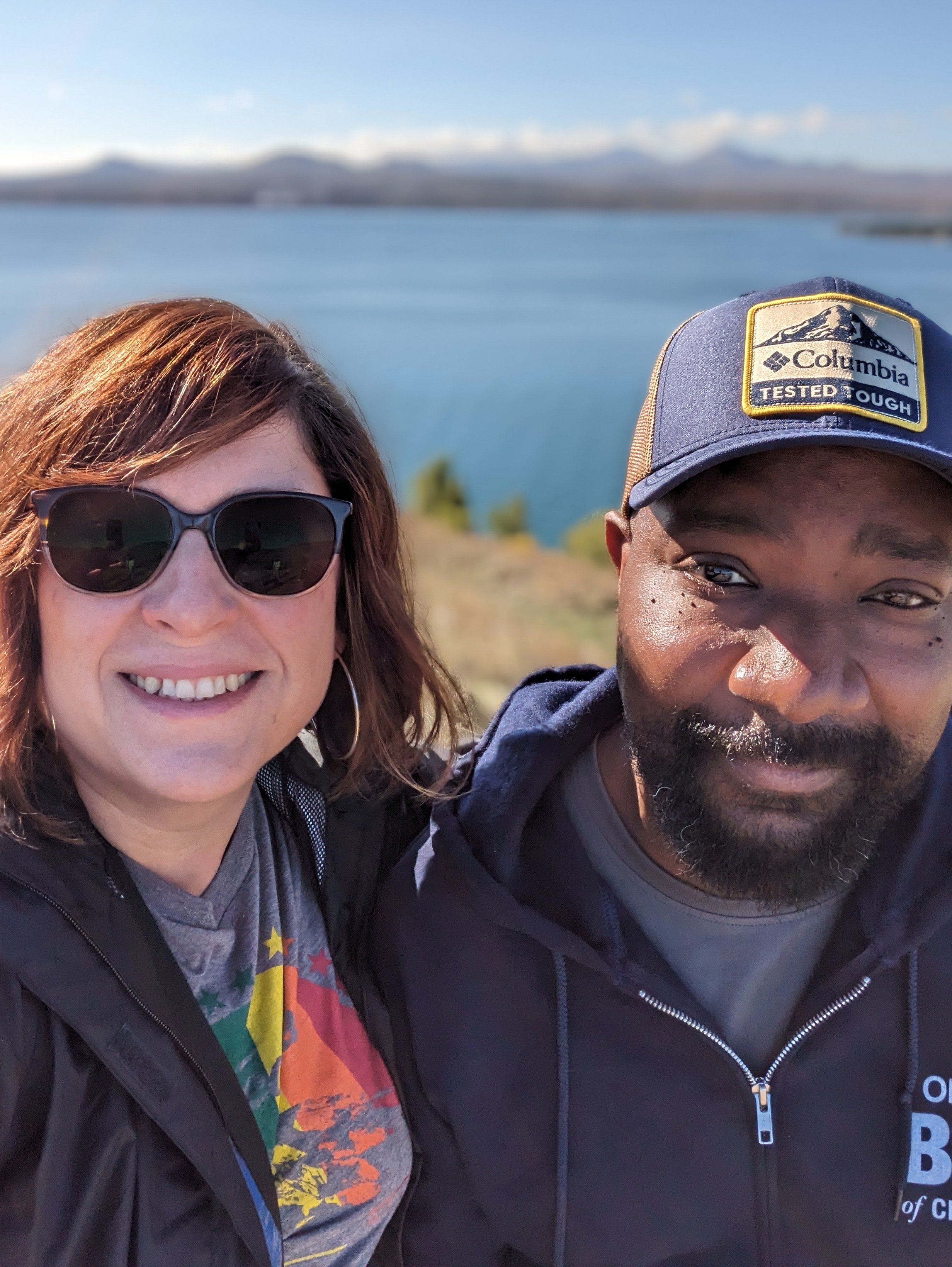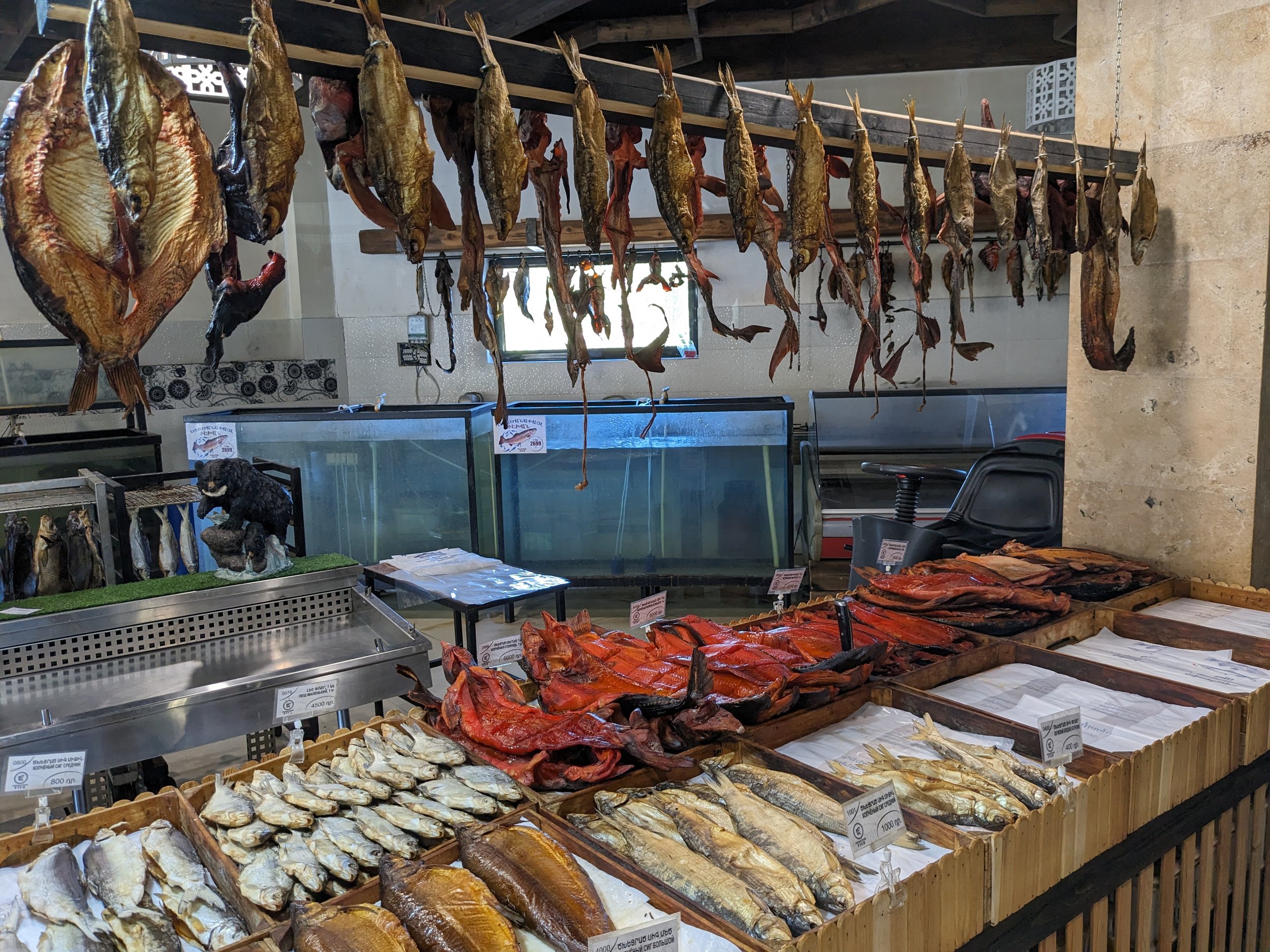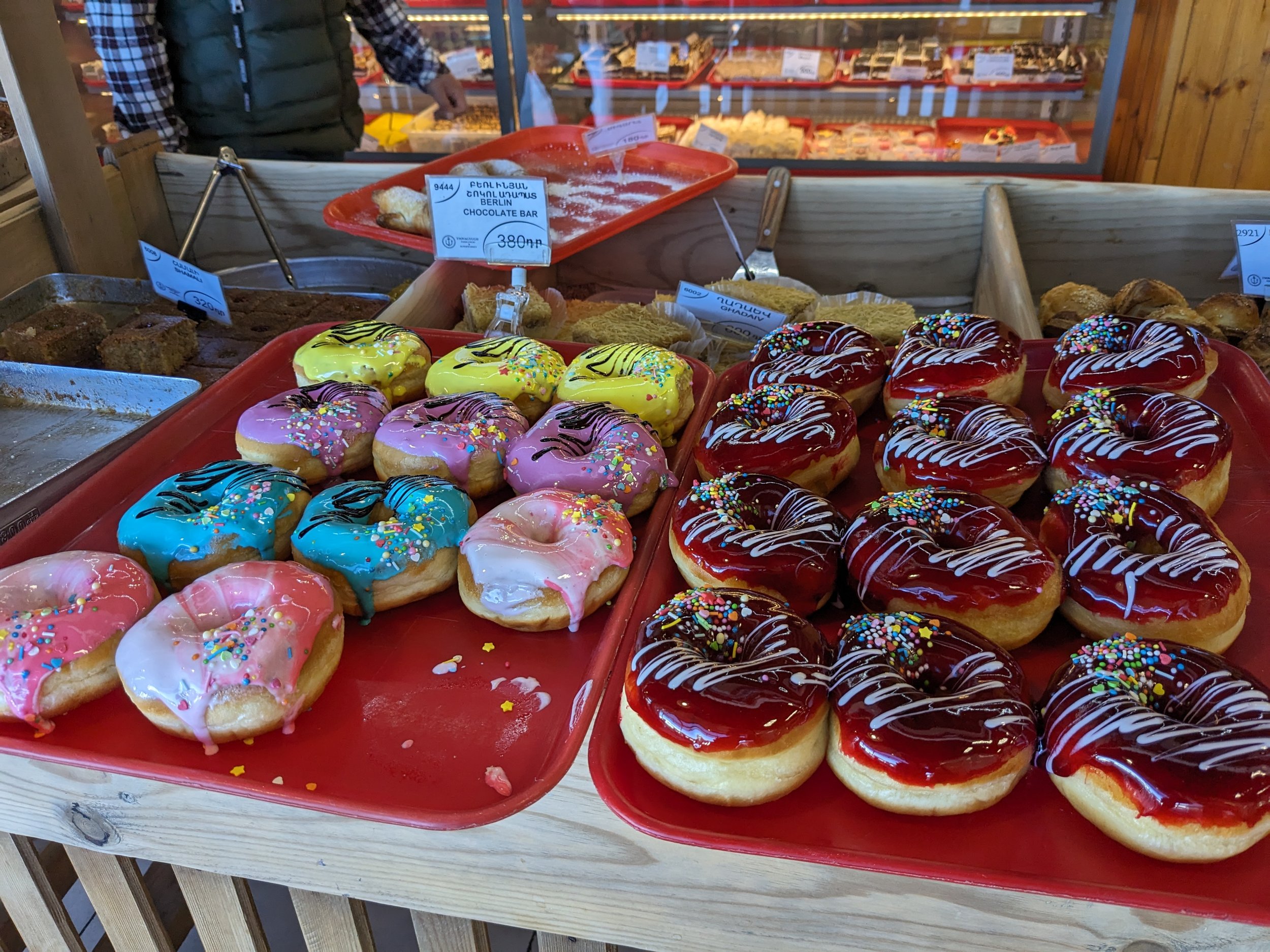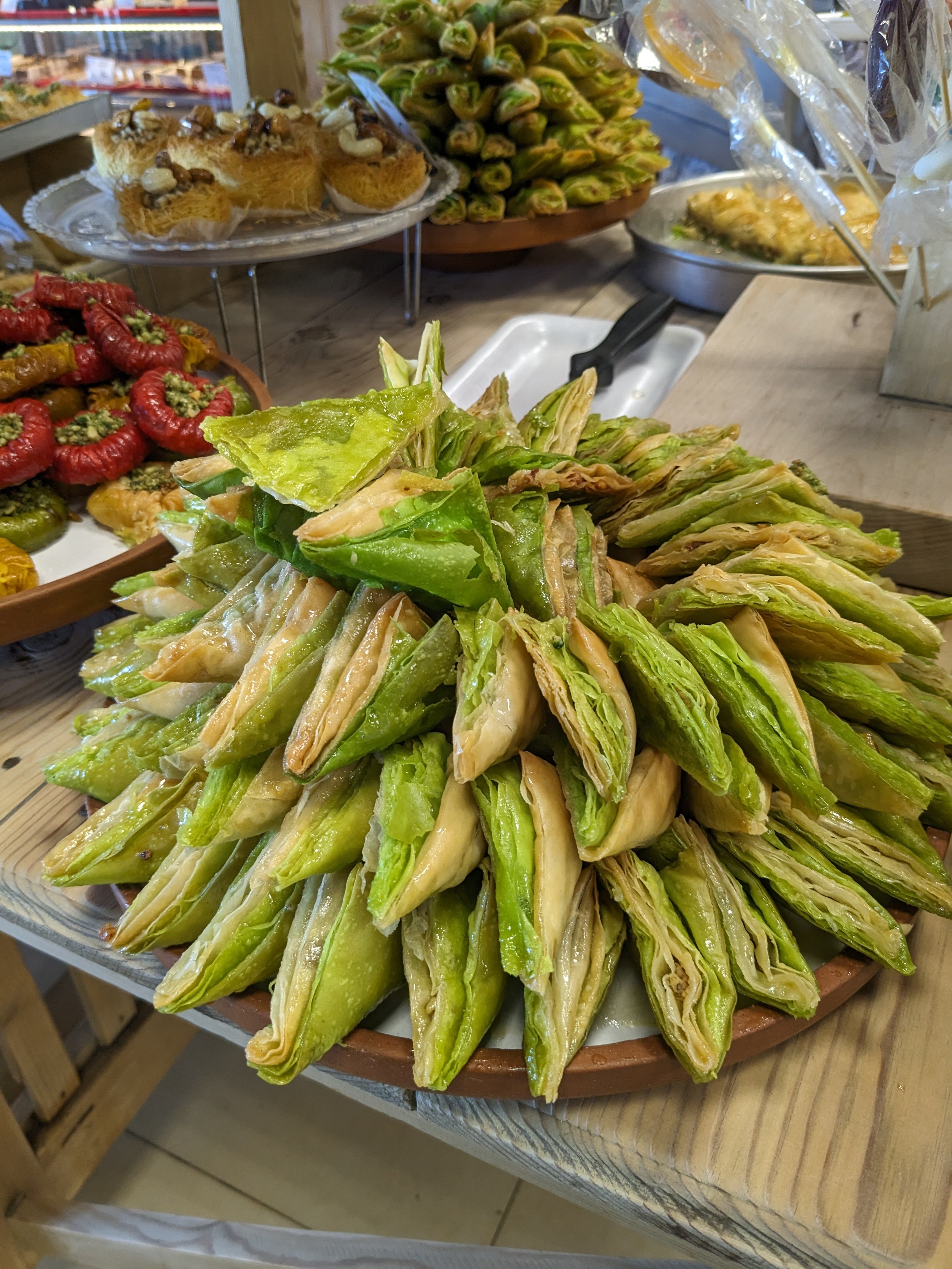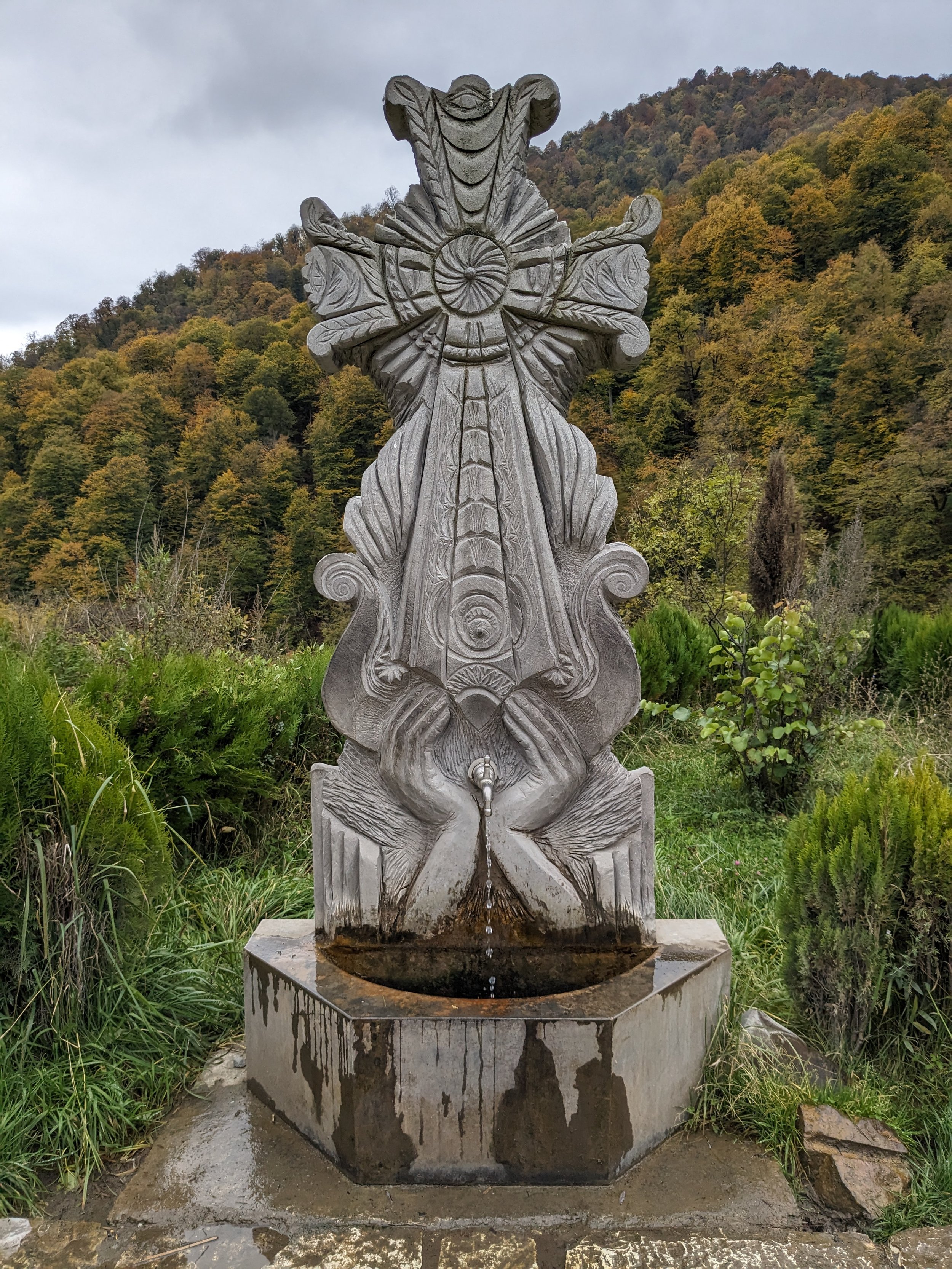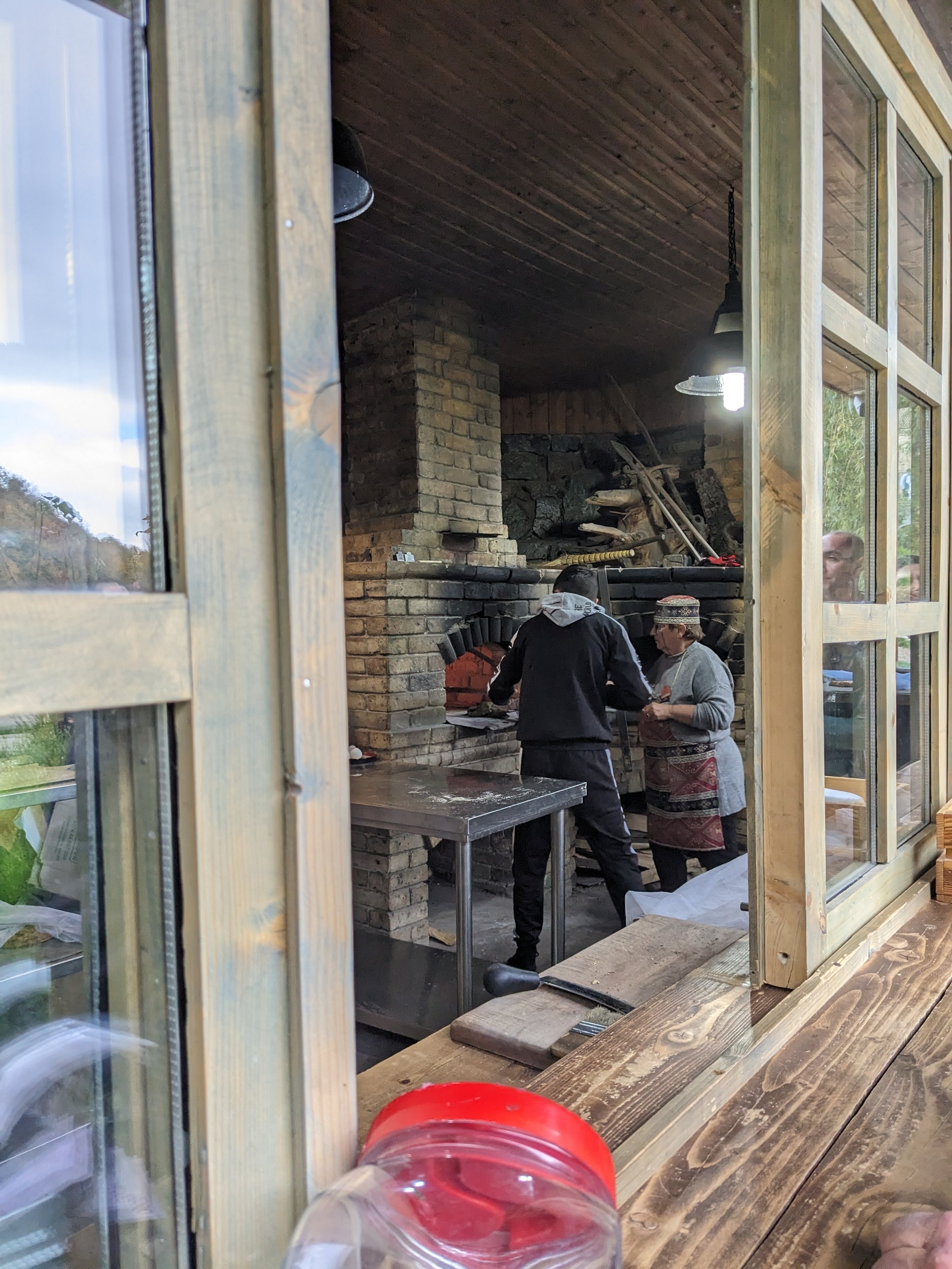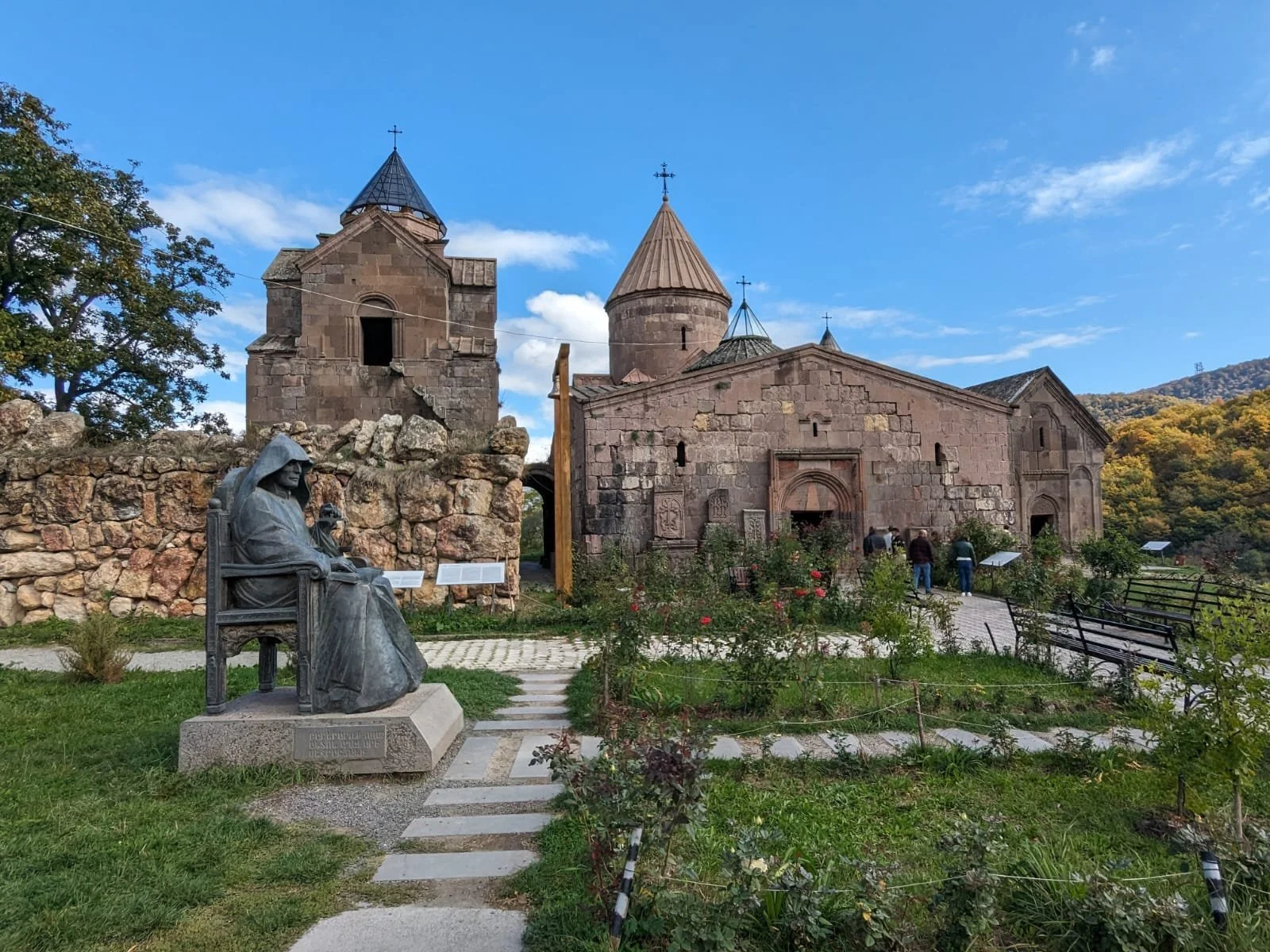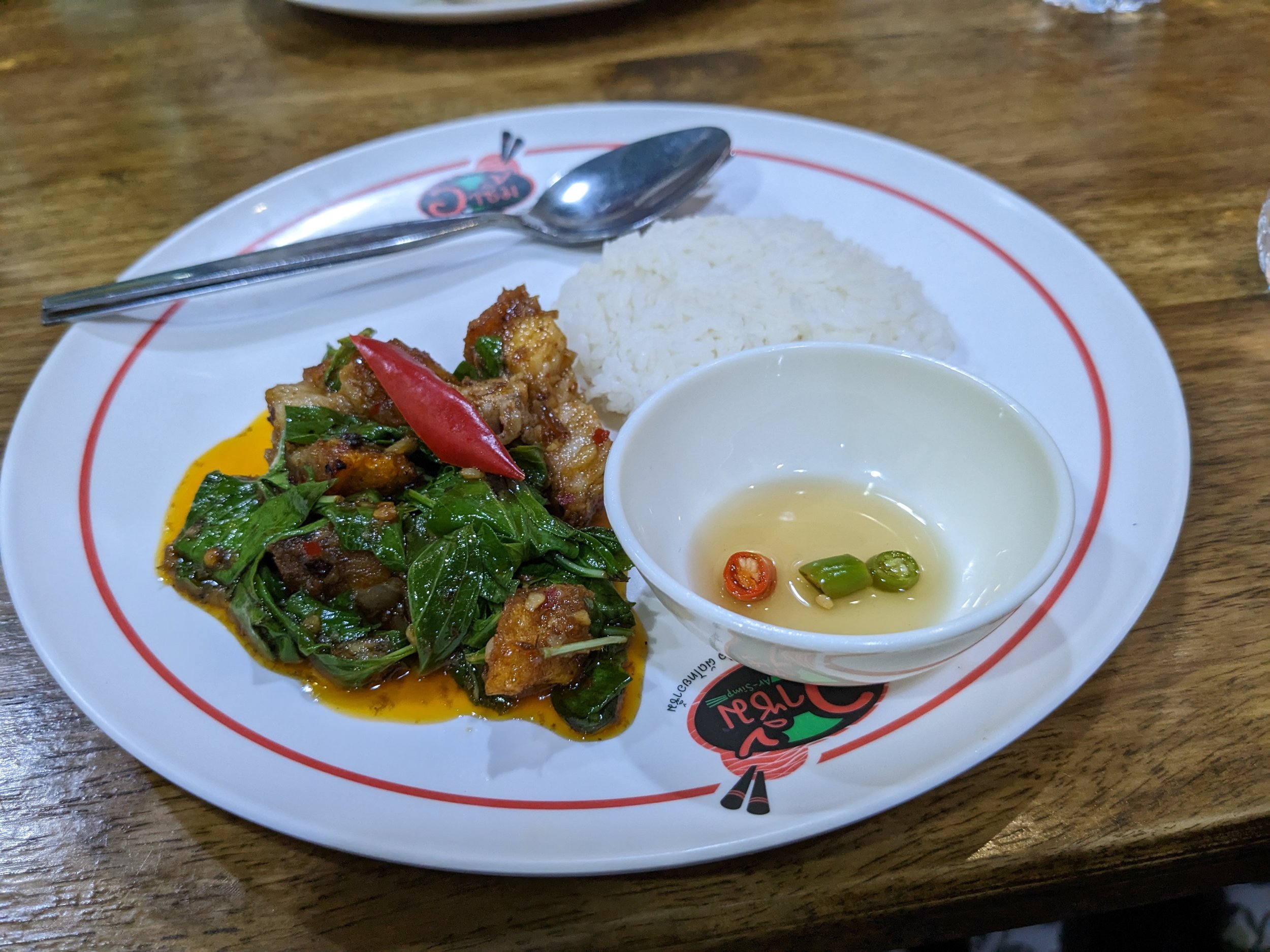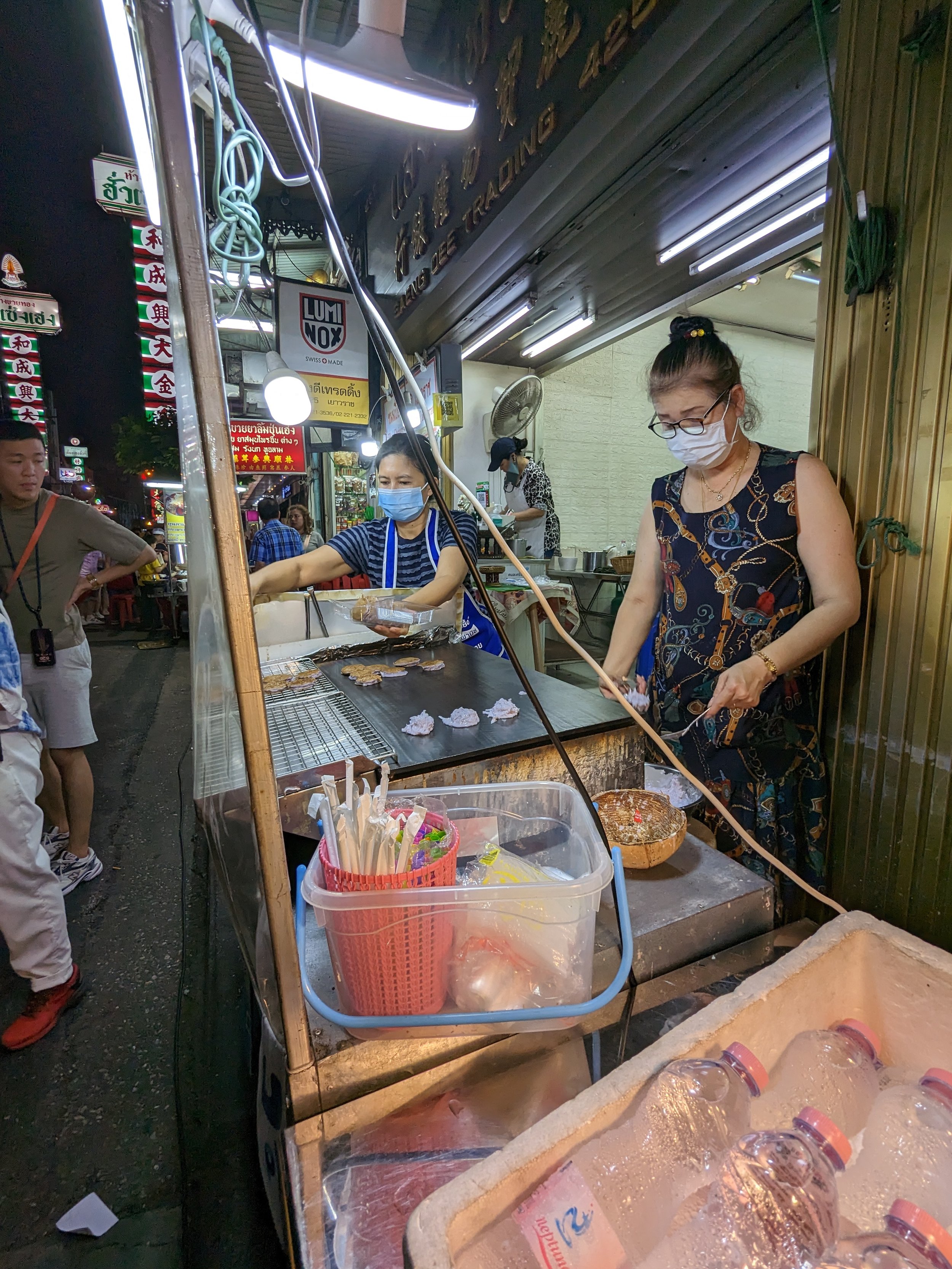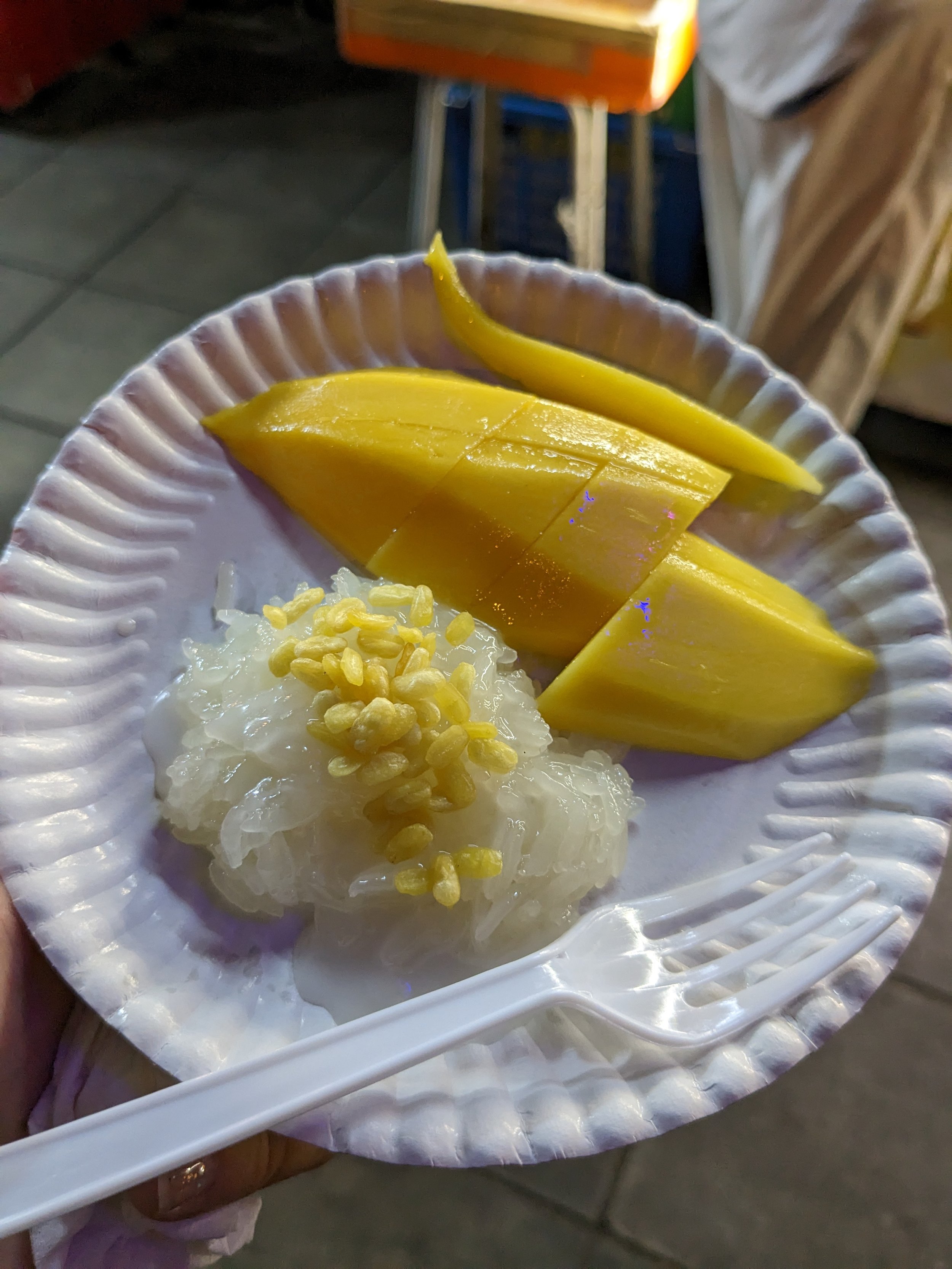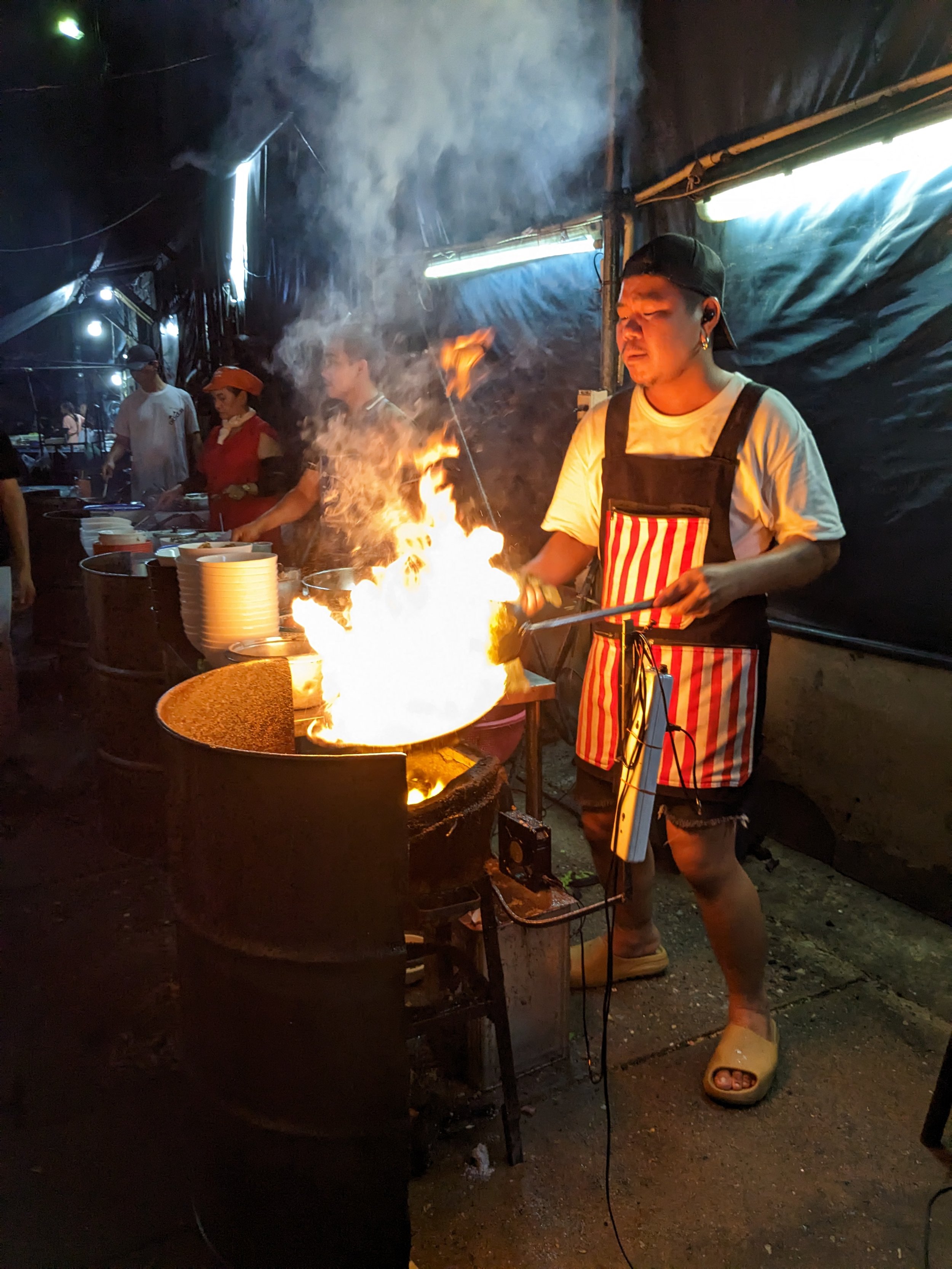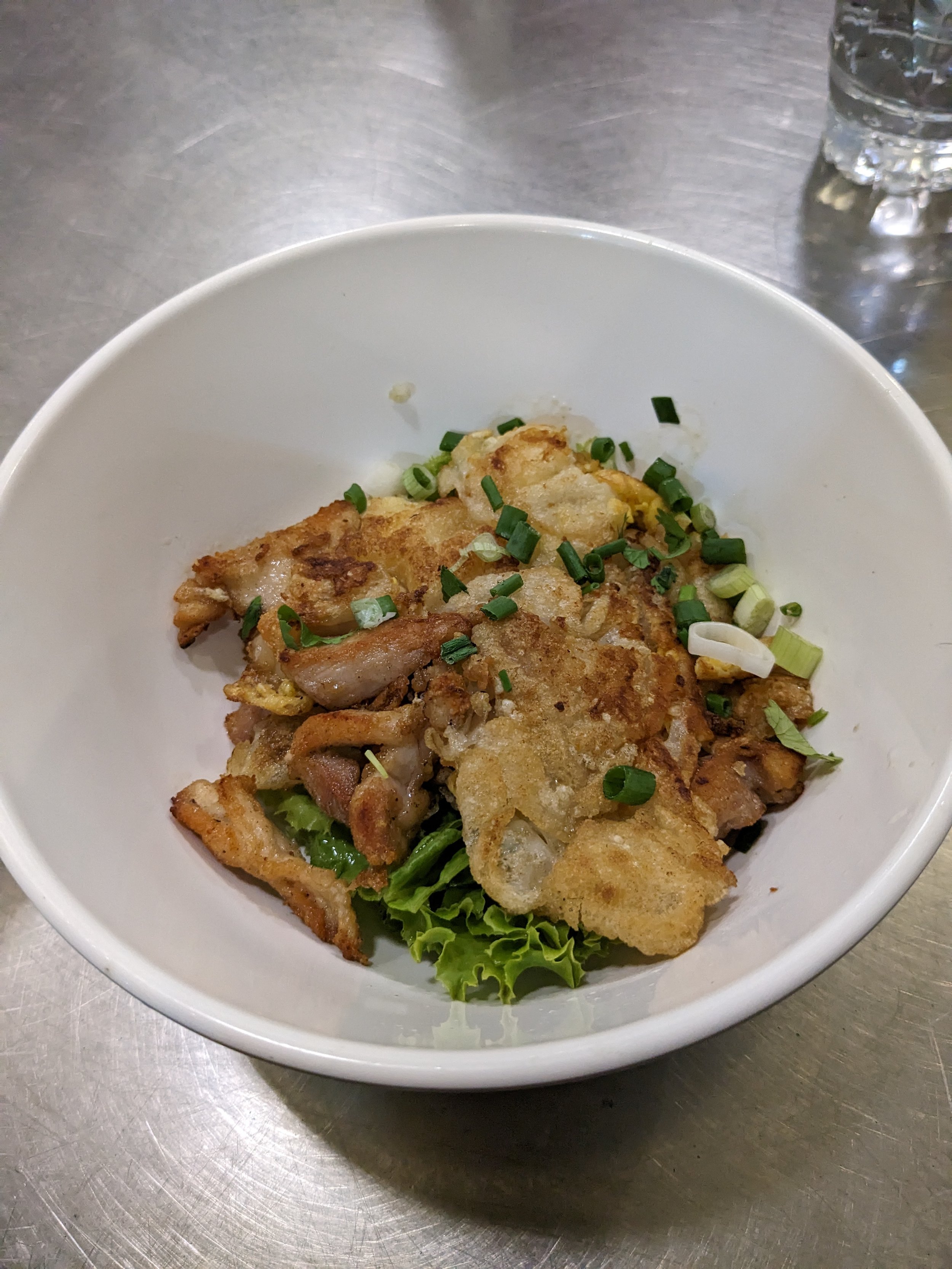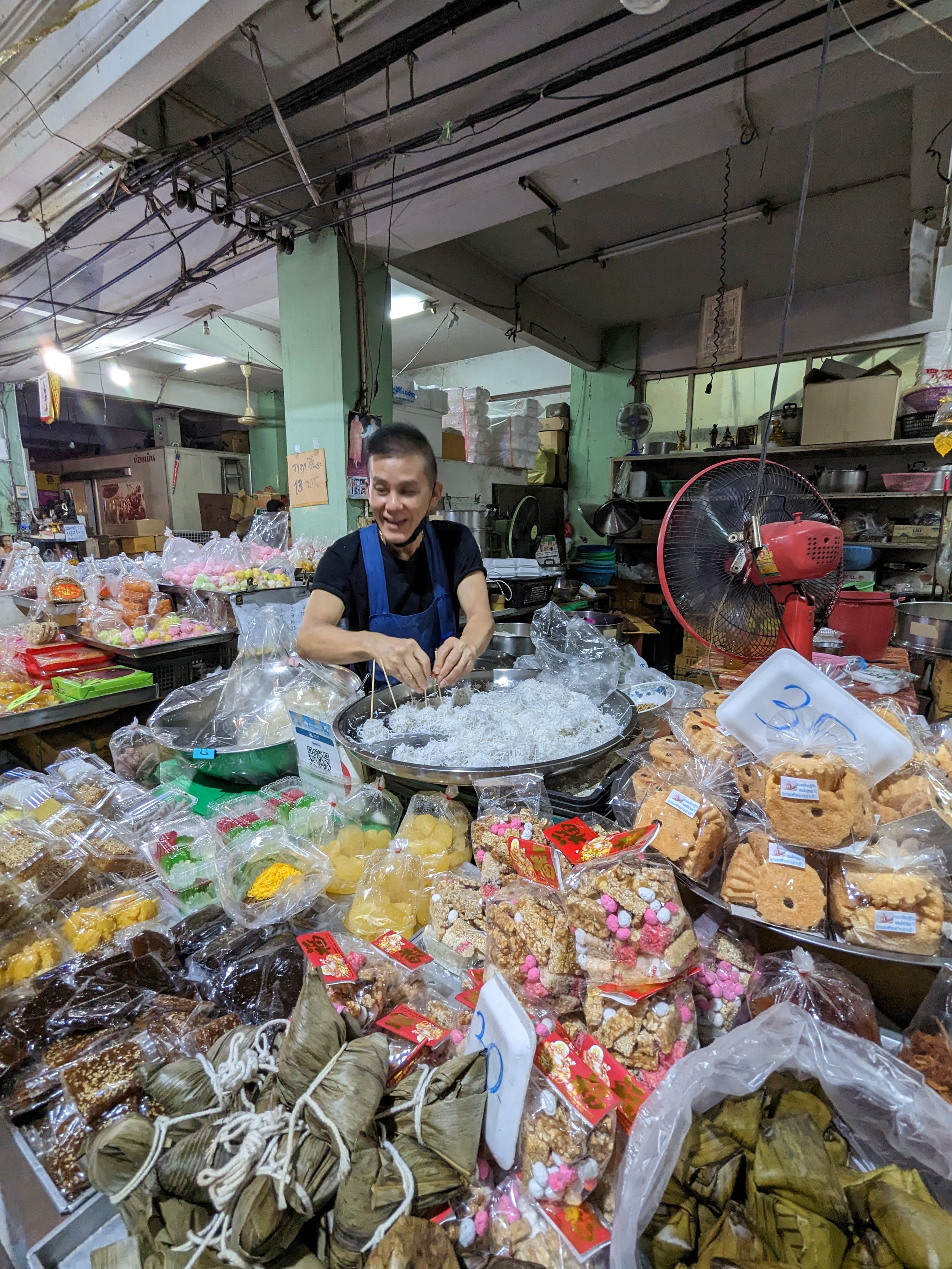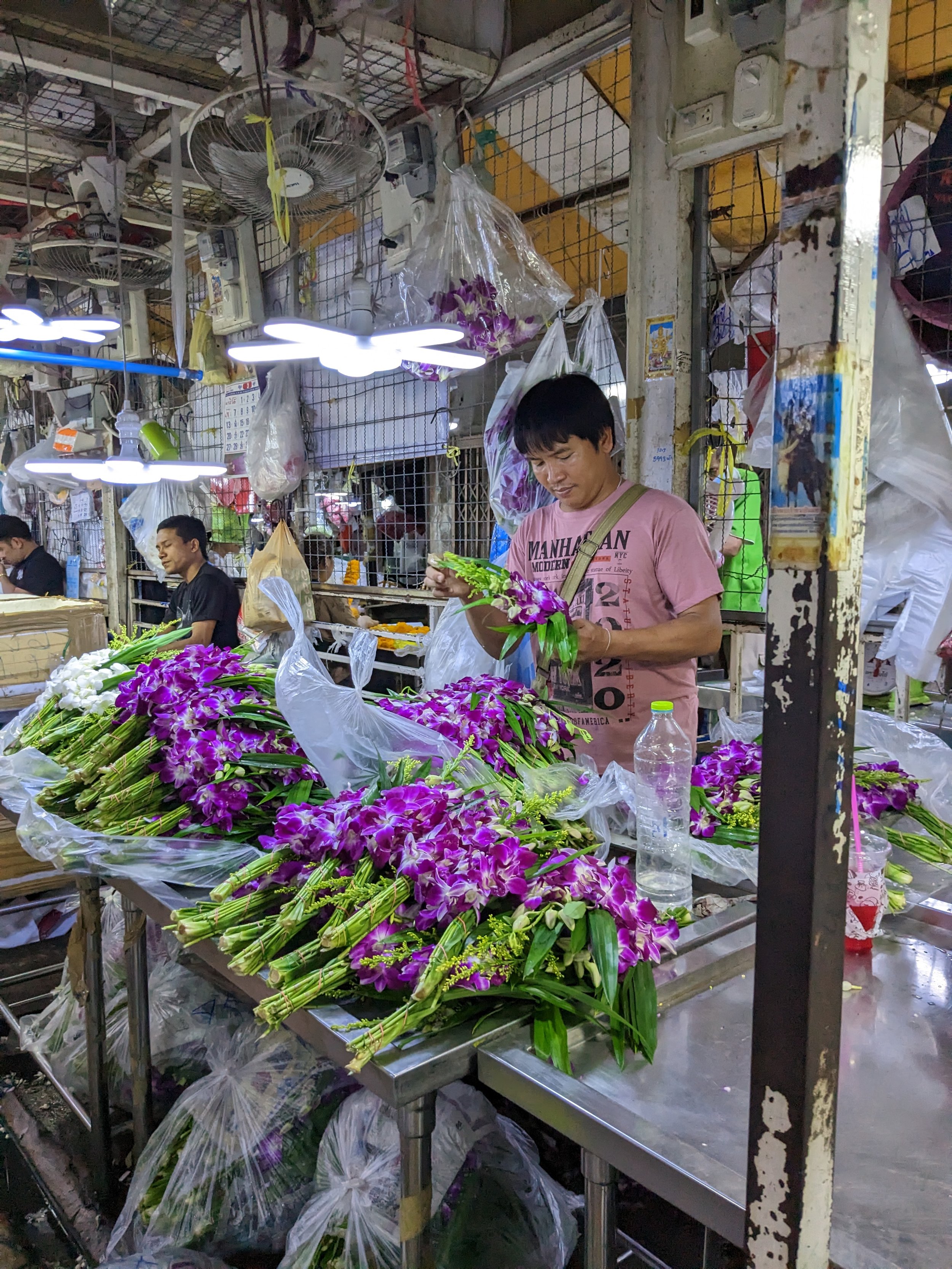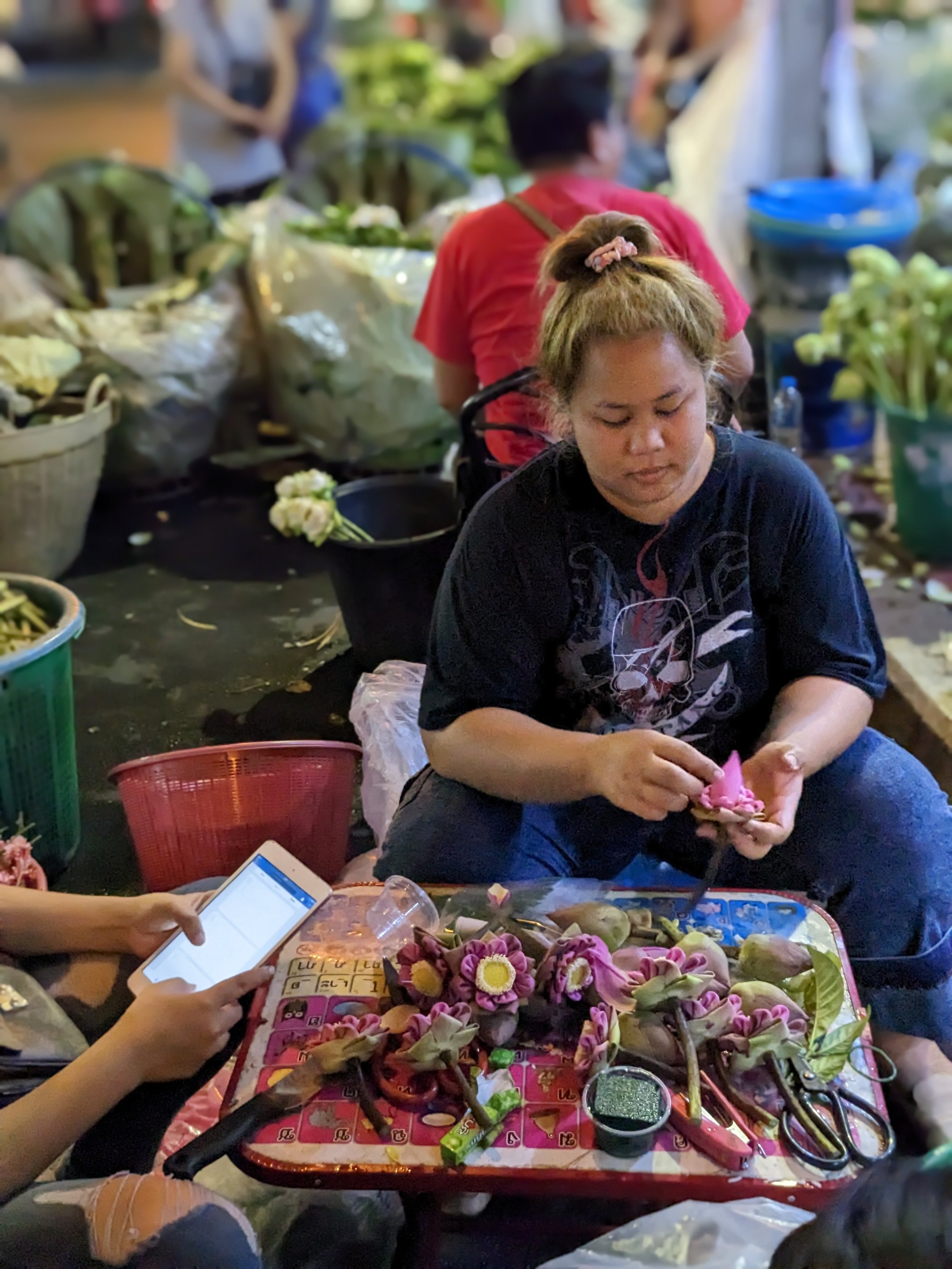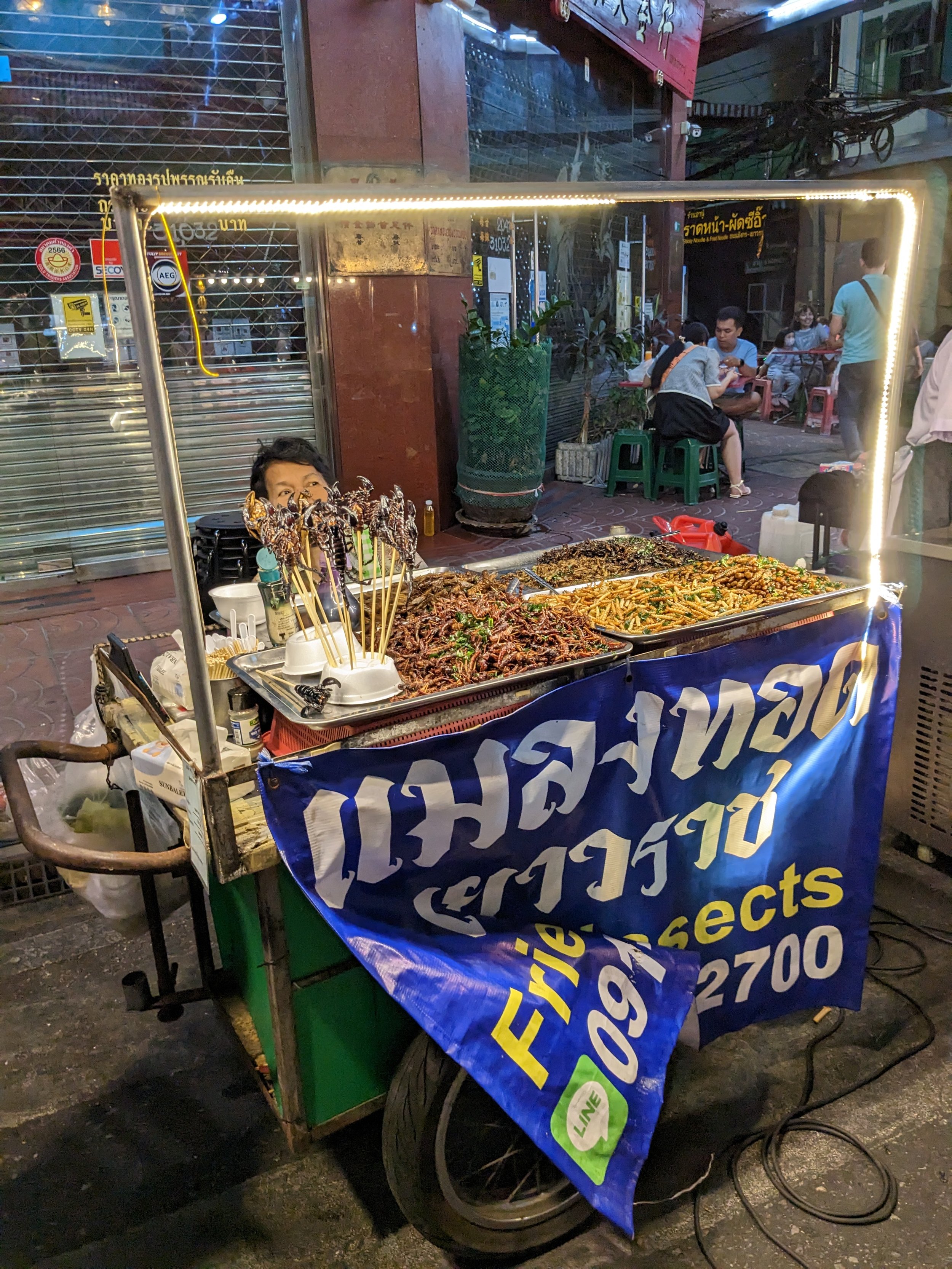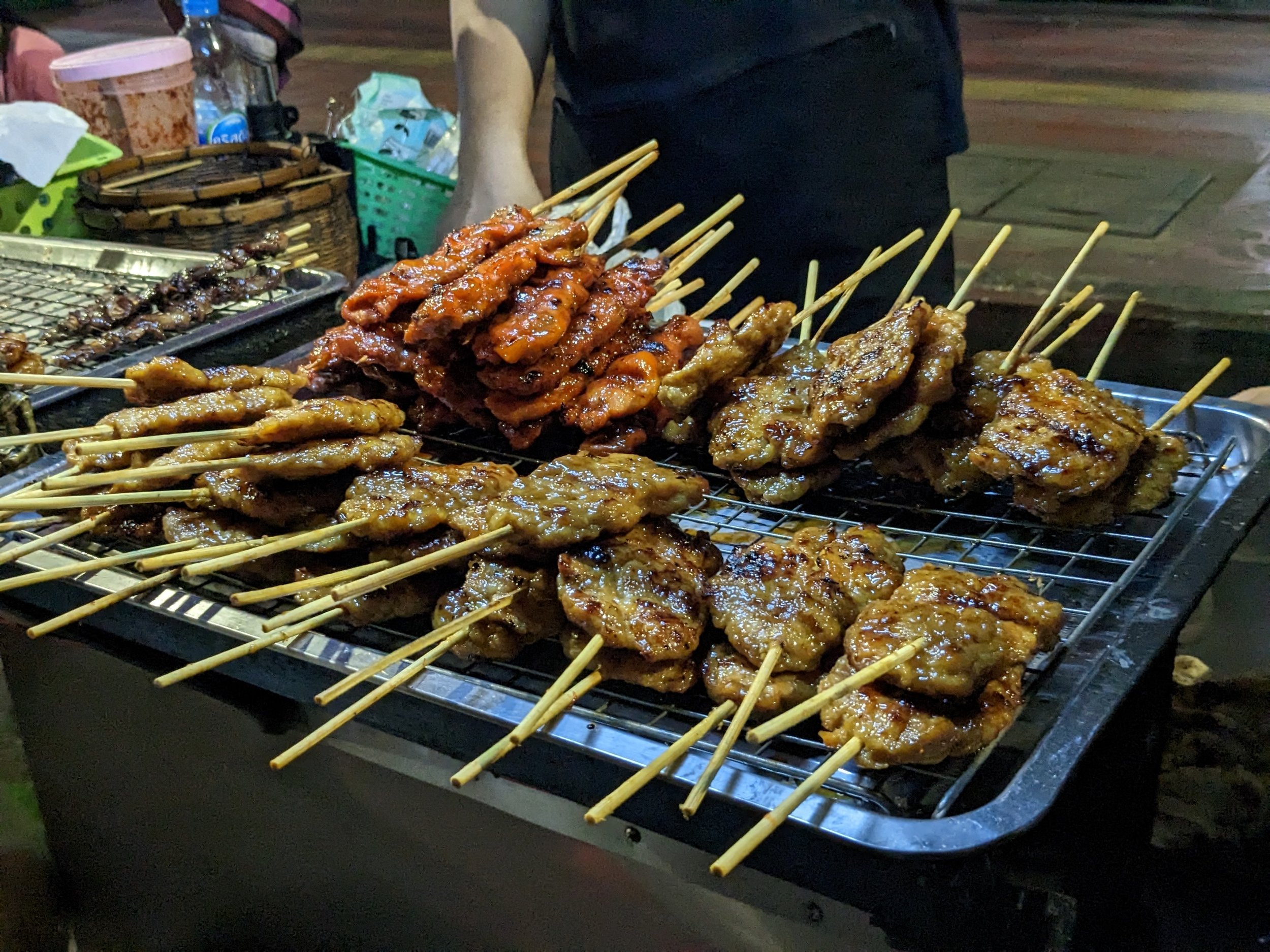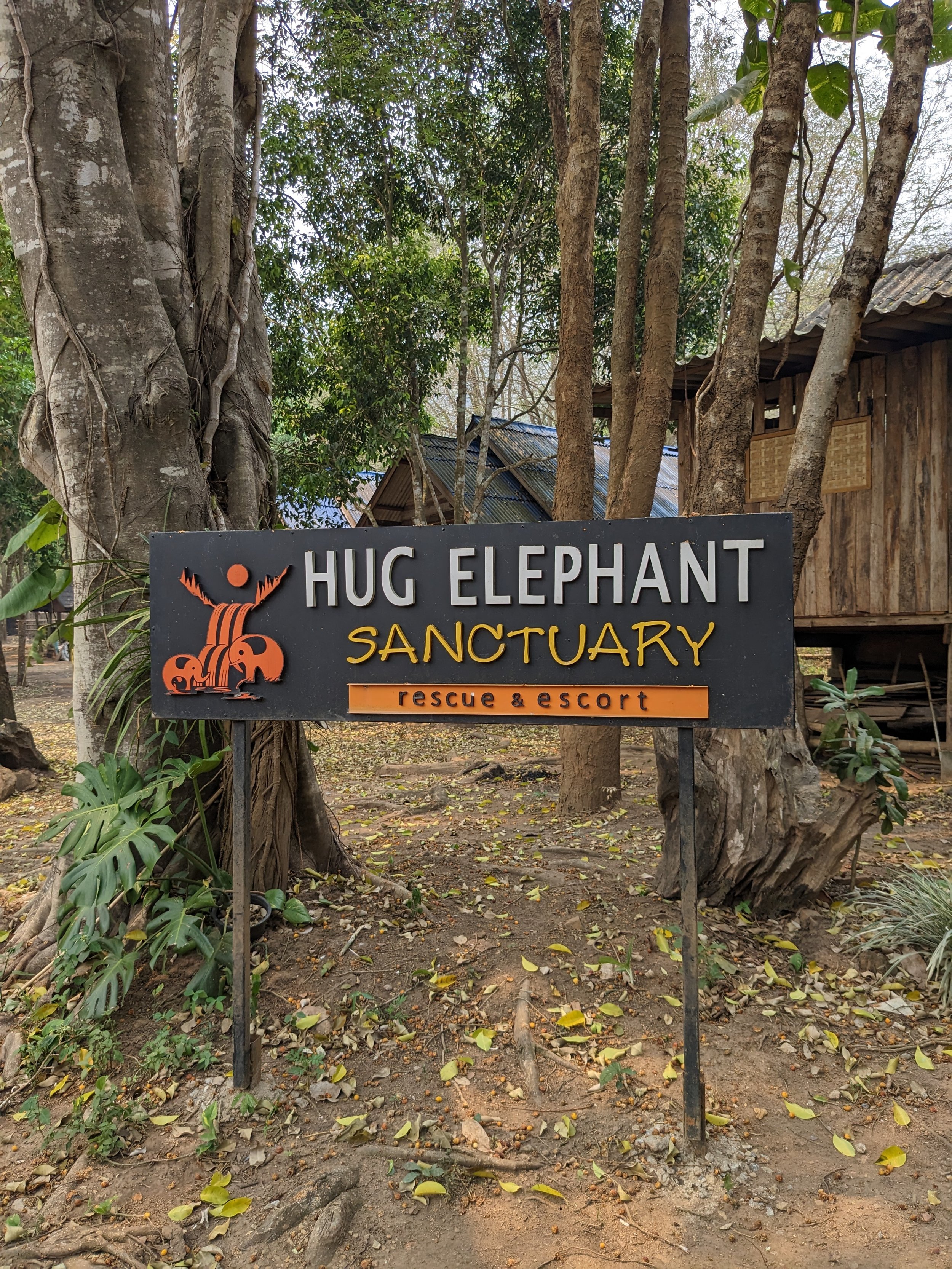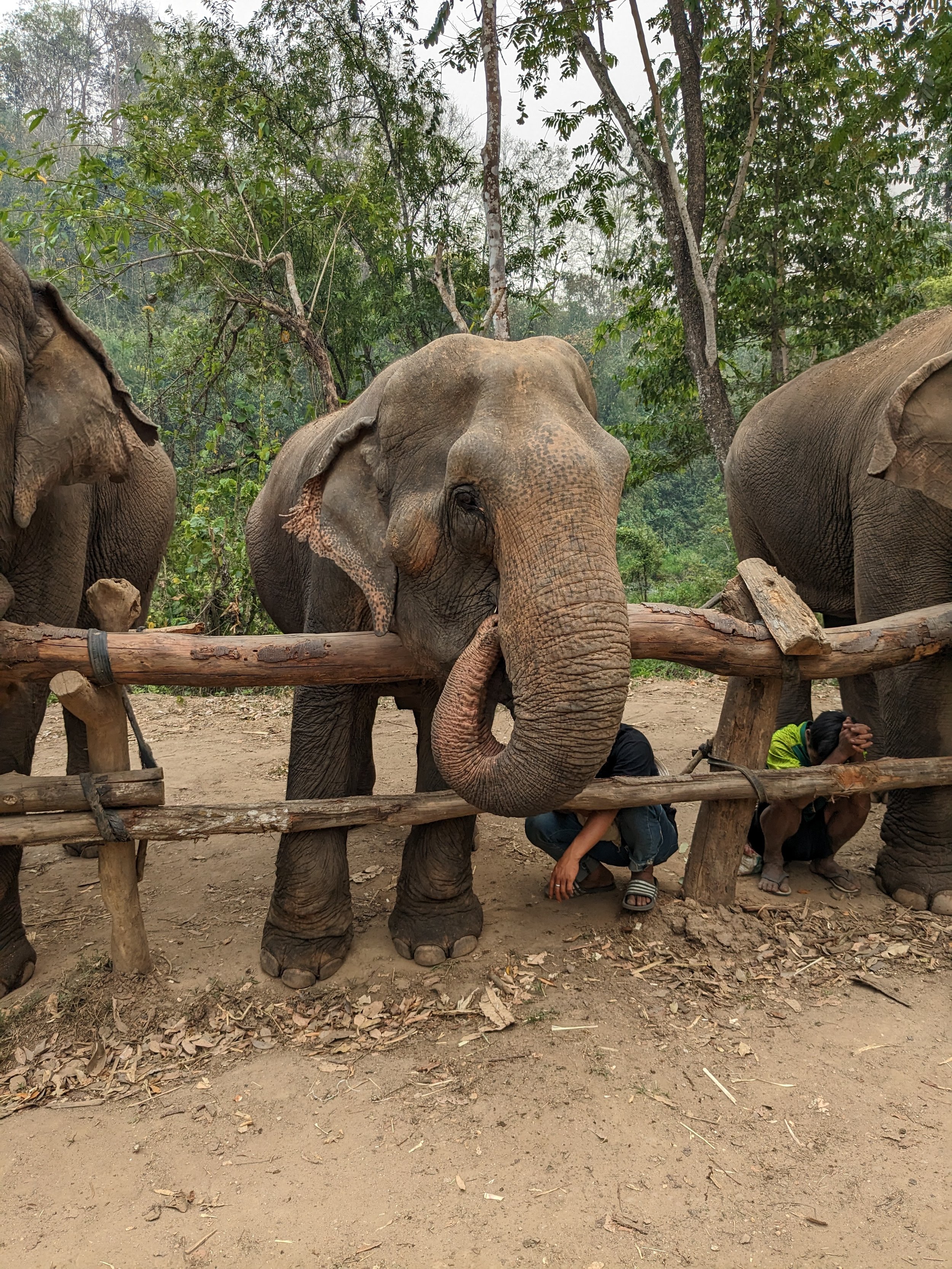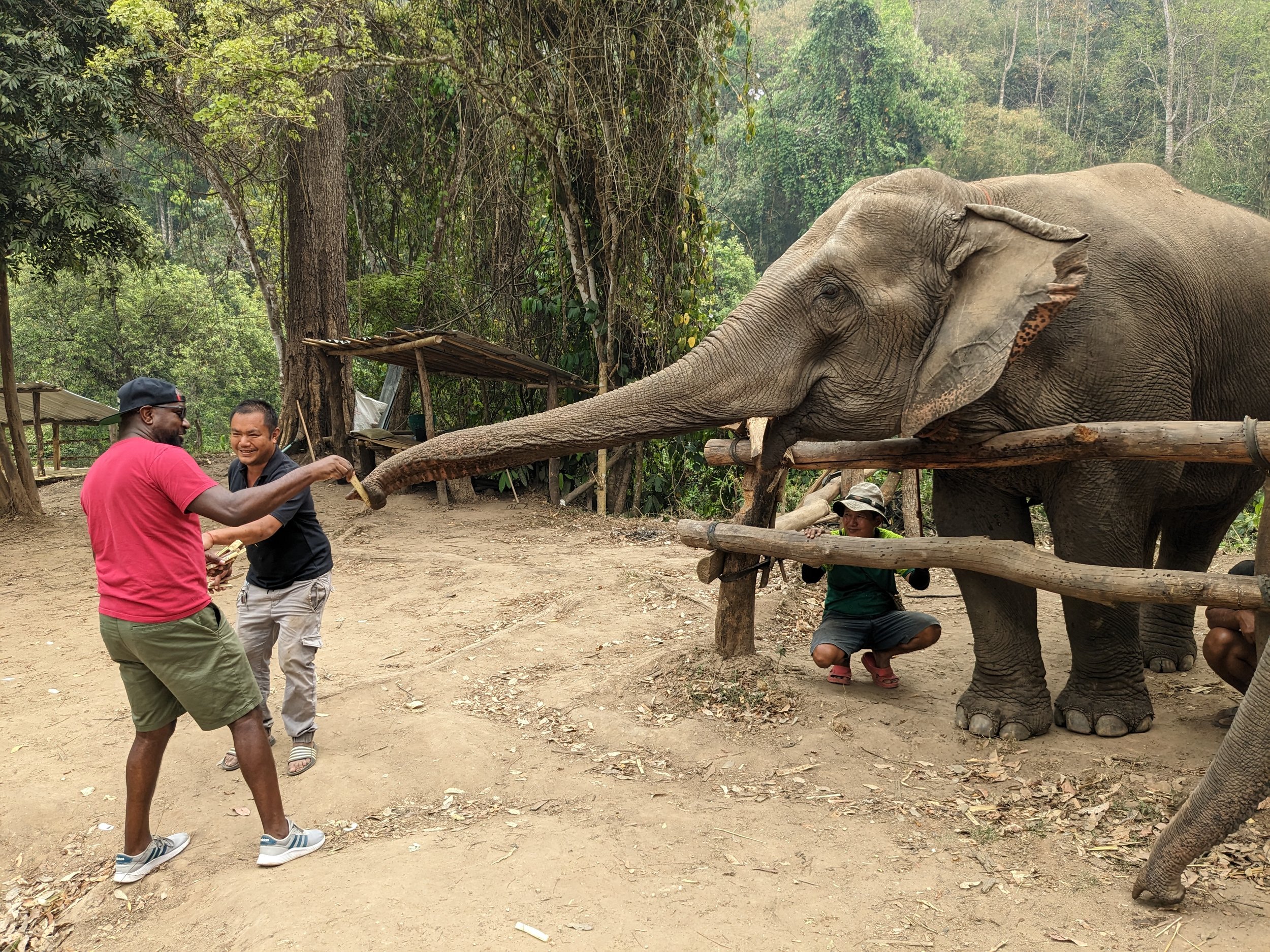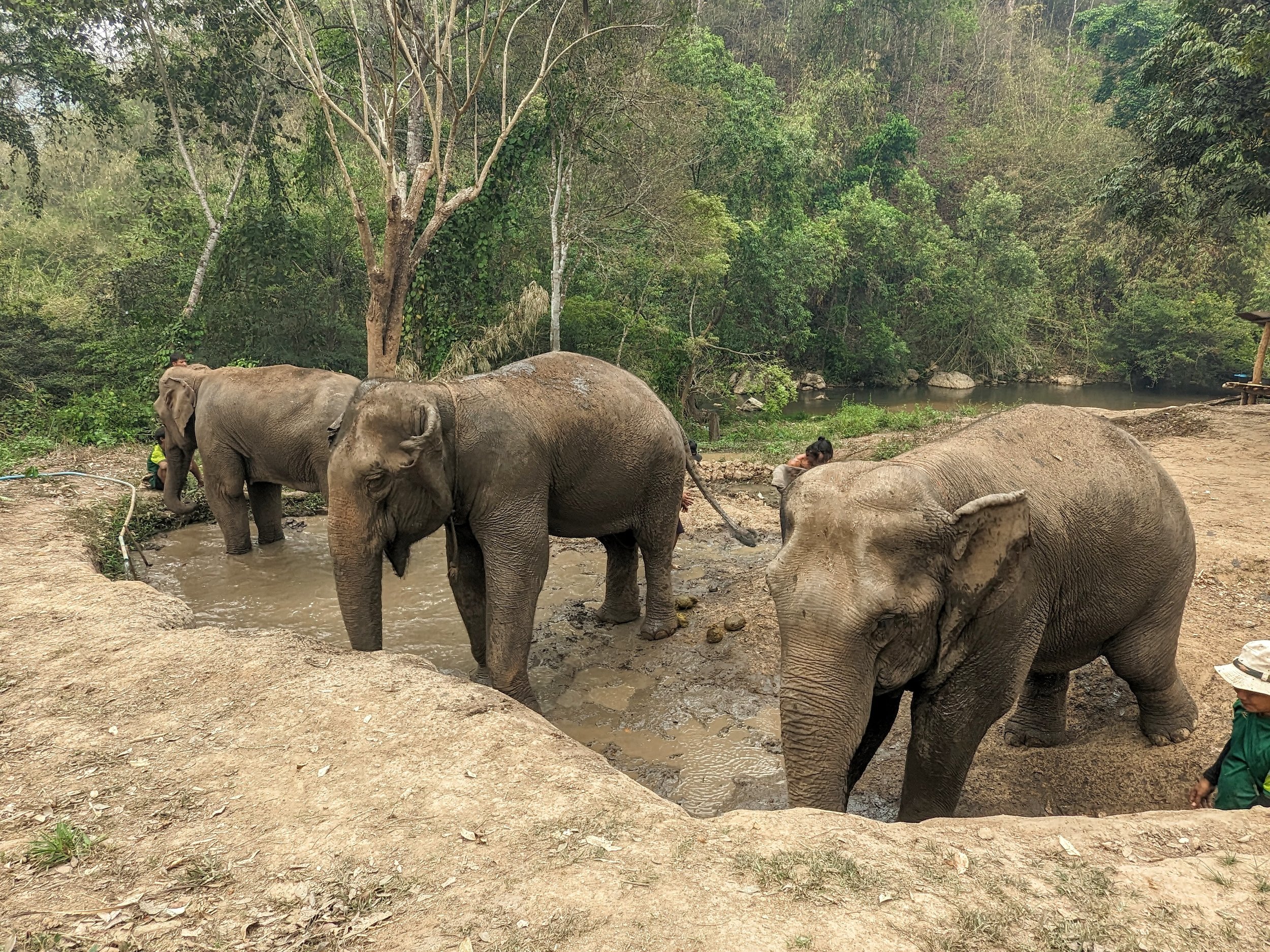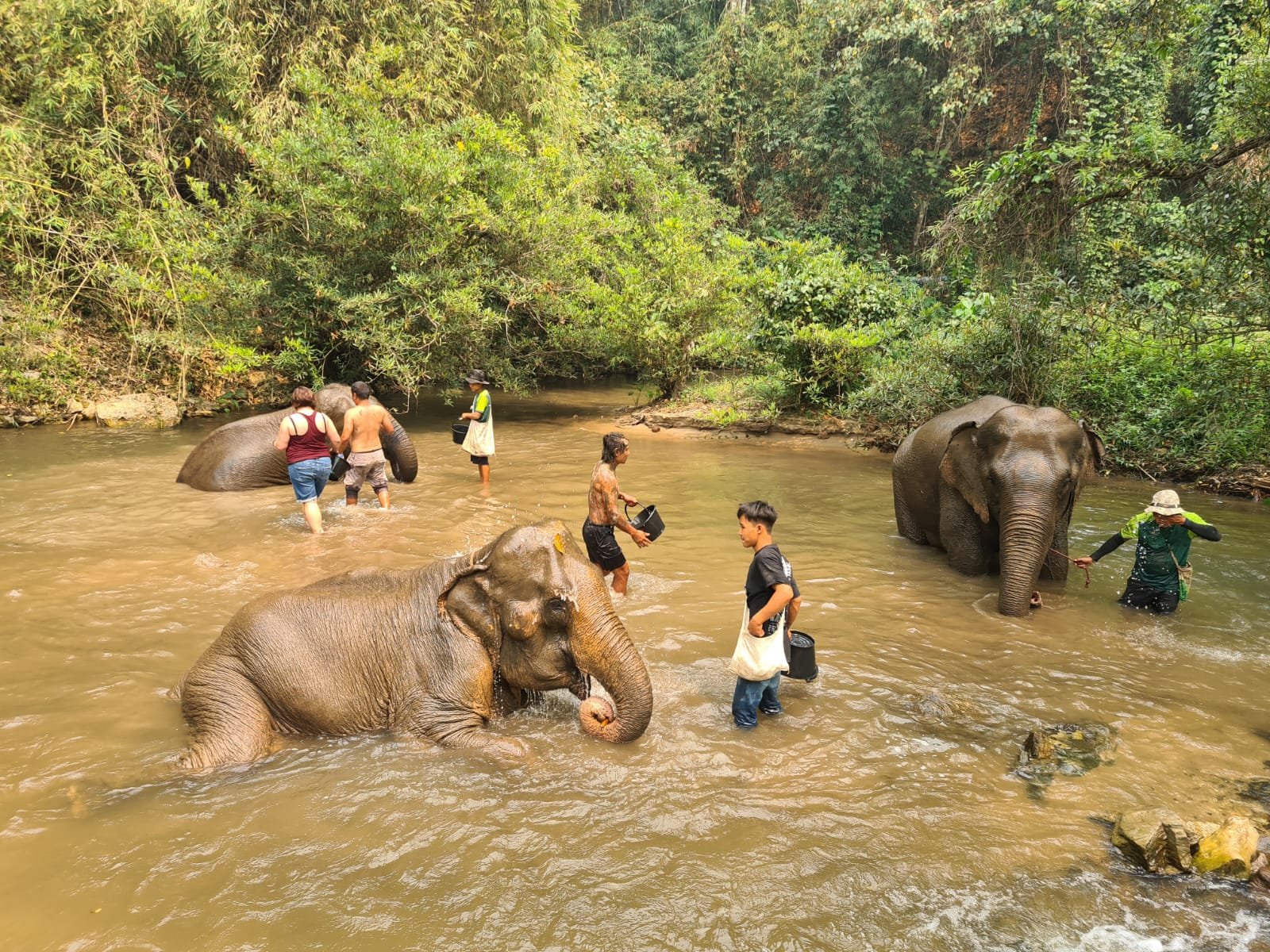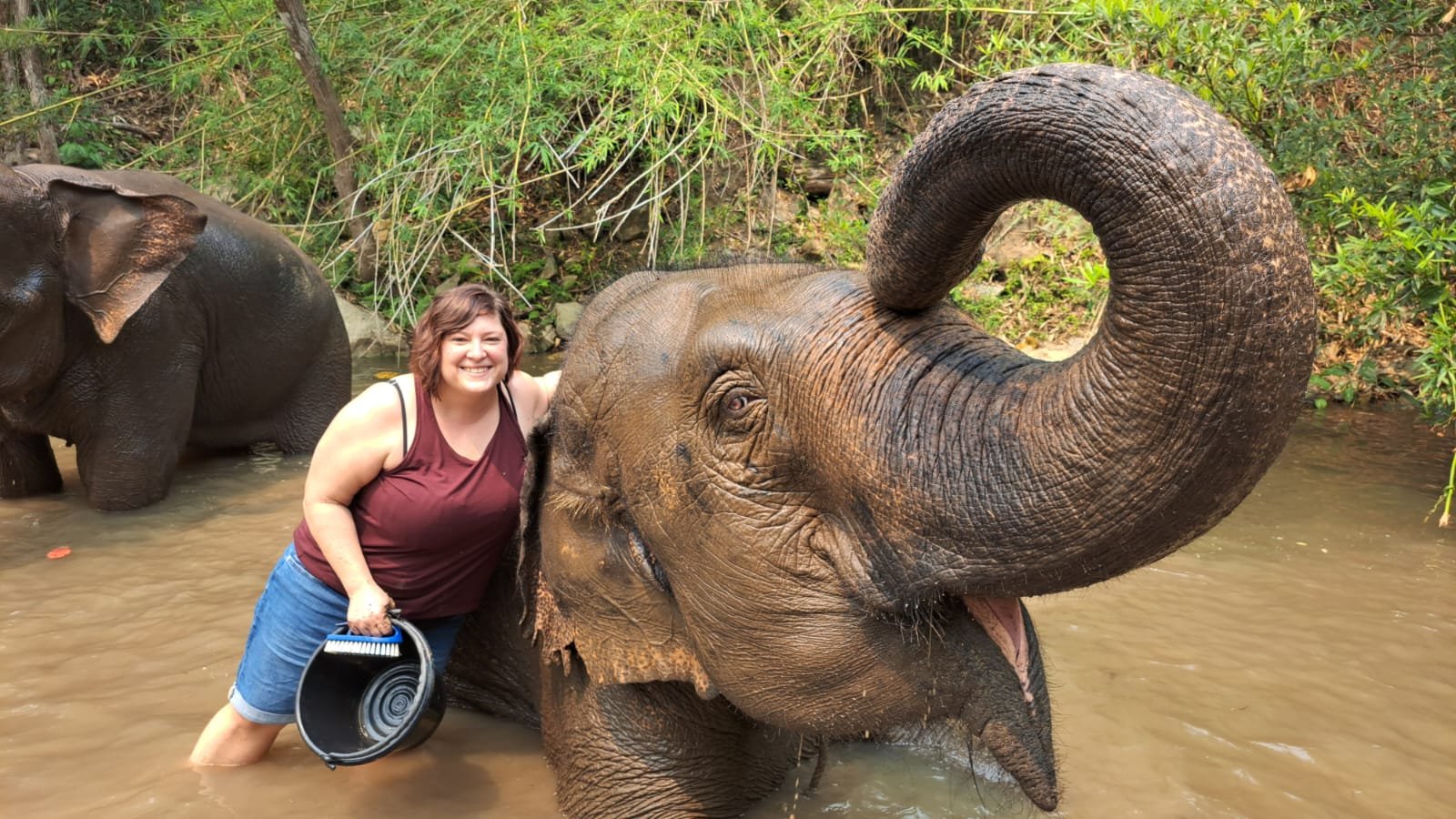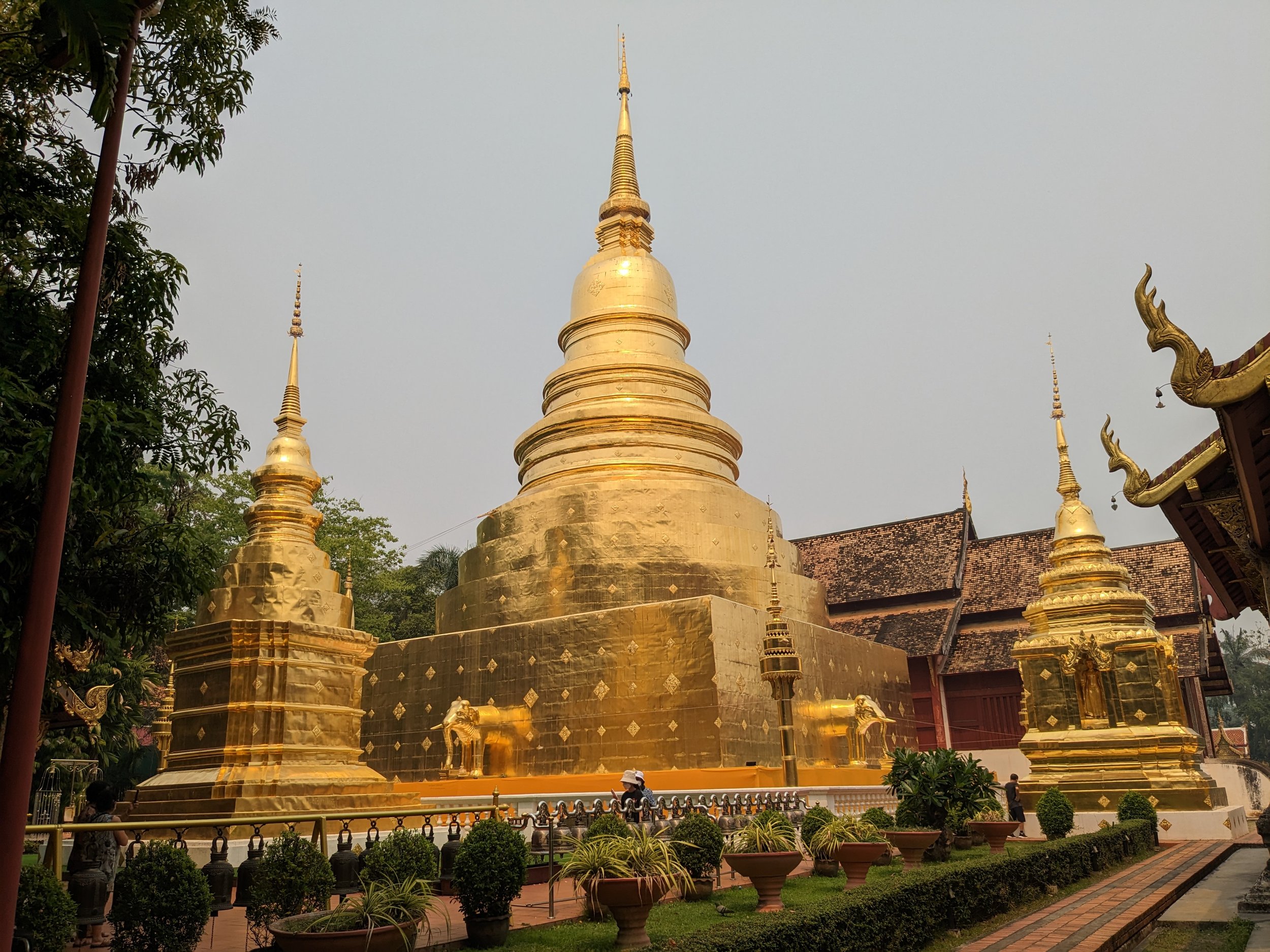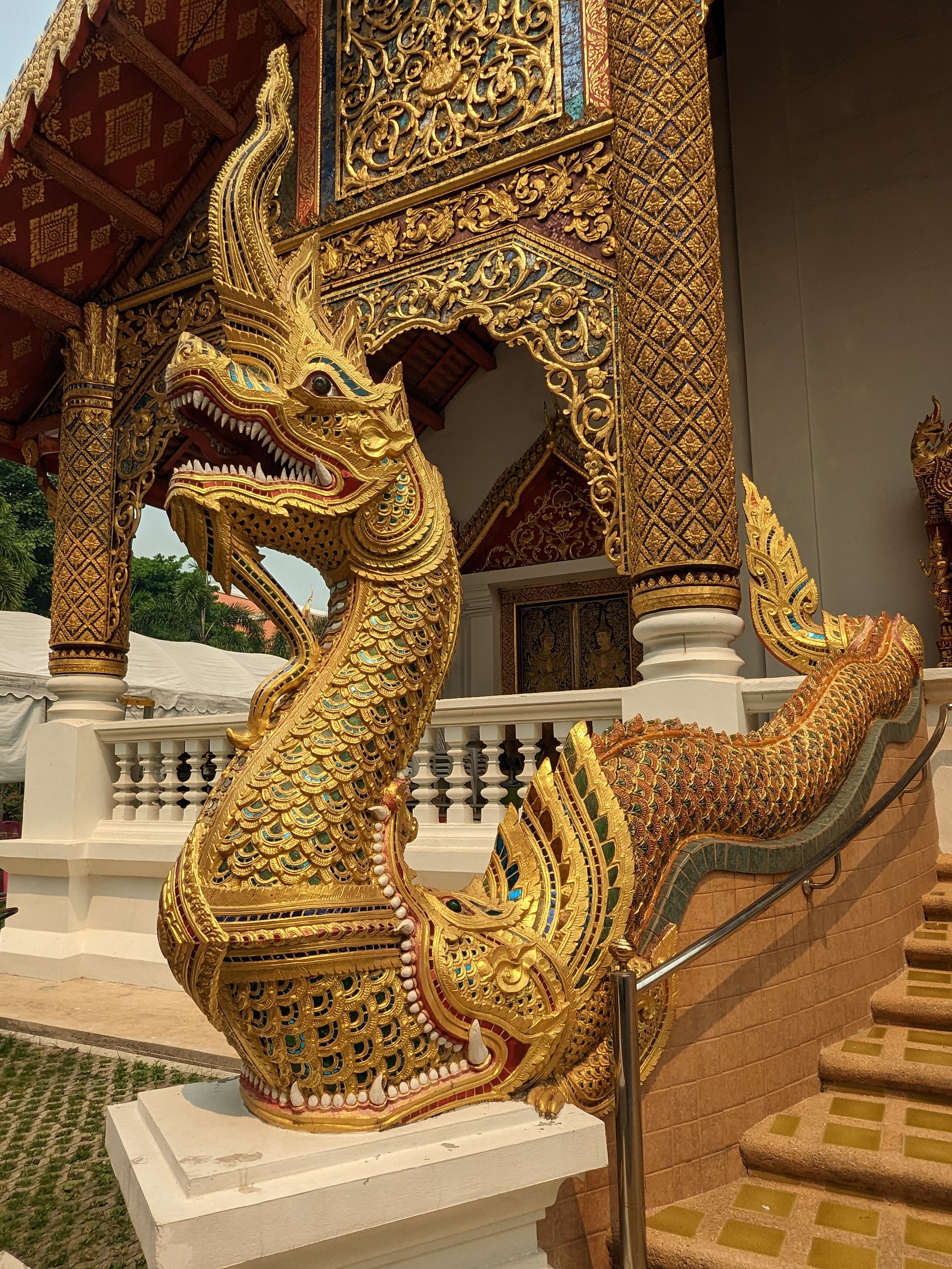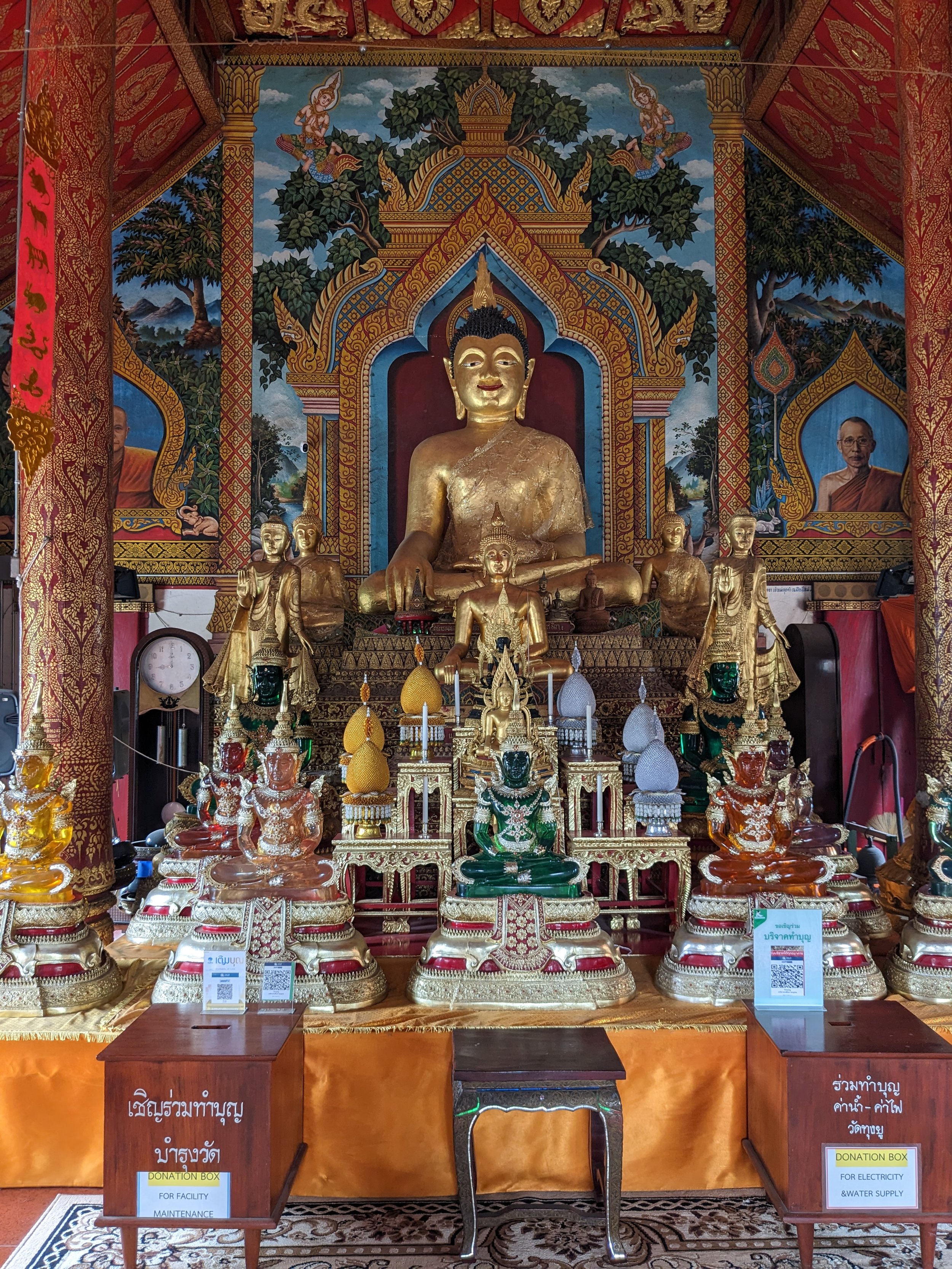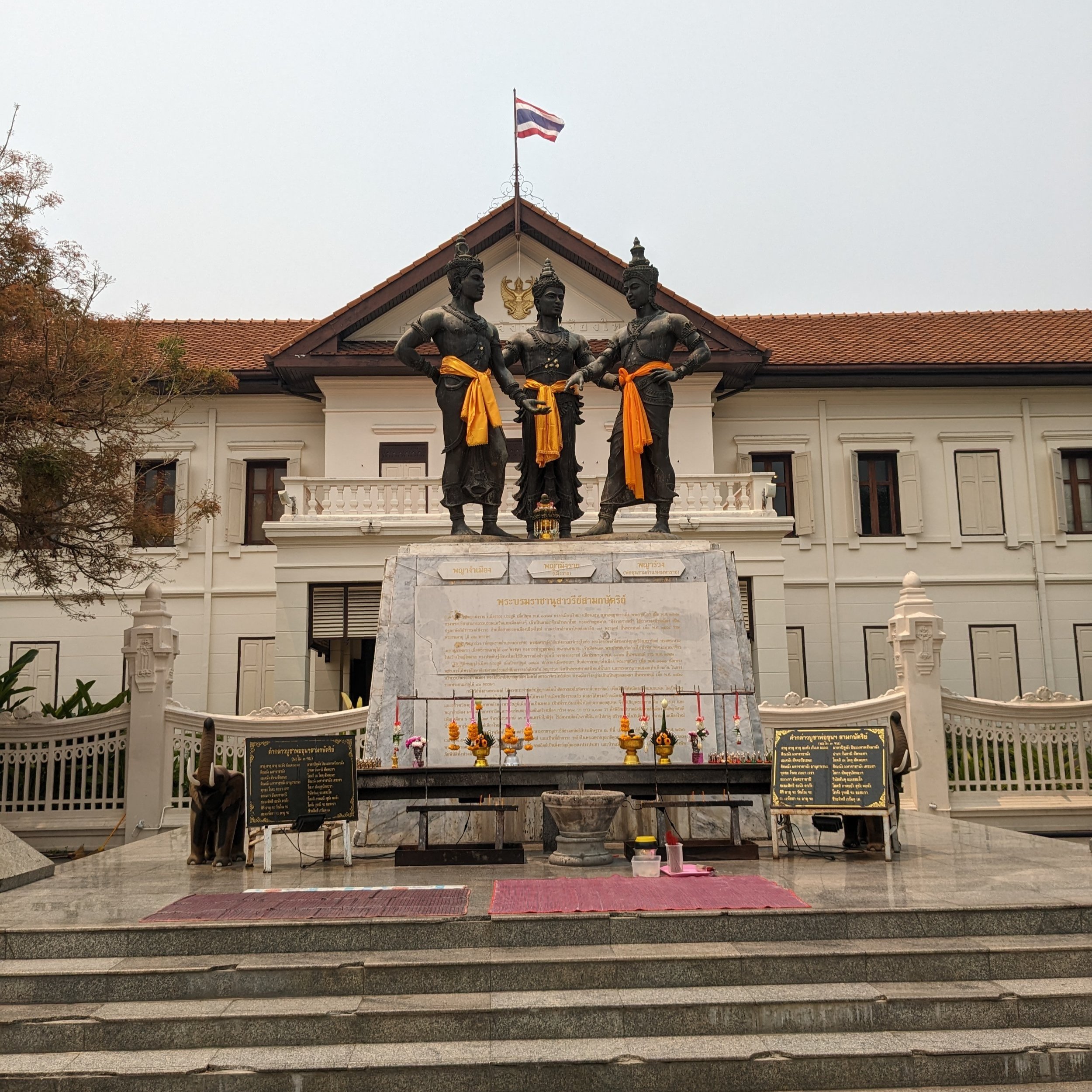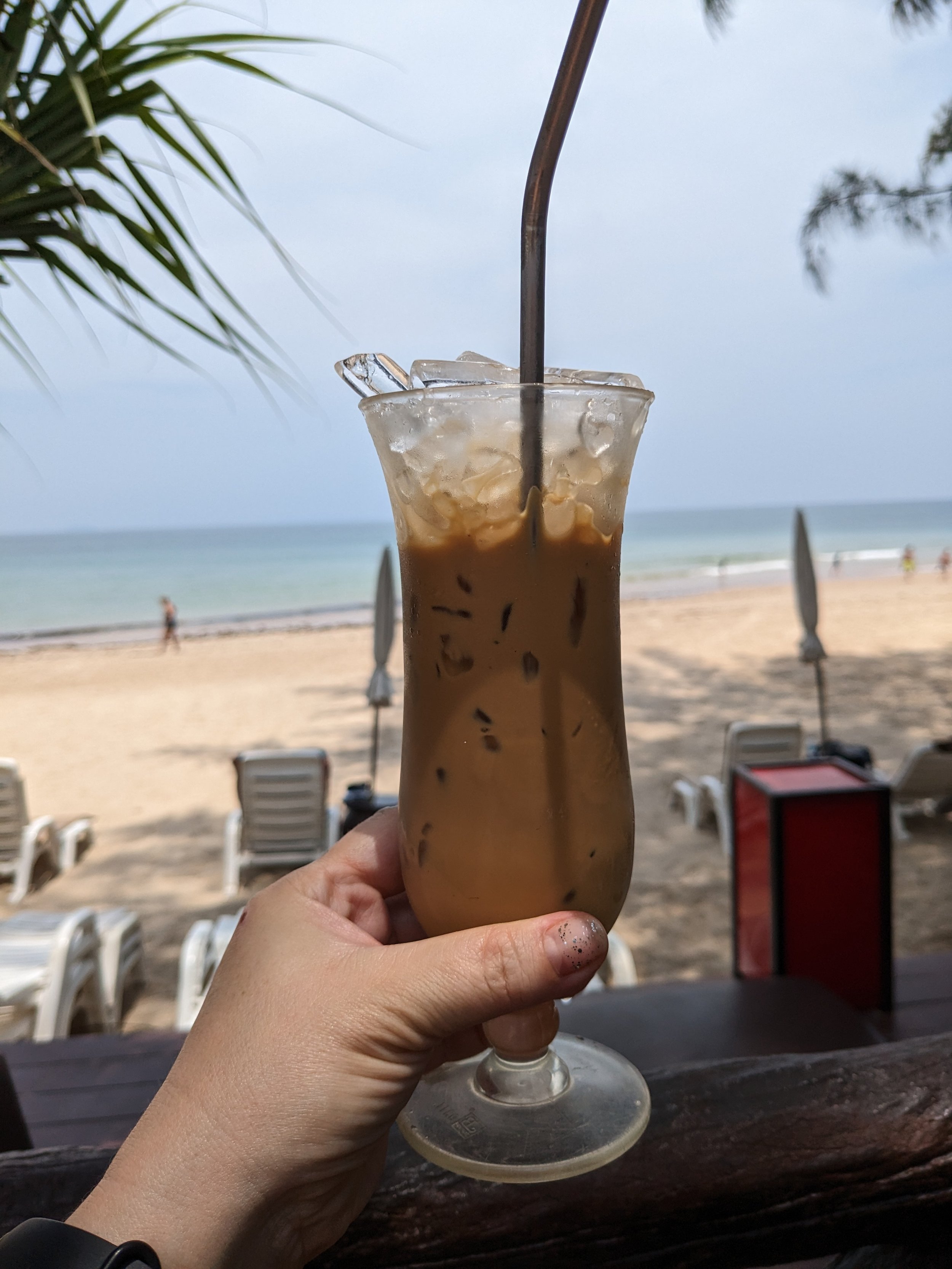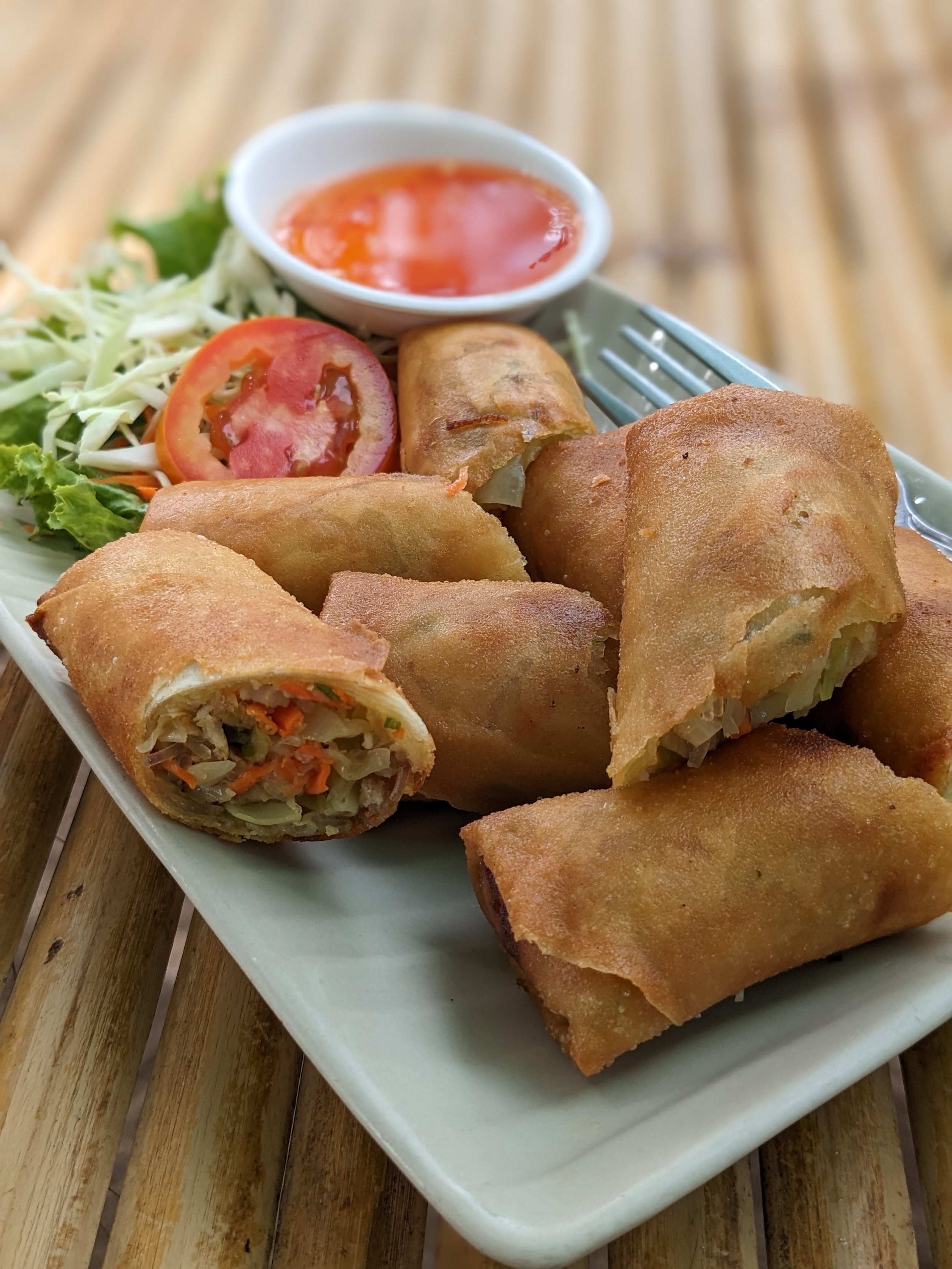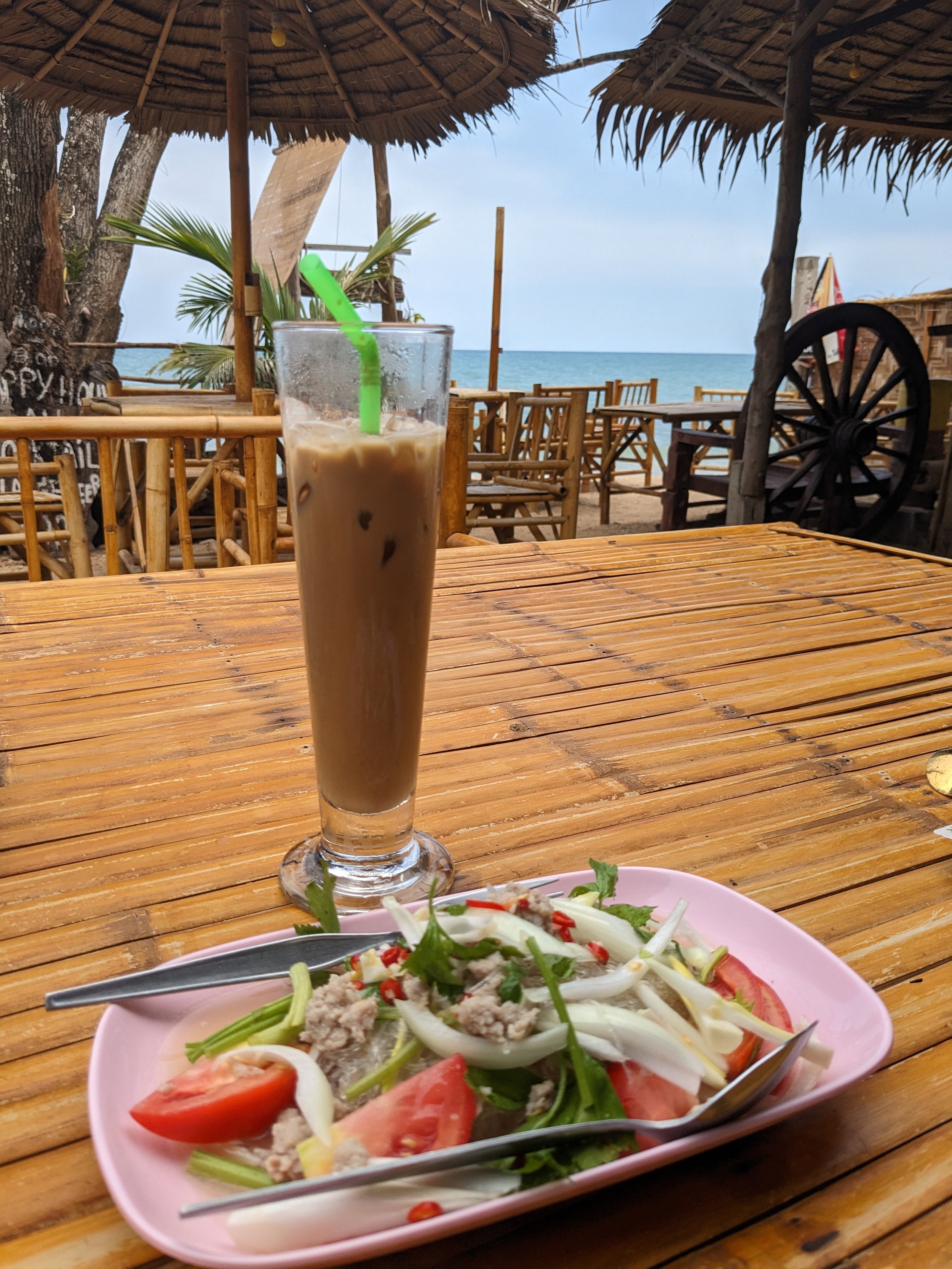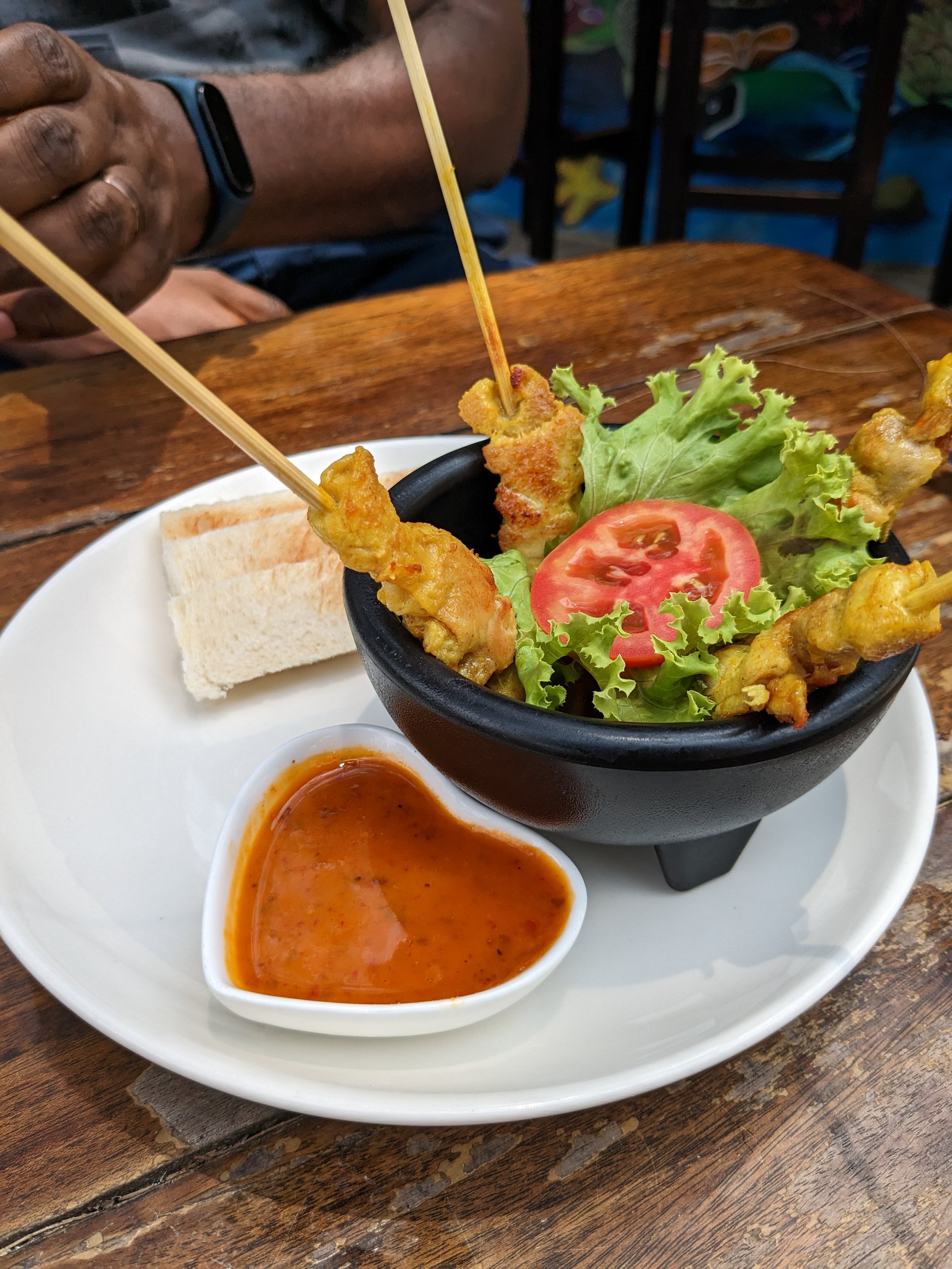Budapest Passed the Test... and Then Some
First, a note from Nate to his fellow Black Travelers: Being Black means running a quiet risk assessment everywhere you land. Most people will never notice it, but it matters. You watch how people look at you on the train, how service workers respond, how a crowd shifts around you. Most importantly, you worry about your safety. Budapest passes the test. Whatever is happening in Hungarian politics right now, the city itself feels open and unthreatening in the ways that count when your skin color is part of the luggage you carry.
I.
I'd be lying if we told you that we knew much about Hungary going into this trip. We knew it was once under the dominion of the Vienna-based Habsburg dynasty that fell after World War I. We knew it was a communist satellite of the Soviet Union during the middle part of the 20th century, and we knew about the right-wing strongman politics of its current prime minister Viktor Orbán.
That is not entirely true for Hope. She had been here before for a conference, but she had not gotten as much time as she wanted out in them streets.
Beyond that limited exposure, the country was largely a blank slate for both of us. Although that is not exactly right either. Hungary was one of the first places where Nate heard about a Black American living abroad and thriving. “Todd in Budapest” was an irregular correspondent on the Chicago-based podcast This is Hell, and we (mostly Nate) had listened to his dispatches from the city over the years.
II. The Slightly Scholarly Stuff
Geographically, Hungary sits in the lowlands below the Carpathian Mountains, and Budapest is bisected by the Danube River. The country is bordered by Austria, Slovakia, Ukraine, Romania, Serbia, and Slovenia (clockwise from west to East)
The Hungarians, also called Magyars, are not indigenous to the area. They came from east of the Ural Mountains and arrived in the 800s, displacing various Slavic tribes. They were later invaded by the Mongols in 1240, then the Ottomans, then the Austrian Empire. After World War I, Hungary briefly had a Communist government in 1918, which was overthrown by Nationalists. They were toppled by the Nazis, who were overthrown by the Soviet Red Army, which controlled the region until 1991.
Phew.
III. The Good Stuff and a Tangent
We departed from DXB on an ill-advised red-eye flight that landed us in Budapest at 1:30 in the morning. We know we are too old for red-eye flights, but for reasons that rhyme with being sheep we continue to do this to ourselves.
We rented a room in the Jewish Quarter of town and used it for our point of embarkation for our adventures. In the Jewish Quarter there are monuments and markers to the forced deportation of Hungarian Jews during the Holocaust around the city. But they all take on a passive voice, avoiding the complicity of local authorities and officials. Nate compared it elsewhere to the passive-exculpatory or past-exonerative tone US media often grants police. The state’s narratives largely deny the country meaningful agency, instead treating Hungary as a passenger on the train of European great powers history.
This stuck in our craw during our time in the city because of events back home.
We should not absolve collaborators for the terror they enable. Museums in Vietnam are exemplary in how they tell the story of Diem and other collaborators, and how their actions enabled occupiers and prevented the country’s unification. When all of this tragedy is over, we want the Lindsey Grahams, the Marco Rubios, and all the enablers who knew better the entire time to be named and shamed for the rest of their lives.
They should live out their remaining days in infamy.
IV. Back to Our Regularly Scheduled Programming
One of the first things we learned is that Budapest is actually two cities. Buda is the administrative side of the Danube, where the Prime Minister and President’s offices are, along with forts and churches from days of yore. We stayed in Pest, pronounced “Pesht,” where Parliament and the Jewish Quarter are located. It is more or less ground zero for nightlife. The two sides are connected by a series of bridges that had to be reconstructed after the Nazis destroyed them while trying to slow the Soviet advance during World War II.
We hit the streets around 10:00 the next morning for a walking tour, where we learned the history of invasion and occupation we recounted above. We never thought we would become “walking tour travelers”, but this was one of the best tours we have experienced.











We spent the next four nights slumming around town and eating embarrassing amounts of goulash and paprikash. The architecture is breathtaking. Some of the Habsburg era buildings read as Parisian to us, which probably says more about the fact that neither of us has visited Vienna than anything about the buildings themselves.
In other neighborhoods you will see buildings from the Soviet era with their distinctive brutalist architecture. The characteristically angular apartment blocks are scattered across the city. We will save you a rant about how all the post-communist states we have visited also have plentiful affordable housing, but if you know you know.






Perhaps the most interesting structures are the “Ruin Bars” scattered throughout the Jewish Quarter. A Ruin Bar is exactly what it sounds like. It is a cluster of dive bars tucked inside old, half-forgotten buildings where the scars of the last century are still visible. Instead of renovating these spaces, people leaned into their decay and filled them with whatever furniture, art, and lighting they could gather. For our Tacoma people, imagine if Bob’s Java Jive was on Antique Row but went on for an entire city block. The effect is a kind of deliberate scruffiness. You wander through courtyards and broken rooms that feel improvised but also strangely welcoming.
On our last night we found ourselves once again staring down bowls of paprikash we had no business ordering, talking through everything we had seen. Budapest passed the test. And if we are being honest, it probably earned a return trip.
Dahab: Where the Desert Meets the Sea
Whoever came up with the “Red Sea” should be fired. The sea is in fact both deep, dark blue and vibrant turquoise or Gatorade “Blue Raspberry” depending where your eyes fall.
After three days of online parent-teacher conferences here in Abu Dhabi, we hopped on Egypt Air , and journeyed from Abu Dhabi to Cairo to Sharm-El-Sheikh and then were picked up by the best travel docent in the game li, Ramy. If you haven’t read our blog about the Cairo & Luxor trip with Travel Ra Amen, do so now.
Dahab is giving Tulum circa 2010 pre-being ruined by Instagram influencer vibes, Dahab is that beach town. While Cancun-esque Sharm-al-Sheikh has fancy resorts and pulls in those polo-shirt-wearing-former-frat-boys for their golf trip, Dahab is for those who want to wear old flip flops, athleisure, and walk down the beach. It’s for those who want to grab a snorkel or dive gear to explore the vast coral and sea life or pick up windsurfing in the Blue Lagoon. It’s for those who want to stuff their faces with high quality shrimp, calamari, or swordfish. And lastly it’s for those who find peace perched on mismatched cushions, smoking shisha, and drinking tea late into the night.
Just the Facts on Dahab and the Sinai
Official name: Sinai Peninsula (part of the Arab Republic of Egypt)
Provincial Capital: El Arish
Currency: Egyptian pound (EGP)
Language: Arabic
Independence: Part of Egypt since antiquity; occupied by Israel following the 1967 War, fully returned to Egypt under the 1979 Egypt–Israel Peace Treaty
Borders: Israel and Palestinian Gaza (northeast), and Gulf of Aqaba and Saudi Arabia (east)
Top Exports: Petroleum and natural gas; also tourism revenue from Red Sea resorts
Dahab features a long waterfront boardwalk that has seasons, it transitions from packed sand, to cement and cute lighting, peppered with cute shops, seafood restaurants, and cafes. In the center of town there’s a main street with two way traffic, busy roundabouts, and the usual local shops. Cafes next to fruit stands next to bike shops next to bakeries next to corner tiendas. When you step off the main drag, you’ll find beautiful street art, hella goats looking for snacks and a few camels and roosters hanging out in the backyard of someone’s villa or apartment.







Putting on our Human Geography cap for a moment, the people of the Sinai Peninsula are fascinating. With more than twenty Bedouin tribes still living largely traditional lives, dealing with modernization, while maintaining their traditions. For additional homework try this piece by National Geographic, this on St. Catherine, Sinai Monastery, or this Al Jazeera article on how the war in Gaza would impact the Bedouins.
This was a trip meant largely to catch up with Ramy, his wife (a former ACS colleague), and their adorable new baby. We did mostly that, consuming kilos of meat, fish, and mashi in the process.
We were in town for four nights, meandering town, eating Egyptian falafel (which we’re convinced is the best falafel thanks to fava beans, rather than chick peas), watching the waves roll in, breathing ocean air and just relaxing.
No beach town trip is complete without a boat ride. Our speedboat was manned by a kid who seemed like he was 12 years old, who while clearly “experienced”, Nate loudly questioned the development of his frontal cortex as he made some questionable choices about when to gun the engine. As you can see from the pictures, the Blue Lagoon was worth the precarious ride.
We continue to be impressed by Egypt. It’s loud, chaotic, and dusty as hell. But it’s also beautiful and packed with amazing history, food, and most importantly amazing people.
Việt Ever So Humble
In the hypothetical documentary retelling of our teaching careers, Southeast Asia is kinda patient zero for our life teaching abroad. Our decision to depart Tacoma all kinda unfolded over a fourteen day period in late July to early August of 2018.
We’ve told the story elsewhere: the public bus on the way to Ao Nang. Later the metro in Kuala Lumpur where Nate said “I think I want to live here.” Lastly, the moment of realization in Cambodia, while touring the site of the Khmer Rouge mass detention and torture center, S-21, that the News Tribune and civic class in Tacoma thought we should “shout less” when it comes to confronting neo-Nazis in the region.
In fact that summer we talked about going to Vietnam but couldn’t be bothered with the visa process on the fly.
Since then we have returned to SE Asia on five occasions. Indonesia right before Covid, and Thailand and the Philippines twice each.
So in August when we finally got to Vietnam, we were stoked and she didn’t disappoint.
The Facts
Official name: Socialist Republic of Vietnam
Capital: Hanoi
Currency: Vietnamese đồng
Language: Vietnamese
Independence: 1954 from French colonial occupation
Reunification: 1976 as Socialist Republic of Vietnam
Borders: China (north), Laos (northwest), Cambodia (southwest)
System: One-party socialist republic, governed by the Communist Party of Vietnam
Top Exports: #1 in cashews and black pepper, #2 in coffee, and #3 in rice
Our Trip
Vietnam has three distinct regions: north, central, and south. Over the years, we’ve come to understand that a slow roll through an area is far more enjoyable than the “two days here and two days” there approach. We spent our two weeks meandering the streets of Ho Chi Minh City (south) and Hoi An (central). With just a few “I really want to do this” agenda items based on friend recommendations, blog posts, and movies, we built a simple itinerary—letting the smell of phở and fresh bánh mì guide our steps.
Ho Chi Minh feels like the convergence of Manila, Bangkok, and Phnom Penh but with a bajillion² more mopeds. We booked a flat situated atop a phở restaurant that only seemed open for lunch in the heart of Japantown. This meant that in addition to local cuisine, we had access to all sorts of sushi, curry, and Korean BBQ and a plethora of night clubs (that we’re way too old to go to). Our routine was straight-forward. Wake up. Eat bánh mì and sip cà phê sữa dà while perched on tiny red stools. Then, walk somewhere to learn more about the community then stop for another iced coffee.
Ho Chi Minh City, previously Saigon (honestly still mostly called Saigon), was our noisy, messy, history-filled first stop. We cranked out our usual summer 25,000 steps on arrival day and over the next several days, visiting a number of sites:
The HQ of the national postal service: for a largely rural and agrarian people at the time, the establishment of a national postal service was a legitimizing step by Ho Chi Minh, showing the Communist Party could literally deliver results for the people.
Notre-Dame Cathedral Basilica of Saigon: the ornate cathedral in the heart of District One was unfortunately under renovation and surrounded by scaffolding when we arrived. The cathedral is a part of a fascinating story of attempted christianization of the country by French colonial occupiers.
HCMC Book Street: just what it sounds like. A street lined with book stores, book kiosks, and adorable cafes with delicious salted coffee and fruit-forward iced teas. One of the by-products of communism that we never seem to note in the west is a commitment to public goods that lead to higher than the global average literacy rates and life expectancy.
Independence Palace: we thought we were going to the famous rooftop from which the last diplomats were evacuated after the fall of Saigon. You know that photo. But we realized the story of the photo is more complicated than we realized. It’s not the US Embassy in the photo; it was an apartment building where embassy employees lived (and the CIA operations were based but that’s a different story). The actual embassy was razed and turned into a park. Of note, Saigon has hella parks (back to the Communism). Instead, we visited Independence Palace where the doomed US backed government was based. It’s now a monument to Vietnamese independence and reunification.
The War Remnants Museum: a sprawling complex located at the site of the former US Department of Defense headquarters in the city. It has several permanent installations devoted to US and French atrocities in their wars of occupation: the philosophical justification for Vietnamese Independence and self defense, US war crimes, Vietnamese journalists killed in the war, and a shocking exhibit on the US use of Agent Orange. The final space on the ground floor is dedicated to telling the story of reunification of the state after the war and international opposition to the US war and occupation.
Vĩnh Tràng Temple
The first stop on our Mekong Delta tour
Mekong Delta Region: typically, Hope pops open Viator or Trip Advisor to find a tour that fits our attention span and sensibilities. Everyone kept telling us to visit the Cu Chi tunnels and Mekong Delta, but we decided that between claustrophobia and the simulated gunfire the tunnels were not for us. We opted just to visit the delta regions and on our tour our verbose guide, “Jack”, schooled us on Vietnamese history, culture, language, and evolution as we traversed “River of Nine Dragons”.
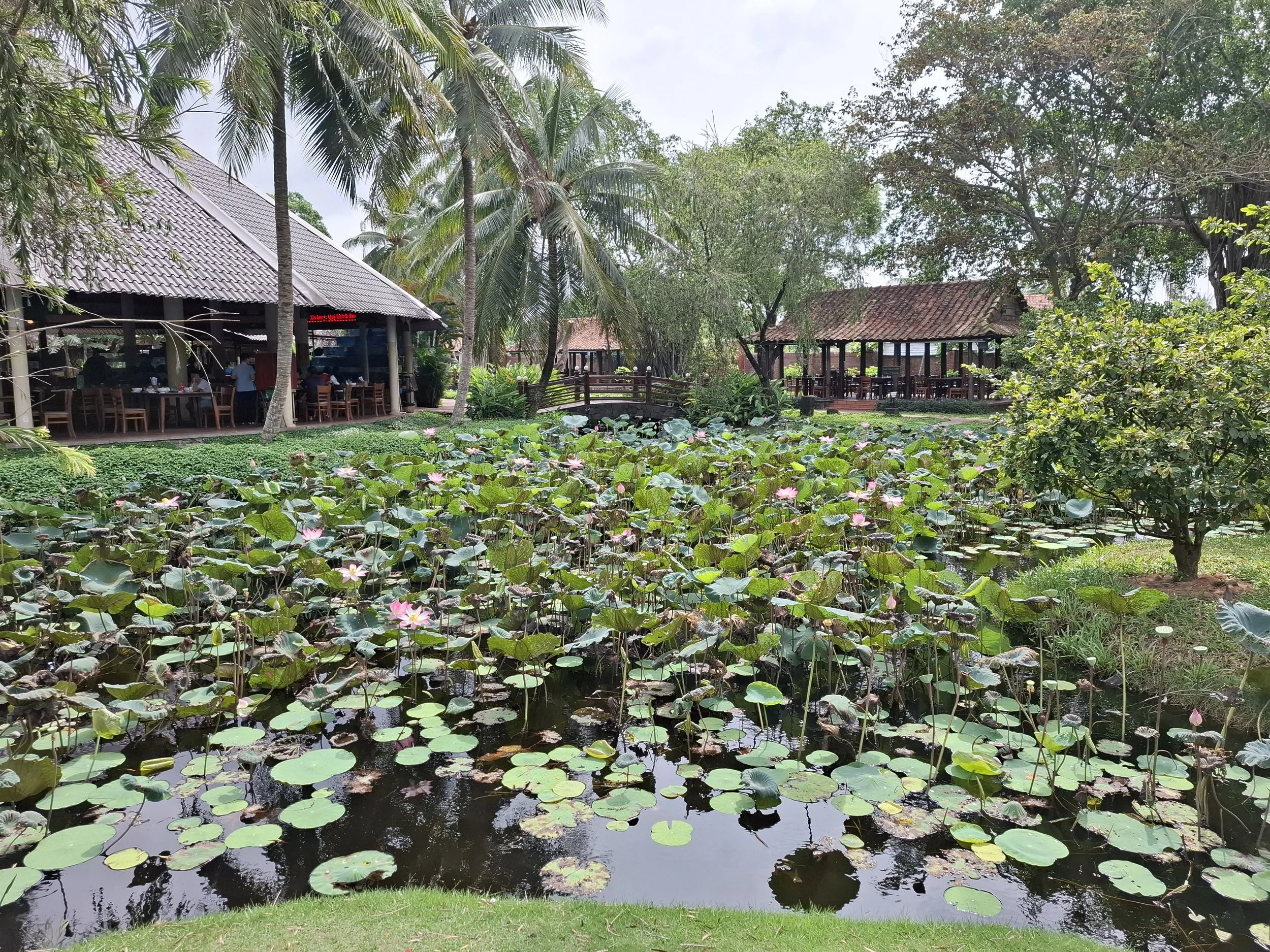
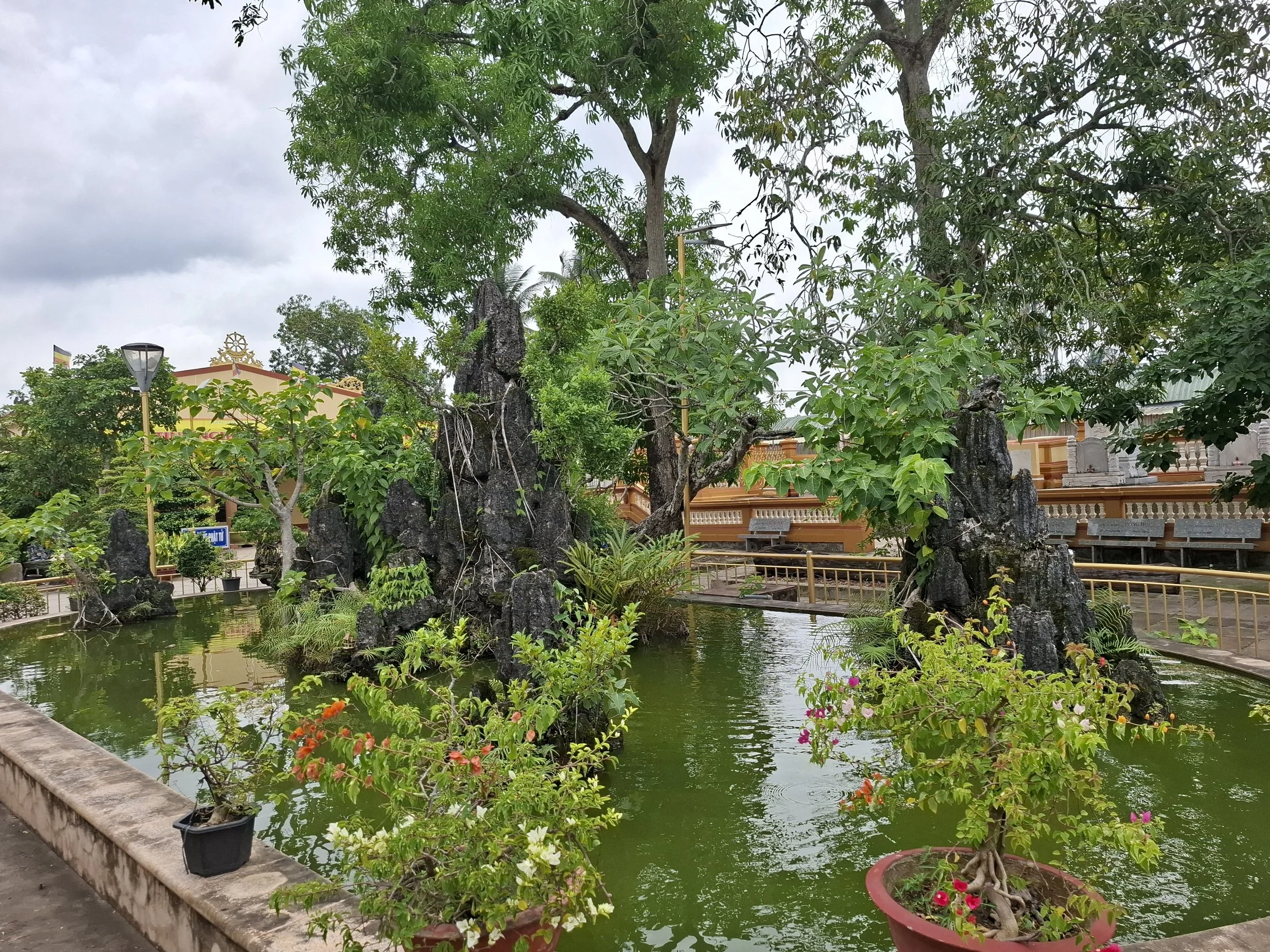
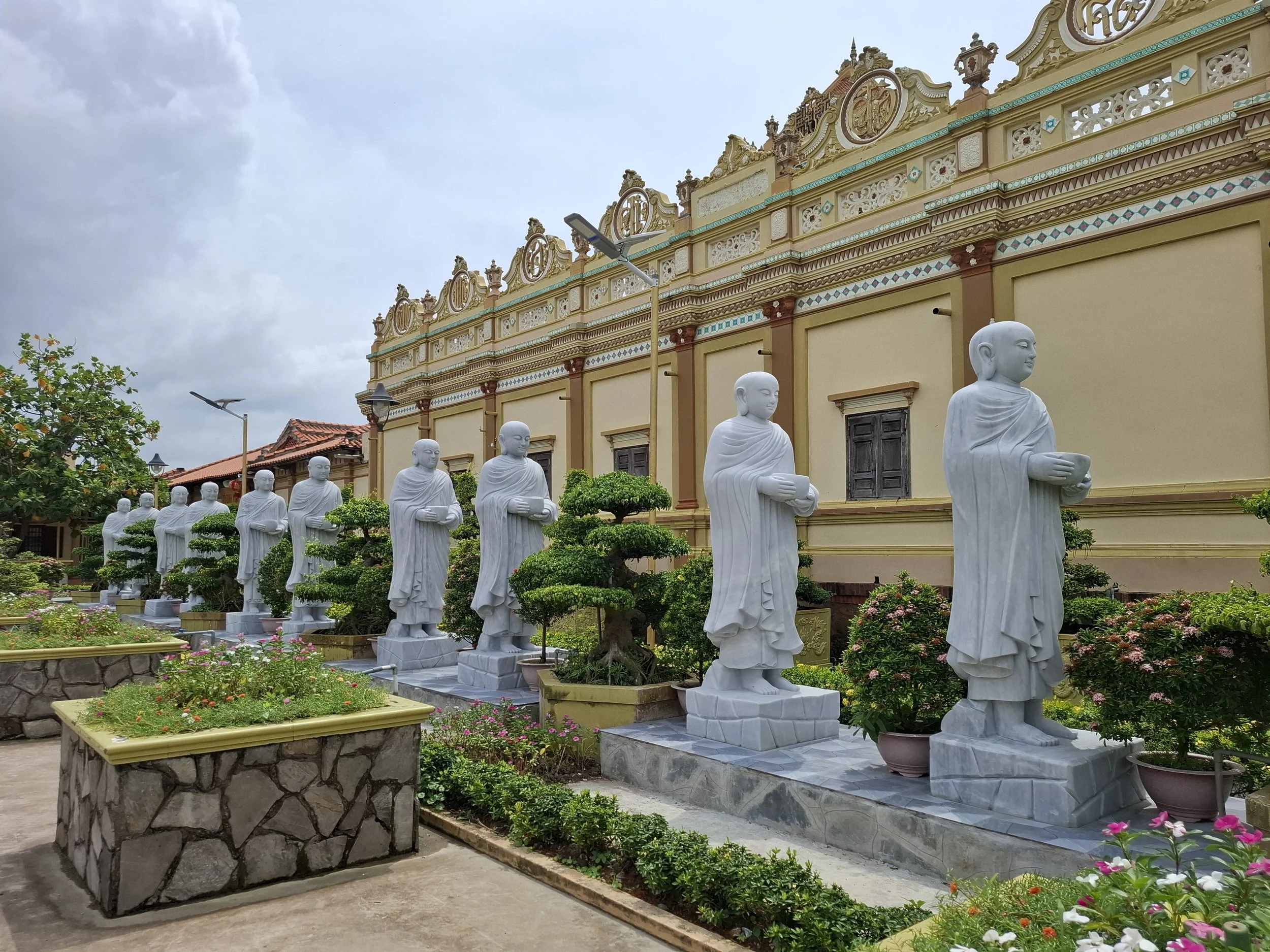
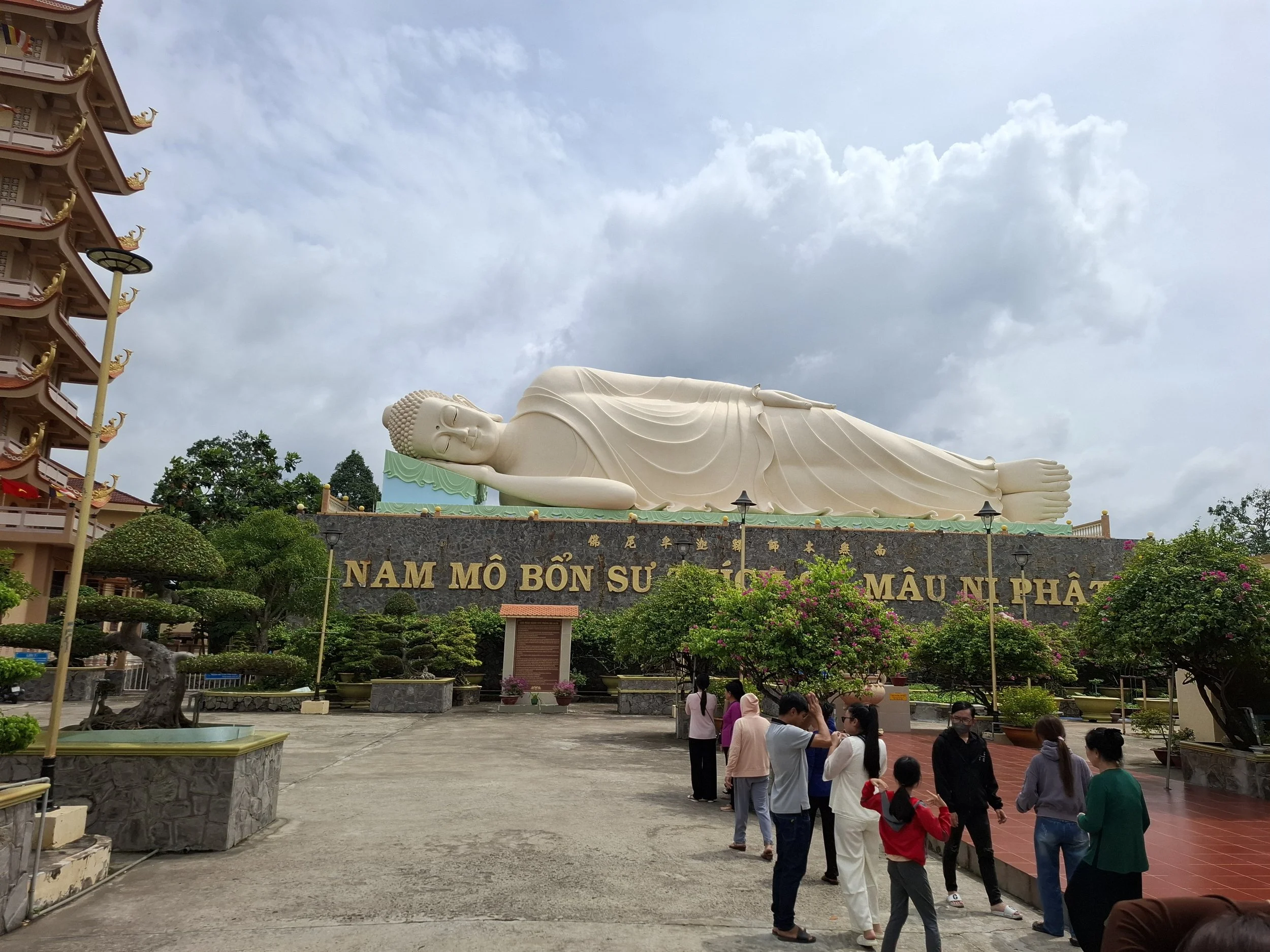
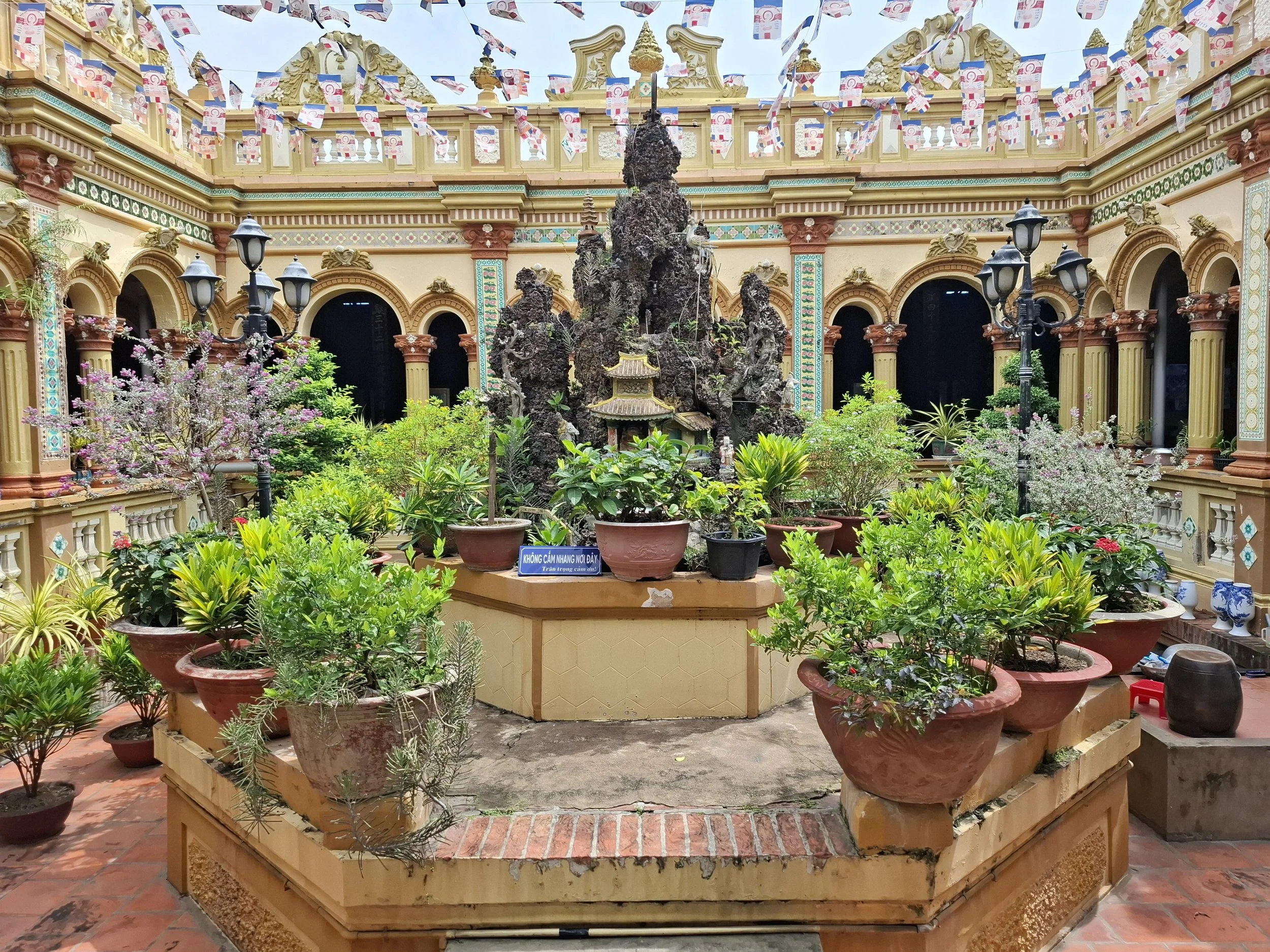
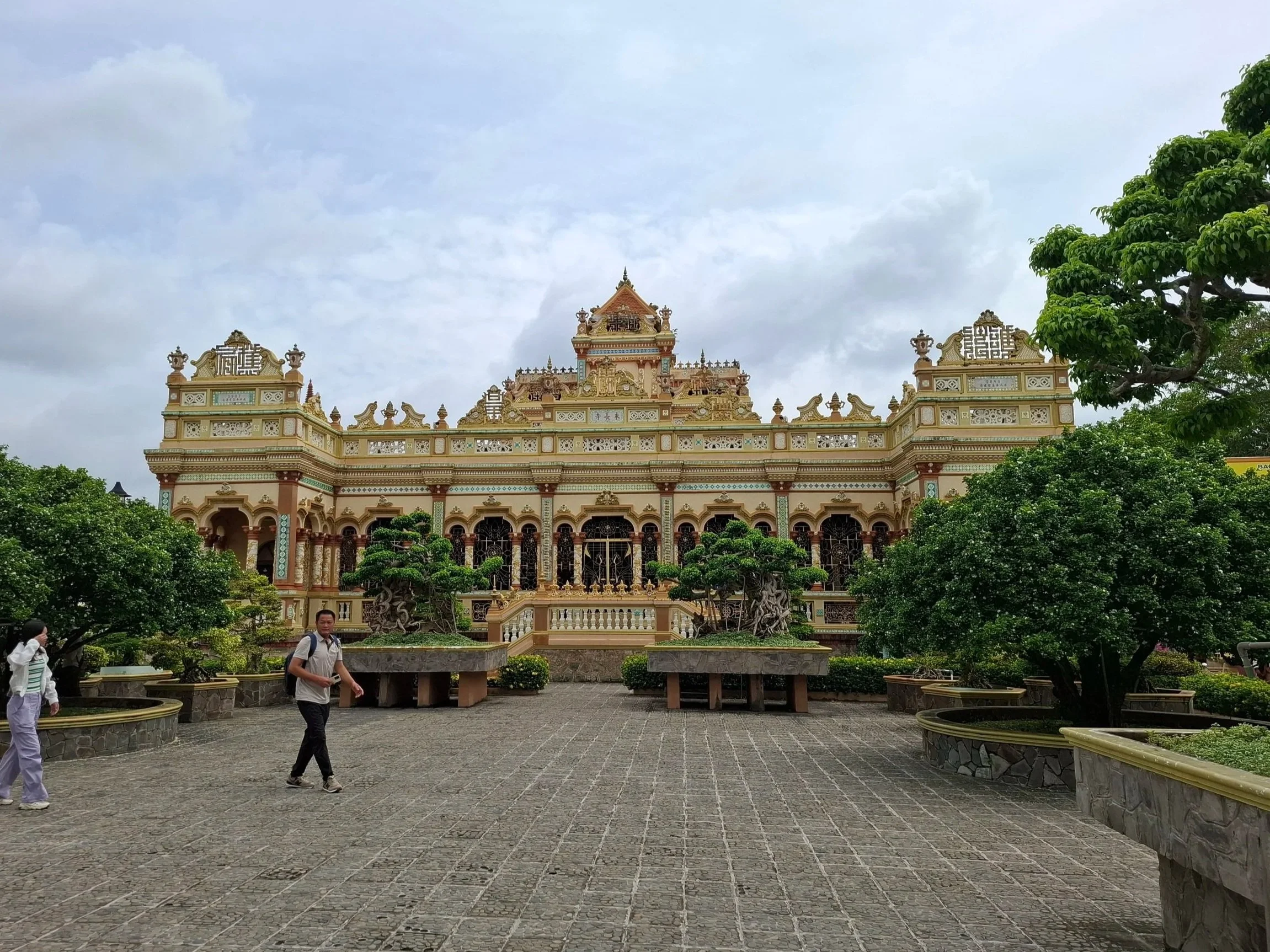
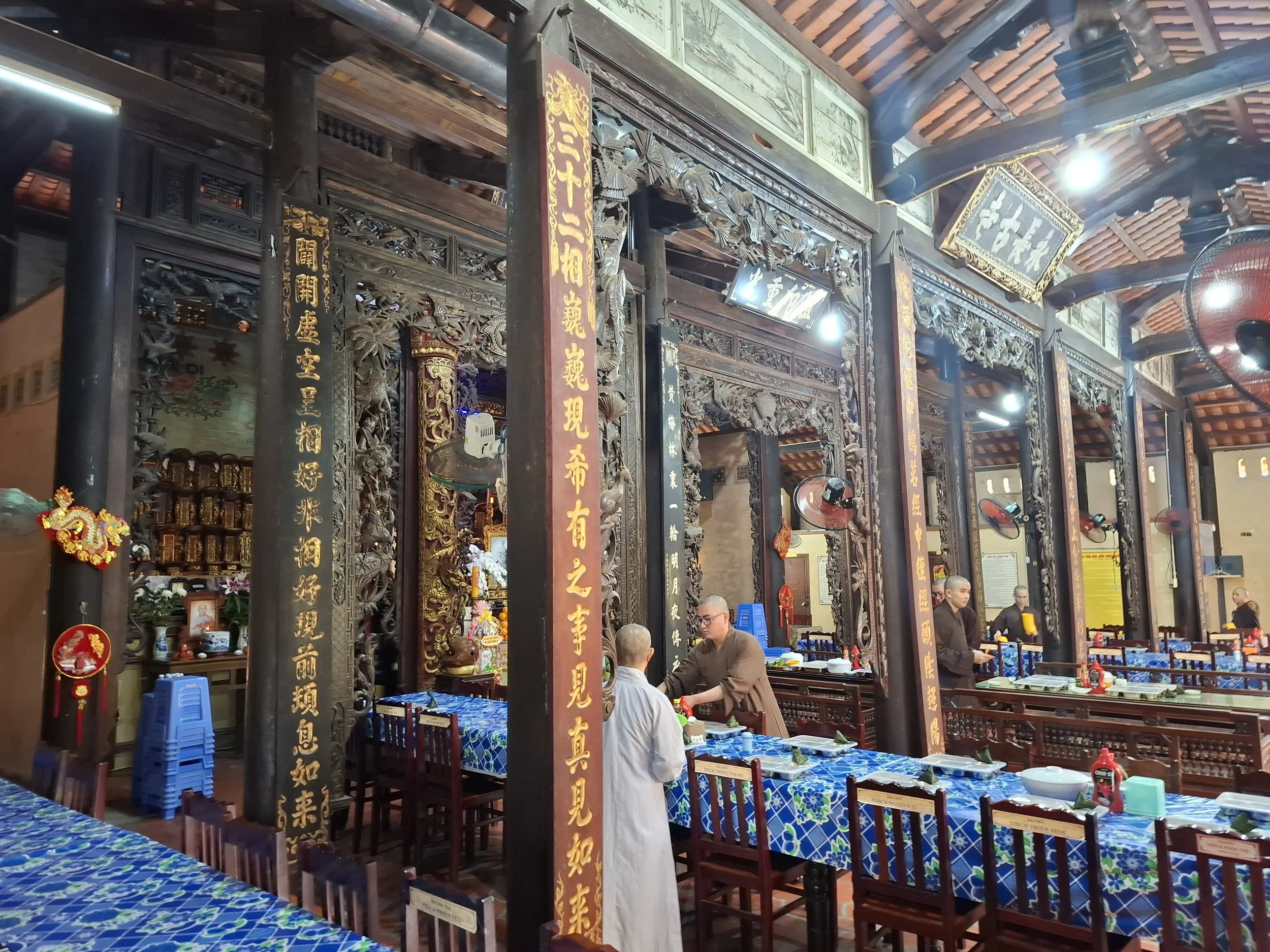
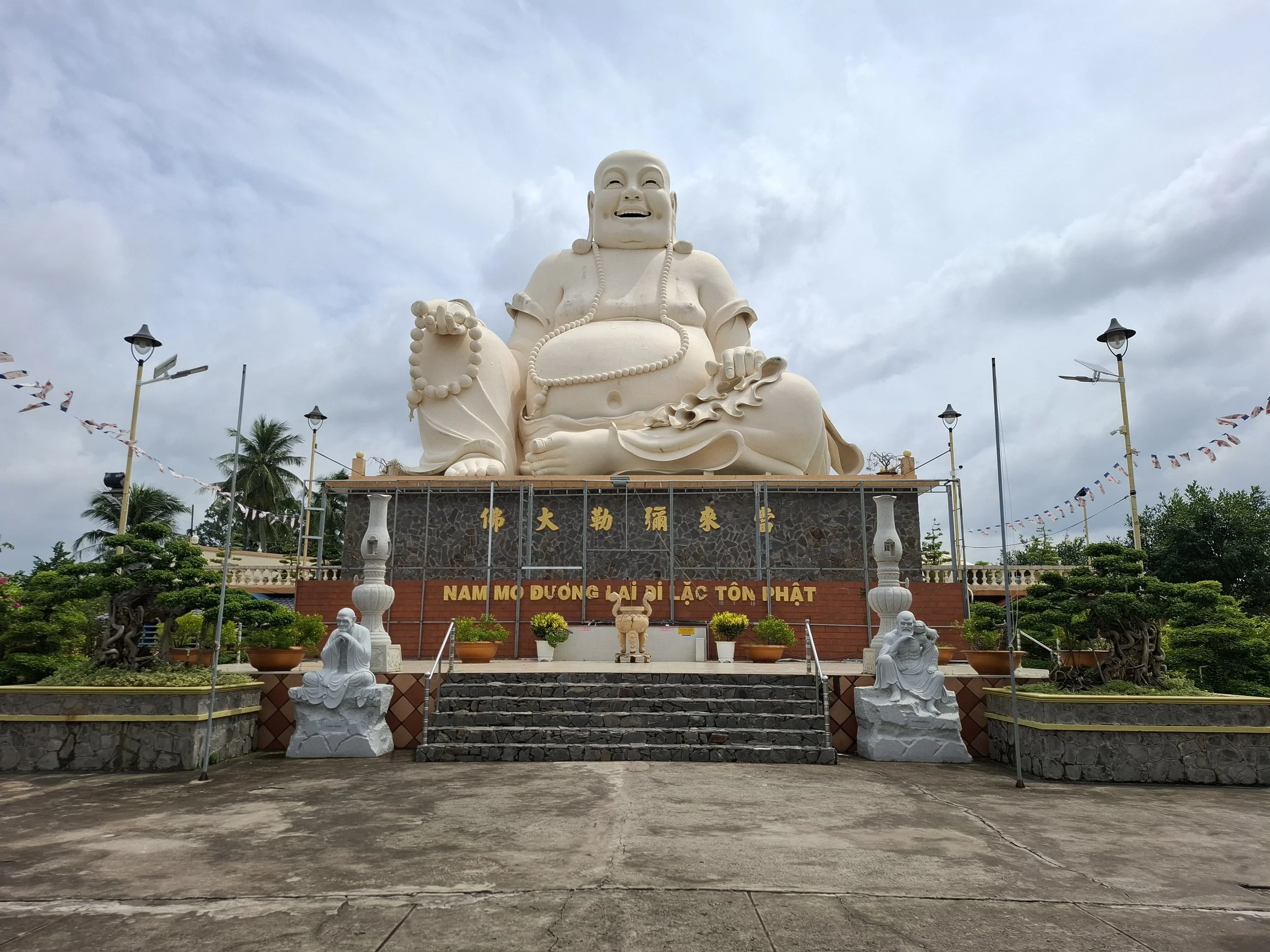

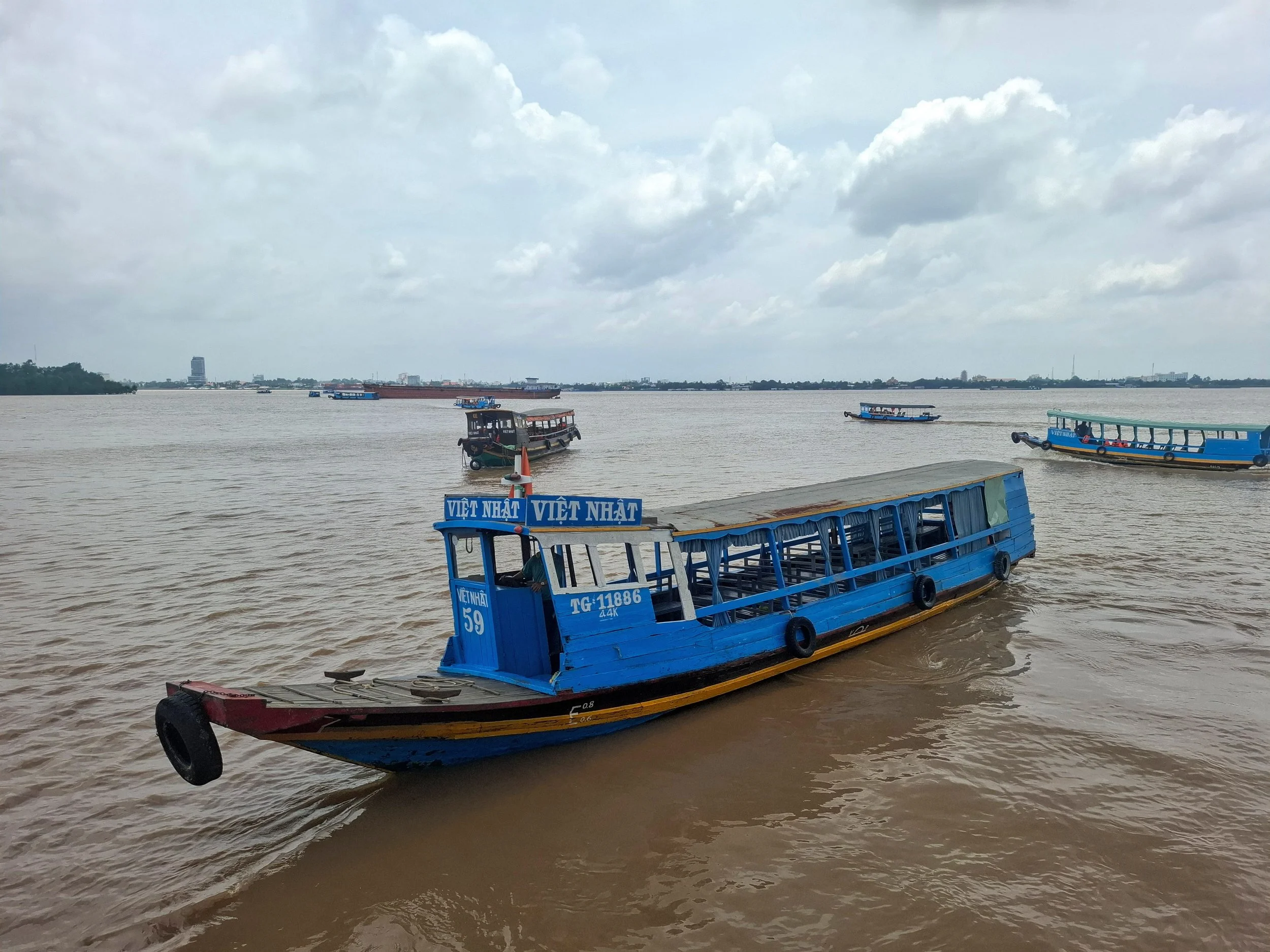
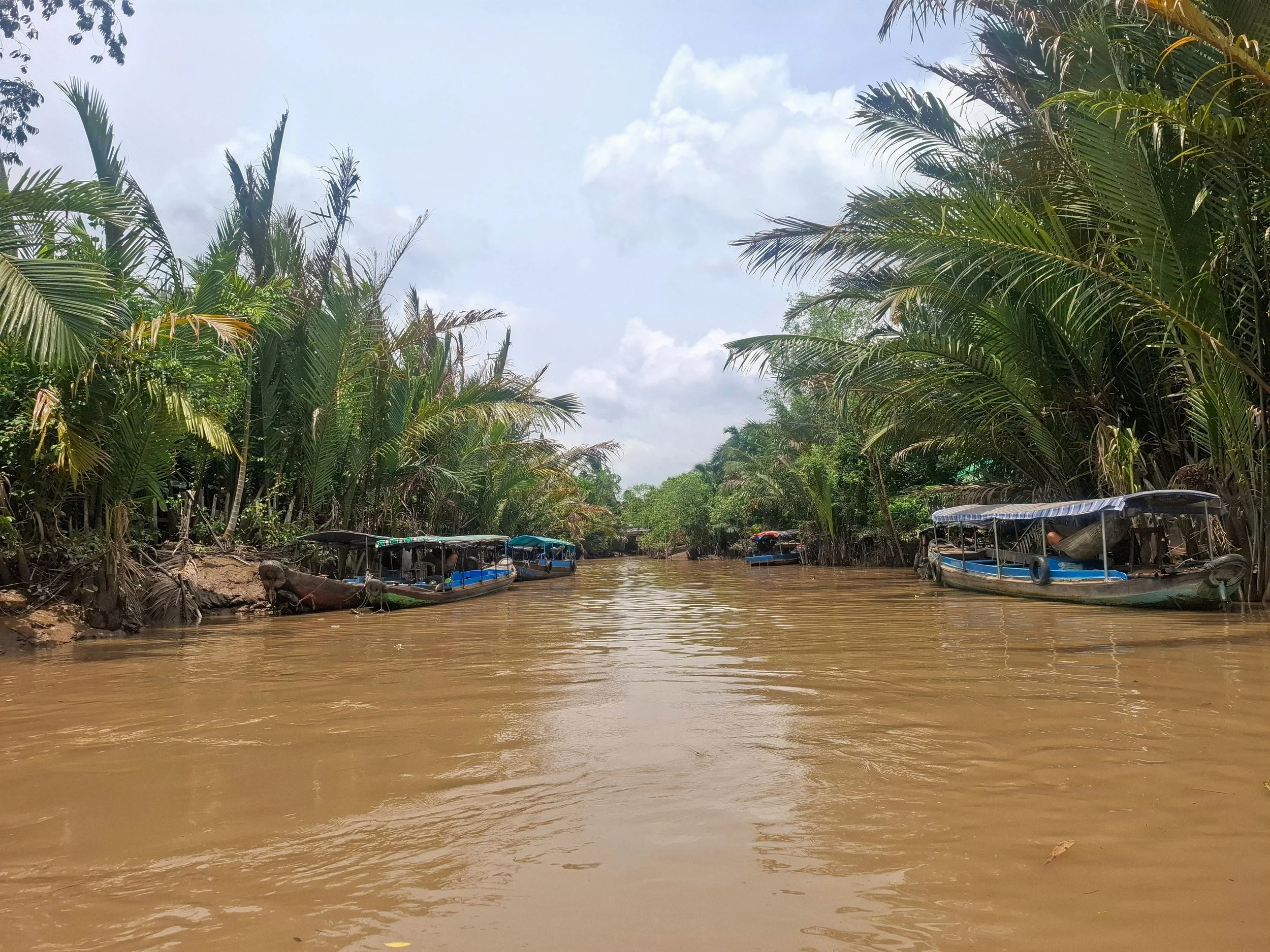
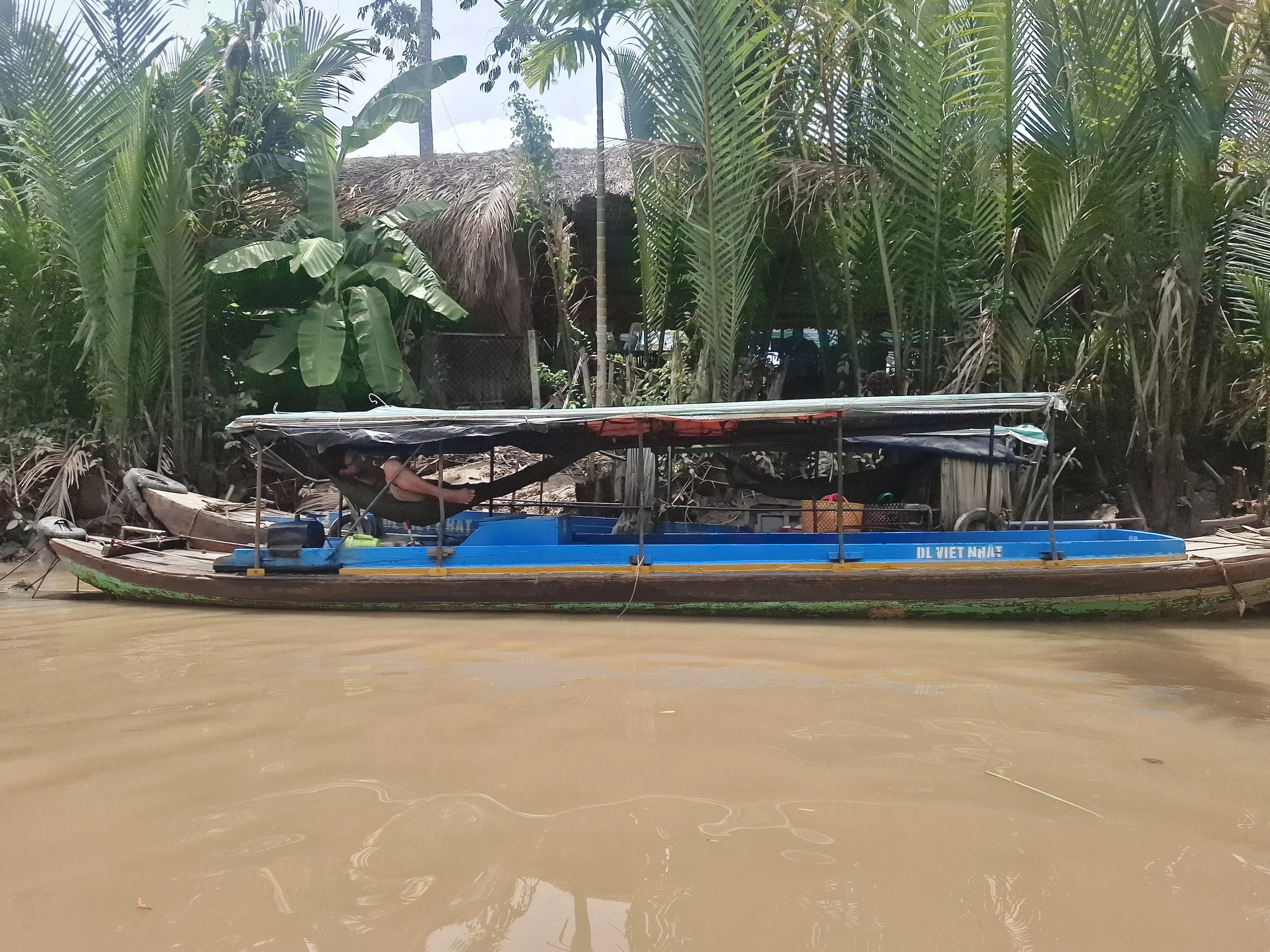
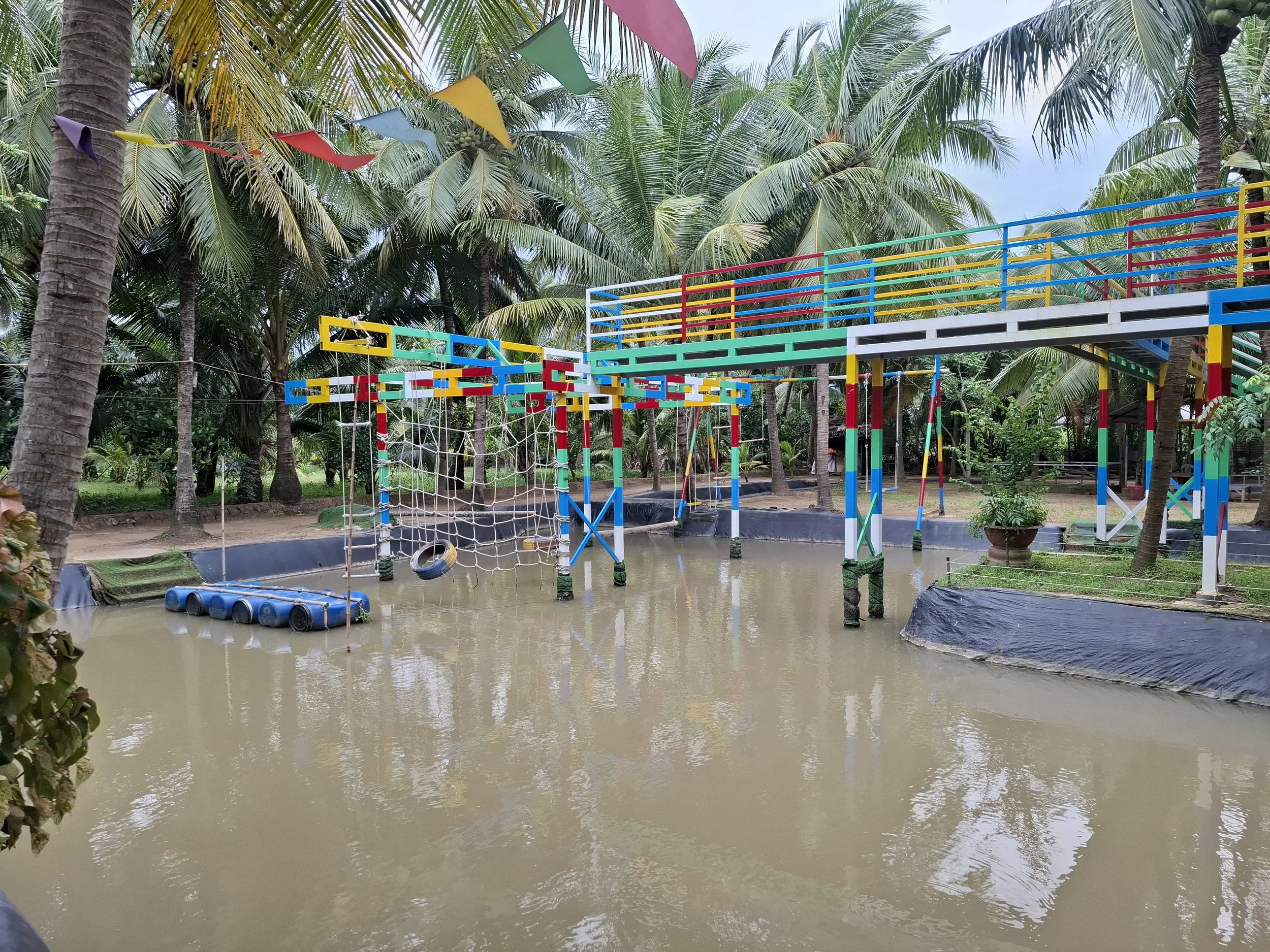
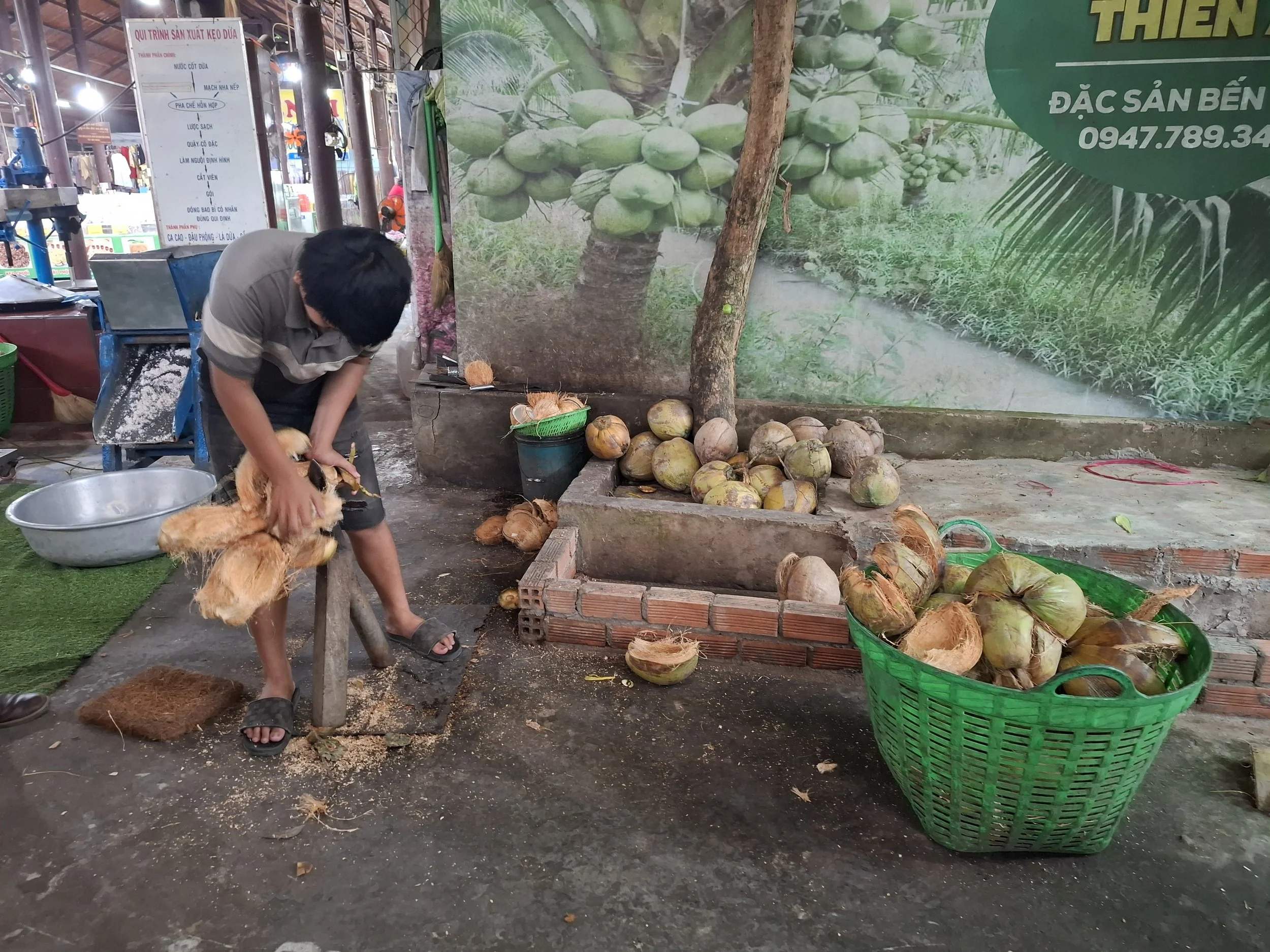
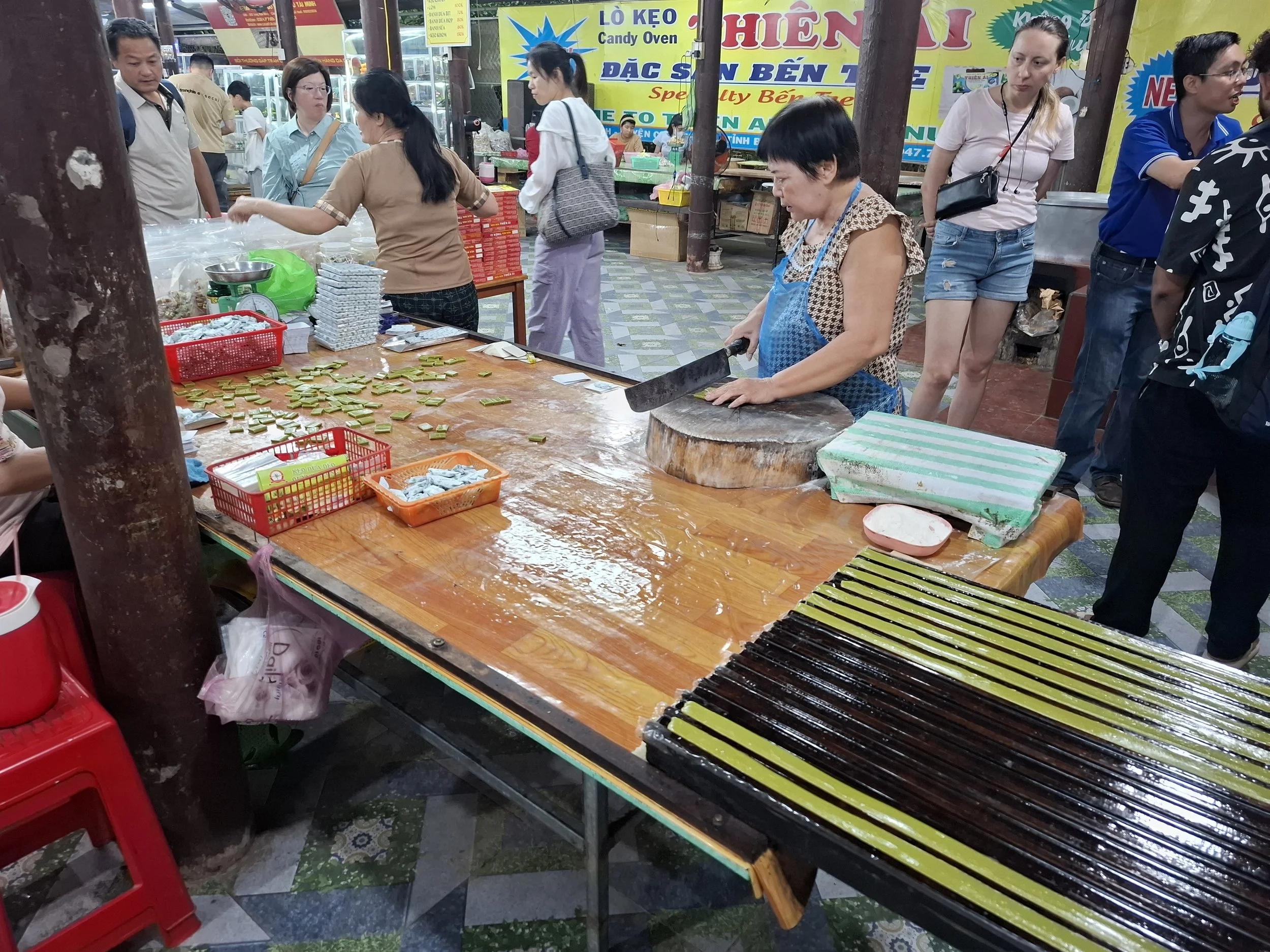
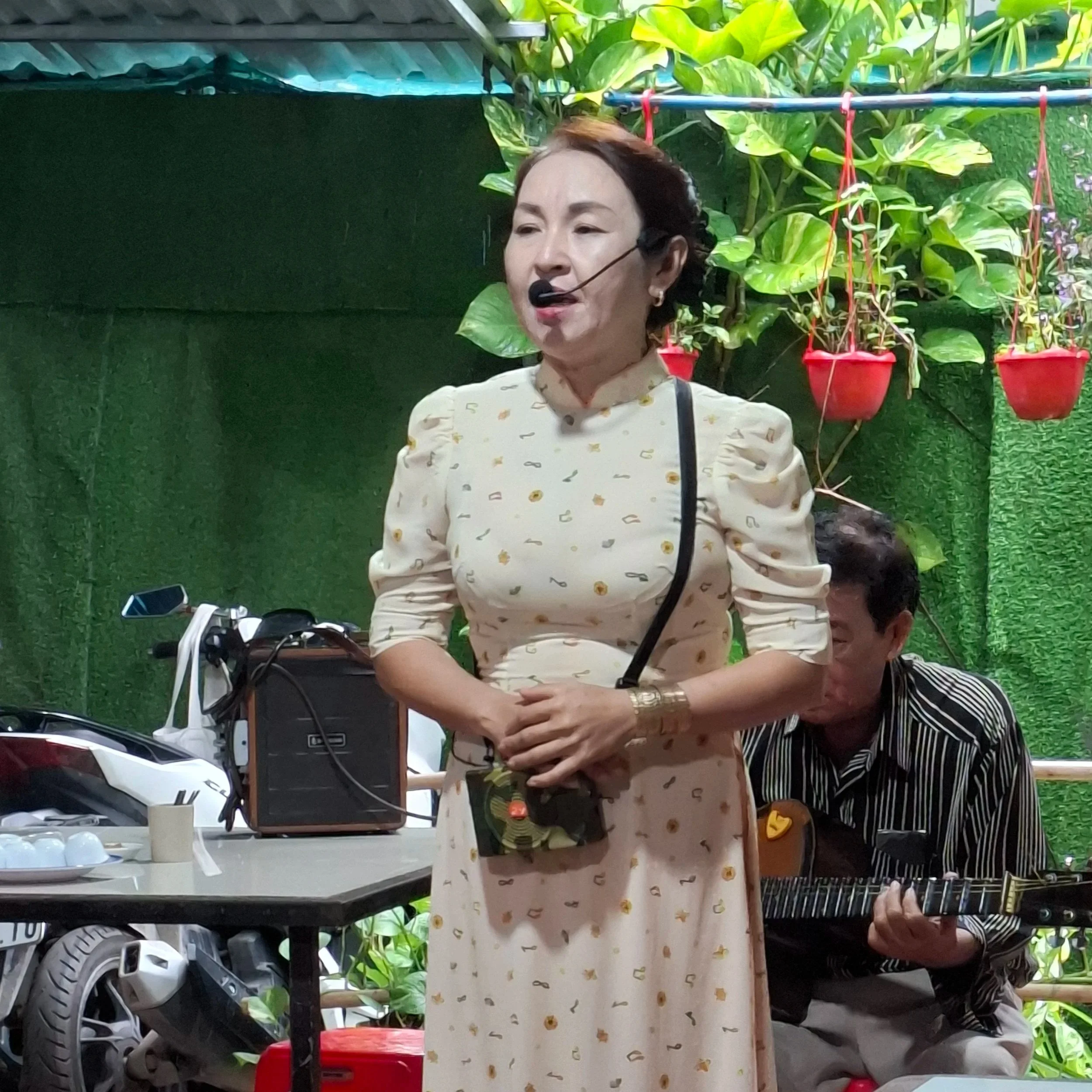
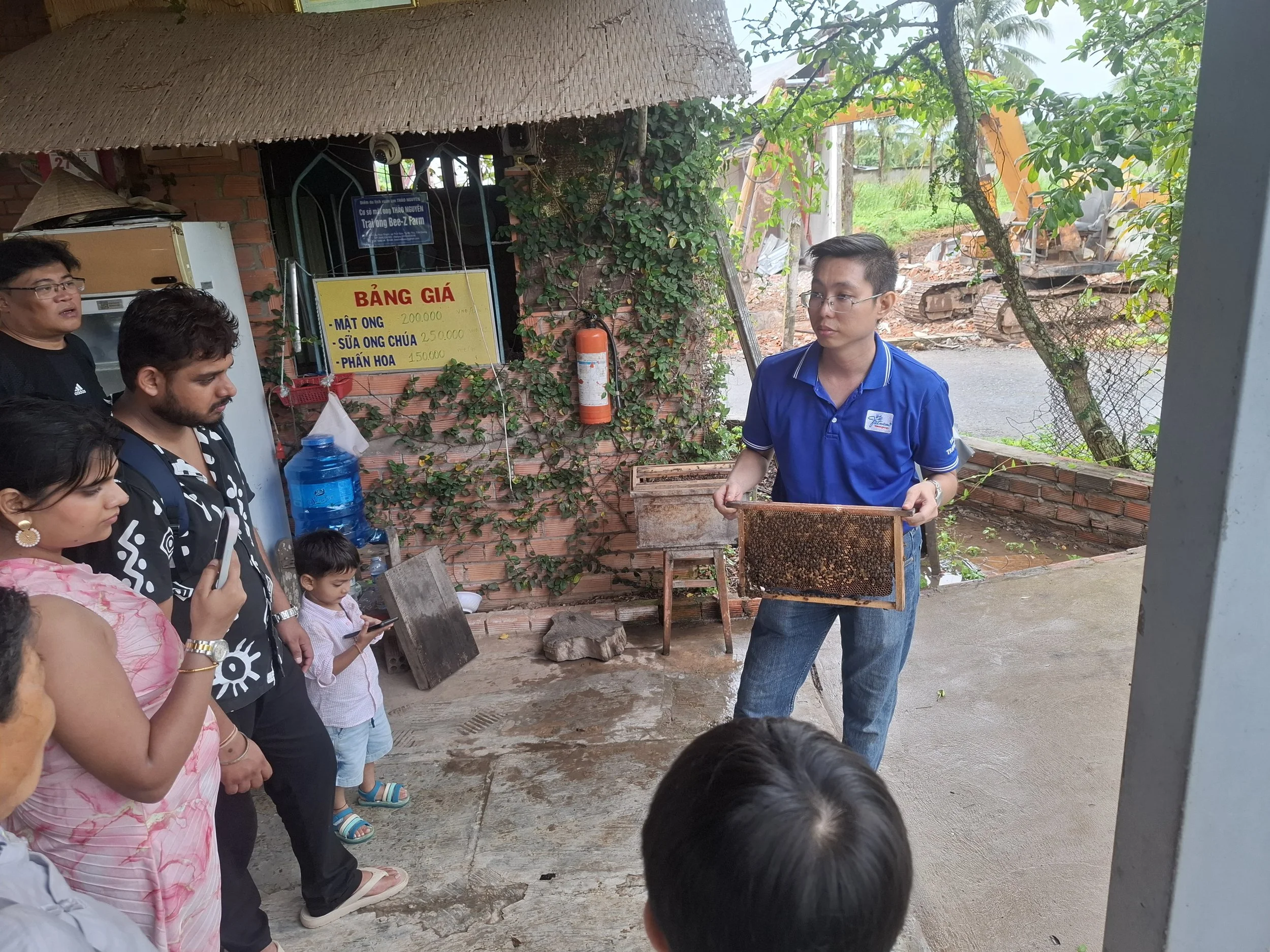
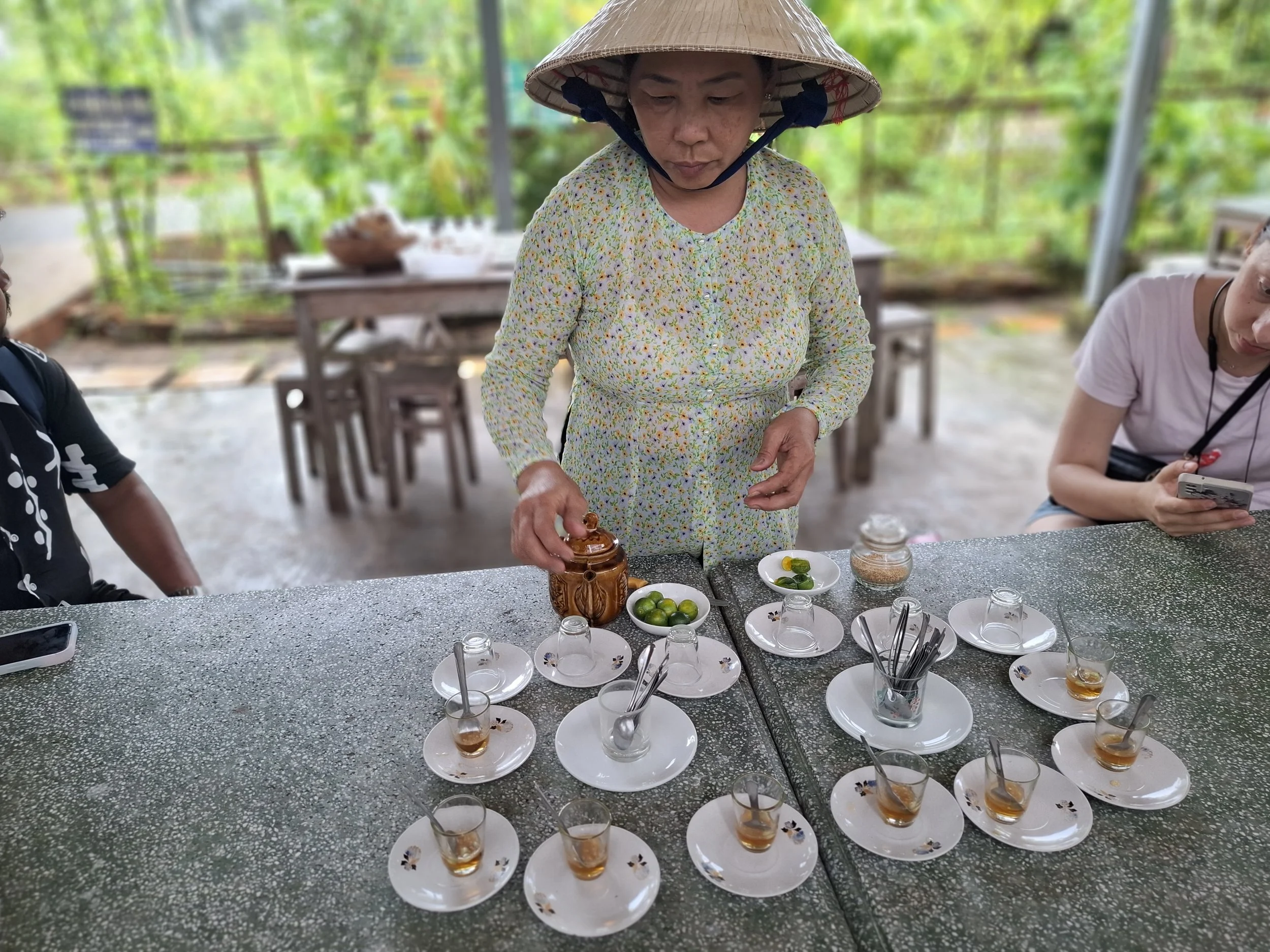
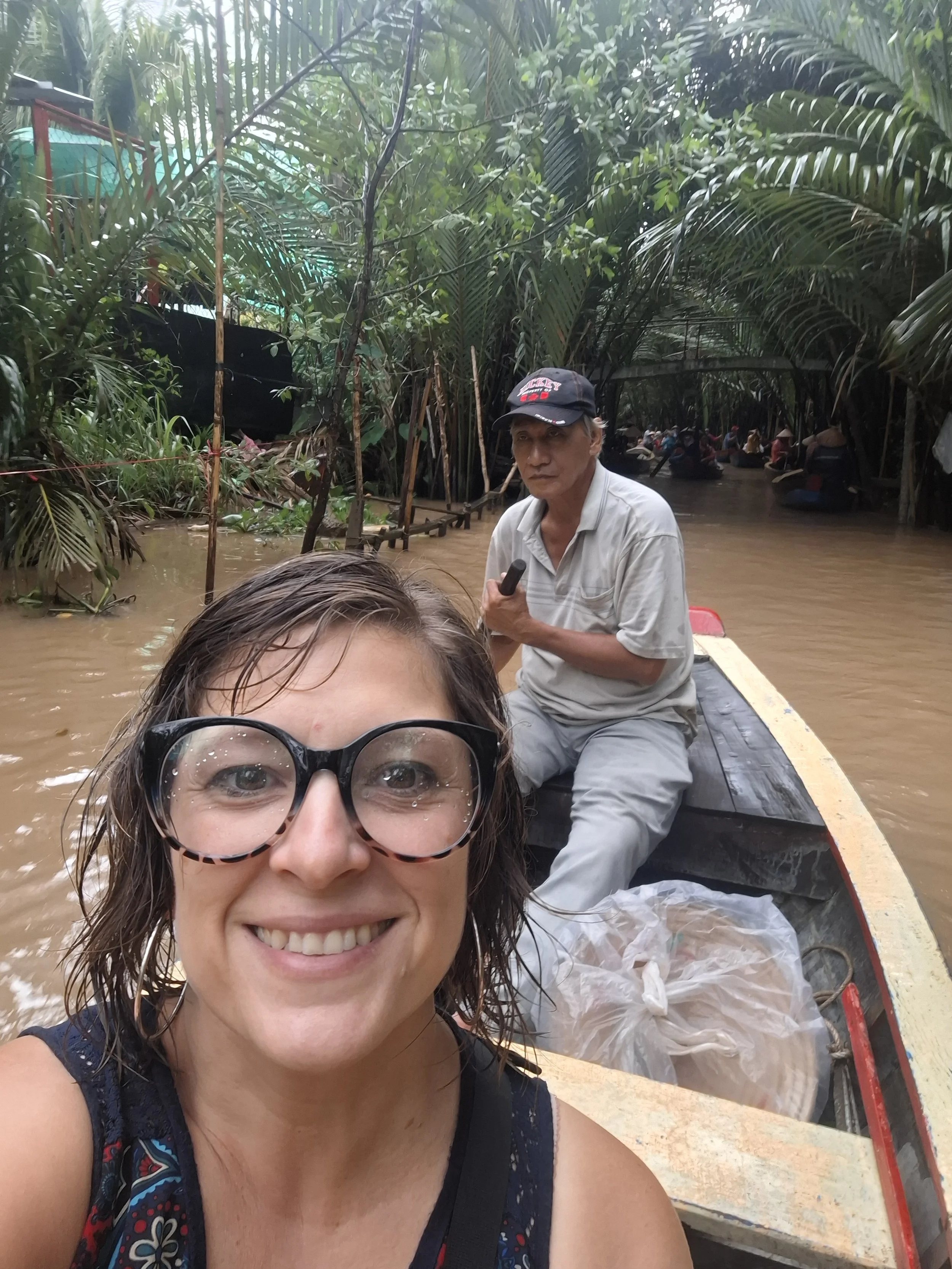
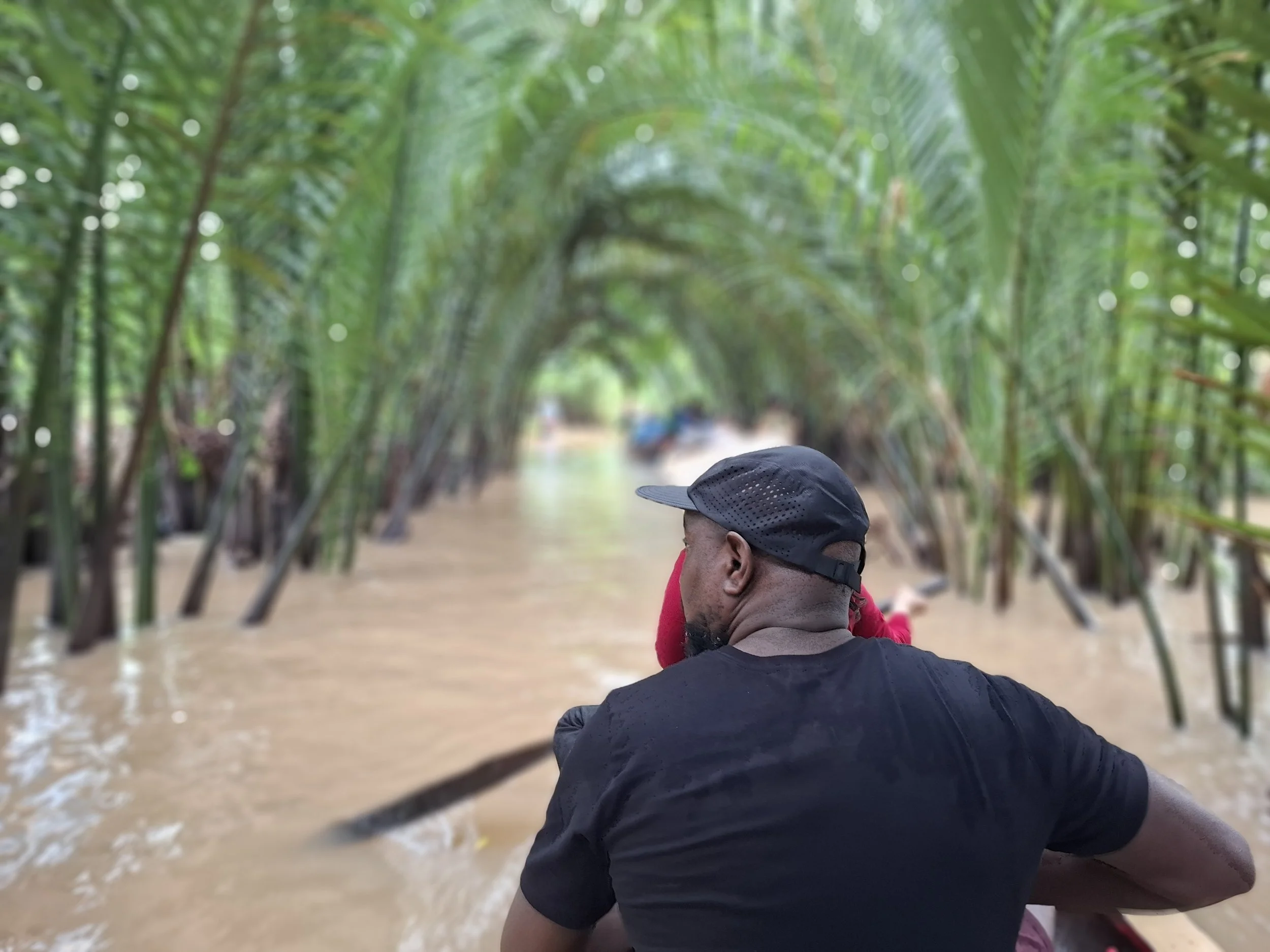
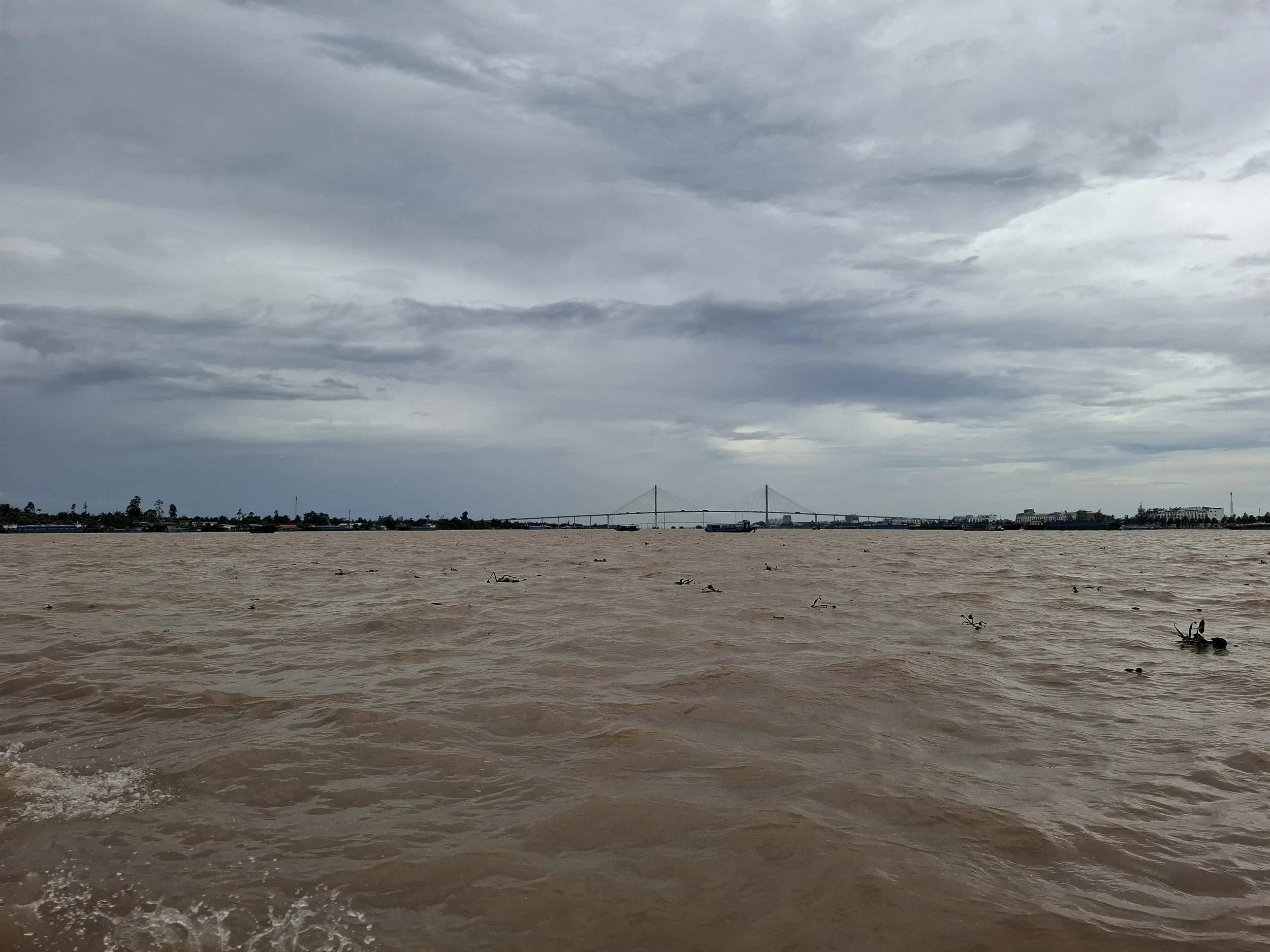
Other Highlights: One evening, we joined a moped street food tour. You haven’t experienced fear and delight until you’re hanging onto a 85lbs guide who is simultaneously pointing out the sites, steering with one hand, and talking on the phone. Yes, we wore helmets.
Our food tour also included stops at the historic Nguyen Thien Thuat Apartment Buildings, Ho Thi Ky Flower Market, the Cambodian nightmarket, and the site where Mahayana Buddhist monk Thích Quảng Đức self-immolated (you likely know this image from the self-title Rage Against the Machine album cover).
Most importantly we got to kick it with a former ACS colleague, Brian!
Hoi An & Danang
After departing Saigon, we flew to Da Nang and onto Hoi An. We spent as many days there as we did but the vibes were much slower. We traded museums and history for cà phê sữa dà and beaches. We have less to say about it, not because it was any less amazing but because we just did less.
Of note tho we did have phở for breakfast every morning, a dope cooking class with the grandma of the family watching over us from the side, and a bánh mì sandwich so good it brought tears to our eyes from Thom’s Sourdough Bakery & Coffee (yeah, we went back two more times).
There was also a harrowing three grown adults on one moped experience that tells better over dinner than in a blog.
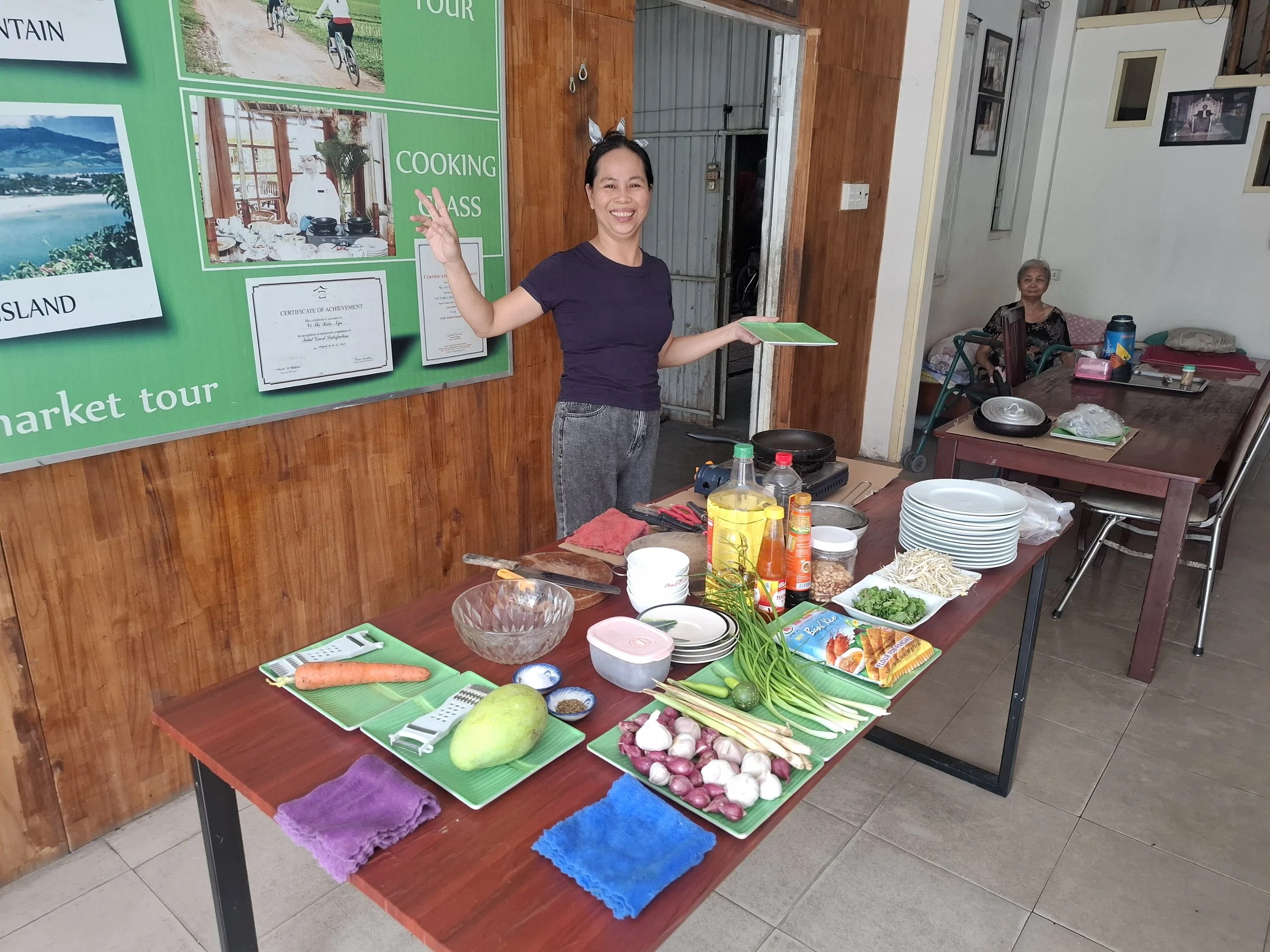
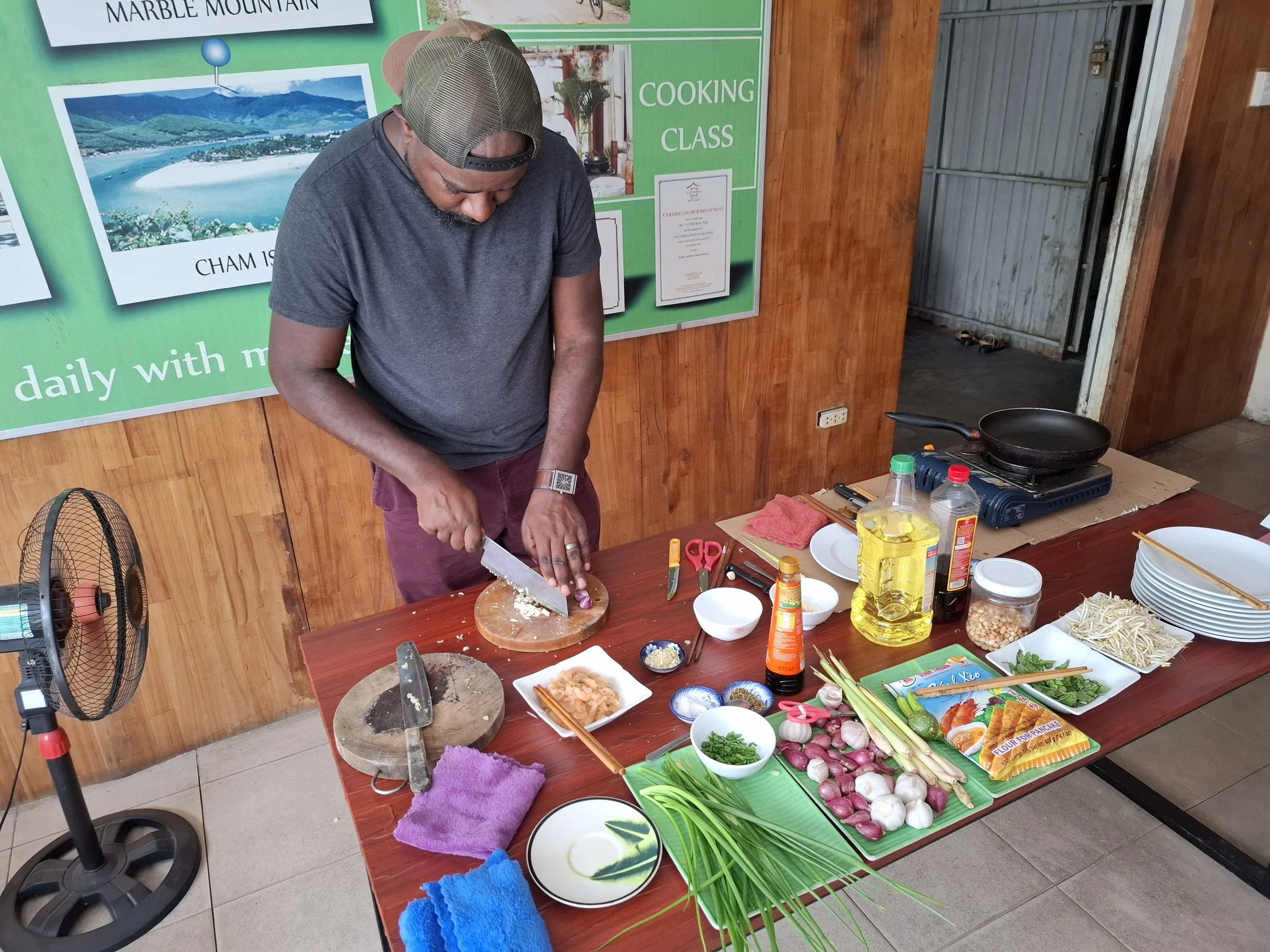
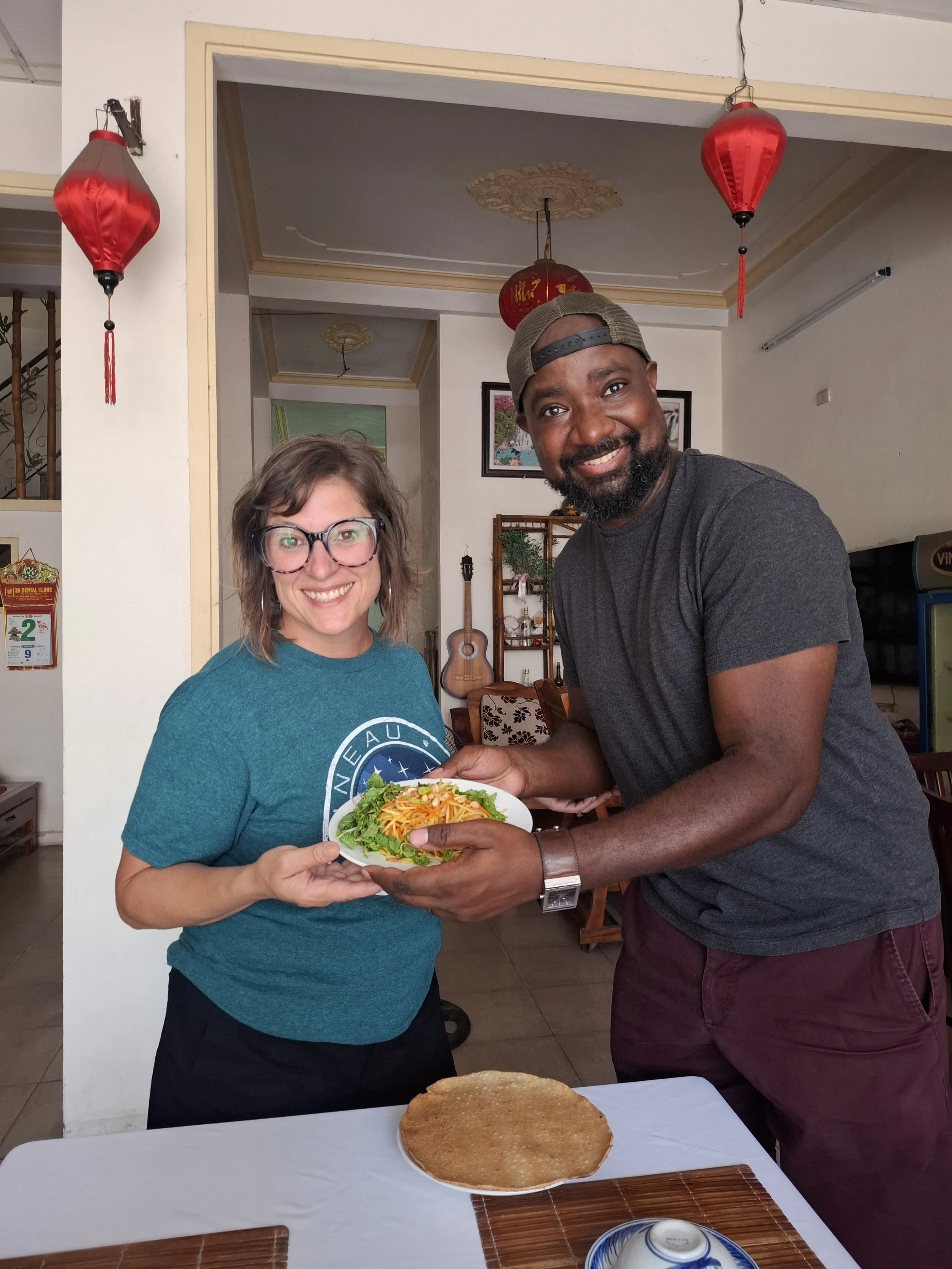
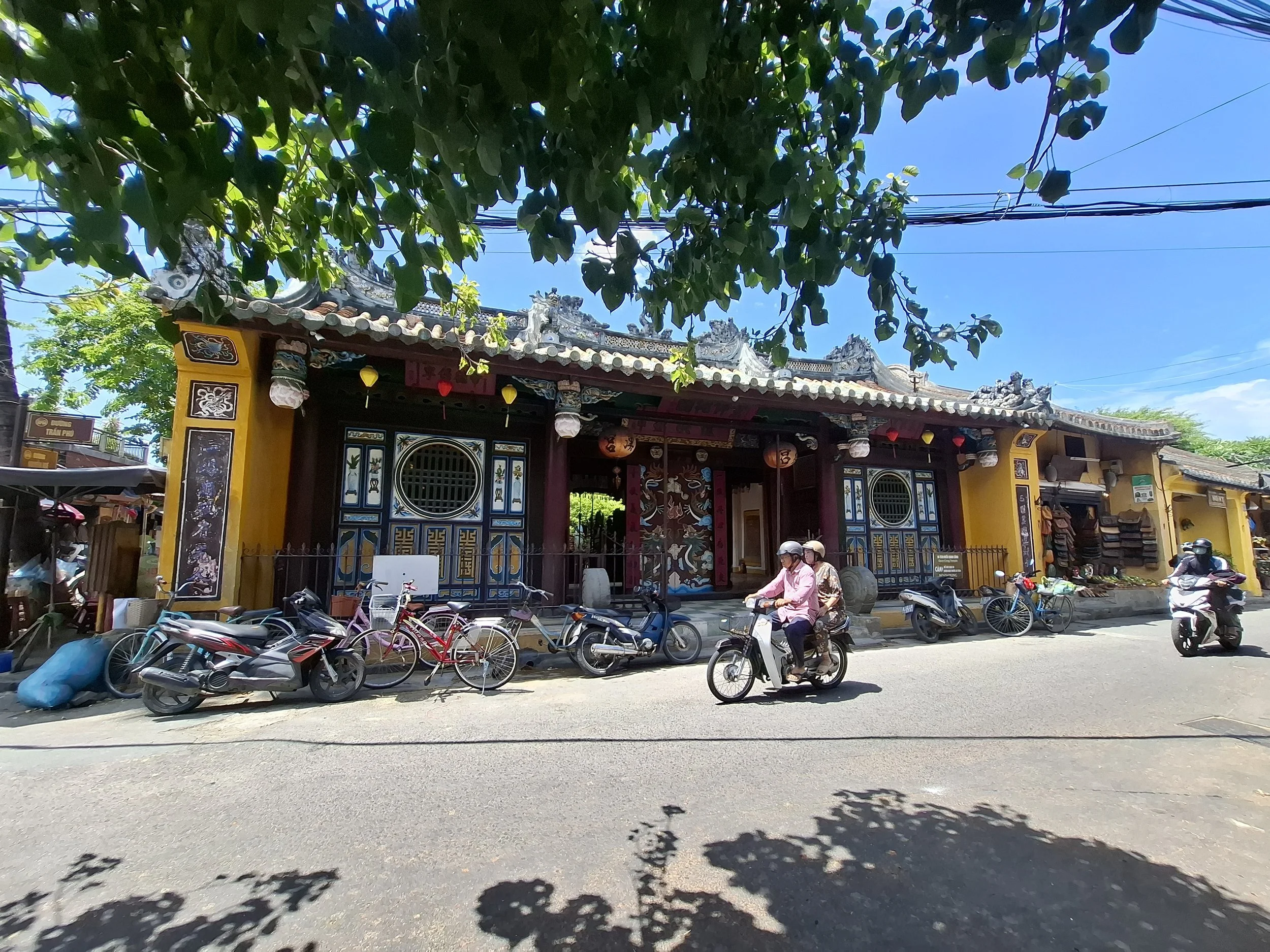
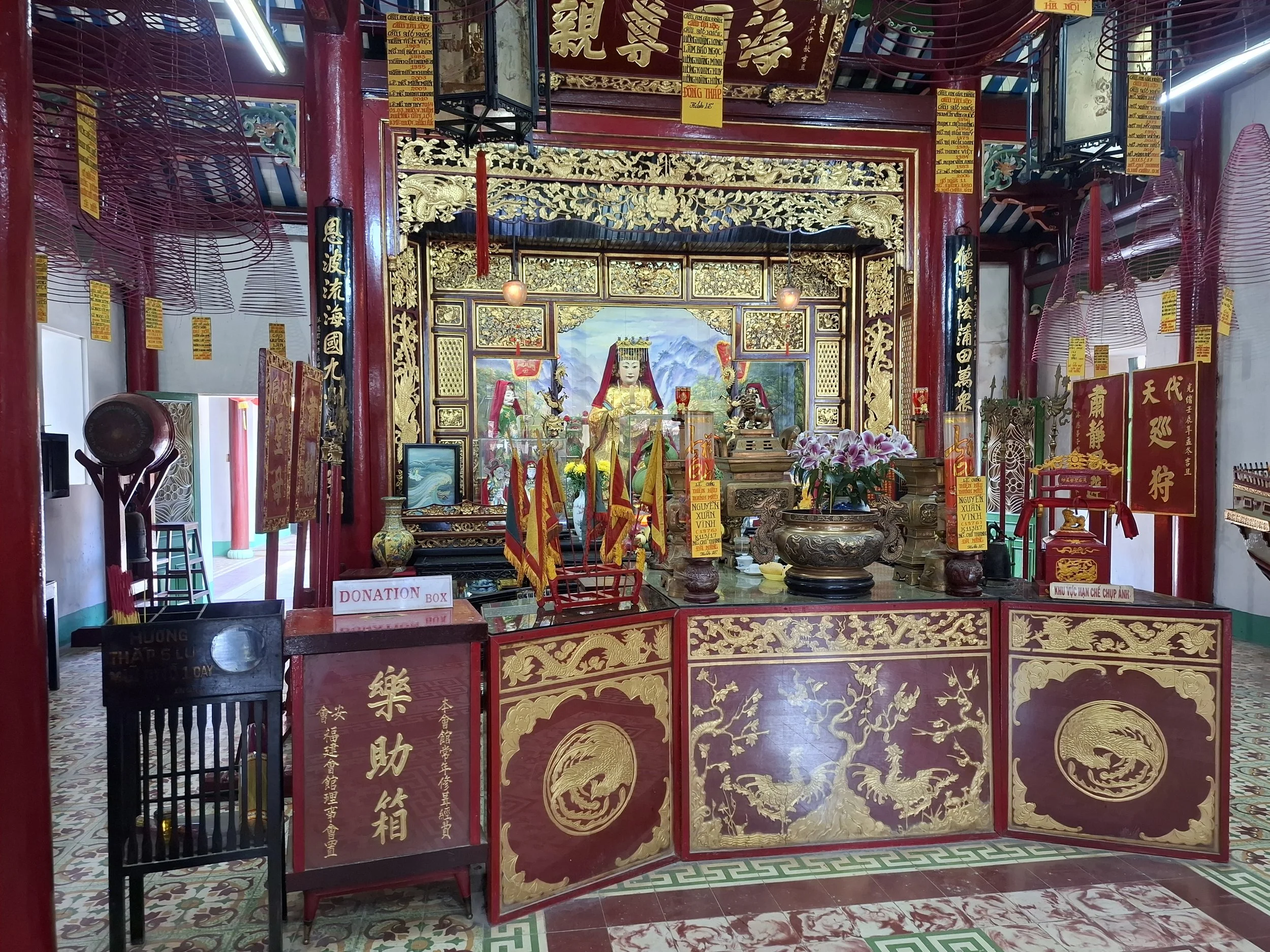
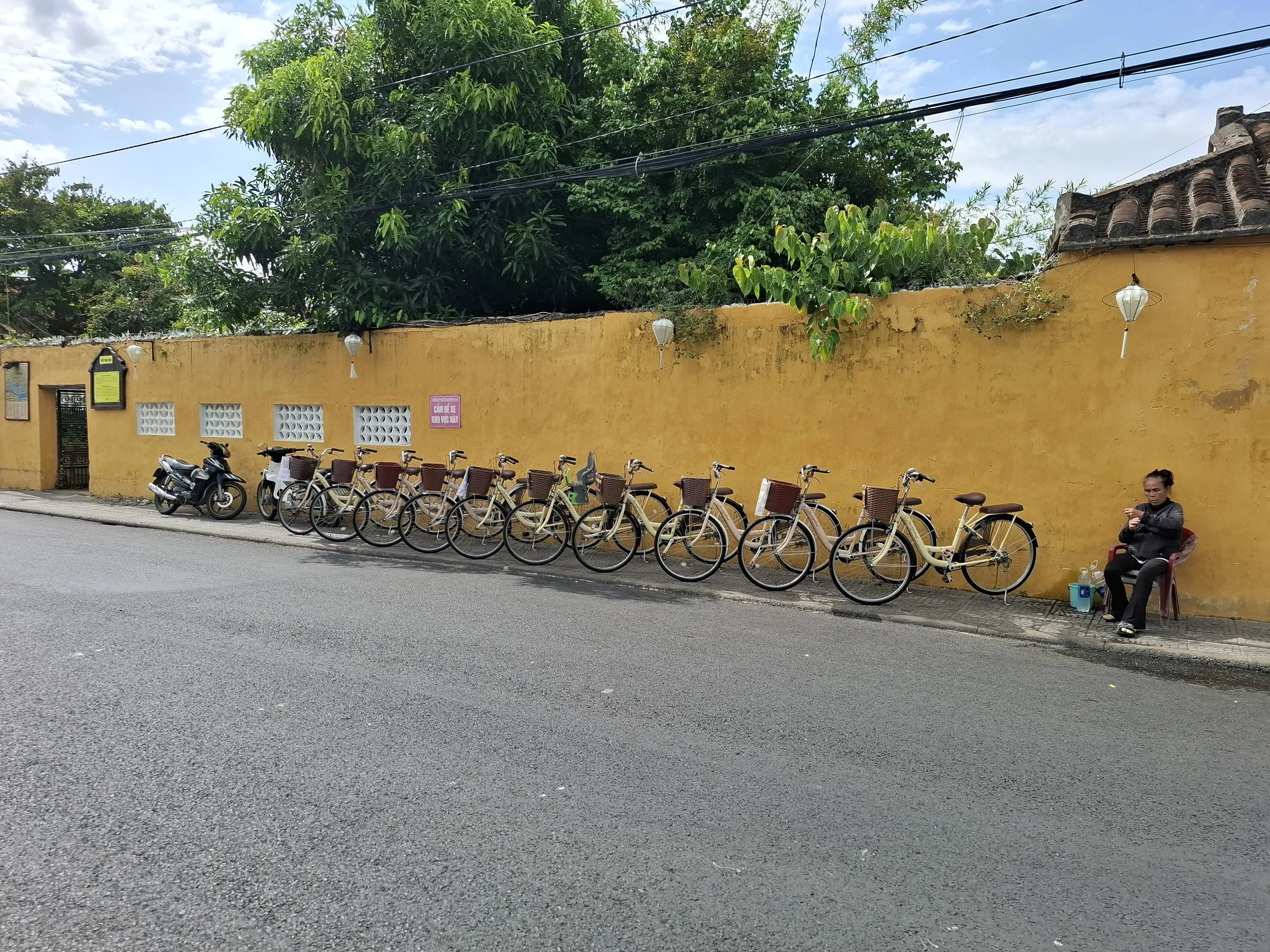
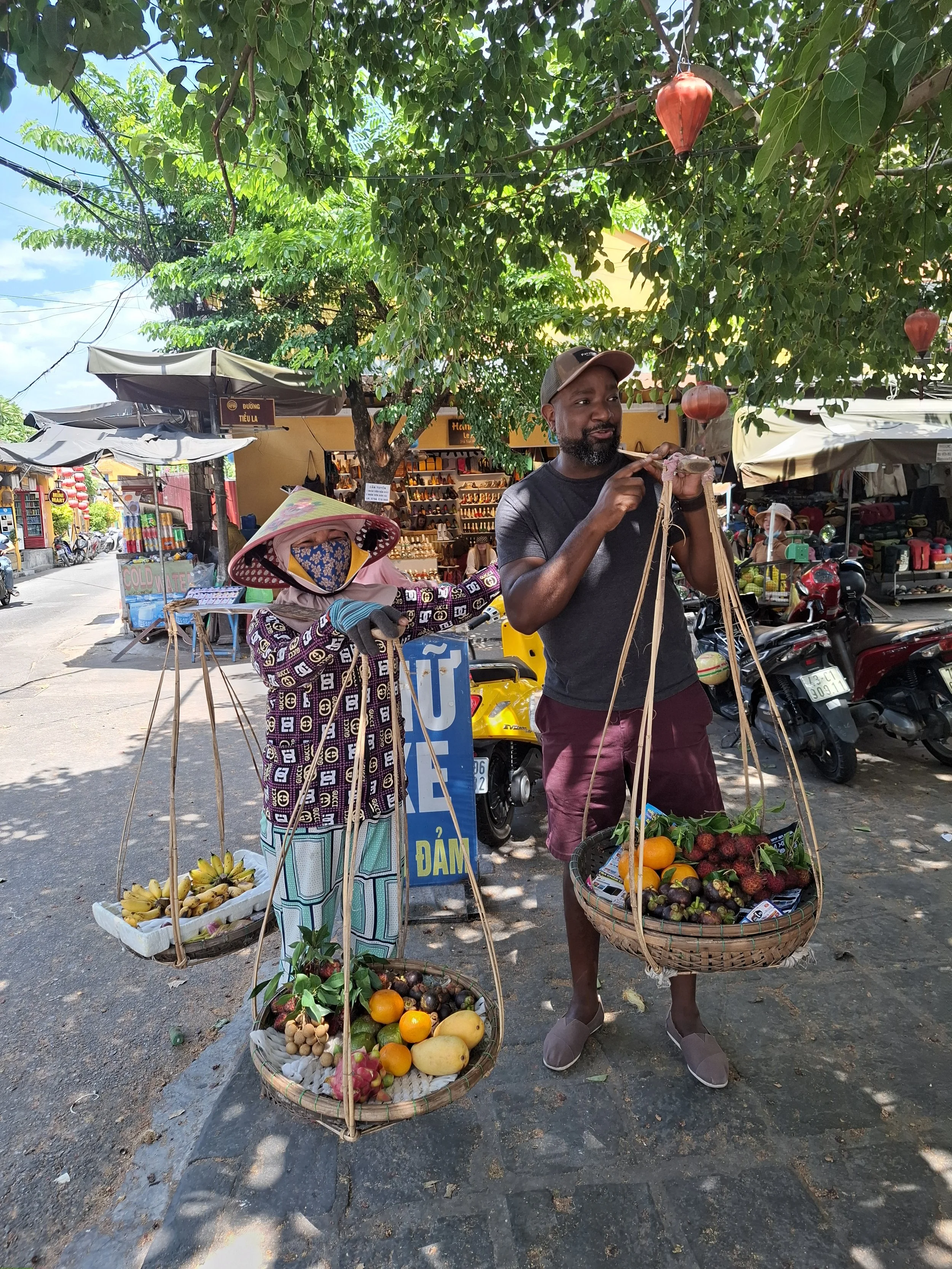
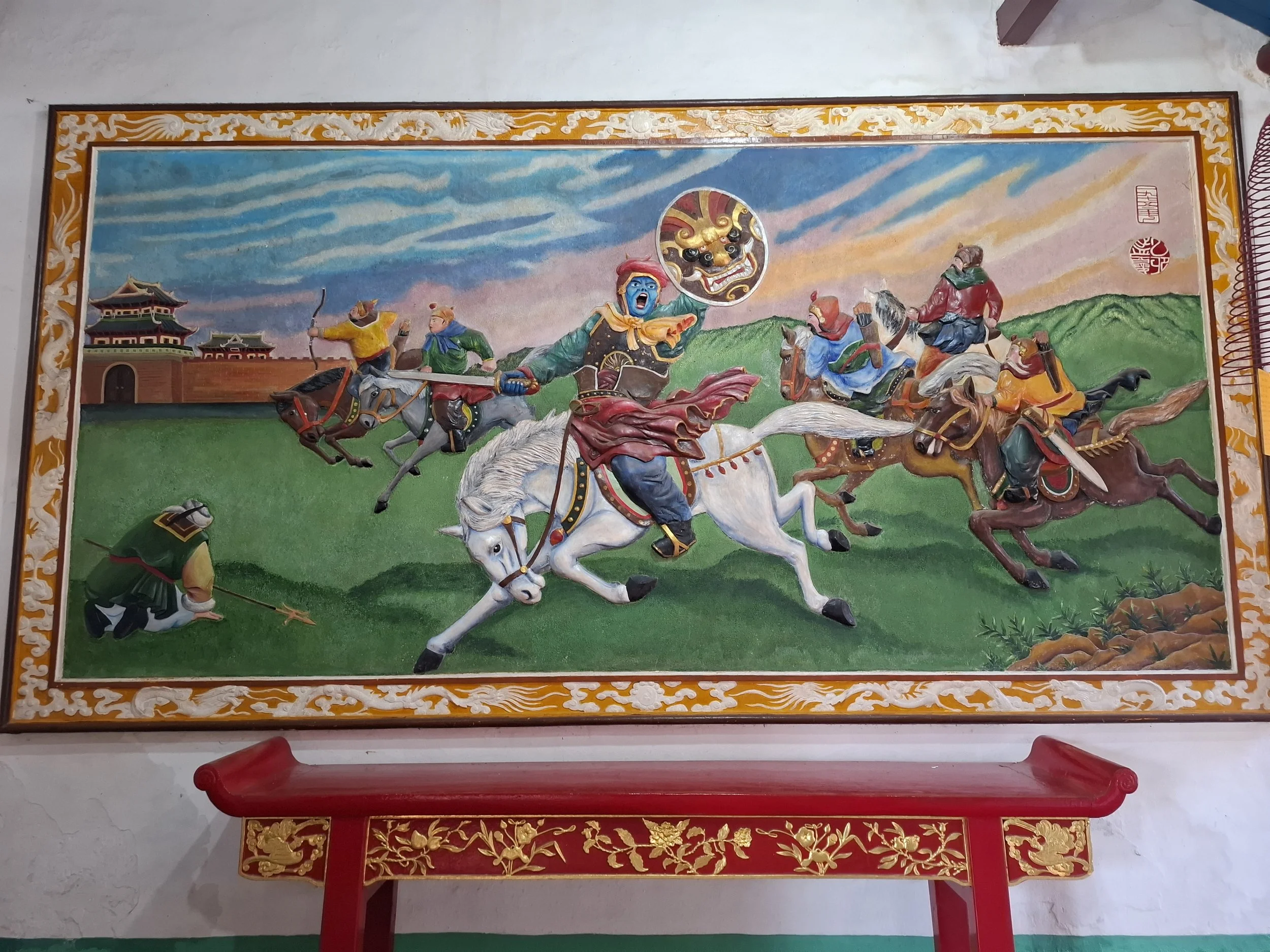
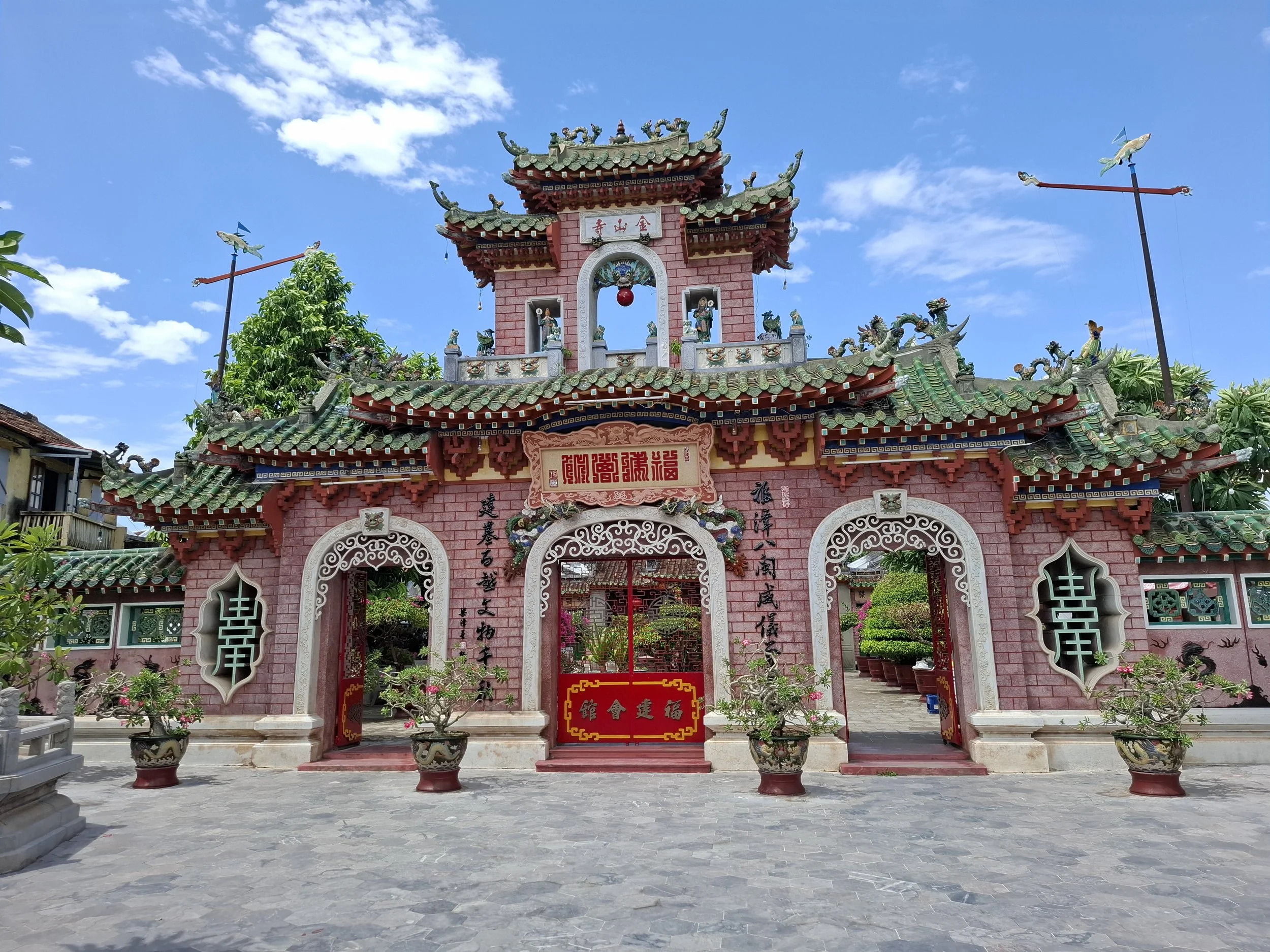
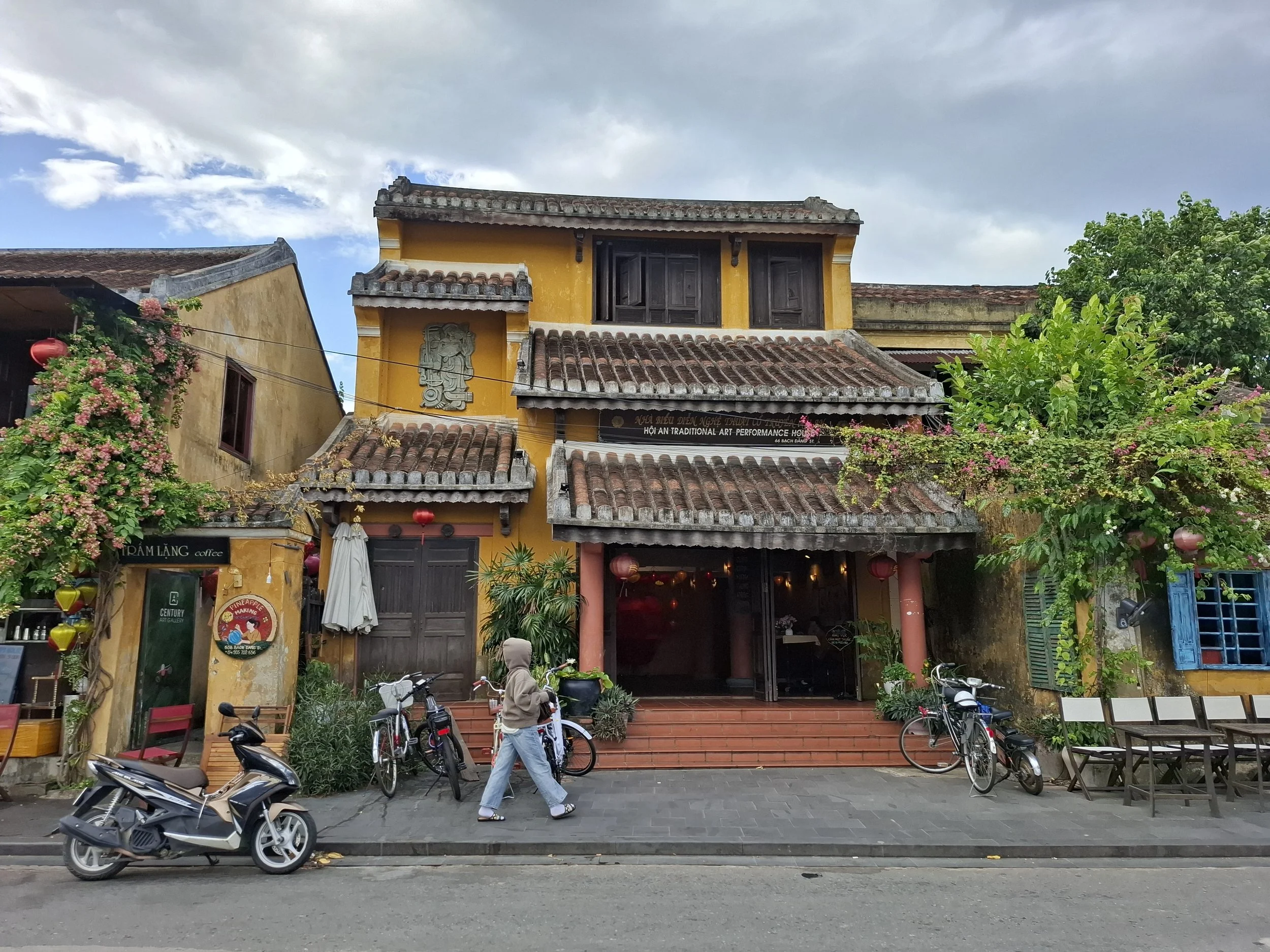
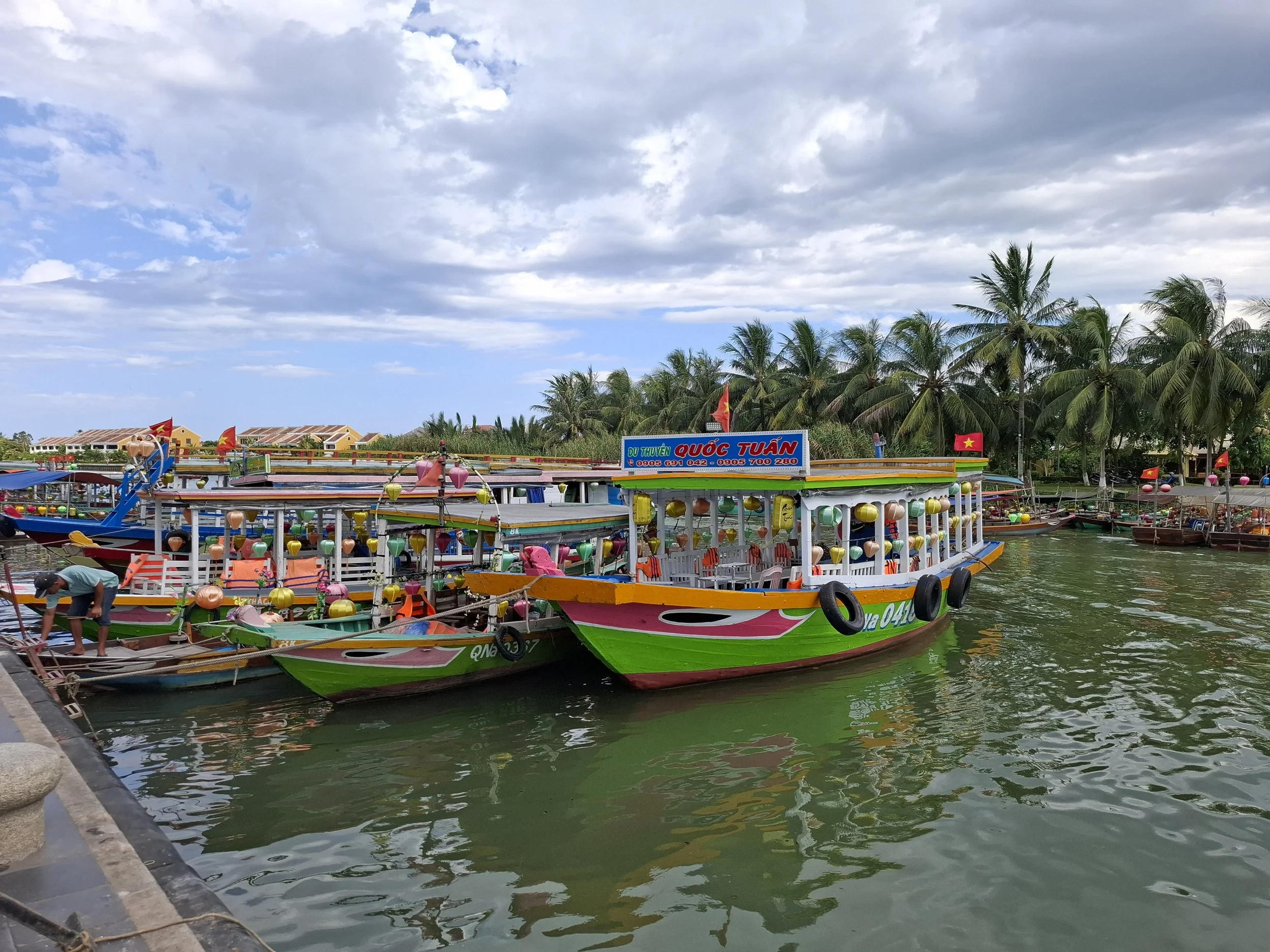

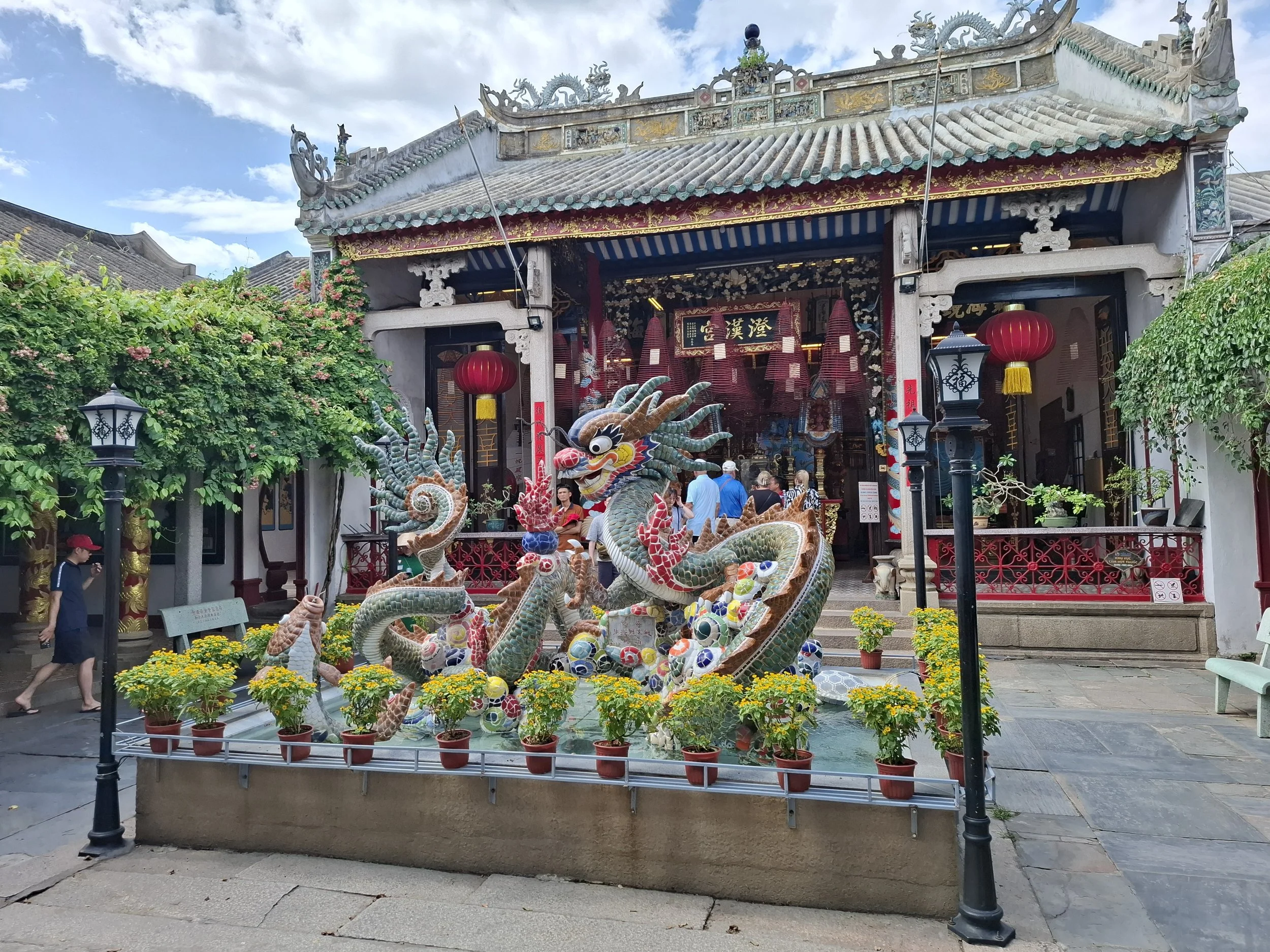

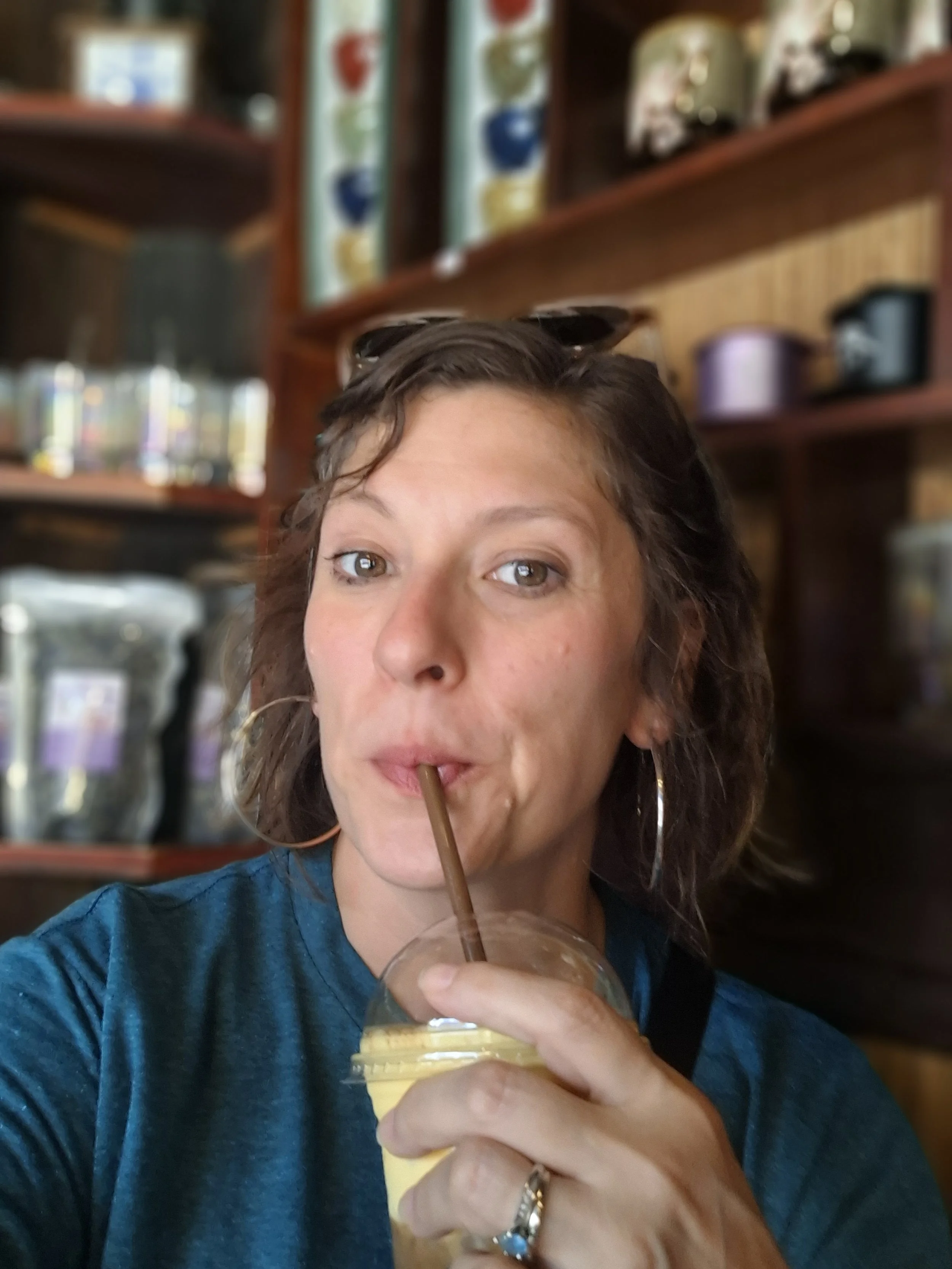

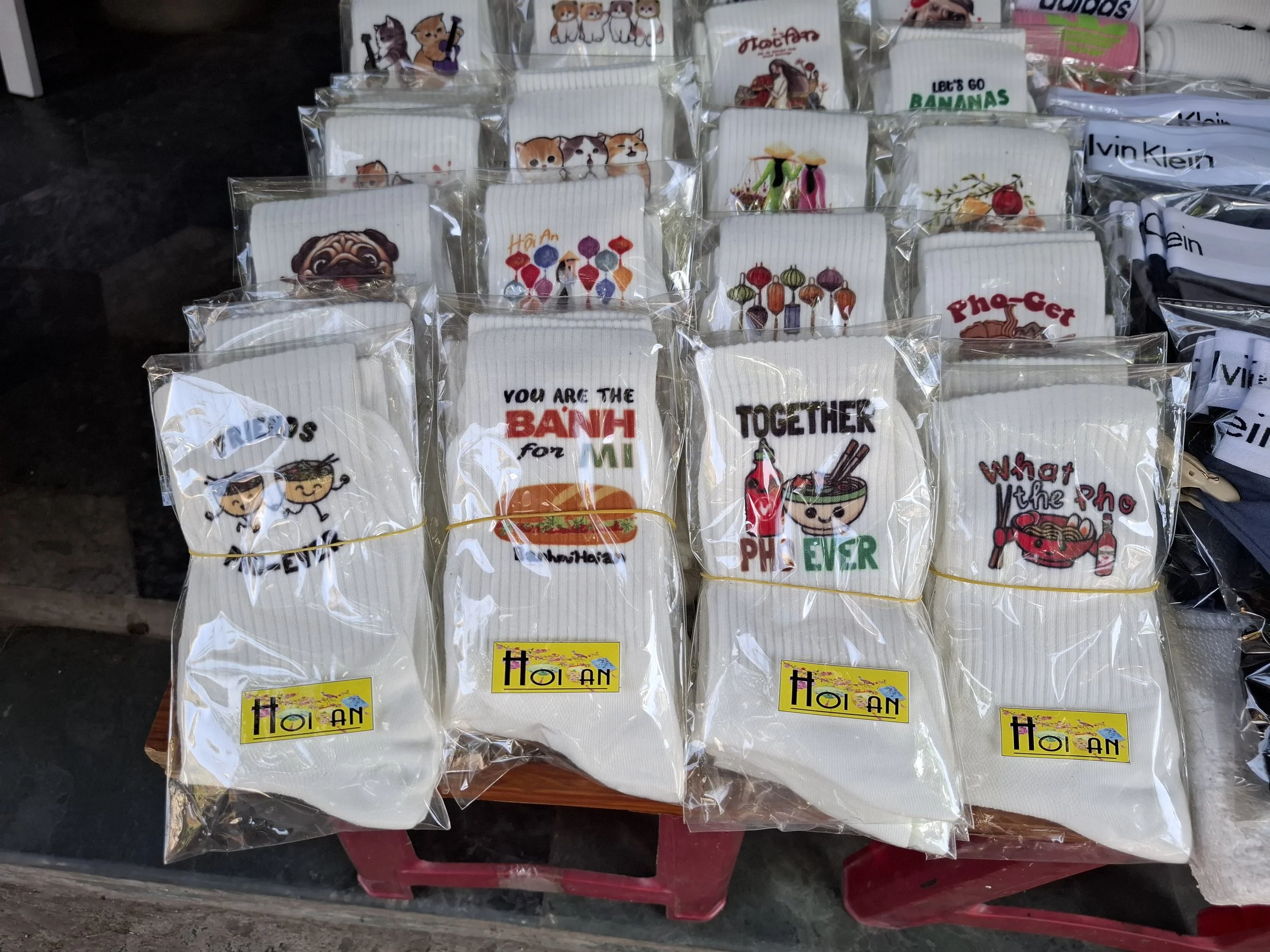
This was a dope trip.
Whenever we travel we run places through a couple of mental check lists. One around affordability, which Vietnam passes with aplomb. The other checklist is more “could you see yourself living here?” The country, especially Hoi An and Da Nang earn flying colors on that test as well. We’re glad we went and look forward to returning sooner than later.
Sớm gặp lại nhé (see you soon)!
Bourbon Trails and Louisville Tales
Each time we come to the US for summer we take what our friend Erik Hanberg calls an Inception trip. An “inception trip” borrows its name from the Christopher Nolan movie, it is a trip within your trip. This year’s inception trip was the Bourbon Trail.
Driving between Nashville and Louisville we caught ourselves admiring the scenery and rolling hills more than a few times. Neither of us have ever been to Kentucky and we were both shocked by how much we enjoyed it and especially its natural beauty. It's incredibly green, at least in the summer. I reckon a lot of those trees shed their leaves in the fall.
There are a few things that we enjoy more than a road trip, unless there's traffic, then they're hell.
We love a river city and the way cities contort themselves around the bends of the river. Neither of us had a particularly strong grasp on the geography of the Ohio River basin which slices through the heart of Louisville before this trip.
A Georgian, an Illinoisan, a Hoosier, a Nebraskan, and two Washingtonians walked into a bar… no, this isn’t the start of a bad joke, but actually the makeup of our crew on this trip. Touring bourbon country with a group of 9 people who are particularly fond of bourbon was hilarious. Nate enjoys it but doesn't consider himself an expert by any means. He was joined by Bill, who served as one of the main characters for the trip and as commentator during our people watching sessions. Everyone else was along for the vibes.
Bourbon is like Champagne, as in its origin is geographically specific. To be bourbon, a whiskey must be made in Kentucky from a grain mix that's at least 51% corn, distilled to no more than 160 proof, aged in oak barrels at no more than 125 proof, and bottled at 80 proof or higher. Critically, nothing can be added except water to adjust proof – no flavorings or colorings allowed.
Between formal reservations and drop in visits along Main Street, we tasted at five distilleries.
Evan Williams Bourbon Experience
Buzzards Roost Whiskey (tried their bourbon line)
Jim Beam (home for many beloved labels such as Old Grandad, Knob Creek)
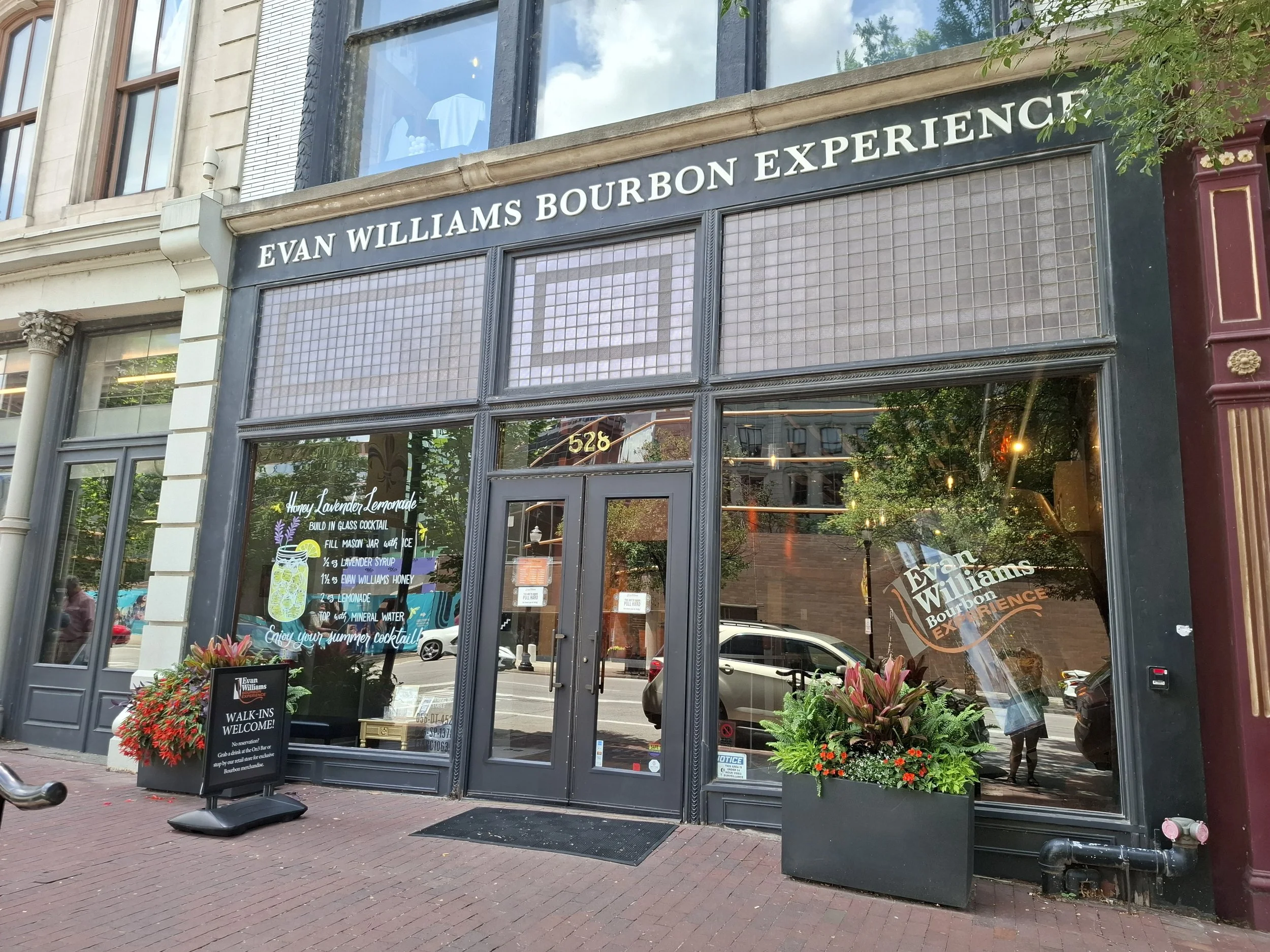


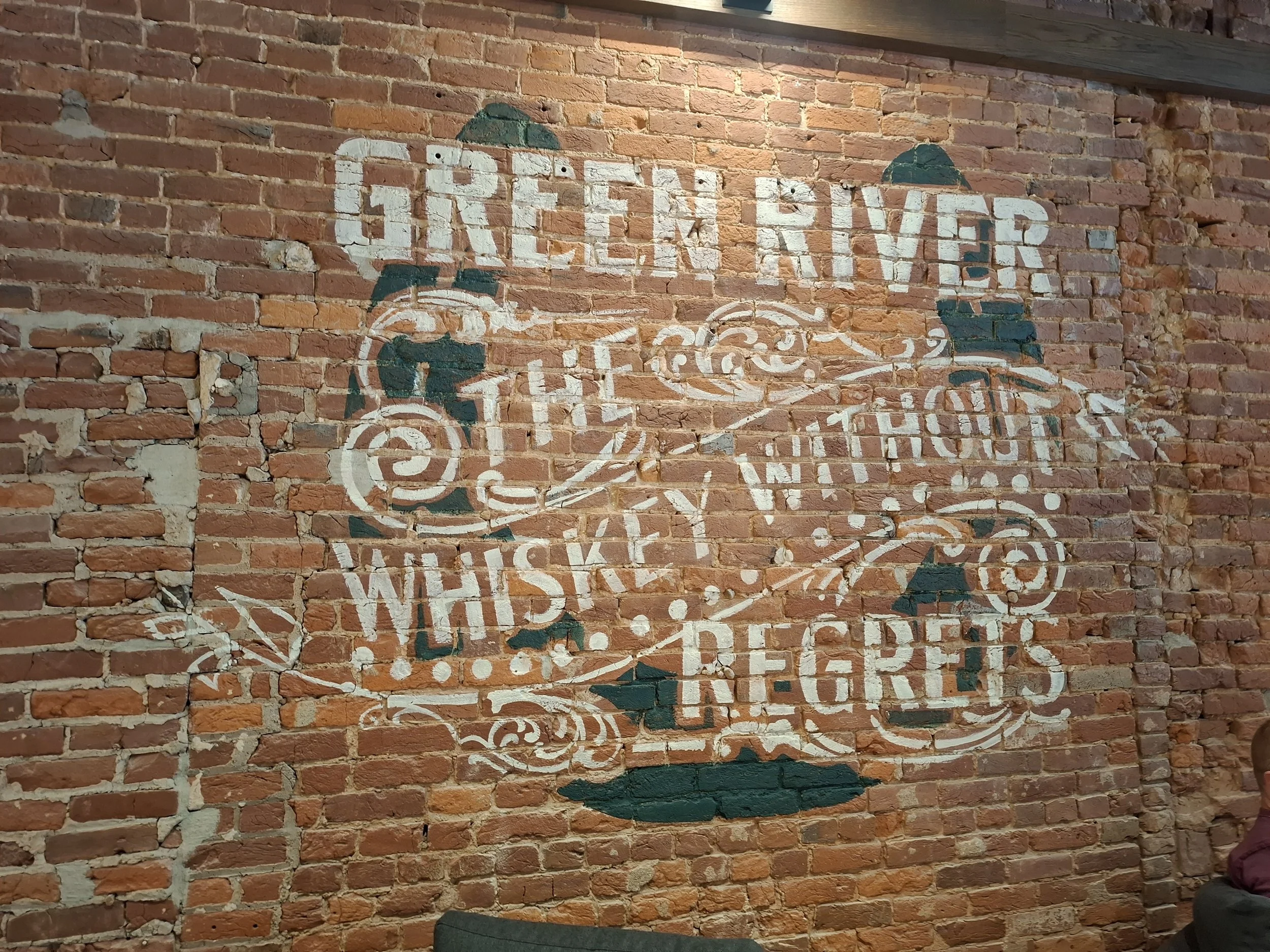
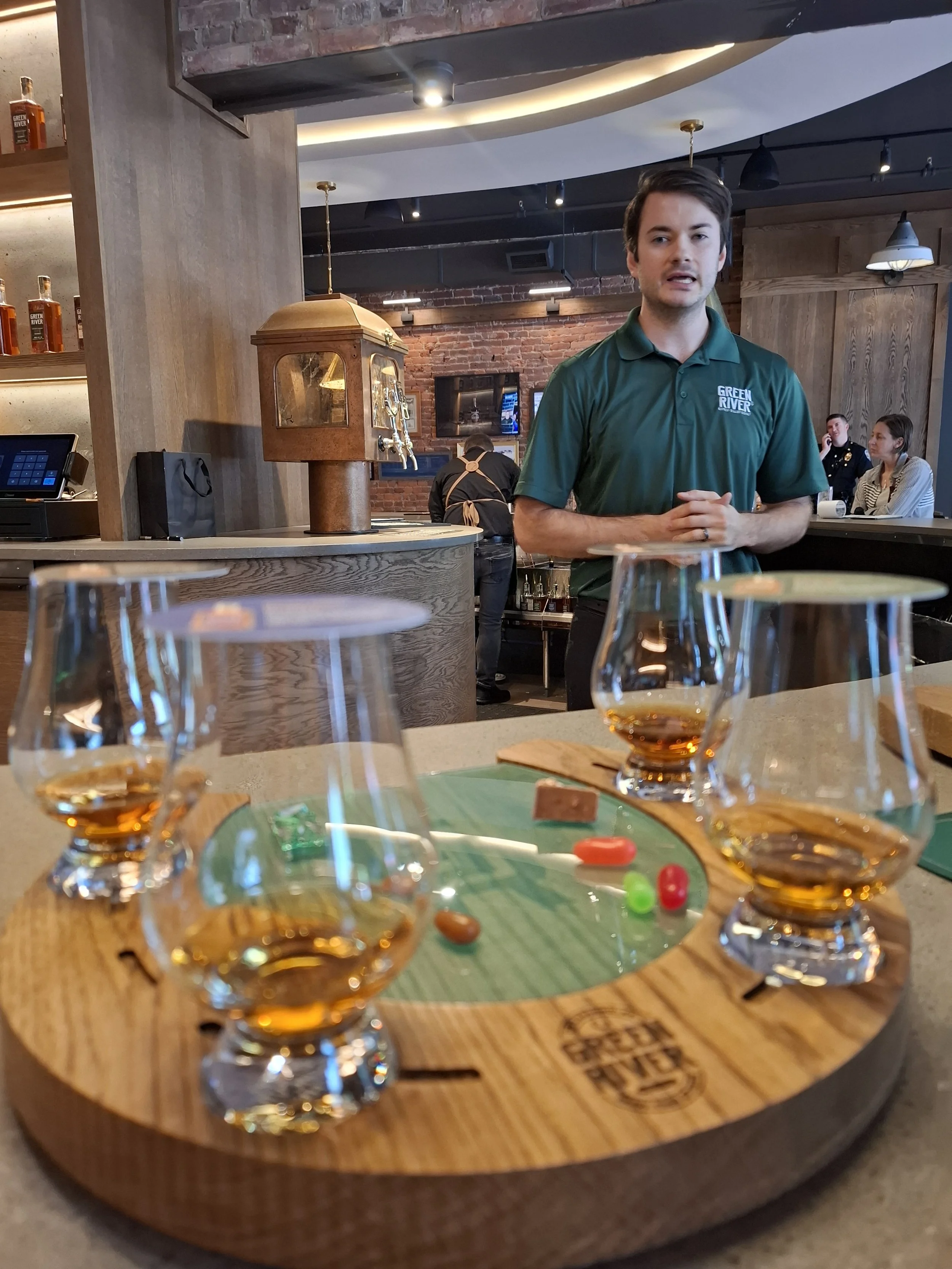






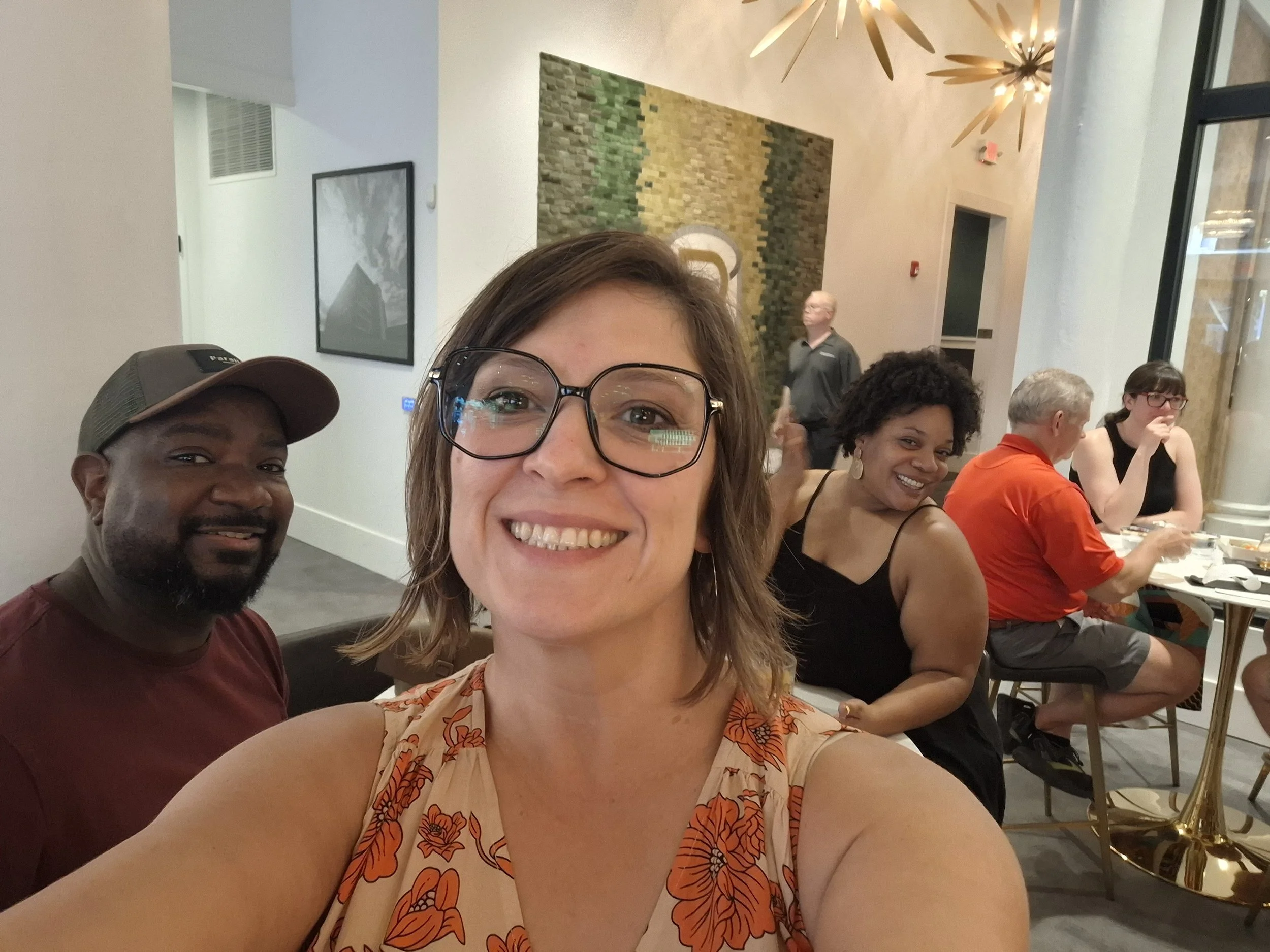
Although not in the bourbon family, we channeled our PNW spirit and popped by a family winery. It was giving Hoodsport vibes and serving excellent Kentucky cheeses. Little did we know that fish crackers pair well with fruit wine.
Hope had three very Southern experiences for the first time: Buc-ee’s, fireflies, and Waffle House. With all her worldly gallivanting, you’d think these would be familiar by now. But Hope treats even grocery shopping as a cultural event, a chance to learn something about the habits and traditions of a place. Buc-ee’s, in that sense, is an anthropologist’s dream. The branding is relentless, from Buc-ee’s mints to Buc-ee’s bikinis. Everything runs with remarkable efficiency. The bathrooms are spotless and fully staffed, and the registers keep people moving. Large sandwich boards throughout the store proudly display employee salaries and benefits, turning even HR into part of the experience.
Waffle House did not disappoint, especially when you can drop a $20 bill on breakfast for two, including tip. Waffle House feels like the Best of America. Everyone is there. Someone could pop off at any moment but the Aunties are regulating from behind the counter with the fierceness of a Vegas bouncer.
Besides bourbon and having the country’s best tap water, Louisville is known for being the birthplace of the Greatest, Muhammad Ali, and has museum honoring him.
The Muhammad Ali Center “presents and mobilizes Muhammad Ali's legacy of creating change, pursuing justice, and inspiring greatness.” Ali and his wife Lonnie designed and founded the museum in 2005, while they were still alive. The museum was filled with young men, likely drawn in by the sports but leaving with a deeper understanding of social and racial justice. The center traces Ali’s path as an athlete, but more importantly, it highlights his growth as a human being. We also got a timely reminder about his vociferous opposition to the Vietnam War. He stood for his principles, even at great personal cost – he let his values ground and guide him through everything. That is the kind of reminder we need in 2025.
Acknowledge Me
The horse’s name is “Acknowledge” which is is an inside joke because we often use the Roman Reigns phrase “acknowledge me” when one of us isn’t adequately recognizing the effort of the other.
Before heading onto I-65 back to Nashville, we made a final detour to Churchill Downs Racetrack, home of the Kentucky Derby. It wasn’t Derby Day but you could feel the energy of fans cheering on their favorite jockey and race horse. It was a fun way to spend the remainder of the day before hopping back onto the interstate. Nate has a weird formula for picking his horses that never seems to work; Hope always picks one with a hilarious name.
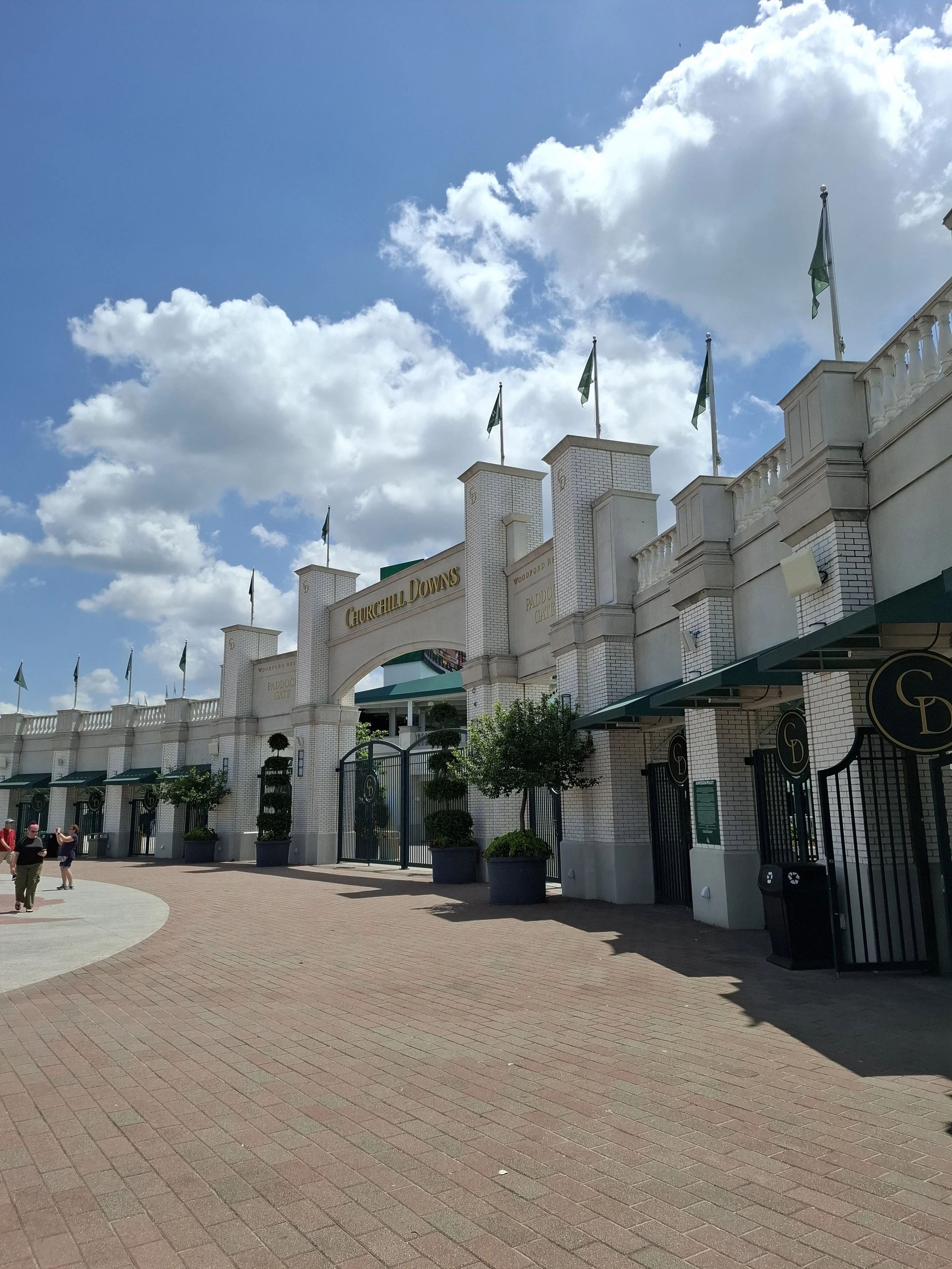

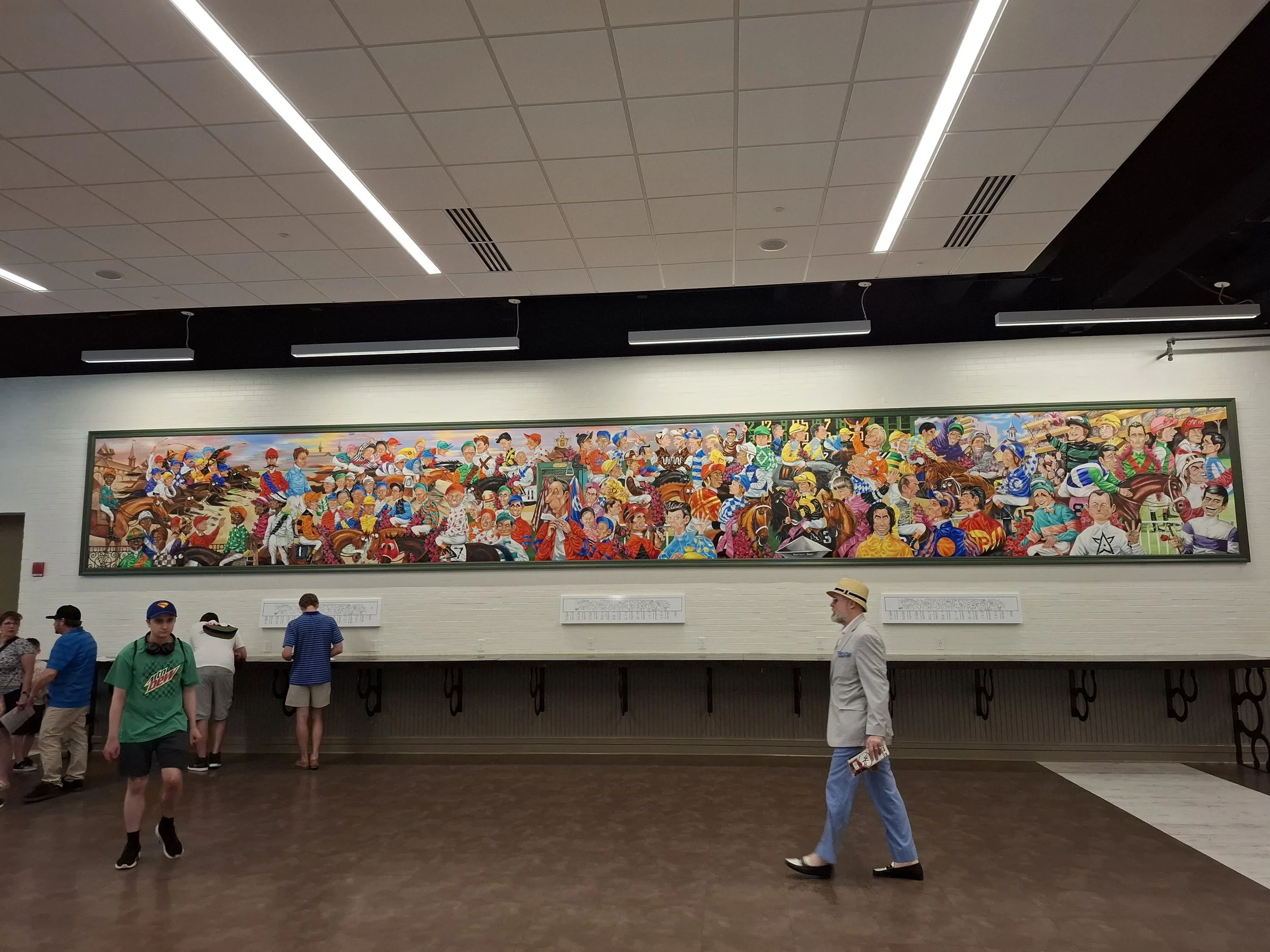

We then returned to Nashville for dinner with some friends from Nate’s teacher of the year cohort and night’s rest at Ye Ole Airport Marriott before returning to the fam bam in Washington.
Highest of keys, Kentucky was dope, y’all — we’d happily go back and visit again.
That’s honestly a sentence neither of us thought we’d ever say.
Kuwait in a Weekend
For many, Kuwait brings up a particular image—for people of our vintage—it's likely pictures and video from the 1990 Iraqi invasion of the country and subsequent US led Gulf War.
But places are more than their darkest hours, and Kuwait is more than the grainy night-vision footage of missiles streaking across the sky—narrated by Christiane Amanpour—that we watched on CNN back in middle school.
When we moved to the Gulf, Kuwait was not on our radar for a visit but as soon as we arrived in the region, we met countless fellow Americans who raved about their amazing time teaching in the Kingdom. Those stories and the enthusiasm with which they were conveyed convinced us (Hope more than Nate), to hop on the just under 2hr flight.
The proximity is perfect for a normal weekend and that’s what we did.
As per usual when we travel, we ate our way through the weekend. Possibly due to its status as a dry state, the food scene in Kuwait is off the charts. Matbakhi by Sawsan came recommended and did not disappoint. The quality of the ingredients melded with the richness of the flavors. It doesn’t matter if you’ve tried kebab or mashi (stuffed marrow) before, you have not eaten it like this. Is this a whole chicken on pizza? No, friends, this is musakhan, a traditional Palestinian dish that somehow we’d missed in our six years of living in the UAE.
We tried to visit the Kuwait National Museum but it was closed for renovations.
Taking that as a sign from God, we decided to head towards some shopping.
First, we headed to the Souq Al-Mubarakiya where we wandered the stalls, admiring intricate thobes and abayas, and colorful arrays of olives and fresh fruit.










We stopped for coffee, tea, and the best date cake you could imagine.
Then, we experienced The Avenues, a 1.2 kilometer shopping center, the second largest in the region (apparently Iran Mall in Tehran is the size of the Starship Enterprise).
Nate in shock
For Tacomans, you probably think of the Tacoma Mall or maybe our Califonian readers are thinking about The Block (aka The Orange Outlets), in Orange County and Mall of America is ranked 10 places below the Avenues.
Art Installation, The Avenues, Kuwait
The mall is large enough that—for reasons we still don't understand—it has three H&M stores and a Hilton Garden Inn.
What’s perhaps different than in the West, is how folks use the shopping mall. It’s a place to be seen. Everyone is out in their finery. Couples are strutting their cute outfits. Kids are dragged along, strollers abound, and there was more flawless makeup and expensive footwear than we’ve ever seen.
View from the escalator
We on the other hand wore our customary shabby American wear. Nate especially in his customary unlogo’d t-shirt and comfortable Gap pants.
Since we hadn’t reached out vacation level 20k step count for the day, we strolled along the corniche (boardwalk) towards Kuwait Towers taking in the soft light of sunset and enjoying the sounds of laughter from all the families picnicking on the beach.
We didn't do anything extraordinary but yet found the time deeply enjoyable.
What made the trip truly worth it, was traveling with one of our dear friends who lived there for nearly a decade. Seeing the country through his eyes and stories, made it special.
It is unlikely that we will return to Kuwait. We kinda feel like we saw the whole joint but we remain grateful for the opportunity to have visited.
On to the next.
What You Remember About Ancient Egypt is 80% Incorrect
A Bowling family guide to Cairo and Luxor
Egypt has always been on our list but we consistently found reasons or excuses not to go.
Cairo is crowded. It’s too hot. We need to get better at Arabic. Did you see that video of the tourists getting harassed in Giza? All of these are ridiculous and after visiting I’m frankly mad at us for not making the trip much sooner.
Egypt is an absolute gem of a country and Cairo is a tidy three hour and fifteen minute flight from here in Abu Dhabi, the equivalent of a flight from Seattle to Omaha. In December, at the start of our school’s winter break we took off for five nights in Egypt, starting and ending our adventure in Cairo, with a trip down to Luxor and all its history in between.
Because we’ve seen people have some difficulty we used a guide, Ramy. But Ramy is more than a guide—he coordinated our stay, booking our lodging, ground transport, and flights between Cairo and Luxor. He also hired an Egyptologist to guide us through the valley of the Kings, Karnak, and the Luxor Temple. He allowed us to navigate and access places we never would have if we were traveling alone. Thanks to his expertise this trip was nearly perfect and we had an authentic cultural experience that we could never have arranged ourselves.
Day 1: Arrival in Cairo
The view of the city skyline from the citadel through a wrought iron gate in Cairo
As you approach Cairo from the air, all you can see is city. Once you’re over it, you see the brown sand blasted and sun drenched metropolis sprawling in every direction. Dense, beige, and loud. Considered a “city of a thousand minarets”, Cairo-Giza metroplex is home to 22 million people. It feels like every single one of them has a horn, every single one is always on the road at the same time, and every single one loves to honk. In real estate they talk about “curb appeal,” how good a place looks when you roll up to it. Cairo has zero curb appeal, but its charm lies once you enter the city.
We met our Cairo Guide, Mohamed Zayan, outside of customs and zipped off to our first stop, the Muhammad Ali Mosque. Construction began on the mosque in 1832 and took over twenty years. It sits on a hill in an area called Citadel of Salah al-Din al-Ayyubi.
It was from that Citadel that we got our first glimpse of the Pyramids seemingly hovering about the edge of the city. The Citadel is opposite the pyramids, the entire city resting in between and the Nile off in the distance, roughly equidistant from the two points.
When Ramy was arranging our trip, he asked us what kind of travelers we were. We said we keep things simple and aren’t especially bougie. So he arranged a furnished short term rental near Tahrir Square, walking distance to mouth watering shawarma, bustling cafes, and plenty of shops to wander.
We caught the sunset aboard a sailboat, manned by the oldest, happiest sailor/fisherman. With at least three generations of sailing in his family, our captain navigated down the Nile, pausing so we could take in the river air and enjoy the red, yellow, and orange hues at twilight.
Day 2: Cairo’s Rich History
The next morning we woke up with the adhan from the nearby mosque. Zayan’s driver, also named Mohamed, picked us up and whisked us through morning traffic out towards Giza. Although we got a sneak peak of the Pyramids from the Citadel in the late afternoon of our first day, nothing prepared us for that early morning viewing. Mohamed, nonchalantly rounded the corner. To the left a boring gas station and to the right, THE ANCIENT PYRAMIDS OF GIZA. OMG. OMG. OH MY GAAAAAWWDDDDD.
“That’s pretty typical,” Mohamed laughed.
That morning we got breakfast at the Marriott Mena House, with a view of the pyramids hovering over the pool. Nothing quite like biting into a cinnamon roll while staring at one of the Seven Wonders of the Ancient World. After a short security check, we were transported to the base of the largest pyramid, and given the opportunity to climb into a tomb. Like idiots, we precariously made our way down a rickety ladder 60 meters into the ground. As you can imagine, our “claustrophobia” and “is this worth it?” muscles were activated. Our time underground was short, as a school group of ten year old girls started pouring into the tomb and we immediately needed to leave.
From here, we got talked into climbing aboard some camels to circumambulate the pyramid complex–which actually consists of nine pyramids. In the Gulf, Hope has experienced about four minutes on a camel and Nate has always said “ain’t no way.” After some mockery and cajoling, we got on the damn camels for our forty-five minute journey. We clung to the saddles in terror as we imagined falling to our death on the rocks below the path (the average camel is over 6ft tall). Zayan tried to distract us with his Egyptian Reddit theories surrounding the pyramids.







The afternoon wrapped up with time at the Great Sphinx. We then retired to Zayan’s family hotel with a balcony view of the complex for lamb chops and libations with a view of the entire pyramid complex.
View from lunch
We said goodbye to Zayan and reconnected with Ramy, at the National Museum of Egyptian Civilization (which btw, has a sneakily delicious vegan cafe on its premises). The museum is sprawling and is still in the midst of a soft opening. They are consolidating the national collection (the parts the Brits didn’t steal at least) at the museum. Upon our exit we realized we’d actually only explorer about half of the mammoth building, with more galleries to open in the future.
Day 3: Journey to Luxor
Egypt is a land of hustle and bustle with an emphasis on both words, so having an Arabic speaking, six foot five inch tall, Egyptian guide was priceless and absolutely worth doing. One of the many times we appreciated working with Ramy was our travel day to Luxor. Ramy booked our flights, helped us navigate the Cairo airport, all the while laughing, smiling and bantering with airport officials, other guides, and anyone else we met along the way. When we landed in Luxor we were taken straight to a joint for breakfast that had the best falafel we’ve ever had.
As soon as we reached Luxor, we met the Egyptologist, Nermeen, Ramy arranged for us, who whisked us into Hatshepsut’s Mortuary Temple. Depending on your age, you might know Hatshepsut—an extraordinary queen who ruled for two decades and often wore a male Pharaoh’s headdress for authority. Her son, a great ruler in his own right but bitter toward her, chiseled her face off most statues after her death. Apparently, today’s middle schoolers learn about her, but back when we studied Ancient Civilizations, she was left out.
We then headed to the Valley of the Kings. The tombs for Egyptian Pharaohs are dug into the sides of mountains. Literally nothing we can write here can capture what it felt like to visit the Valley of the Kings. Workers started digging tombs for kings the day each Pharaoh took power and they continued throughout their reigns. The longer they ruled the deeper and more opulent their tomb. Some went over 100 meters deep into the mountainside. Nate’s a bit claustrophobic and didn’t necessarily love all that. But the murals and carvings inside the tombs were truly breathtaking.
The interior of King Tutankhamen’s tomb in the Valley of the Kings
We closed the evening with al fresco fireside dining at a vegetarian restaurant, the Wanas Art Cafe, near the Nile.
Day 4: Karnak and Temple of Luxor
Hot air balloons preparing for lift-off, pre-dawn in Luxor
The next morning, we were up well before dawn, jolted awake by a 3:30 a.m. alarm for our sunrise hot air balloon ride. When we arrived at the launch site, we were met with the sight of a fleet of balloons in various stages of preparation, their crews working methodically in the dim pre-dawn light. Dozens of massive balloons dotted the field, each capable of carrying up to twenty passengers and supported by a team of at least ten, including the ground crew.
As the sun rose, the scene felt cinematic—like the moments before a battle—then flames roared to life as the giant balloons slowly lifted off, one by one.
As our balloon took off we were greeted with a view of the Nile, then Hatshepsut’s Mortuary Temple, and finally Karnak and Luxor Temples, where we’d venture in the afternoon.
After breakfast (more falafel, yes!) and a brief rest, we crossed the Nile to explore the Karnak Temple Complex, one of the largest religious sites of the ancient world, where we wandered through the towering columns of the Great Hypostyle Hall dedicated to Amen Ra. Next, we visited Luxor Temple, admiring its colossal statues, intricate carvings, and the iconic Avenue of Sphinxes. We even learned and saw where the obelisk in Paris came from.





We ended the night with a boat trip back across the Nile. We even found a waterfront restaurant showing a Real Madrid match and retired for the evening before our flight back to Cairo.
Day 5: Farewell to Egypt
We returned to Cairo, via Nile Air, and that evening went cologne and souvenir shopping at the Khan el-Khalili Bazaar. It’s a sprawling traditional market that seemingly goes on for miles. Hoping to avoid the Cairo commute, we checked into a hotel near the airport in preparation for our flight back to the US.
Shouts to the lounge singer in the Novotel Lounge.
Takeaways
We’re fools for living this close and not going sooner.
Our trip to Egypt was everything we had hoped for and more. From the dizzying expanse of Cairo to the quiet grandeur of the tombs in Luxor, every moment felt like stepping through layers of history. The sheer scale of what we saw was staggering.
And yet, beyond the monuments and the museums, what made the trip truly special were the people—our guides, the vendors in Khan el-Khalili, the boat captains, the balloon crew, and the countless Egyptians who greeted us with warmth and hospitality. Thanks to Ramy’s planning, we were able to experience Egypt without the stress of logistics, allowing us to focus on the adventure itself.
Looking back, all the hesitations that kept us from visiting sooner seem absurd. Egypt is not just a place to check off a bucket list—it’s a country that gets under your skin, lingers in your thoughts, and demands a return visit.
Our next album cover
Football Dreams to Last the Years
Originally shared in “Takes and Typos” Feb 17, 2025
The nation’s most prominent anti-vaccine advocate was confirmed this week as Secretary of Health and Human Services, placing nearly all federal healthcare programs under his supervision.
Meanwhile, the Senate advanced Kash Patel’s nomination for FBI Director, setting the stage for his likely confirmation as the most overtly political head of the bureau since J. Edgar Hoover.
If you know your 20th-century history, you might recall that after Hoover’s tenure, a series of reforms reined in the FBI’s excesses. Now, Kash Patel—a regular on QAnon podcasts—enters the role with a declared list of domestic enemies he intends to punish using federal law enforcement.
But those aren’t today’s topic.
If you know me, you know I love the beautiful game. I played as a kid—badly, I’ll admit. Like most American sports fans, I grew up following and playing multiple sports. Baseball was my first love (and I was a decent third baseman). But years of Mariner futility and the outright theft of my beloved Sonics by oligarch Clay Bennett pushed me deeper into soccer in the early 2000s.
I love going to matches.
I love playing pickup games—though, again, I’m not very good.
I love watching matches on TV.
Hell, I even love stopping to watch locals play when I’m traveling.
Thankfully, my wife humors me. She doesn’t mind when I sneak glimpses of a match on TV during dinner, and she’s even developed a bit of a soccer obsession herself.
In December, on our way back from the US, we flew into Manchester and used it as our home base for some football adventuring.
One of the teams I follow is Sheffield Wednesday. I became interested in The Owls after reading The Ball Is Round, a roughly 1,000-page history of football and one of the best books I’ve ever read on the sport.
Buying tickets for English matches isn’t as simple as hopping on Ticketmaster. To curb hooliganism, most clubs require you to have a “Supporter ID”, and many also require a club membership. For some teams—especially in the Premier League—if you’re not a season ticket holder, your chances of getting a ticket are basically zero.
Knowing this, I did some legwork in the fall to get both a supporter number and a team membership, the two things I needed to buy tickets. So in December, we took a train down to Sheffield to watch Wednesday face their local rivals, Derby County—a fixture that has been played since at least 1890.
Although Wednesday is one of England’s most storied clubs, they were only recently promoted back to the Championship, the second tier of English football. That day, The Owls thumped Derby. We had perfect midfield seats, and I found myself next to a proper geezer (meant with the utmost reverence) who had been attending matches for 60 years.
Before heading to Sheffield, we took a train to Liverpool for a tour of Anfield, the hallowed home of Liverpool Football Club. We’d previously been there for a match in 2023 (a nervy home win over Nottingham Forest) but this time, we got the full behind-the-scenes experience: the locker rooms, the press box, the pitch itself.
I’ve been to the White House, the Great Wall, and the Vatican. None of them made me feel the things Anfield did.
After posting pictures from our December stadium tour, a friend reached out with an idea. A friend… or a friend of a friend… or maybe a friend of a friend of a friend—someone—had Liverpool season tickets and might be able to help us get into a match. Apparently, the friend got on the waiting list while he was in college and had to wait over 20 years before becoming a season ticket holder.
Long story short, the connection came through. With Hope's blessing, I flew back to Manchester just before midnight last Wednesday, landed at 6:00 a.m., and caught a train to Liverpool for that evening's match at Anfield.
Liverpool faced Tottenham Hotspur in the EFL Cup semifinals and cruised to a 4-0 victory in front of over 50,000 screaming, singing supporters. Our seats were incredible—third row behind the Tottenham bench. I got emotional during the pre-match rendition of the team anthem, You’ll Never Walk Alone, and was close enough to hear Tottenham manager, Ange Postecoglou, yelling directions at his defenders (who absolutely did not follow them).
After the match, I just stood there, breathing it all in as the crowd continued to sing while Slot and Van Dijk did their post-match interviews.
The next morning, Friday, we made our way back to Manchester.
My appetite for the game is nearly insatiable, so after Thursday’s fixture, I was determined to catch another match on Saturday.
But last week was an FA Cup weekend, which disrupted most of the usual scheduled matches. I spent most of January trying to secure tickets to a match we could attend. At one point, I had tickets to a game in Wales between Wrexham and Leyton Orient, but that match got rescheduled after Orient advanced in the FA Cup.
We ended up going to a League Two match. British football league names can be confusing. The Premier League is the top tier, the second tier is called the Championship, and the third tier is League One. Don’t ask me why—I didn’t design it. So, League Two is actually the fourth tier of the English football pyramid.
We watched Salford City, a team founded in 1940, take on Tranmere Rovers. Tranmere, established in 1884, has a storied history, having spent several seasons in the higher divisions before settling into League Two. The match was at Moor Lane in Salford, a small yet modern venue that seats about 6,000. The atmosphere was electric, the football was decent, the hand pies were meaty, and once again, the team we were rooting for won.
We headed back to Manchester, and I flew back to Abu Dhabi landing around 11:00 p.m., and reporting to work fresh Monday morning—no worse for wear and grinning ear to ear.
Egypt is Calling You (And You Should Answer)
Originally shared via Nate’s newsletter “Takes and Typos” on January 26, 2025
So, this week was something… but I feel like I say that every third or fourth one of these.
After the November election, I spent three straight newsletters cataloging the policies the incoming administration planned to bring to the capital (parts 1, 2, and 3). Even with that preparation, some of what unfolded this week managed to catch me off-guard.
It was a good heat check that even though it's been normalized among the terminally online (like myself), nobody needs breaking political news in their life.
This newsletter has its origins in my departure from Twitter, and it often doubles as a journal on my complicated relationship with the internet. It’s where I’ve taught myself countless things, connected with people who are like family to me, and stumbled upon opportunities—like international teaching—that turned out to be one of the best decisions of my life.
But let’s be honest: I’ve also wasted thousands of hours consuming absolute garbage content.
Lately, I’ve been trying to shift my media and information consumption habits, yet again—less focus on following headlines and more attention to what’s actually happening in the world. Those may sound like the same thing, but trust me, they’re not.
With that in mind, I’m taking a step back from political news for a bit and leaning into culture and travel. This week, I’m finally going to share a bit about our amazing trip to Cairo and Luxor, for real this time.
Hope and me with our Cairo Guide, Mohamed Zayan
This won't necessarily be a full travelogue. Hope and are working on a joint write up for our website BowlingsAbroad, where we’ll lament the shortcomings of our sixth grade social studies education and talk in more depth about our itinerary. Today, I just want to share some insights and meditate a bit on the experience with y'all.
At this point, we’re pretty experienced travelers. We dive onto subways and metros without hesitation, navigating like locals. We pack light and we make sure we don’t look too much like dorky tourists. Over time, we’ve developed a solid routine that rarely fails us.
None of that helped during our first foray into the Arab world.
That trip happened on a whim. We were backpacking through Southern Spain, and after a stop in Gibraltar, we realized Morocco was just a ferry ride away. So, naturally, we booked passage.
Here’s where things went sideways: instead of buying tickets for the fast ferry, we cheaped out and got tickets for the slow ferry—half the cost but at least three times as long, and bumpy as hell.
My wife has a whole routine about how we were convinced the thing was going to sink, and we’d end up at the bottom of the Strait of Gibraltar. If you know her in real life, ask her about it—it’s one of her favorite stories to tell.
In short, we didn’t plan that trip at all. We arrived in Tangier in the middle of summer heat, starving, and—unfortunately for us—hours before iftar—the meal where Muslims break their fast during Ramadan.
We really played ourselves.
The trip never got smoother from there. The whole time I felt like I was the kid with no rhythm on the outside of a Double Dutch circle, and the further we got from Tangier the more useless my passable Spanish became and the more I wish I had taken French or Arabic instead of Deutsch and Español.
That experience in Morocco stayed with me, shaping my expectations in the region, both when I moved to the Gulf and when planning trips elsewhere in the region. But sometimes, you learn the wrong lessons from an experience.
Our trip to Egypt was nothing like Morocco—it was incredible. We landed in Cairo, the bustling capital, and were greeted by our guide for Cairo, Mohamed Zayan. This was a first for us; we’ve always been DIY travelers. I pride myself on figuring things out on my own, but having a guide made the trip exponentially better. It saved me from some of the headaches and missteps I’d encountered in Morocco, and it let us fully enjoy the experience without constantly worrying about logistics.
We'll sing his praises later on but if you're going to Egypt, I encourage you to book with my man, Ramy. He handled all our arrangements.
The view of the Pyramids from breakfast at the Marriott in Giza
Cairo is alive—it buzzes and hums with the energy of 30 million people. The city feels endless, and every so often, the Pyramids come into view on the horizon, stealing your attention. They loom over the city the way Mount Rainier dominates the skyline over Tacoma, a quiet but constant reminder of something far older and grander.
In Cairo we went to Khan el-Khalili, an ancient public market that makes the Turkish Bazaar feel as calm as an Episcopalian church on Mondays.
Interior of Sulayman Pasha Mosque
We visited a mosque built in the mid 1500s and its gorgeous surrounding neighborhood.
We visited the Great Pyramids of Giza, which left us speechless.
We visited new neighborhoods filled with foreign nationals who live and work in the city.
We cruised through Tahrir Square, ground zero for the Egyptian revolution in 2011.
Mortuary Temple of Hatshepsut in Luxor
We then shifted locations south to Luxor. Throughout the trip I found myself in awe of all of it.
Hope getting schooled at the Temple of Luxor, Ramy seated behind Hope
We marveled at columns the size of buses, standing since 1400 BC, at Luxor Temple.
Our Egyptologist escorted us into the Valley of the Kings and the tombs of long dead Pharaohs.
Interior of a tomb in the Valley of the Kings
It was incredible.
If you've ever thought about going to Egypt you should go. If you've never thought about going to Egypt you should think about it.
Traveling through Egypt reminded me of why I fell in love with exploring the world in the first place. It’s not just about the monuments or the history—though Egypt has those in spades—it’s about being shaken out of the familiar, seeing the world from a different angle, and letting yourself be surprised.
For me, this trip wasn’t just a vacation; it was a recalibration. It made me remember how much I’ve let the noise eat away at my sense of curiosity and wonder. Egypt, with all its beauty and chaos, brought that back.
Armenia: As Old As Time (Literally)
For many, the lure of travel is the promise of adventure. It is the act of collecting stories to share at dinner parties of close-calls on mountain tops, of hilarious miscommunications at a restaurant, or moments of clarity that dawn with a sunrise on a beach.
While booking a ticket to a new city or country stirs that sense of promise, there’s something sweet about knowing you are going back to a place you loved. This fall break, after flirting with other locals, we settled on a return visit to Yerevan, Armenia. Readers may recall details from our previous trip last October.
This time we settled into a familiar routine. Wake up. Donne our hoodies (after living in the desert it feels nice to be a bit chilly) and raincoats. Walk to breakfast. Meander down some side streets. Stop for coffee. Meander some more. Head back to the hotel for a nap. Hit the streets again for dinner and street food. The best part about revisiting a city you’ve experienced previously, is that you don’t feel any pressure to hurry up and “see all the sights” because you already have.
In the spirit of “if it ain’t broke, don’t fix it” we booked again at the wonderful Phoenix Boutique Hotel, one block from a corner store, one block from the 24/7 Shawarma & Chicken joint, and 3 blocks from the best wine bar in the city, In Vino.
We popped by our favorite tour company One Way Tours, and selected a half-day trip “Garni, Geghard, Arch of Charents, and Symphony of Stones.” Although it poured rain most of the day, and the view of Mount Ararat was obscured by low clouds, we were not detoured and frankly, we enjoyed the respite from the (post-summer yet still not pleasant temps in Abu Dhabi.
Twenty-something Hope and Nate would've told you “if you've seen one monastery, you've seen em all.” In our 40s the historical weight of a 2nd century place of worship is beyond description. At one point, we thought someone was piping in choral tunes (and thought ,”boy, that's cheesy”), but as we turned the corner we saw the four person chorale. In. Real. Life.
At another point, our guide nonchalantly noted that much of the church was built by carving out solid basalt rock. Yes, you read that correctly.










If that wasn’t enough, the story of Garni Temple is equally epic. A nod to pre-Christian Armenia and designed in that Hellenistic style we often associate with the Parthenon, this pagan temple has seen some things. At one point, Christians decided to build a multi-story church–bigger and better than this temple. However, when a massive earthquake hit, only one of the structures really survived and the locals stole the construction stones from the church.





To close out the tour, we ended at the Symphony of Stones. Despite the pouring rain (we’re Washingtonians), we walked down a huge ravine ensconced by basalt columns. It was like walking inside a giant pipe organ.
Shortly after this, we dipped into a family restaurant, where 70 year olds were making Lavash. Arguably a cross between pita and a tortilla, this ancient bread is traditionally made in literally 900 degree below ground ovens. This woman has been making bread since she was SEVENTEEN. Her hands are like cinder blocks.
One surprise of this trip was the number of dogs we saw. That’s right. Armenian street dogs. Here’s a photomontage for all you dog lovers out there.
One evening, we woke up a little later than usual from our nap and decided to try out a restaurant we’d passed by a few times by Martiros Saryan Park . We walked gingerly down the stairs, past a cloud of smoking old men who nodded and continued reminiscing about the old days. Immediately greeted by a giant stuffed bear (see picture), the sound of piano music, and an intoxicating aroma, we knew we’d found our spot for the night. Tables were filled with plates brimming with meats, dumplings, salads, and lots and lots of lavash. Beyond the menus, there wasn’t much going on in English, but that didn’t deter us from ordering Georgian garlic chicken, beef soup, and a few other delectable dishes.
One new thing we did this year was dig into soups. You read that correctly, soups. “No one ever got fat eating soup” Nate declared one evening. So we decided to test his theory and are now working our way through recipes from The Armenian Kitchen.
On the way home we were joking about coming back next fall break. Yerevan is a special place.
Olive Branches and Battle Lines
The view from Cape Greco. This is the end of the Cypriot Island, from there the next stop is Lebanon about 260 km to the east.
A sea of blue, half liters of house wine, and a heaping bowl of feta covered Greek Salad —what more can one ask for? When we visited Greece in 2022 we loved it and pledged to return to the peninsula and its archipelago. But Athens is a long flight from the Gulf. Cyprus has much of the familiarity and allure of a Greek island, but is half the flight time.
With that in mind and a bit of jetlag from our time in the states, we hopped on a Wizz Air flight to Larnaca, hoping for a low-key vacation that did not disapoint.
We purposely planned nothing.
We did little research.
We knew they were on the Euro and there was smoke with Turkey. We let the warm, sandy winds guide the way: Wake up. Walk the beach to Gregory’s. Sip an Espresso Freddo and munch on a savory pastry. Walk the boardwalk back to our hotel. Post up at the pool or beach for most of the day. Late lunch. Nap. Walk to dinner. Wash & repeat.
As per usual, by the end of the week, we’d tried all the “must try” foods.
Spanakopita ✅ Kleftiko ✅ Cypriot Village Salad ✅ Grilled Halloumi ✅ Loukaniko (sausage) ✅ Halloumoti ✅ Moussaka ✅ Afelia ✅
After a few beach days we ventured into Old Town Larnaca on the extremely well-air conditioned public bus (2.40 Euro each way). Finikoudes beach offers a long boardwalk that is interrupted by the Medieval Ottoman Fort but then continues to McKenzie beach which is full of nightlife (but we’re too old for that).






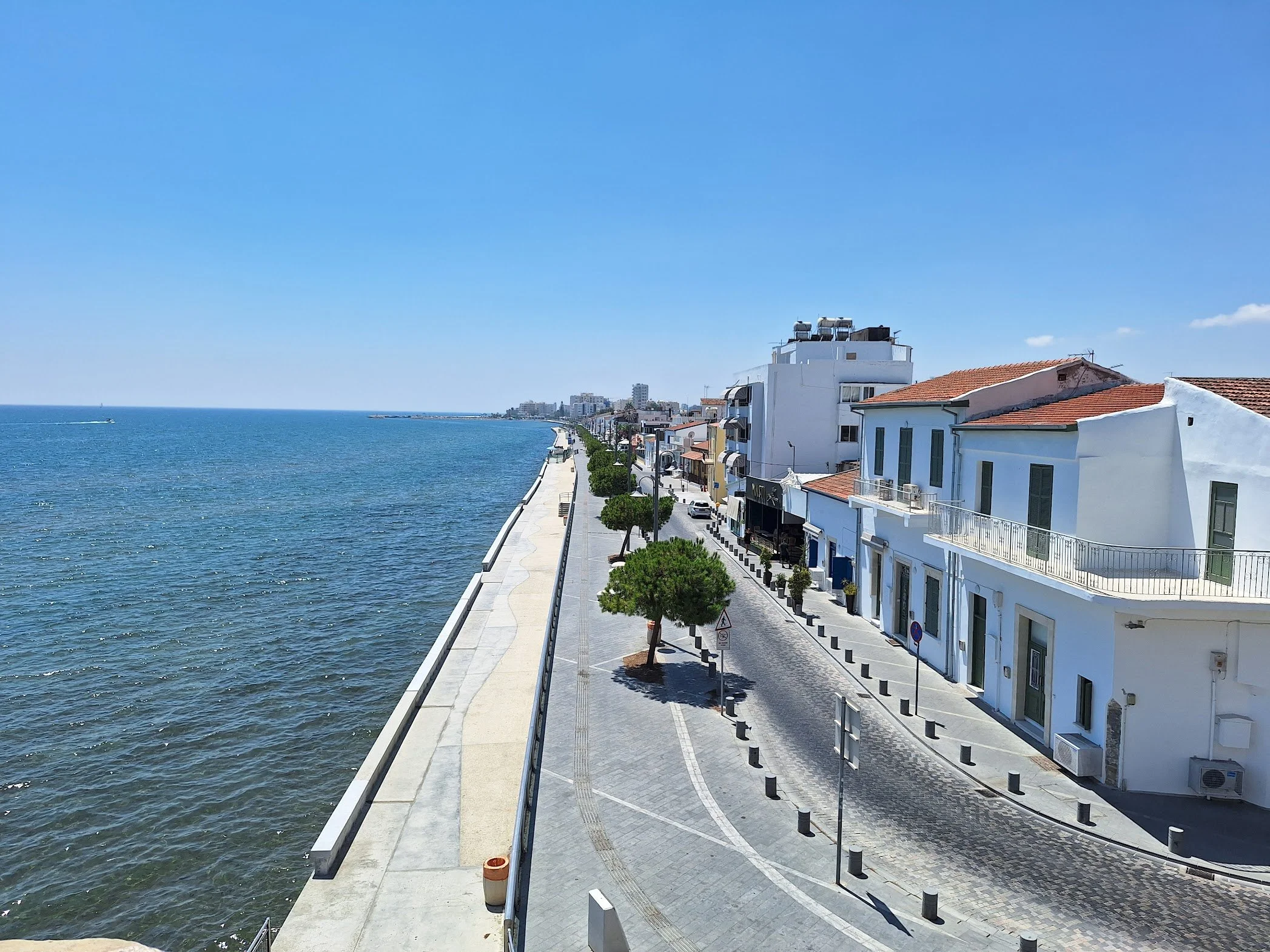

Further into town, the narrow streets guide you to the Church of Saint Lazarus, which is rumored to be the same Lazarus that Jesus raised from the dead! Apparently he became a missionary on the island of Cyprus and eventually was buried under the current church.
For all the history and travel nerds, Cyprus had a wild ride in the 70s, largely thanks to Henry Kissinger. There was a coup d'état carried out by forces backed by Greece and then a counter invasion by the Turkish Army. We visited Famagusta, a city that was vacated by Greek Cypriots as the Turkish Army approached and is abandoned to this day, with its original inhabitants denied re-entry by Turkish forces.
Famagusta, Cyprus
Today the Republic of Cyprus is home to 1.25million people who mainly speak Cypriot Greek (although remember 10-ish% of population are ethnic Turks). Their culture is similar to Greece: shared religion, alphabet, and language. But you can also see the impact of centuries of Ottoman Rule and decades of British Occupation on the island.
Next time (because we’re definitely going back), we’ll head North and West, exploring the capital, Nicosia and the wine region of Paphos.








For the Love of Doors
I slam the car door shut, grab my luggage and walk confidently through the automatic doors of Seattle-Tacoma International Airport. I love an airport for its palpable buzz and the intense people watching. I can’t wait to throw my bag onto the conveyor and walk towards my gate. Not because I enjoy standing in line or going through security checks, but because with each doorway I pass, something promising awaits.
Our love of travel was icing on the cake when we decided to move abroad, and transitioning from one port city (Tacoma/Seattle) to another (Abu Dhabi/Dubai), has opened up worlds of opportunity to see life outside our Northwest bubble.
Somewhat recently, I started to take pictures of the beautiful doors or passageways we encountered. I was reluctant at first, because it felt very 2007 and a certain type of Tumblr persona. Being the English teacher that I am, I think of doors as symbolic. Each door I photograph, I pause, take in the details, and envision the story it tells.
Baku, Azerbaijan
Vilnius, Lithuania
St. John’s Co Cathedral, Valletta, Malta.
Yerevan, Armenia
Is this door sacred?
Did this door provide security and protection for someone?
Did it keep people out or hold people in?
Did this door welcome newcomers?
Did this door invite the community to experience God in a new way?
For the most part, I will never know the answers to my questions. All I can do is take a moment of my time to appreciate the intentional craft, beauty, and history represented in front of me. And maybe convince my spouse to take a silly pictures (scroll to the bottom of this post).
Tashkent and Samarkand, Uzbekistan
Samarkand, Uzbekistan
Don't Spill the Tea
Technically, Nate did spill the tea about the ins and outs of our weekend away in Samarkand and Tashkent, Uzbekistan. What he didn’t share was the national obsession with tea.
Every country has a national beverage. You might be imagining arak, raki, aguadiente or maybe Miller Light. But according to Pew Research (I know, it’s so pretentious to embed this link), thanks to colonization the world can be divided between tea countries and coffee countries. With the exception of the Philippines and South Korea, “coffee predominates in the Americas and in continental Europe, while tea is preferred in most of Asia and the former Soviet Union.”
Our last few trips to the Caucuses provided us some education on the tea vs coffee divide. Knowing that Georgians and Armenians trade in both coffee and tea, while the Azeris primarily rely on tea, I was curious to see what our journey eastward would prove. To our delight, Uzbekistan was the land of tea. Fruit dominated the scene but the bits and bops of cinnamon, all spice, and anise floated through many pots.
Today, I present to you highlights from our teacation.







Nate wraps up our trip with a cup of strong Turkish tea.
Traveling Through History In Uzbekistan
Originally posted in Nate’s weekly newsletter Takes and Typos on March 17, 2024
The Republic of Uzbekistan was born in August 1991. It was one of the 15 states that emerged from the fall of the USSR. Uzbekistan is landlocked, jammed among its Central Asian neighbors: Kazakhstan to the north and west, Hermit-ish Turkmenistan and Afghanistan to the South, and Kyrgyzstan and Tajikistan to the East. In recent decades the country has leveraged its natural gas and mineral wealth to modernize its infrastructure and cities.
Manti, Uzbek style dumplings
Like the rest of its Central Asian cohort, the country is geographically and politically situated between Russia and China and resides in the spheres of each state. We noted this repeatedly in our travels. When we took the train from Tashkent to Samarkand, we rode along rails laid during the Soviet era but on a high-speed train car, manufactured in China. The metros in Tashkent are built in the ornate Soviet style that Tucker Carlson recently gushed over in Moscow. One of the two national dishes is manti, a dumpling dish that arrived in the country from China along the Silk Road.
Upon arriving in Tashkent we found the capital busy, clean, and notably quiet. I’d say 60% of the women wear hijab but more in Samarkand than Tashkent. Uzbeks are very reserved people. They don’t smile much; they don’t chatter much in public. They greet each other quietly with a handshake and a meeting of the forehead. I joked to a friend this week that "full metro cars and weekend markets in Tashkent were quieter than three Jordanian dudes having lunch."
The Gūr-i Amīr mausoleum of the Turco, a Turkic Conqueror
Like Azerbaijan, which we’ve previously visited, the leader of Uzbekistan during the Soviet era, Islam Karimov, became the president after independence and ruled until his death in 2016. The country began to open itself to tourists in 2018. We saw other travelers in both Tashkent and Samarkand, but most of them appear to be Russian or Kazakh.
The historical sites in Uzbekistan are incredible. We toured mosques and madrasahs that date back to the 1400s and visited ruins the result of the Mongol conquest in the 1200s.
From what we could tell, Uzbeks don't really have a cafe or bar scene. This makes sense given the cold climate and conservative culture. On a few occasions, we walked towards busy-looking streets expecting to find restaurants or cafes and came up empty-handed. But the food we had was wonderful. Uzbek food is hearty, which again makes sense given the winters. The other national dish, plov, is a rice dish with stewed meat and vegetables—a Central Asian paella or biryani. It is also notable that people in Uzbekistan are decidedly tea, rather than coffee people. This was great for me because I don't particularly like coffee. I typically only drink the occasional espresso when I'm traveling. But I love tea and drank it at every opportunity possible.
Plov, an absolute banger of a rice dish
In preparing for our trip, I came across several videos calling Uzbekistan the “cheapest country in the world.” I thought these were tacky and felt a touch exploitative. That said, if you are budget-sensitive, traveling to Uzbekistan is affordable. The US dollar trades at 1:12,500 Uzbeks Soms. Most of the meals we had were in the neighborhood of 150,000 soms, so under $12 for two. The best meal we had, manti, plov, and tea service, at an understated cafe in Samarkand, was eight bones.
Tashkent very much has a Soviet feel. On a couple of occasions, we found ourselves taking multi-block detours to get around government ministry compounds. There are police everywhere. In our prior travels in post-Soviet states, we have found a vibrant nightlife and restaurant scene around Freedom or Independence Square. Not so much this trip. In Tashkent, Independence Square is in the middle of a quiet park.
Independence Square in Tashkent
In closing, let's talk about traveling while Black for a moment. Racism is real and not everywhere is safe for everyone to travel. I am not saying I am the first Black person to ever go to Uzbekistan but I didn't see any other brothers and sisters, and many of the people I encountered acted like I was the first Black person they'd ever seen in real life.
In a phenomenon I have not experienced since going to Beijing, in 2014, I was repeatedly asked by people to pose for photos. I obliged the first few. Hope overheard someone practicing saying “Welcome to Uzbekistan” in English before approaching us. As we walked through the Registan, I heard a couple of people yell “Hey, New York!” and wave.
That said, The people were very chill. I felt no hostility toward me. If you are a Black traveler you shouldn't have unusual safety concerns in Uzbekistan.
On the whole, this was a great little adventure. The people of Uzbekistan are welcoming. The food is solid to great. The history is unavoidable and compelling–it’s literally in your face everywhere you go. When I was a kid in geography class, Pyongyang, Tashkent, and Harare were the most exotic sounding places on Earth to me. It’s really cool that I got to visit one of them.
A Quick Oman Travelogue
Over National Day weekend, Hope and I took a trip to Sohar, Oman. While crossing the border we had a small miscommunication with the border agent over duty-free allowances. Boom! I suddenly felt filled with feelings I hadn’t experienced in a long while. I don’t miss that feeling and it exploded back into my brain and kept a hold of me for the better part of a day. I addressed it a bit in the most recent Takes & Typos newsletter.
The drive to Sohar, the captial of Al Batinah North Governate in Oman is a tidy three hours across the interior of UAE. The sudden transitions from the cityscape of Abu Dhabi, to rolling dunes of Al Ain, to craggy Omani Mountains, to quiet coastline along the Gulf of Oman are remarkable.
Fun fact: Sohar claims to be the birthplace of Sinbad the sailor!
It was my first time in Oman, Hope’s second, after attending a conference in Muscat in pre-Covid times. I was struck by how it feels more traditional and slower than on this side of the border. There aren’t delivery drivers slaloming through traffic. The roads are less congested. The landscapes are varied and breathtaking. And of course, the food is solid, heavy on seafood for obvious reasons.
View of the Gulf of Oman from the Corniche in Sohar
The Sohar Fort is located across the street from the waterfront facing the Gulf
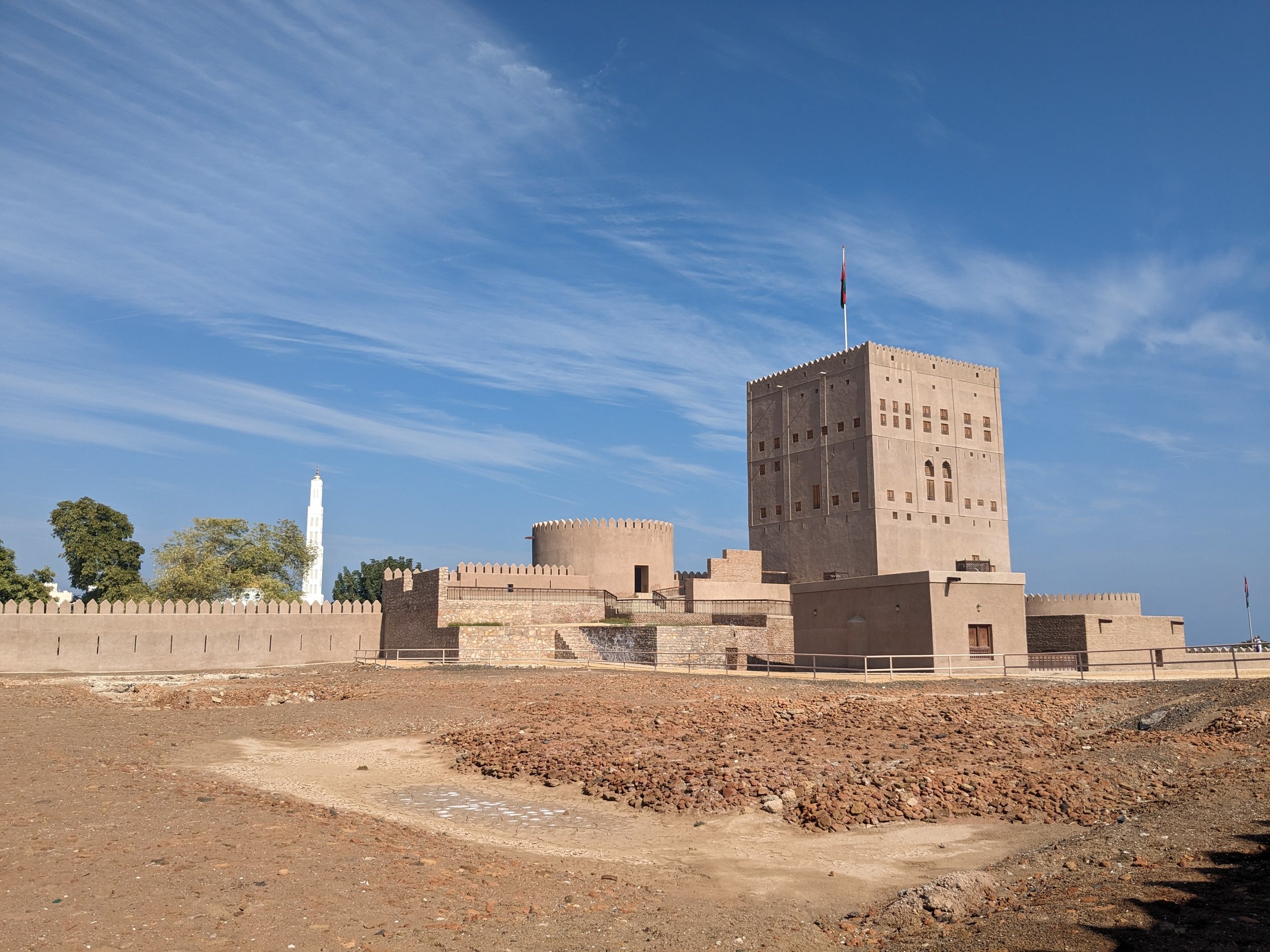
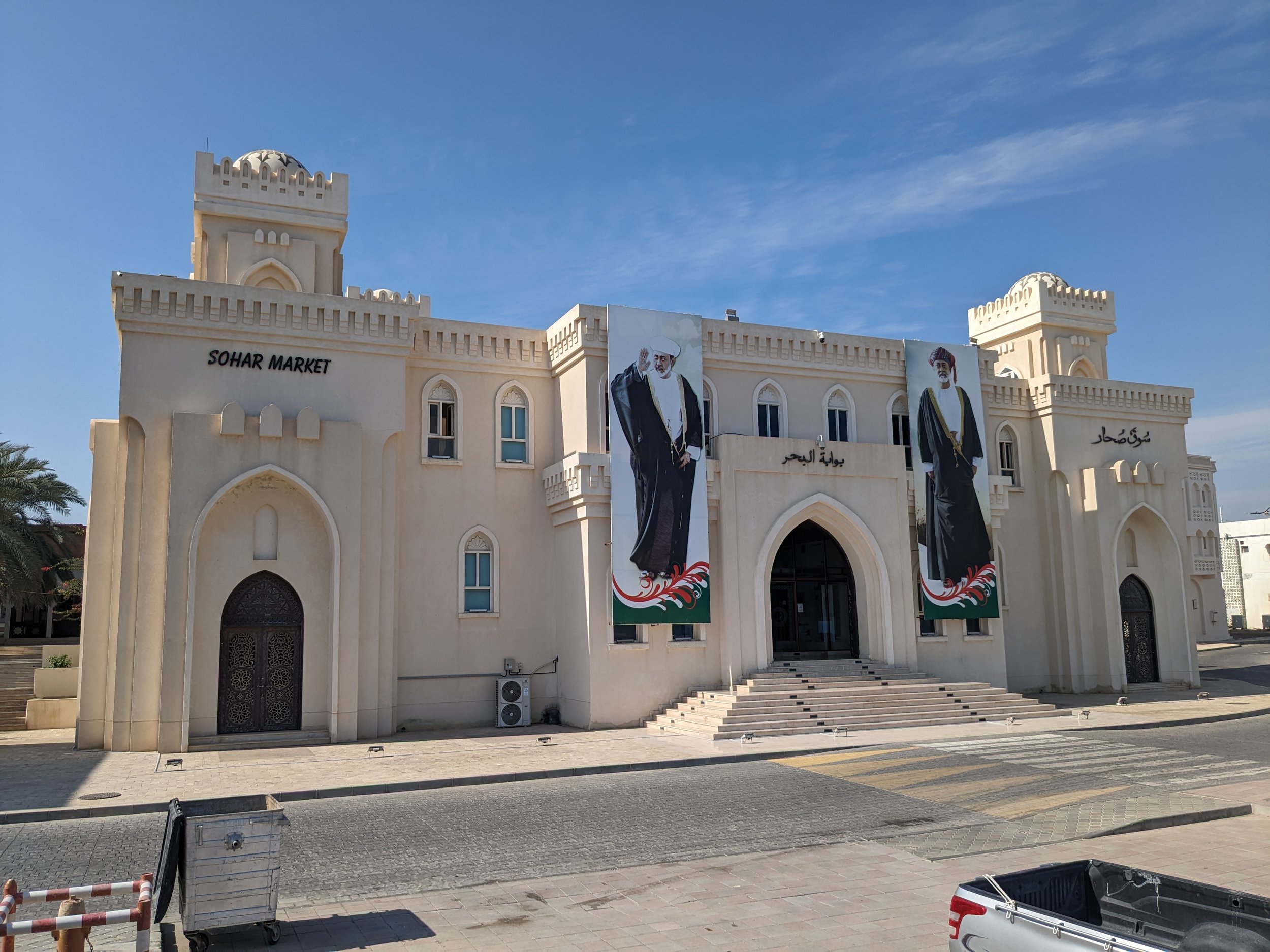
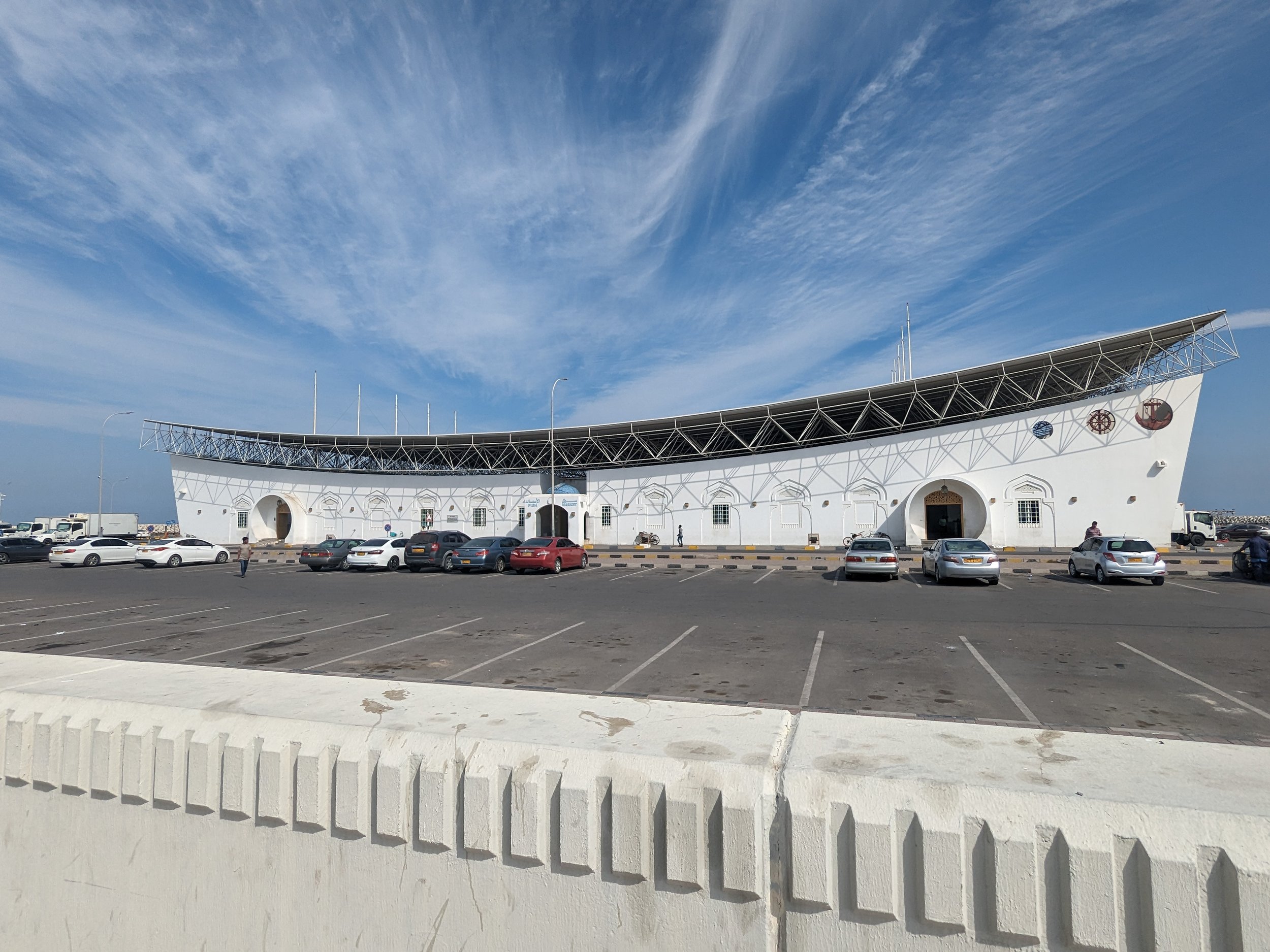
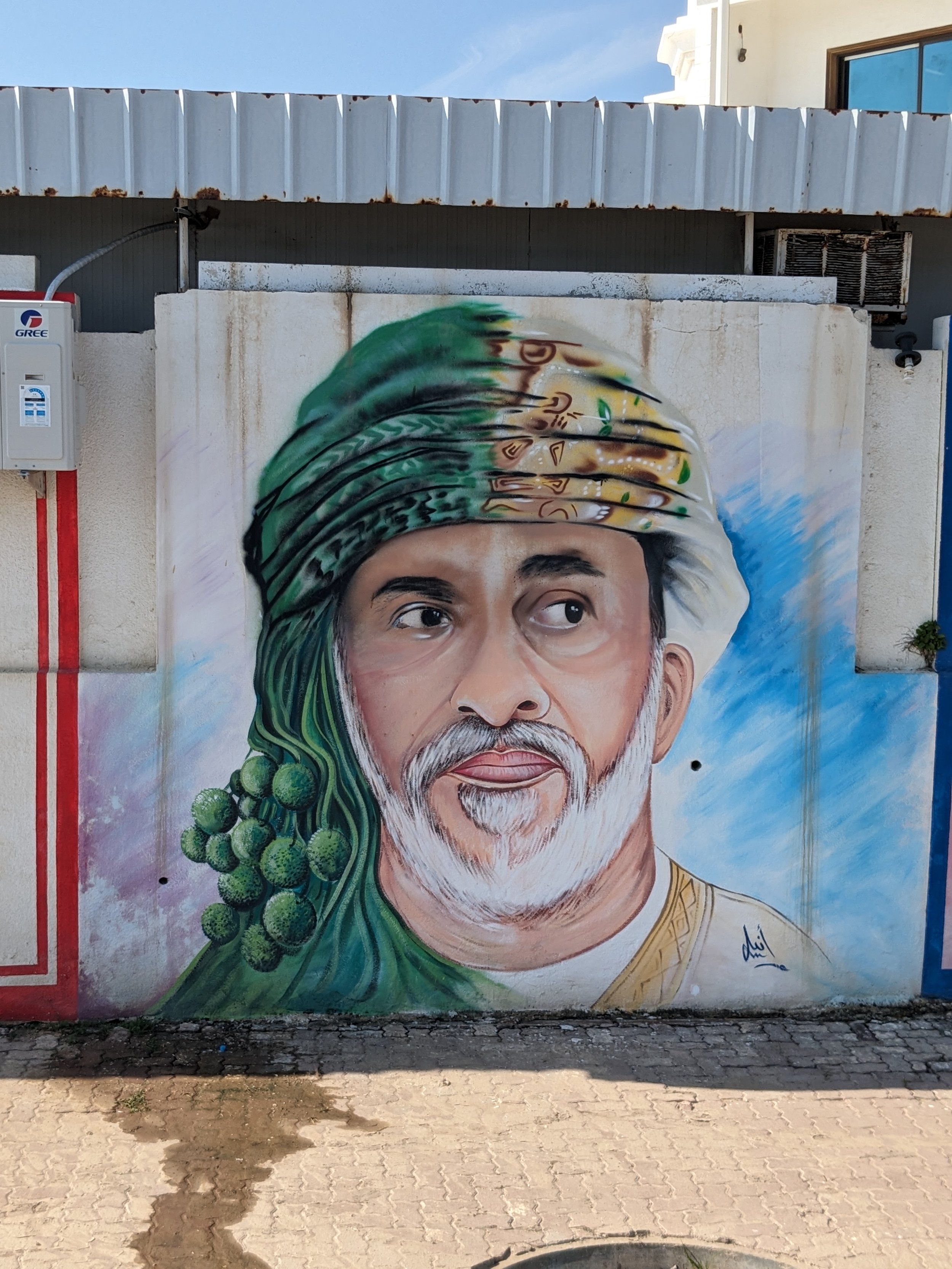
Minus the border fiasco, it was an enjoyable time and if you’re reading this in the region (or planning a trip), I recommend popping over to Oman and enjoying its unspoiled landscapes.
Cornering the Caucasus: Yerevan
City Center, Yerevan
The crisp fall air hit our faces as we stepped outside the airport and bulky men with cigarettes precariously pinched between their lips offered “taxi?”
Yerevan in October is picturesque–reminiscent of any bustling city in the throes of the fall season. Red, orange, and yellow leaves dot the sidewalks. Couples laughing over wine or brandy at a local cafe. Tourists wide-eyed, trying to read signs in Armenian and English. Bakeries, hookah bars, and shaurma shops (yes, the spelling is different) line the street inviting you to take a moment for yourself.
One of our favorite things to do in a new city is just walk. We let “the spirit lead” the way as we turn down narrow alleyways, stop for an espresso, or decide to pause at a beautiful church.
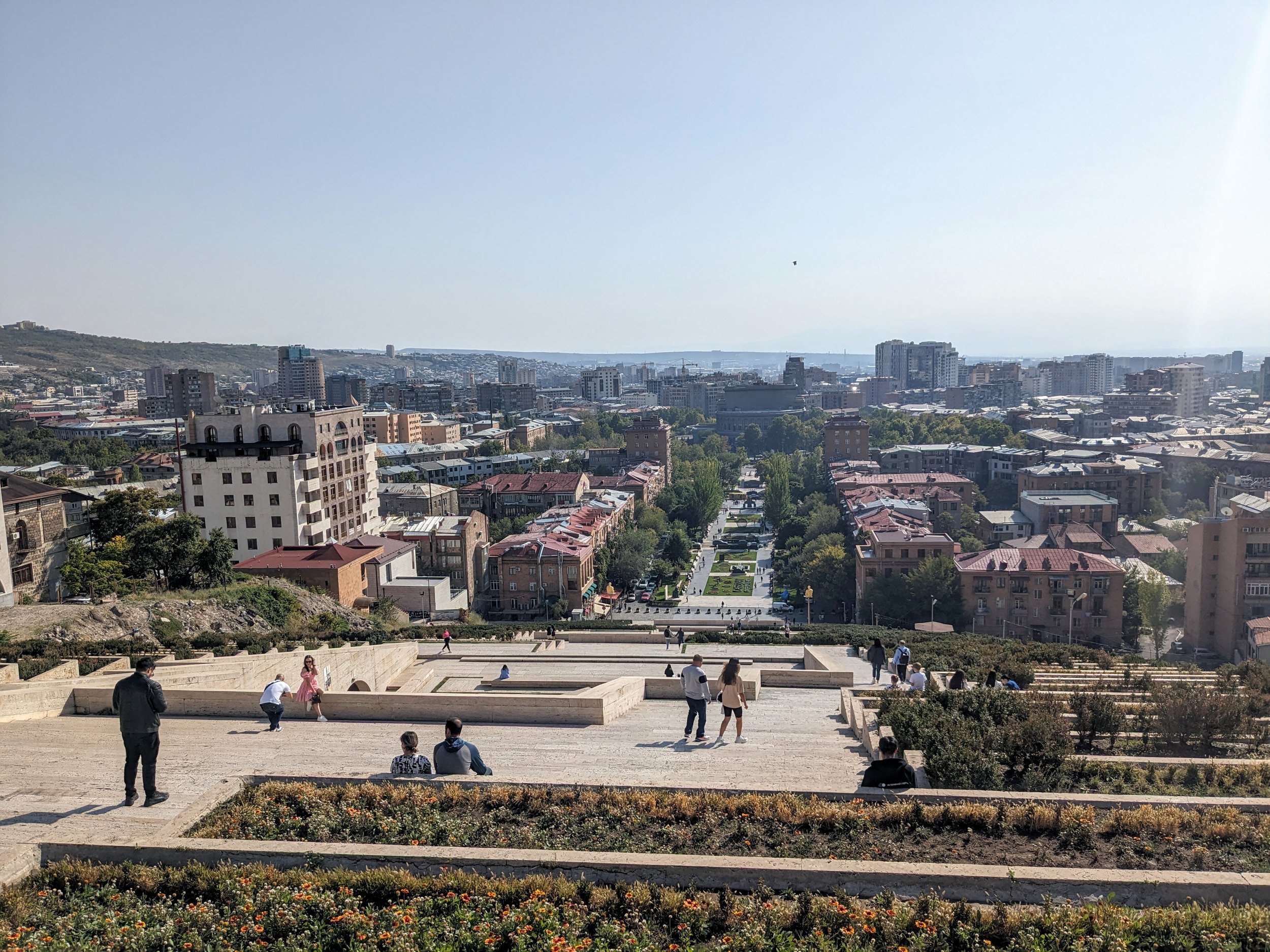
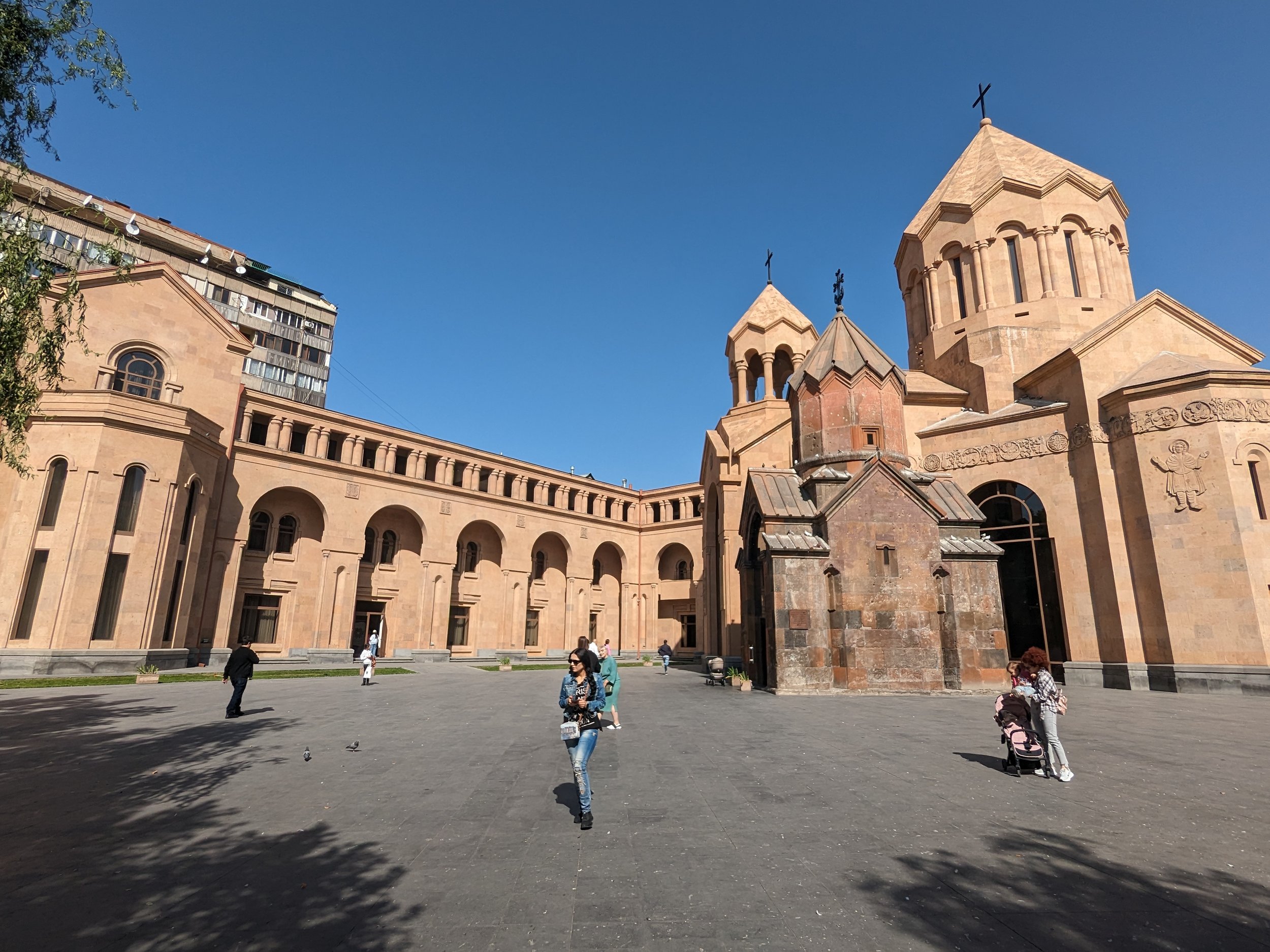
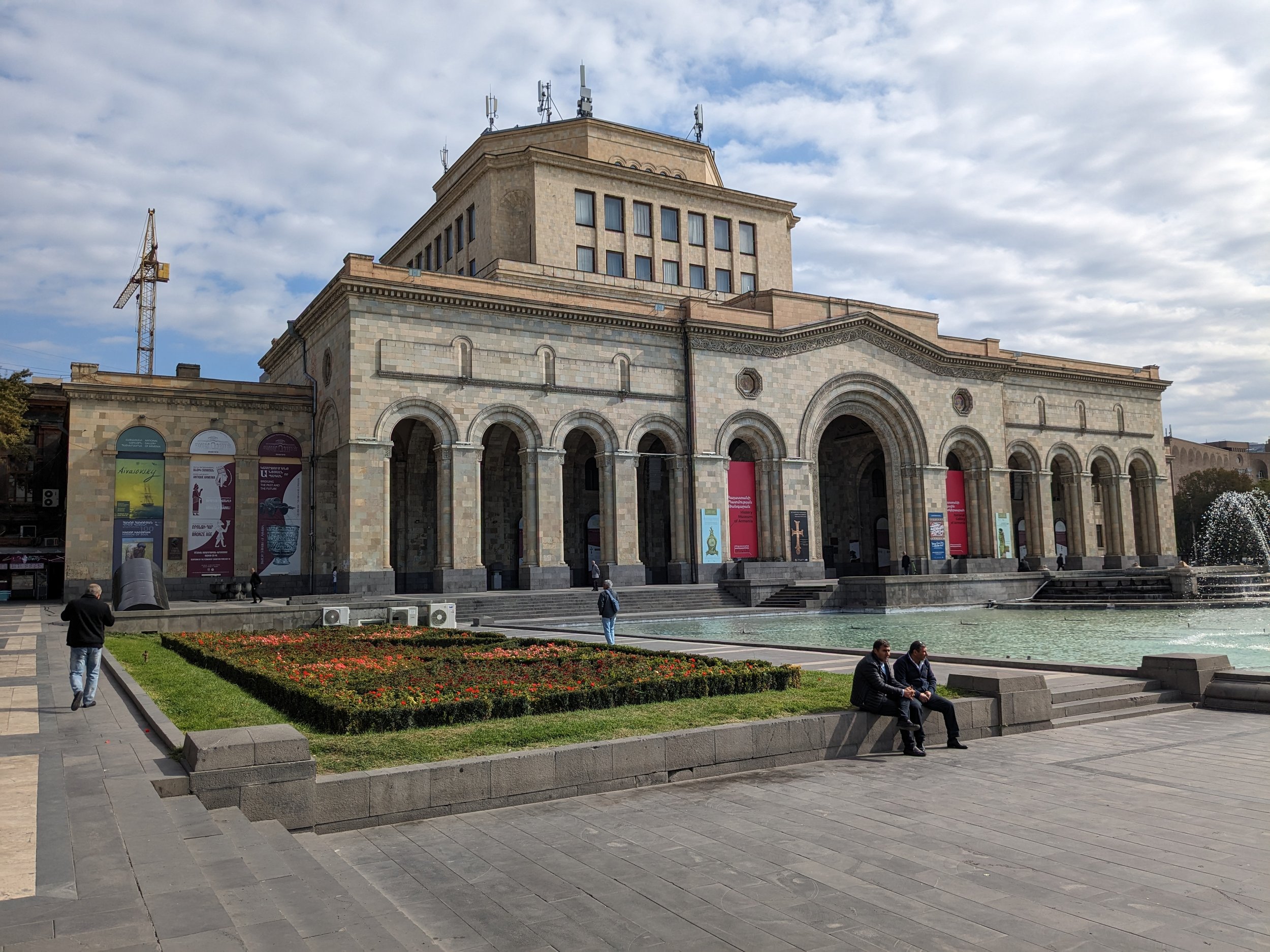
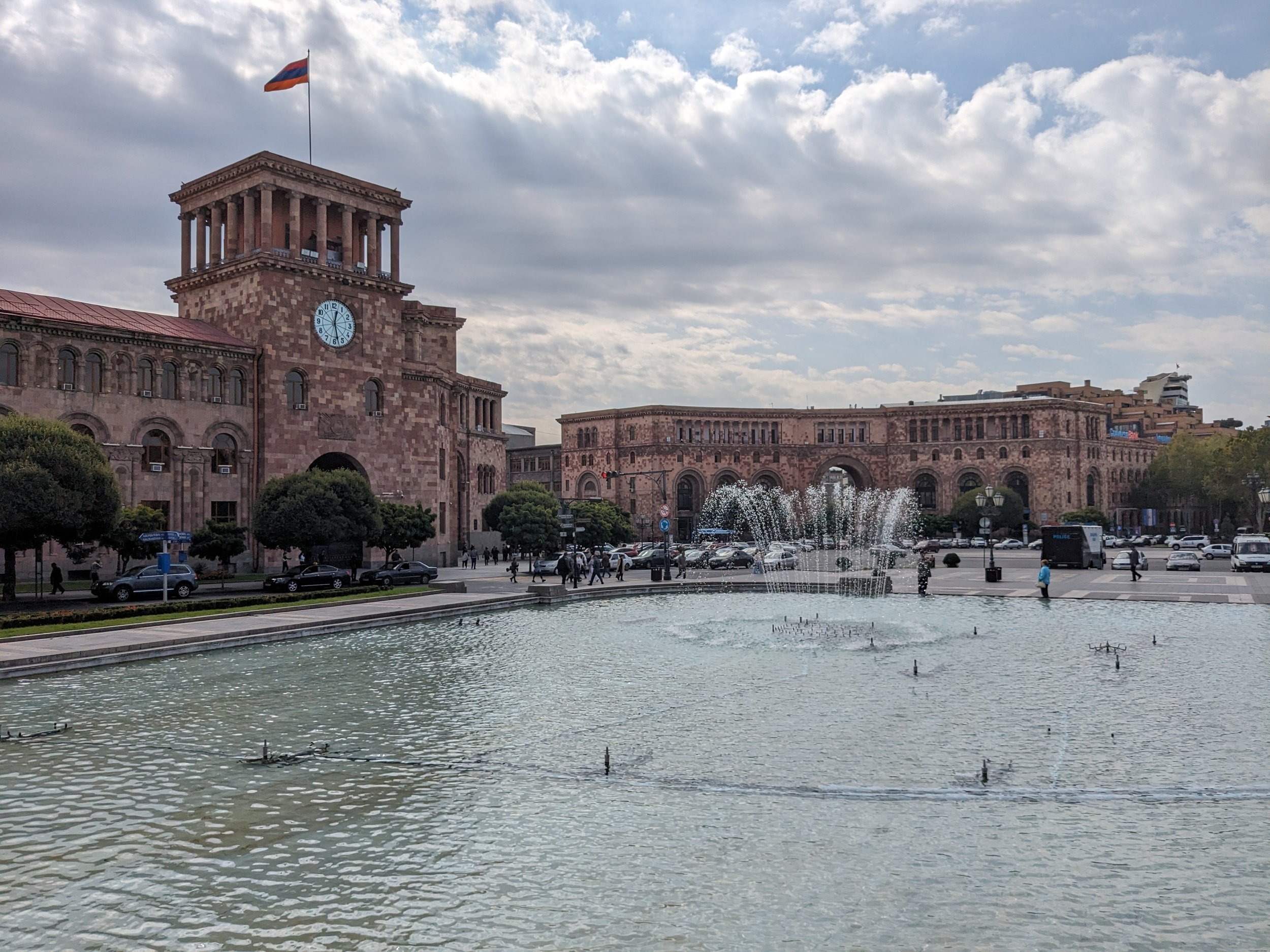
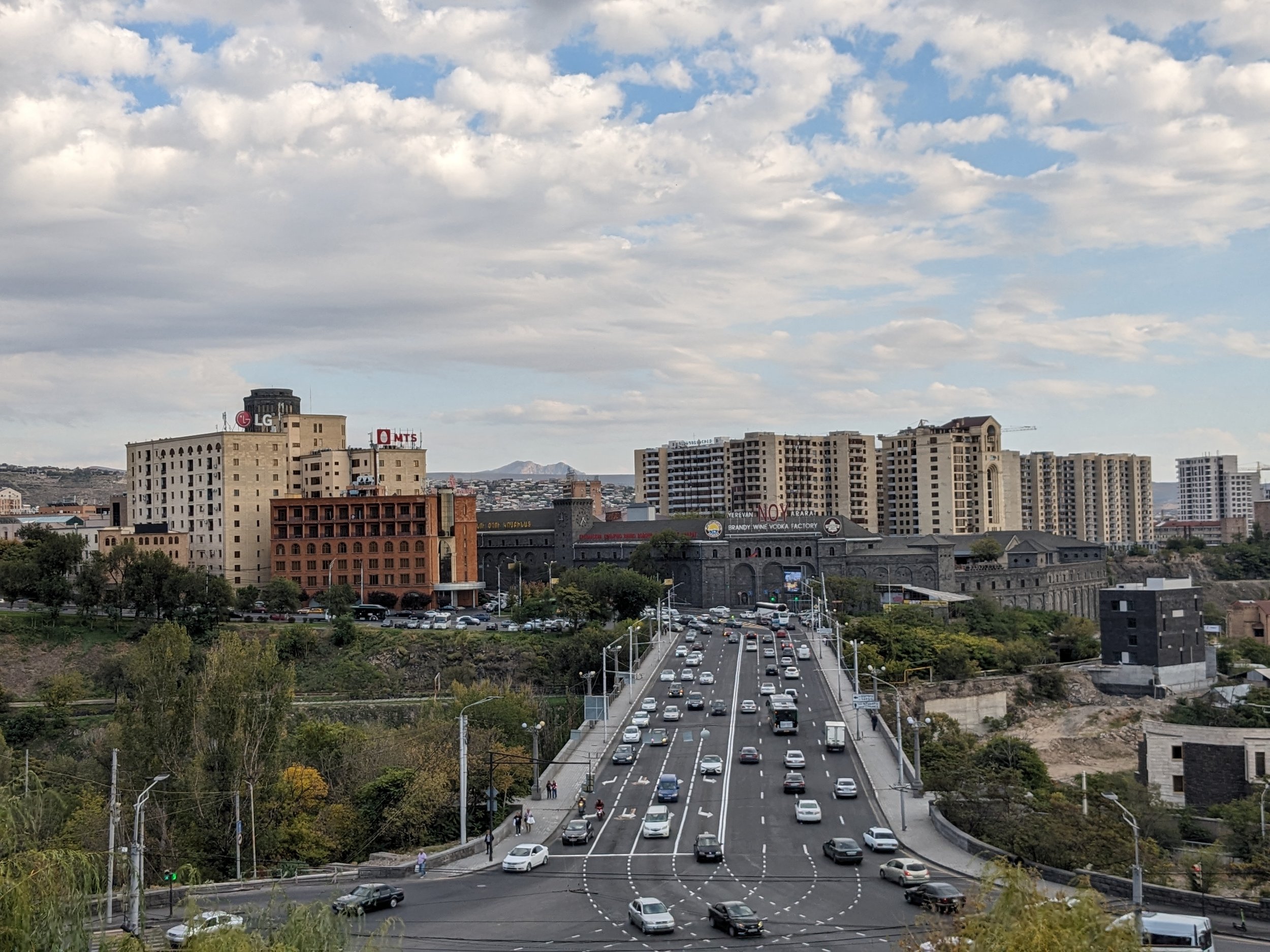
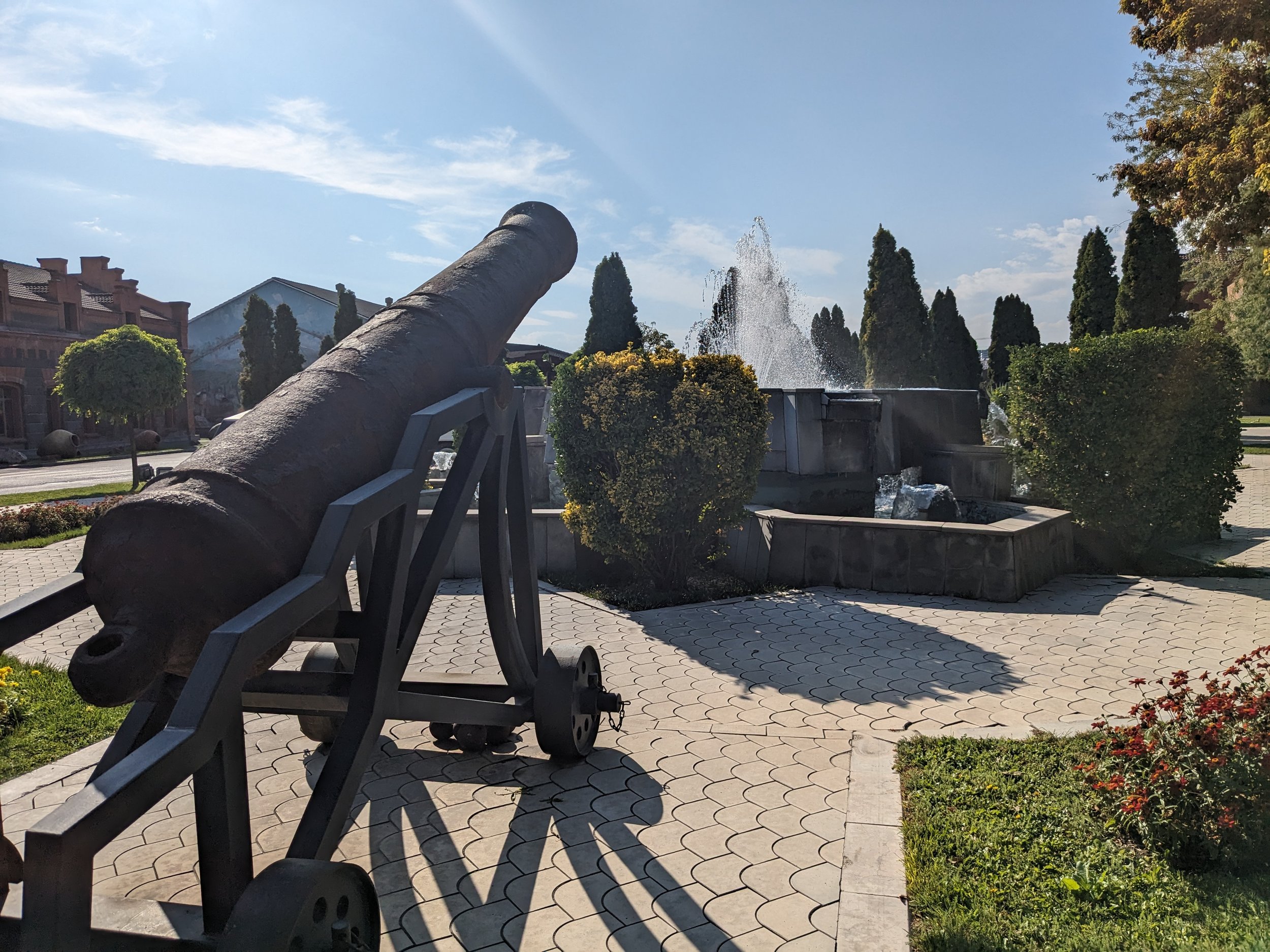
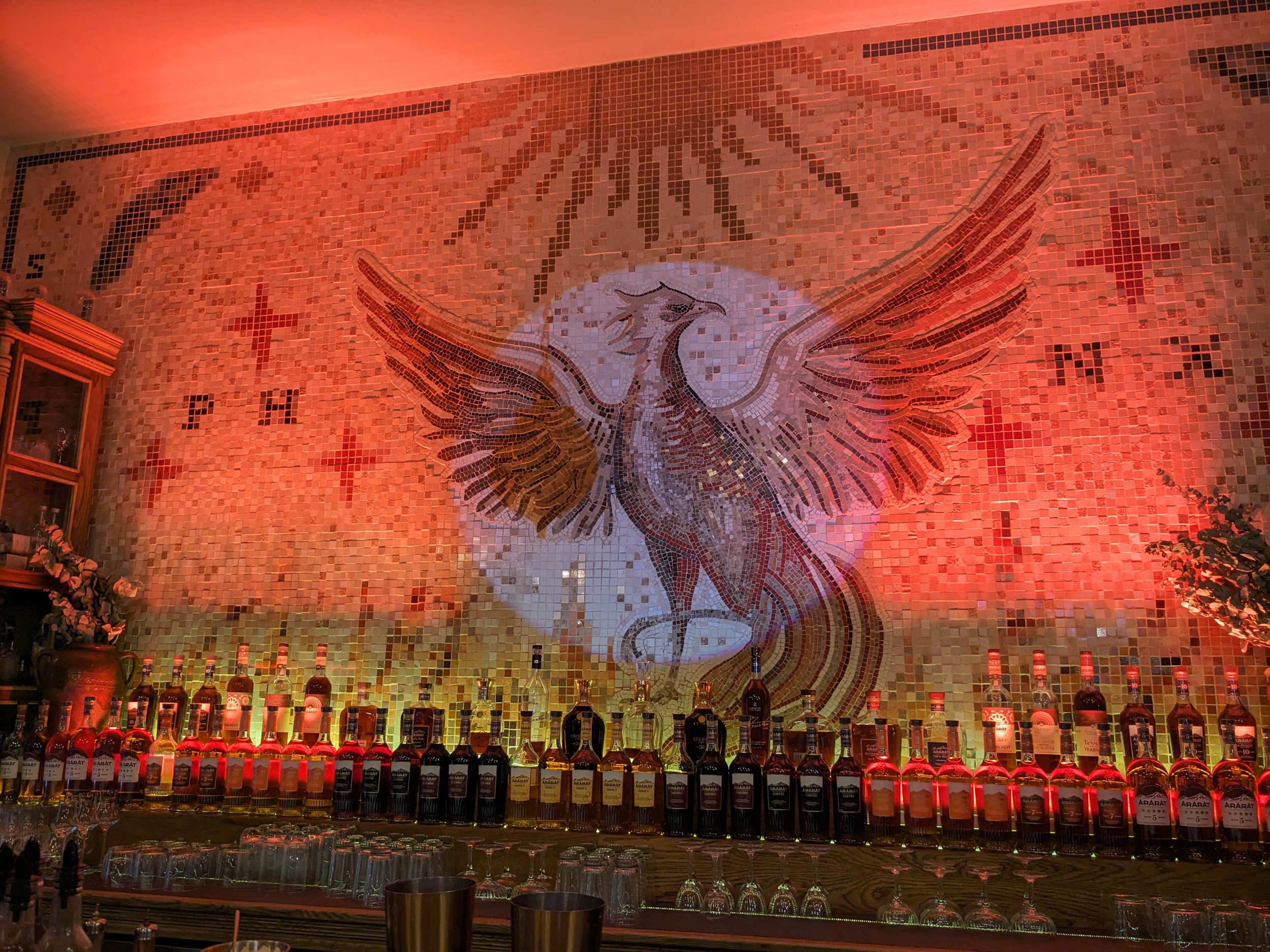
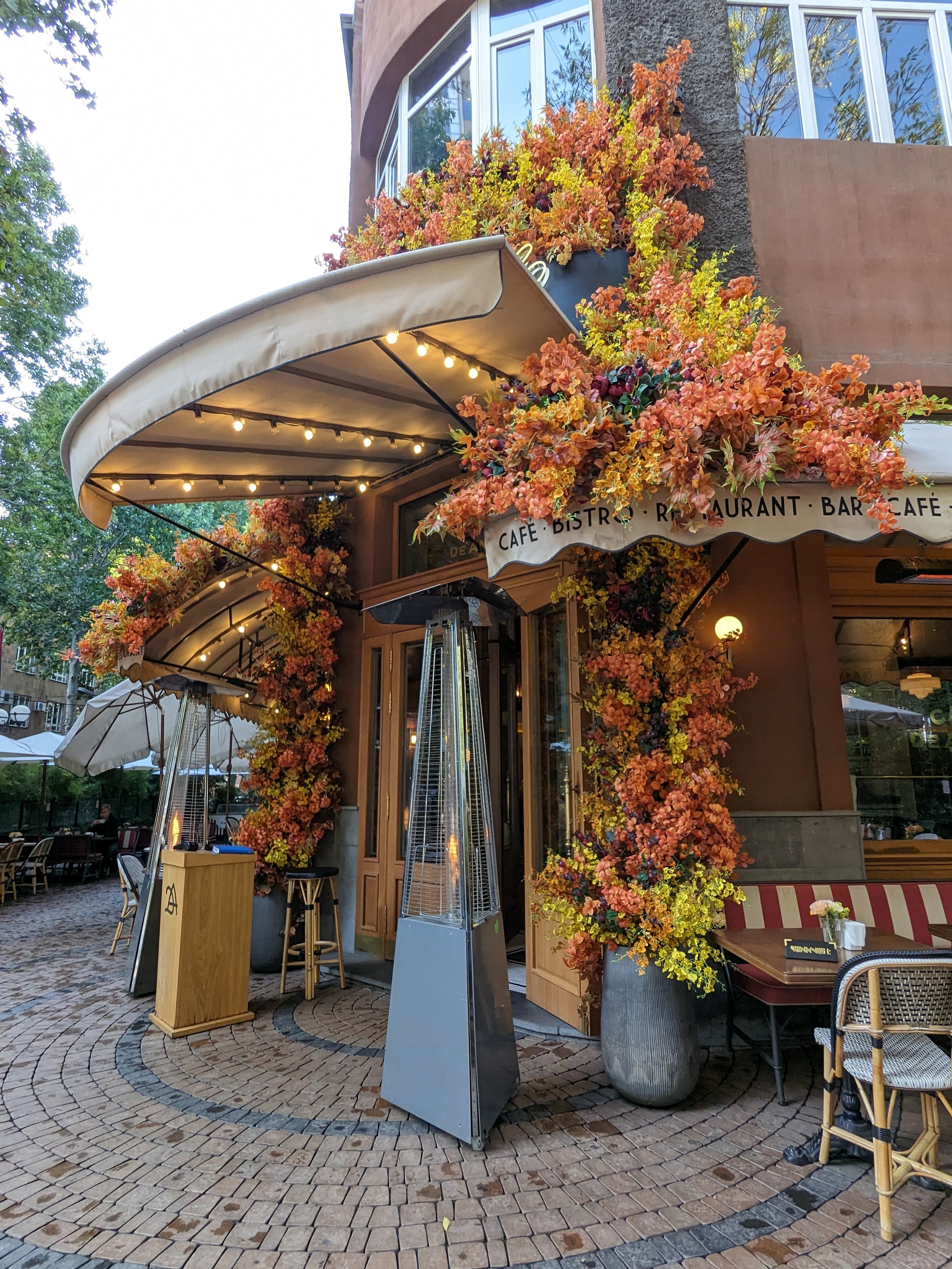
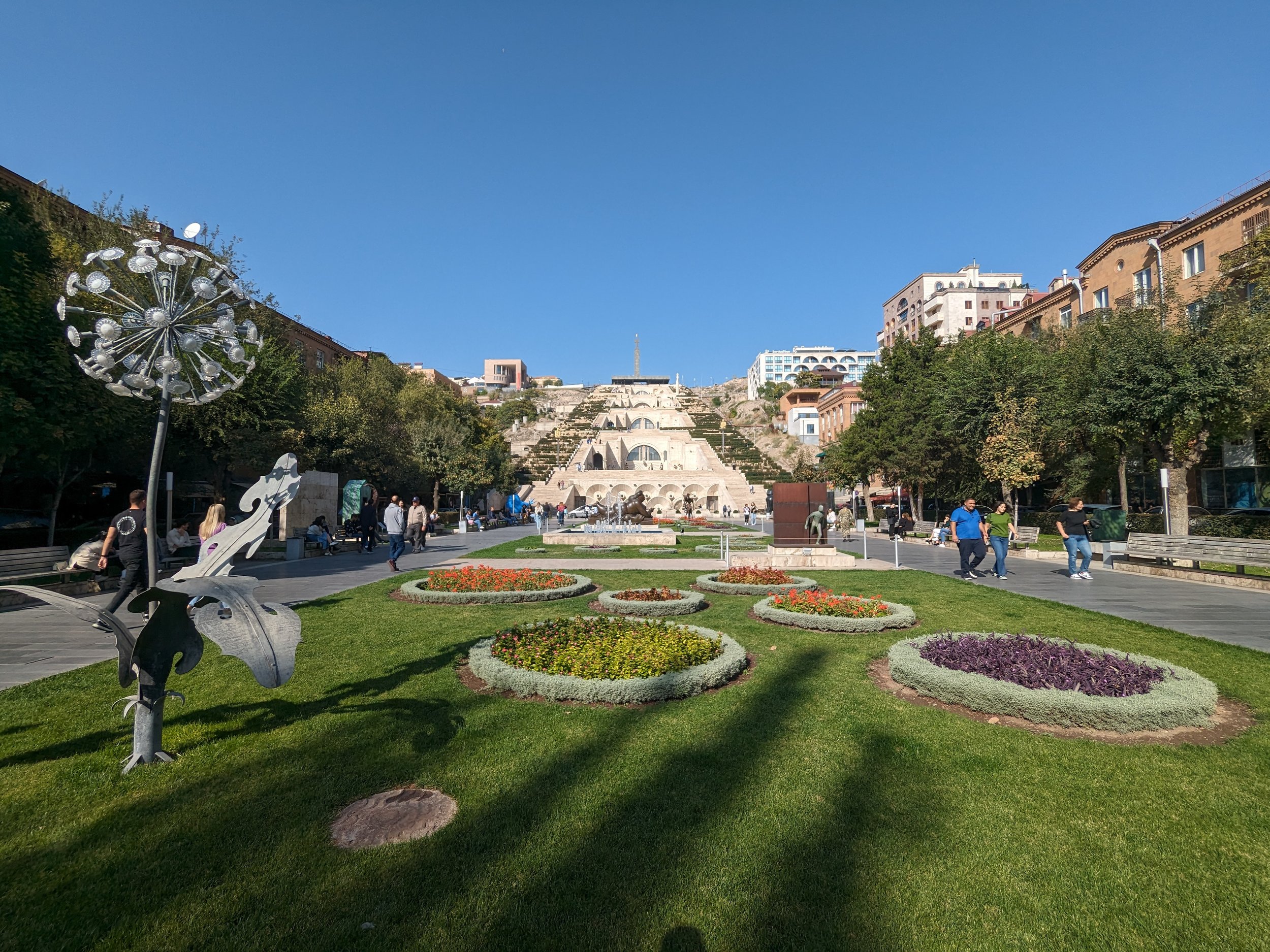
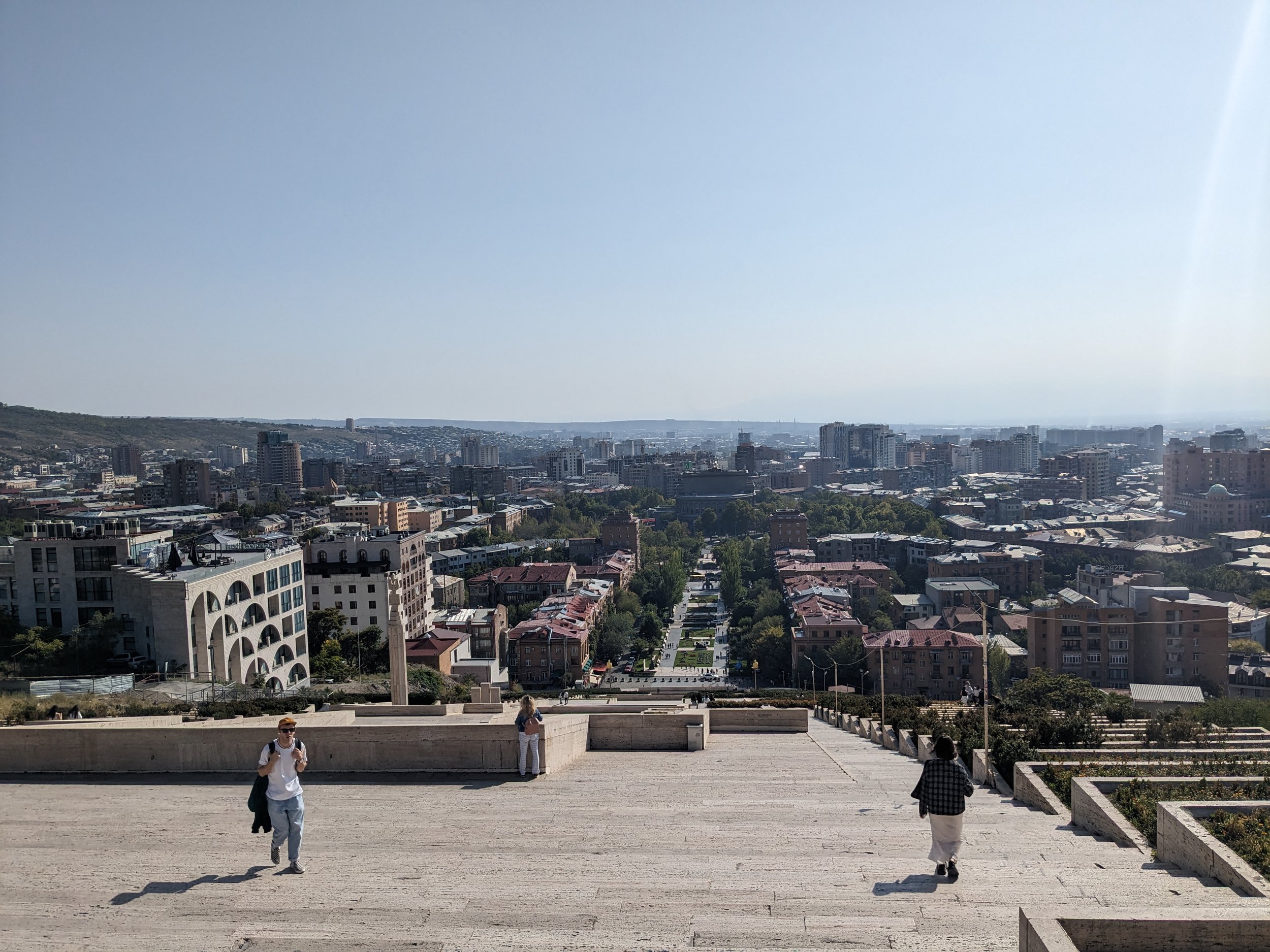
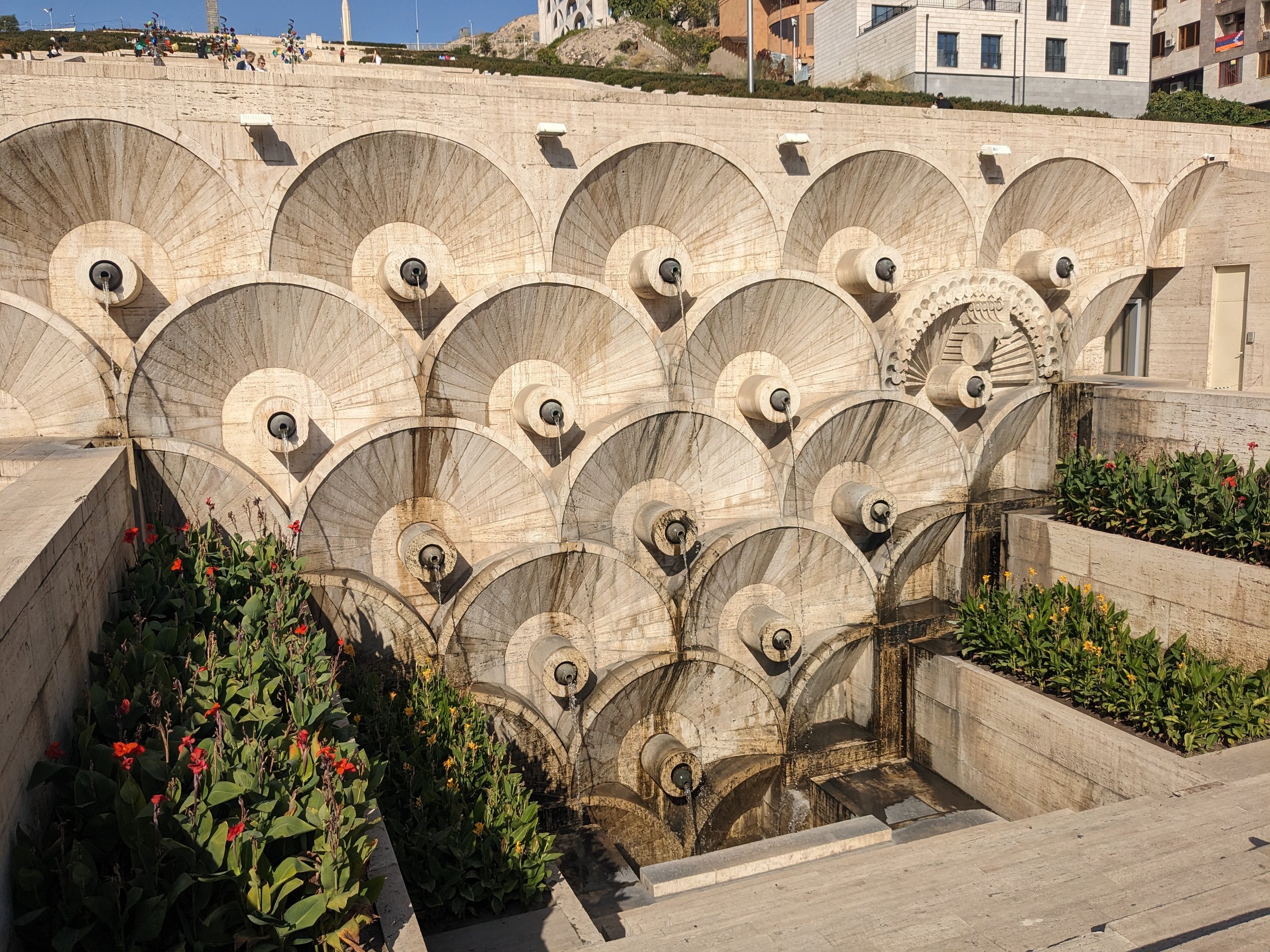
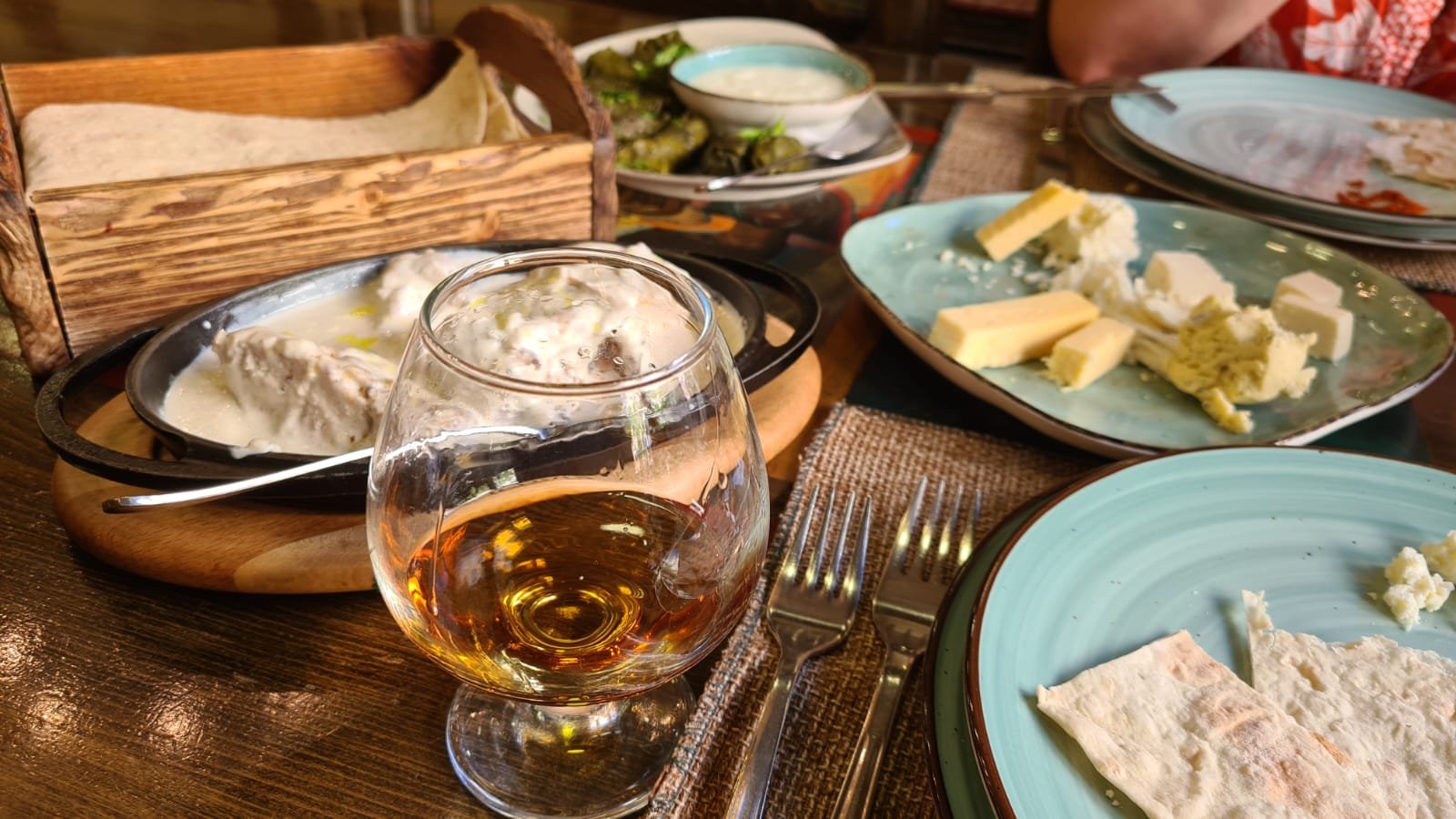
The City
While Yerevan feels like so many cities we’ve traveled to, it also has its own beat. One distinguishing element is the towering and magnificent Mount Ararat in the background. We could never actually capture this on camera but often found ourselves staring at it. Another aspect is the undercurrent of a complex history informing the daily lives of people today as Nate noted in his blog post.
Nate thinks she looks like my grandma…
The Blue Mosque (image to the right) is the only mosque remaining in all of Armenia, serving as a place of worship, a museum, and a language center. A lovely Armenian woman originally from Iran gave us a short tour of the grounds, leaving us with stories of the past and a tour of her classroom where she teaches Russian!
A trip to Yerevan would be incomplete without a visit to the Armenian Genocide Memorial & Museum. Obviously as educators, we prioritize learning about a country’s history–even the tough parts. As awful and heartbreaking as the experience always is, we are forced to see humanity's most cruel moments and consider how we might live today with more empathy and kindness to those that are different from ourselves. It’s also a reminder why telling a group of people to “get over it” when it comes to such atrocities is ridiculous. Be it about slavery, the Holocaust, the Armenian Genocide, or what’s happening in Gaza today, pain and trauma is deeply rooted in a community and it takes immense effort to take steps towards healing.
Day Trips to the Countryside
As we age, we find ourselves succumbing to local tours. In the old days, we’d hop on public transportation, gesture our way through a bus station terminal or haul our backpacks on a train. I’m not above that by any means and don’t get me started on my favorite places in the world and their beautiful metro systems (Mexico City, I see you. Hong Kong, I have not forgotten).
Adding complexity is that some places we travel would be too stressful to try to drive through. The Armenian countryside proved to be such. As we dodged cows, followed detours through villages, we appreciated our driver, Edgar’s adept ability to maneuver the minivan as we focused on Nina’s tour.
First stop Sevanavank monastery overlooking Sevan Lake.
A quick stop for lunch at a popping side-of-the-road cafeteria, the Tsovagyugh supermarket and food court. Note the lavash is easily the size of a throw-blanket!
Next up Goshavank monestary built in the 10th-13th centuries. Words cannot describe the serenity and wonder I felt standing on these grounds, imagining this as the hub of community it provided.
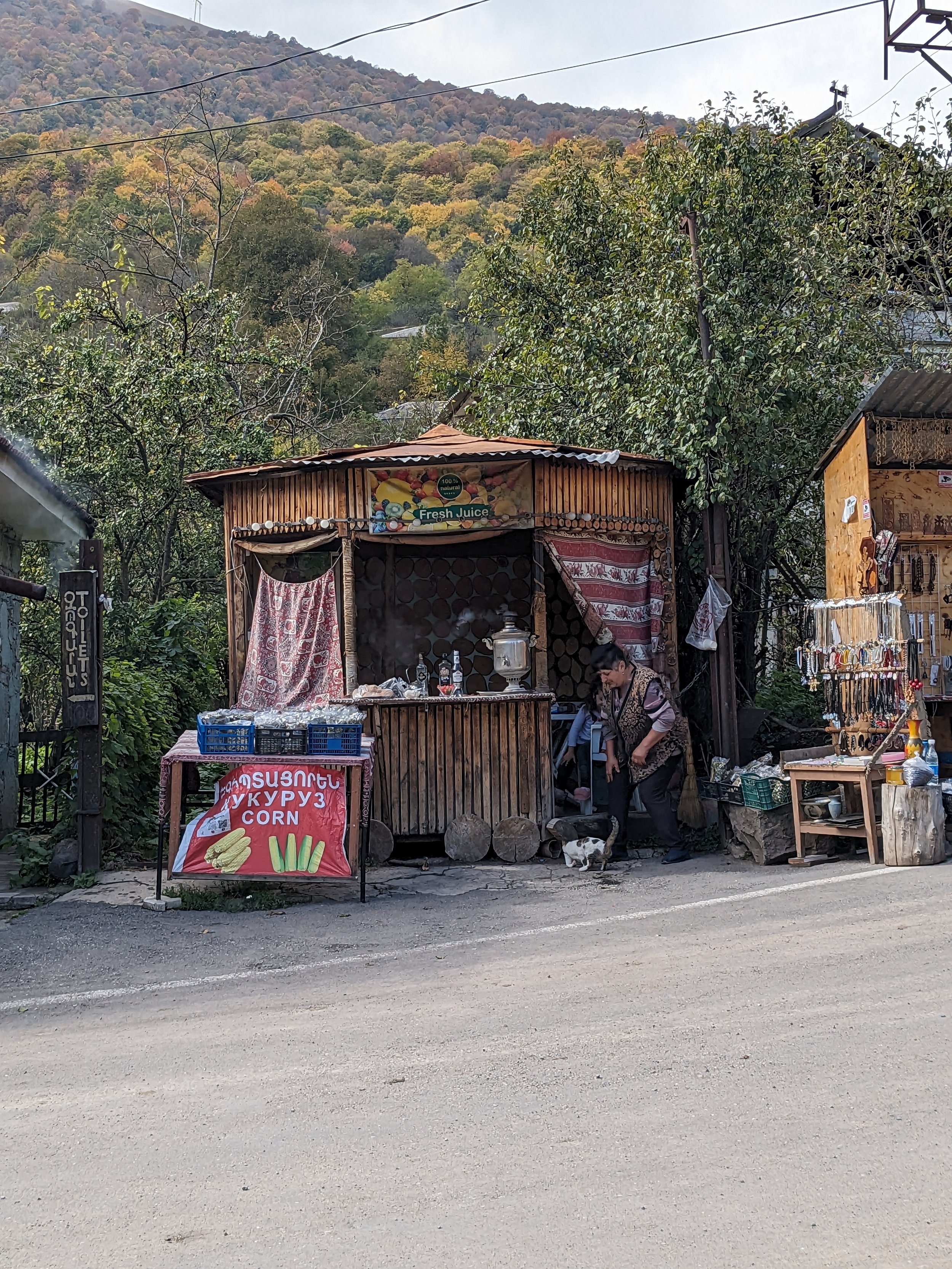
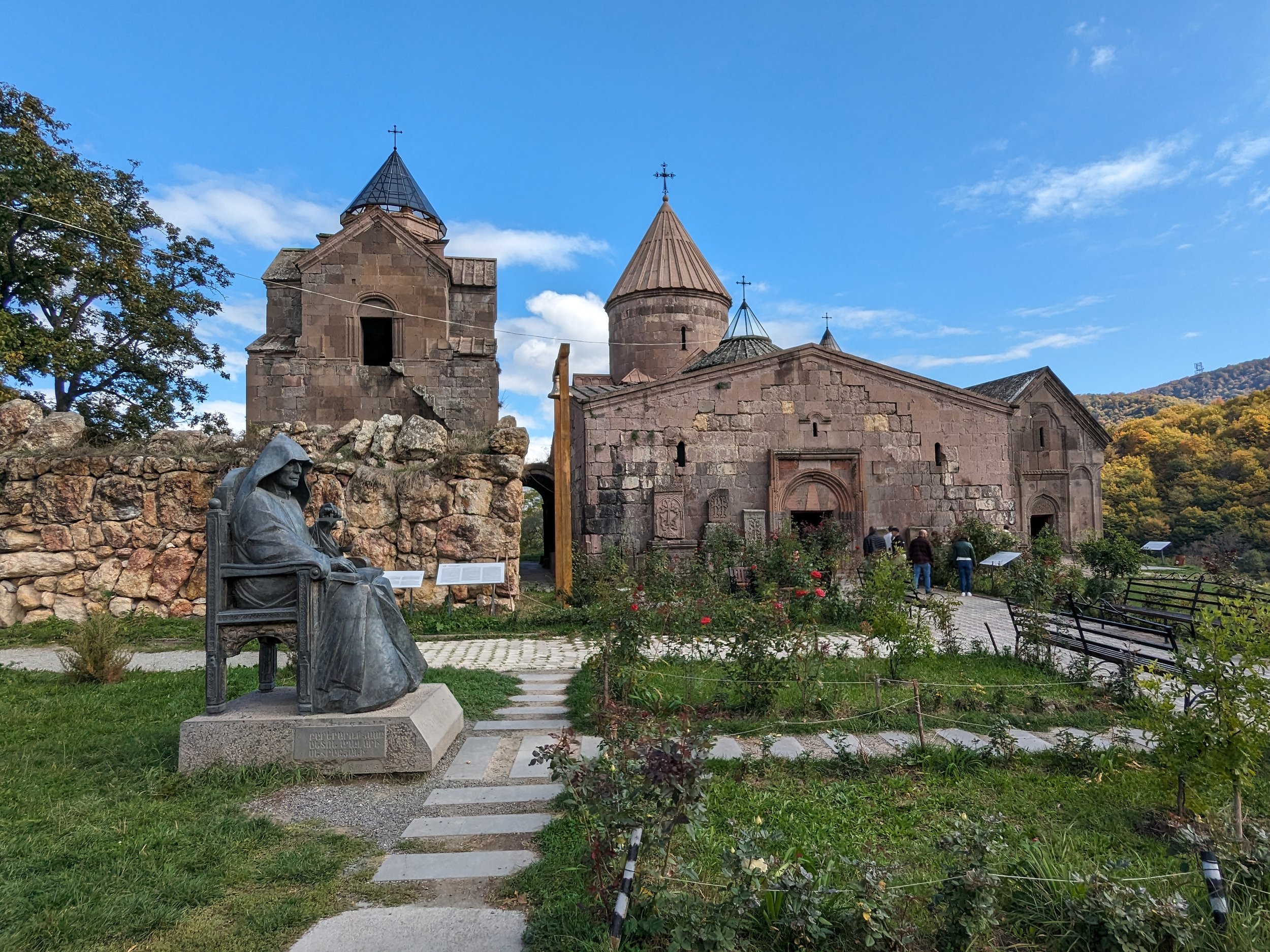
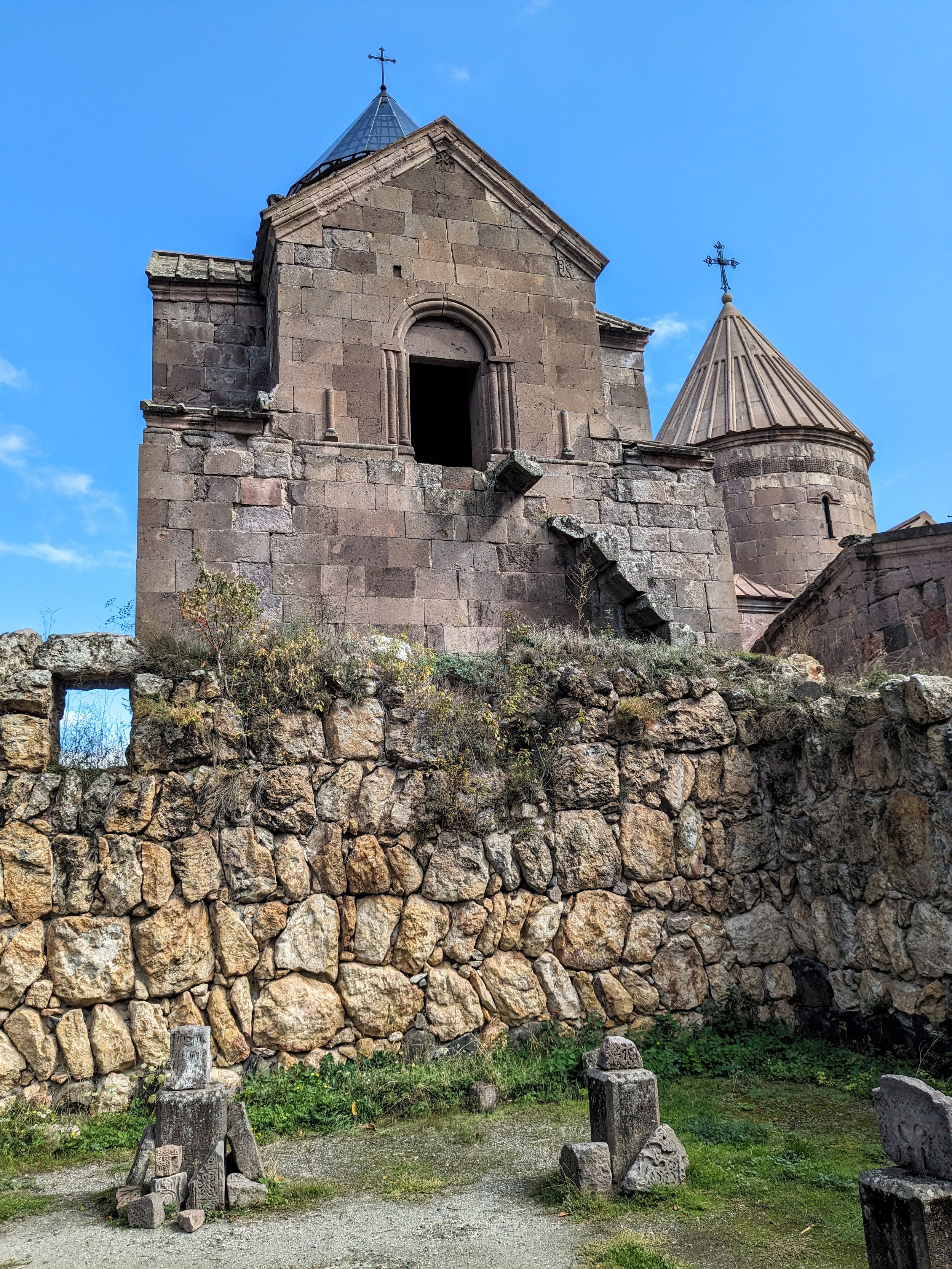
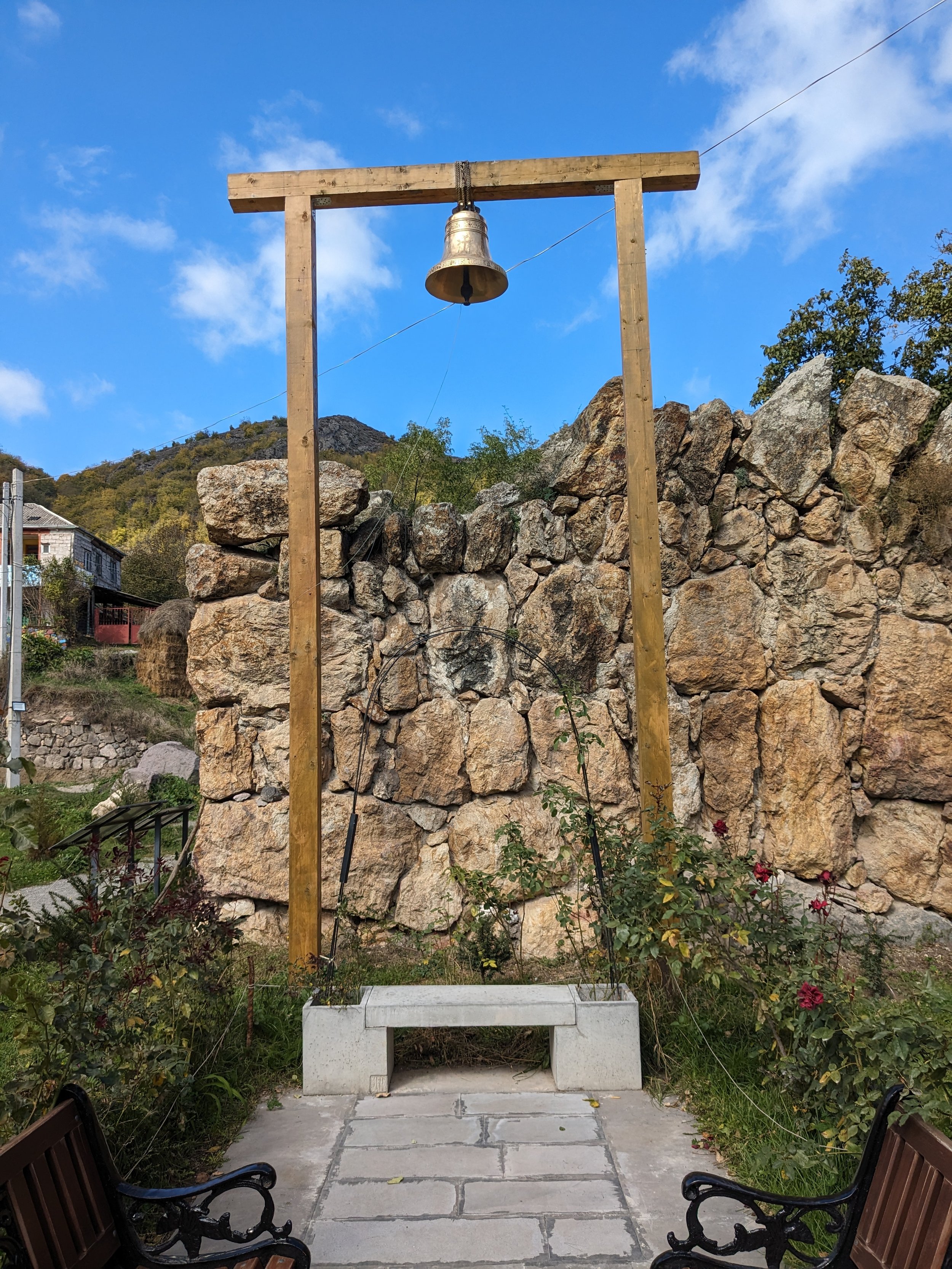
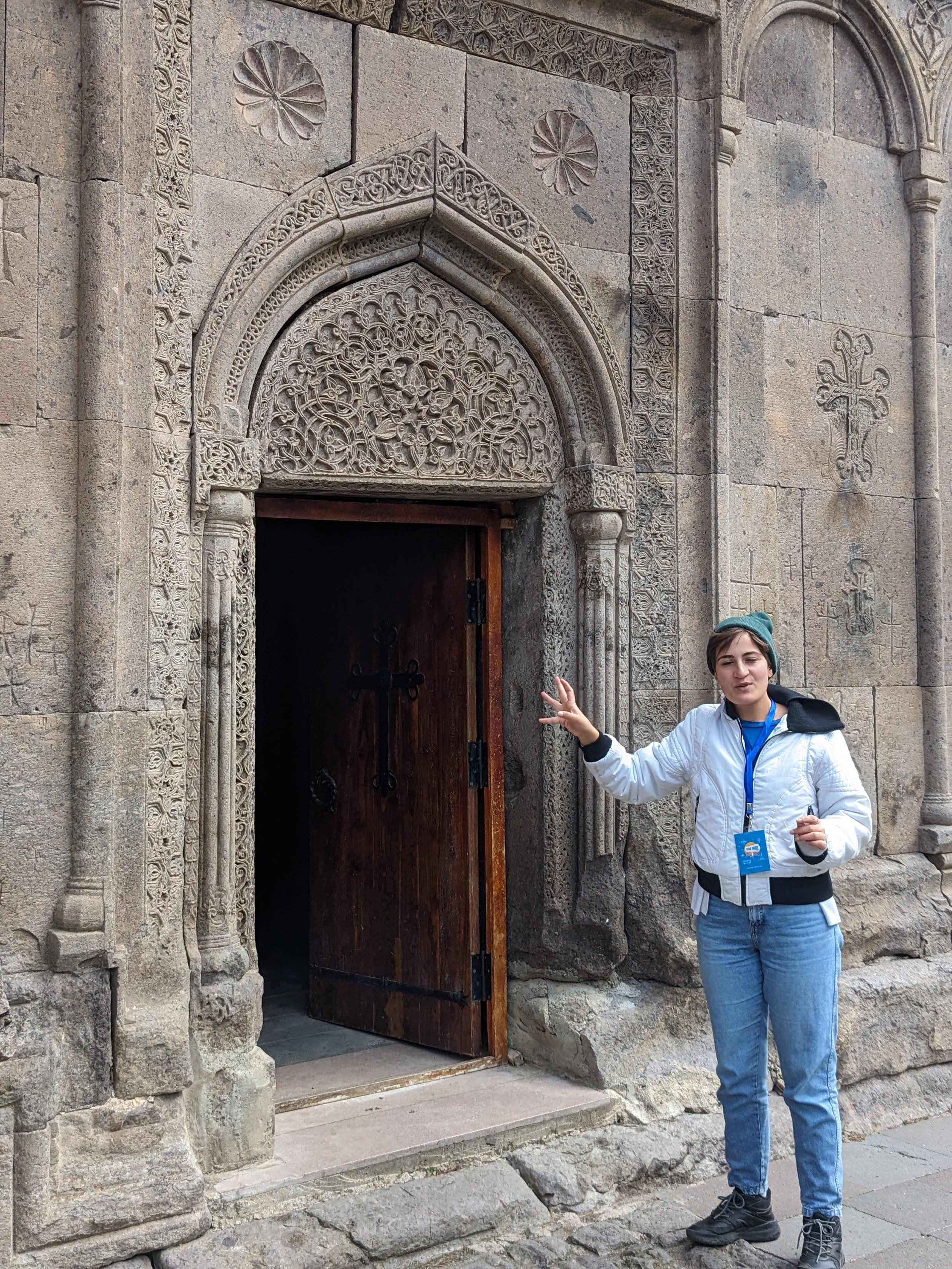
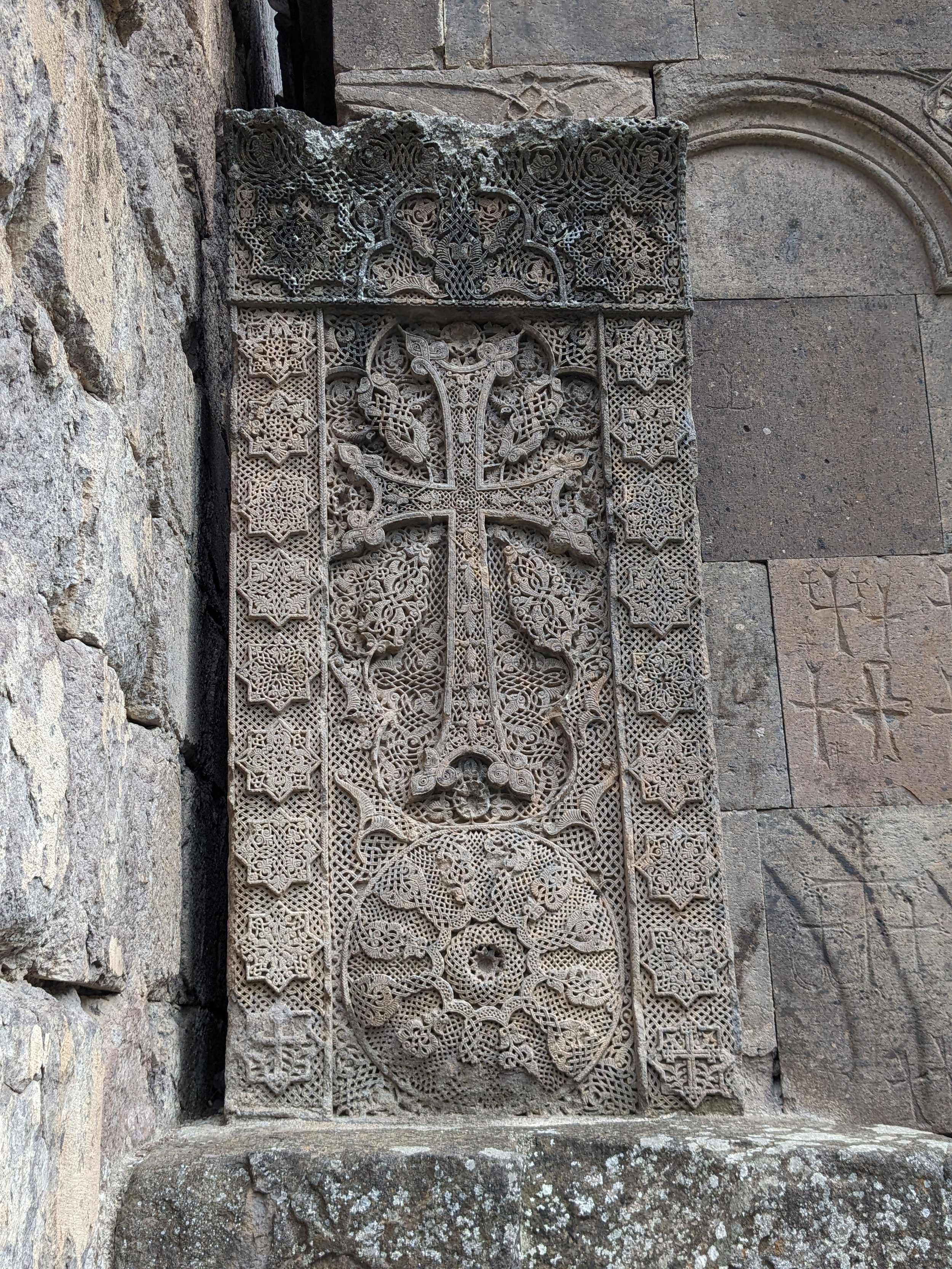
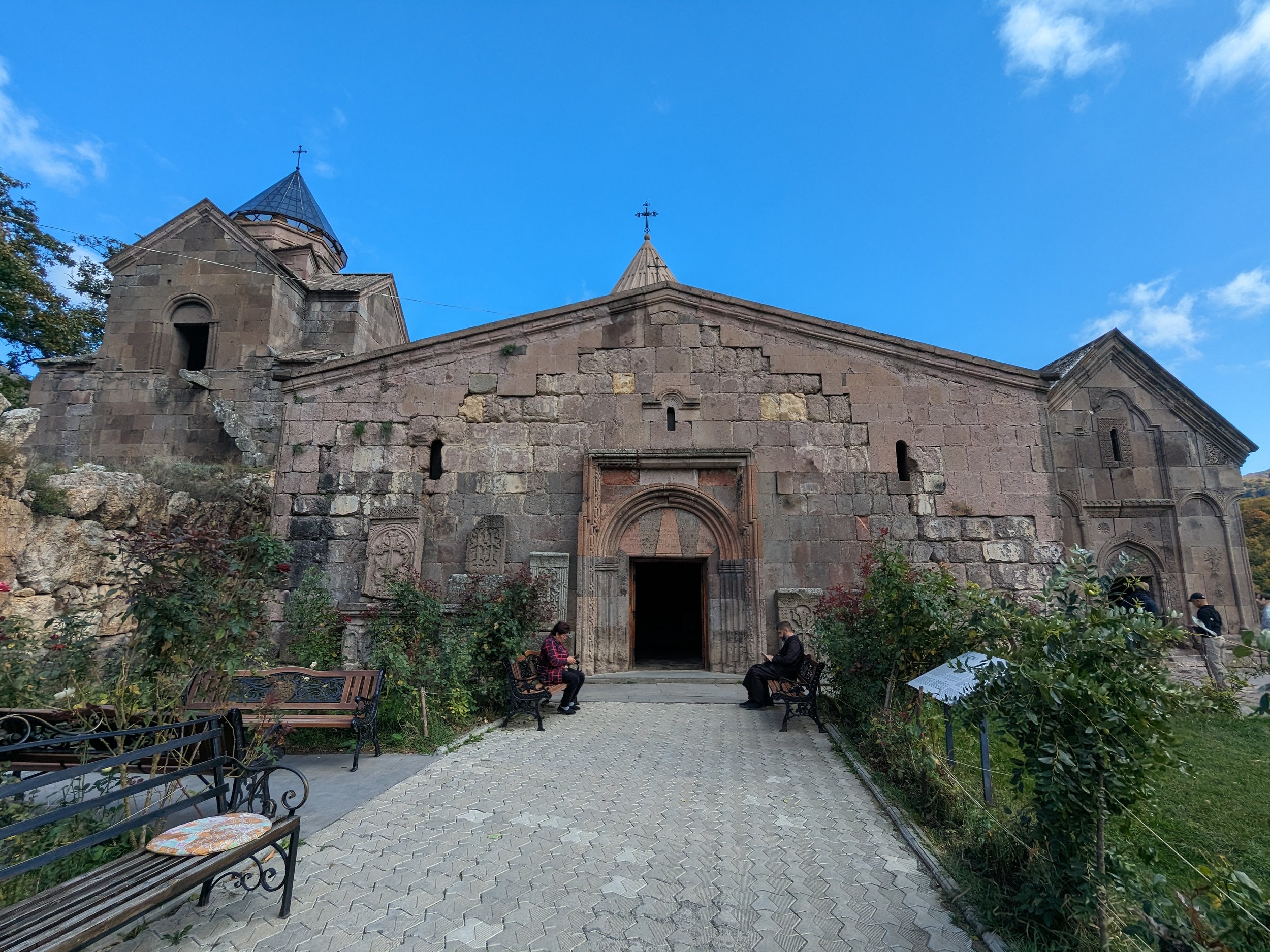
We continued our journey to the Haghartsin monastery. The way this church was situated in the orange and yellow hillside was breathtaking and reminiscent of New England falls. Funny enough, the monastery underwent key renovation thanks to the generosity of a Sheikh from the UAE!
Our excursion culminated in a stop at Dilijan National Park. Hugging our jackets tightly, we followed the trail and stomped through the wet leaves feeling right at home (Pacific Northwest).
Views from Dilijan National Park
Family House, Yerevan
This concludes our trek through the Caucasus.
The call of khinkali will bring us back to this region but for now, we turn our sights to the next adventure.
Armenia: An Ancient People with a History Marked by Tragedy
This piece was originally published in Nate’s weekly newsletter Takes & Typos October 17
Barev dzez (Hello in Armenian),
This week’s newsletter is coming on Tuesday because I was in transit back from Yerevan on Sunday. On the whole, our visit to Armenia was wonderful. The food, the history, and the brandy didn’t disappoint. Travel within the country is affordable, English is widely spoken, and if you can somehow make the trip you should. This week’s newsletter is a recap of my learning from the trip. It’s ¼ travelog and ¾ me reflecting on Armenia’s deep history and complicated present.
Last Thursday afternoon, I stood in a monastery two hours north of Yerevan, the Armenian capital. Our guide, Nina, was describing how the Mongols had burned all the books in the library as they swept through in the thirteenth century. As I listened, my brain started to collapse on itself contemplating the amount of history before us.
Yerevan pre-dates Rome and Armenians are ancient people, among the oldest continuous civilizations on earth, and everyday Armenians have a grasp of their collective history that I find beyond admirable.
We initially went to Georgia last fall because it was a cheap flight from here in Abu Dhabi. But this is now our third trip to the Caucuses. I caught a little bit of guff and some pointed questions at immigration about the prior Azerbaijan stamp in my passport and by entering Armenia, I believe I'm now banned from ever re-entering Azerbaijan. This is my first time being banned from a country, so I’m not quite sure how it all works.
A map of "Armenia" in the Ararat Distillery in Yerevan that includes the disputed territory of Nagorno-Karabakh/Artsakh; ethnic Armenians were forced out of the region by the Azeri military in September
We've dug into the history of the region in our successive trips. Armenia, like its neighboring states, is located at a geopolitical crossroads, trapped between great powers. Archaeological sites in Armenia date back as far as the Paleolithic Era (200,000 years ago). The Armenian Kingdom, then called Urartu, dates back to the Iron Age (861 BCE) and at various points they've found themselves under Roman, Mongol, Persian, Ottoman/Turkish, and Russian/Soviet occupation or rule.
A map of "Armenia" in the Ararat Distillery in Yerevan that includes the disputed territory of Nagorno-Karabakh/Artsakh; ethnic Armenians were forced out of the region by the Azeri military in September
The size and shape of what we call Armenia today are artifacts of those outsiders. As such, the territorial claims of recent Armenian history are broader than the land of the modern republic. Their strong sense of collective history, galvanized by the genocide of 1.5 million people in 1915, informs the way they talk about their country and their complicated relationship with their neighbors, in particular the modern states of Turkey and Azerbaijan.
The Tragedy of the Twentieth Century - From time to time nation's face existential questions. Armenia faced a pair in the twentieth century:
What happens when your desired political reality or collective national memory does not match the political or territorial reality on the ground?
What happens when you find yourself under the dominion of a greater military power and the global community ignores your calls for aid?
Nations facing these dilemmas can either accept the new reality, as the world is ostensibly encouraging Palestinians to do or they can forge—usually through violence—a different reality, as Israel did in the twentieth century and Azerbaijan did this fall in the disputed territory of Nagorno-Karabakh/Artsakh.
While traveling in the country, we heard repeated references to "Western Armenia"— the territory, larger than the current state of Armenia, lost to the modern state of Turkey, largely as a result of the 1915 genocide. This land claim includes Mount Ararat, a national symbol for the country, and purported to be the mountain on which Noah disembarked after the Old Testament flood. Boundary making by Russia and Turkey Post-World War I nullified claims to Western Armenia. Imagine if Canada committed genocide in the Dakotas and kept Mount Rushmore. You can’t even fathom it.
The Monastery at Sevan Lake, built in 874
The Monastery at Sevan Lake, built in 874
We also heard references to “Historical Armenia”—considered to be the territory within and bordering the country where the plurality of the populace are ethnic Armenians. This includes Western Armenia, parts of Georgia, and ethnic enclaves in neighboring Azerbaijan. Notably, up until the middle of last month, ethnic Armenians made up the majority of the population in the region of Nagorno-Karabakh. However, those claims were largely extinguished by Azeri military forces, creating over 100,000 refugees.
What happened in September in Nagorno-Karabakh was the end of a conflict that’s simmered on & off since the fall of the Soviet Union. Ian Bremmer summarized recent events in his GZERO Newsletter:
On Sept. 19, Azerbaijan launched a ground and artillery offensive to take full control of Nagorno-Karabakh after what it claimed were terrorist attacks on Azeri civilians by Karabakh Armenians. Moscow, occupied by its own war and chafed at Yerevan’s growing alignment with the West, did not intervene on behalf of the ethnic Armenians in Nagorno-Karabakh. Neither did Yerevan. Within 24 hours, the overwhelmingly superior Azerbaijani military had killed more than 200, injured 400, and forced the local Armenian authorities to surrender, leaving Azerbaijan in effective control of the territory.
Yerevan
The menu at Dolmama, an Armenian restaurant that Anthony Bourdain visited in an episode of Parts Unknown, features "Historical Armenia," including Nagorno-Karabakh and Azeri territory.
It feels like Armenia has come to grips with the loss of its western territory. But it is still noticeably (and understandably) grappling with the loss of Nagorno-Karabakh, where they feel ethnic Armenians were abandoned by the West, Russia (Armenia's purported ally), and the government in Yerevan led by PM Nikol Pashinyan.
When looking at Aremina’s past & present, there are corollaries to both sides in the conflict currently raging in Palestine. The modern state of Israel was created in the aftermath of the genocide in Europe, modeled on the Aremenian Genocide. And the Palestinian people, like the Armenians, find themselves at the mercy of a foe with superior military force, bent on extinguishing their land claims (more on that in next week’s newsletter).
There and Back Again-- A Final 2023 World Cup Dispatch
This post was originally published in Nate’s newsletter on August 6
Our view of the tournament opener in Auckland, where the host Football Ferns upset Norway
I really hate when I am right when I wish I was wrong. I ended last week’s newsletter by saying the US needed a win in their final group stage match in order to avoid Sweden in the round of 16. The US didn’t get that result, squeaking out a scoreless draw against Portugal. That dropped them into second place in Group E, behind the Netherlands, setting up today’s match against Sweden that the US lost in PKs. This is the earliest World Cup exit from the US in recent memory and likely brings an inauspicious end to the tenure of Coach Vlatko Andonovski and this generation of USWNT players. I don’t want to dwell too much on the loss. I’ll leave that to others. I had a great time in New Zealand, so instead I want to leave with some final takeaways from our visit.
Aotearoa (Land of the King White Cloud), is a country the size of the US state of Colorado with the population of South Carolina, more often referred to as New Zealand. The entire country is a series of volcanoes. This plays cool tricks with the topography, creating soaring peaks, numerous active volcanoes, and thermal & hot springs that litter the landscape. New Zealand is made up of two main islands and is packed with more beauty than I can begin to describe. The North Island, where we spent our time, is roughly the size of the Western half of Washington State and shares a similar climate and mild winter. But the landscape is more varied. For folks back home, imagine if our "wet side" of Washington had ten mountains the size of Mount Baker, a Glacier National Park, and a Yellowstone all jammed inside.
The landscape in New Zealand is gorgeous and goes on like this for hours between Auckland and Wellington
Because we’re city folk and came for football, we spent most of our time in Auckland and Wellington, the commercial and political capitals respectively. But we also ventured into the rural areas in the middle of the island and witnessed some of the natural beauty. We toured thermal springs turned every shade of the rainbow by sulfur and other gasses. We also did two tours of caverns. Our second tour was by boat—yeah, you read that right: river rafting in a massive cave in the dark. We got a fair amount of windshield time covering over 1000 miles in just under two weeks. I was most struck by the rolling hills that looked like they were drawn by the video game engine in Red Dead Redemption 2.
The Maori and surviving conquest - My biggest area of learning this trip was about the history of the Maori people. For those unaware, the Maori are the original occupants of New Zealand and make up about 15% of the population. Most Maori can trace their genealogy back to a series of seven canoes, called Waka, that arrived in the 1300s. Those seven canoes are the basis for the Iwi (or tribal identity). Maoris are Polynesian people, sharing an ancestry with the people of Samoa, Tonga, Tuvalu, the Cook Islands, and native Hawaiians.
Our raft in the Waitomo Caves, near Te Kuiti
Arguably, they are one of the most successful survivors of conquest in the post-colonial world. They weren’t decimated by disease like the indigenous people in the US; they weren’t ruled under an Apartheid state well into the 1990s like in South Africa; they don’t live under a state of permanent occupation like Uyghurs and Tibetans in China. Don’t mishear me—I haven't been propagandized by the Kiwi state. But Maoris are largely integrated into New Zealand society, while retaining key elements of their cultural heritage and traditions and unlike many conquered people, they’ve largely managed to retain their language*, called te reo.
There are Maori language newscasts, radio stations, reality TV shows (bad ones tho), and official Maori dubs of Disney animated films. Each match at the World Cup opened with a Maori song, as a form of land acknowledgement and welcome to Maori lands. I noted the typical Kiwi is far more conversant in Marori culture, history, and placenames than people where I’m from are about the history and culture of the S’Puyalupubsh (generous and welcoming people) and Squalli-Absch (people of the grass). The US’ commitment to the eradication of native culture was a core value at the country's founding that largely endures to today. However in New Zealand, there are initiatives underway to make Maori language instruction compulsory in schools. This one really gets me: can you imagine the meltdown the culture warriors of the American right would have over their kids being taught the languages of the native people in the US? It would make the Common Core Wars look like Chutes & Ladders.
The sulfur infused Devil's Bath in Wai-O-Tapu Park.It looks like Gatorade and smells like hell
Yo, why are all the bartenders from Ireland? Something else I learned about in New Zealand is the Working Holiday Visa Program. If you’re between 18-30 years old and from a select number of countries, including the US, you are able to secure an up to 18 month visa to travel to New Zealand and engage in temporary employment. Most tourist visas are for 30 or 90 days and forbid you from taking on any form of employment but with this program, people get to experience New Zealand's culture and lifestyle while supplementing their travel expenses.
Consequently, most of the bartenders and servers we encountered were from Ireland, the UK, and rural parts of the US. One person we talked to, from Southern Arkansas, was on their third of these visas, previously working at restaurants in Australia and Brazil. It seems like the perfect thing for a kid on a gap year or someone who is burned out working in the service industry in the States.
*Maori appears easier to learn than most languages: there are only 13 letters in the alphabet and phonetic patterns are predictable. An “A” makes one sound, unless it is marked as “Ā” then it makes another sound. No guesswork like with the “A” sound like there is in English “gas” vs “was” vs “swap.”
These Sheep Ain't Gon' Shear Themselves- A 2023 World Cup Dispatch
This post was originally published in Nate’s newsletter on July 29
The Running of the Sheep, Te Kuiti
The Running of the Sheep
I bring you greetings from a rented farmhouse in the sheep shearing capital of the world, Te Kuiti, New Zealand. Te Kuiti used to be the home of the annual Running of the Sheep but the festival was discontinued this year (yeah, I am bummed about it too).
Since we last corresponded, after taking a detour to Hobbiton, Hope and I have traveled the 400-ish miles from Auckland down to the capital, Wellington. Wellington is lovely. It is a city the size of Tacoma but more hilly and cosmopolitan. We arrived on Tuesday, taking in two matches at Sky Stadium and are now winding our way back north for a final pair in Auckland.
Our football odyssey has been exciting. Here’s a rundown:
We watched the host nation, Lady Ferns, upset Norway in front of an ecstatic crowd of Kiwis in Auckland in the tournament opener in Eden Park.
Sky Stadium, called the Pie because of its resemblance to a disposable pie tin, is the site of World Cup matches in Wellington
We next watched an uninspiring but professional USWNT performance against Vietnam, defeating them 3-0 at Eden Park. I fear the US showing in this match was a portend of the unfortunate first half against the Netherlands.
On Tuesday at Sky Park in Wellington, we witnessed possibly the match of the tournament as the Philippines returned the upset favor to New Zealand in a classic 1-0 smash & grab. In the second half, the Philippines played some of the most cynical, time-wasting-y football I’ve seen in my life. But it paid off. They won and the entire country (and assorted Filipino diaspora) celebrated their first ever World Cup victory.
Most recently, again in Sky Park, in a rematch of the 2019 World Cup Final, we saw the US draw against the Netherlands. The US peppered the Dutch goal before going down 0-1 in the first half. They established firmer tactical footing in the second half, with Lindsey Horan scoring the equalizer in the 63rd, but the match ended in a draw. The result left many USWNT fans (myself included) nervous.
We spent last night at the foot of Mount Doom from Lord of the Rings and will arrive back in Auckland tomorrow for the Philippines vs Norway. If the Philippines can pull off another upset, the Cinderellas from Manilla will advance to the knockout rounds.
Our final match will be the US vs Portugal. The US needs to secure a victory if they want to win Group E. But the Dutch face a weaker opponent, Vietnam, in their deciding match and thus have an inside shot at a higher seed for the knockouts round.
Mount Doom (Mount Ngauruhoe) in the Tongariro National Park on Saturday
If the US comes in second, they likely face number two ranked Sweden in the round of 16. If they win the group, they would face the 14th ranked Italians.
Life and Learning in These Kiwi Streets
New Zealand is culturally diverse: the white majority are descendants of British and Dutch settlers. There are also nearly one million Maoris, the descendants of Polynesians who settled on the islands in the 14th century. As we’ve found in previous travels in ex-British Colonial territories like Singapore and Malaysia, there are high numbers of South Asians and ethnic Chinese people who have been here since the 1800s. Like in the Gulf, people from South East Asia, especially the Philippines and Vietnam have settled here in recent decades. But beloved, I have never been in a place so bereft of Black people. I saw more Black people when we traveled through China. Hell, there are more Black Republican members of Congress than there are in these Kiwi streets. This has resulted in some odd looks, particularly in the more rural parts of the country, but everyone has kept it one hundred thus far. Although, not even my family says “yah, brotha” to me as much as dudes of all stripes here.
One element of this trip that I am dying to talk about at length either on the podcast or in a subsequent newsletter is the history and current status of Maori people in New Zealand Society. In many ways, they are among the most successful people groups in the world at weathering colonization but in others there are clear barriers to be overcome. We visited a Maori village and had a traditional meal (Hāngī) while visiting Rotorua. I felt like an idiot for not knowing most of the info we were taught that evening and I walked out of the village with a ton of questions but those will have to wait for another time.
You Owe It To Yourself to Watch Women's Soccer & The World Cup
This post was originally published in Nate’s newsletter on July 21
Jet lag is real.
At some point yesterday, I looked at Hope and realized I had no idea what day (or day of the week) it was. Our road to Auckland was silly (Seattle to Dubai to Singapore to Sydney to Auckland) but was necessitated by life circumstances and the packing/clothing requirements of going from northern hemisphere summer to southern hemisphere winter. Tonight when we go to sleep will be the first time we’ve spent back-to-back nights in a bed since June 15. I am far too old for all these red eye flights.
But we made it—I’m stoked for our third World Cup.
Our seats in BC Place in Vancouver for the group stages in 2015
Last night, we were in Eden Park for the tournament's opening match. The hosts, the twenty-sixth ranked, New Zealand knocked off twelfth ranked Norway, 1-nil. Tomorrow we’ll return to Eden Park for the opening match for the US versus Vietnam (if you have access to a sportsbook, I suggest you bet the over, +/-6.5 goals).
As often is the case in my life, plans came together one night at a pub. While talking with some friends, we decided we should head up to Vancouver when Canada hosted the World Cup in 2015. We caught a few matches and really enjoyed the atmosphere. We decided on the drive back to Tacoma to make this our thing.
In 2019, the tournament was in France. We followed the US through the knockout rounds. The atmosphere at PSG’s Parc des Princes in the quarterfinal was electric, as tense as any football match I’ve ever attended. I have never heard anything as loud as the French crowd’s eruption when Wendie Renard scored in the 81st minute. The match result was in doubt deep into the match. We went to watch the US defeat England in the semi and the Netherlands in Lyon in the final.
Hope and I in Lyon before the 2019 final
In some ways, high-level women’s soccer is the best sporting experience in the world.
Players are accessible. I can’t imagine ever sitting down with Messi for an hour long chit-chat. But I interviewed arguably the best WOSO player in the world, Megan Rapinoe for an episode of Nerd Farmer. Several players from OL Reign (Seattle’s team in the NWSL, the professional WOSO league in the US) lived at Point Ruston before the team relocated to Seattle; a few players still live there.
The matches are affordable. Our tickets to last night’s opener were 30 Australian Dollars or about 20 USD ($20.29, if you’re nosey)—you can’t get in to see the Mariners lose for that much.
The US women are dominant. If you like winning, the United States is the Argentina + Brazil + Germany of WOSO. They enter the tournament seeking their third consecutive World Cup title. Meanwhile, the American men haven’t gotten out of the round of sixteen since 2002.
The game is at a really special point. It’s like the old baseball Negro Leagues or the ABA in the 1970s—arguably a better product—with less hype or recognition.
This can’t last.
In the book The Ball is Round: A Global History of Soccer by David Goldblat, he argues sports go through a transition from amateurism to professionalization to commercialization. WOSO in the US is professionalized. Players get paid (not enough, obviously). They play in professional facilities (I hated when OL Reign left Tacoma but they deserve to play on the same pitch as the region’s men’s team). They have a national TV deal with CBS/Paramount and are increasingly drawing larger audiences. There’s work to be done but with these structures in place, players have the chance to showcase their talent on grand stages.
But commercialization is coming.
The players deserve it but it will degrade the accessibility and affordability fans currently enjoy. Picture Alexi Lalas (bleck) bellowing “we’re coming to you live from the Subway Fresh Take Studios, here alongside the Raytheon Pitch at Facebook Stadium.” All the gross capitalistic trappings that have consumed European football and the big three US sports leagues are coming, but the barbarians aren’t quite there yet.
The US women kickoff tomorrow against Vietnam at 1pm from Eden Park here in Auckland. I’ll be there and you should be watching.
We Came, We Saw(adee), We Snacked
Happy Sweaty 13th!
Another year, another spring break, another day to travel with my favorite person
The thing about Thailand is once you're there you don't want to leave. Ever. It doesn't matter where you call home. Thailand finds its place in your heart.
In the early 2000s, the Thai government engaged in “culinary diplomacy: winning hearts and minds through the stomach”, sponsoring thousands of Thai restaurants launched across the globe. Honestly, it was brilliant. Combine that with films such as Anna & the King (1999), The Beach (2000), Ong-Bak (2003), Beautiful Boxer (2003), Tropical Madald (2004), and Love of Siam (2007), many in the West were inundated with the sounds, sights, and smells of Thailand.
Thailand holds a special place for us because in 2018 we were sitting in the back of a songthaew (Thai bus for medium length trips) and adorable uniformed Thai children jumped on. Someone said "I could teach the mess out of those kids" and by the end of the summer, we had our applications in at Search Associates.
That summer we let the spirit lead our trip. We wandered the streets of Bangkok and sands of Phuket and Ao Nang. Then, we hopped over to Malaysia exploring Penang and Kuala Lumpur before we flew to Cambodia spending a week in Phnom Penh and Sihanoukville.
This time, we limited our 12 days to three stops– Bangkok (central), Chiangmai (north) and Koh Lanta (south).
In many ways our experiences in Thailand are much like its cuisine—a perfect balance of sweet, sour, salty, and spicy. From the generosity of Thai people (sweet) to the gorgeous beaches on every coastline (salty) to the sweat trickling down your back as you sit in traffic (sour) and the som tam filling your stomach (literally spicy).
The best part of visiting somewhere more than once is you don’t have the “have to do” or “you must see” pressure or guilt. Instead, you can branch out to lesser known experiences or choose to get two massages on the beach in one day just because you feel like it.
Careening through the streets of Bangkok in style
Bangkok, Central Thailand
A few friends recommended this Trip Advisor tour and it did not disappoint. Shuffled around the city in style, we ate sampled dish after dish. Feast your eyes on some of our favorite items.
Chiangmai, Northern Thailand
“Go to the north” they said. “It will be cooler” they said. We did. It was not. In fact, we learned that March is prime burning season, with smoke billowing in from Myanmar and Laos. Needless to say, we donned our masks and made the best of our four days spending our time at a Mui Thai fight, learning how to cook a few dishes at a culinary school, and scrubbing an elephant at the HUG Elephant Sanctuary (well, Hope did that while Nate took photos from the safety of dry land).
Koh Lanta, Southern Thailand
It’s super easy to top off the gas tank!
The last few days of the trip we wanted something slower and low key. With blue skies and cool breezes, Koh Lanta was perfect. Not much to report here beyond if you’ve ever thought about staying at an “adults only” hotel, you should. The absence of children screaming was peace we didn’t know we needed. We did spend a day joy-riding on mopeds.
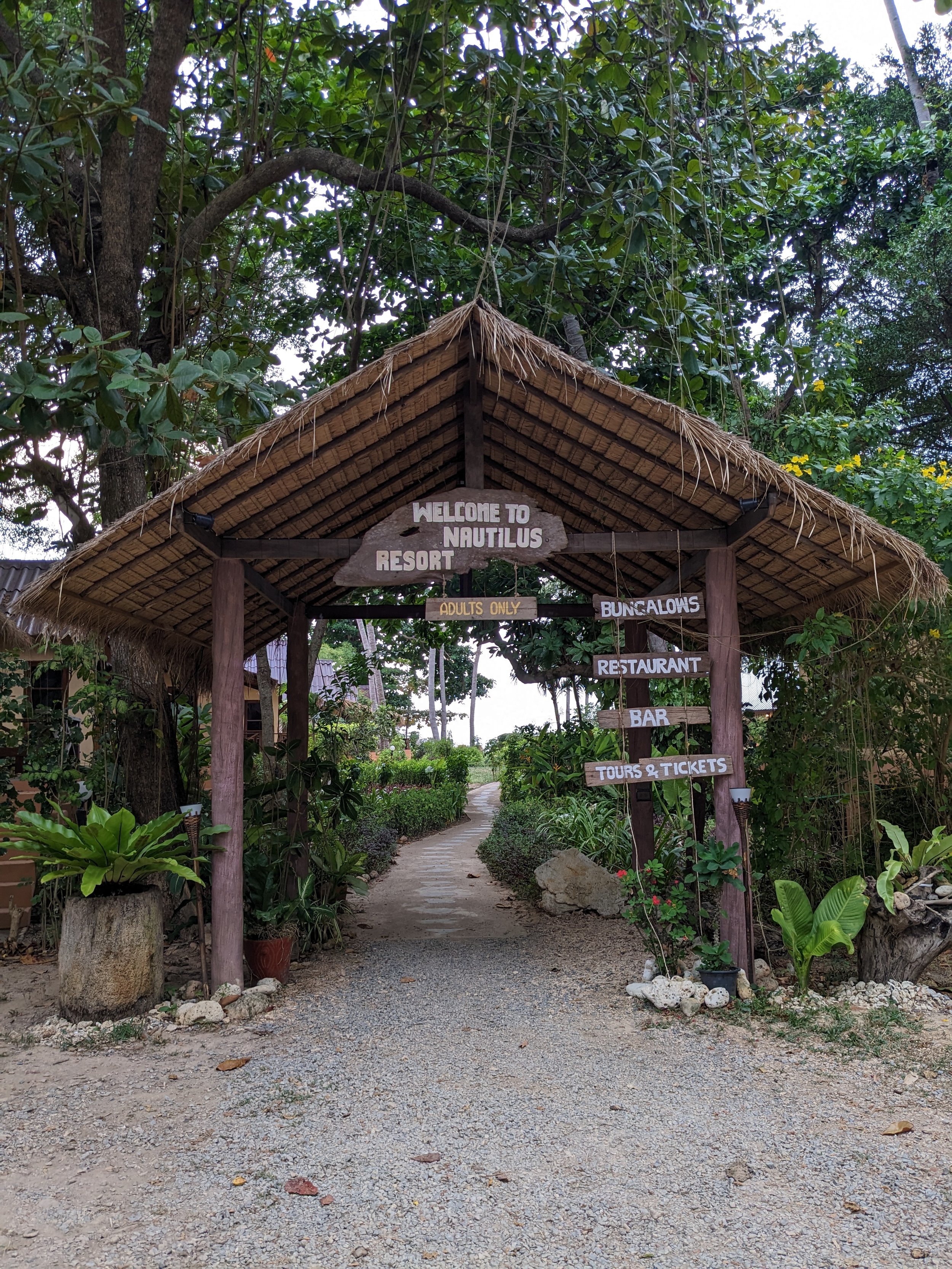
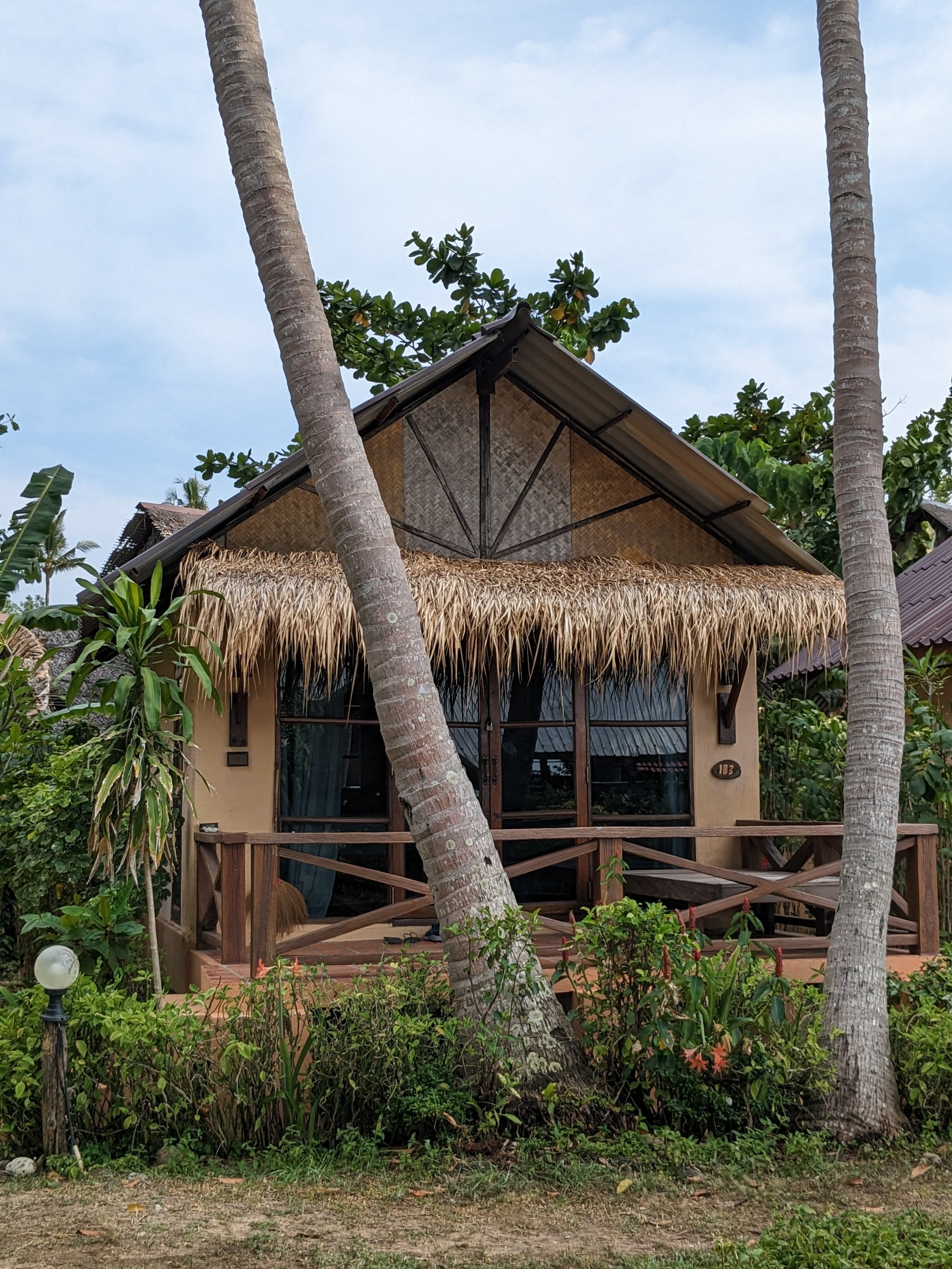
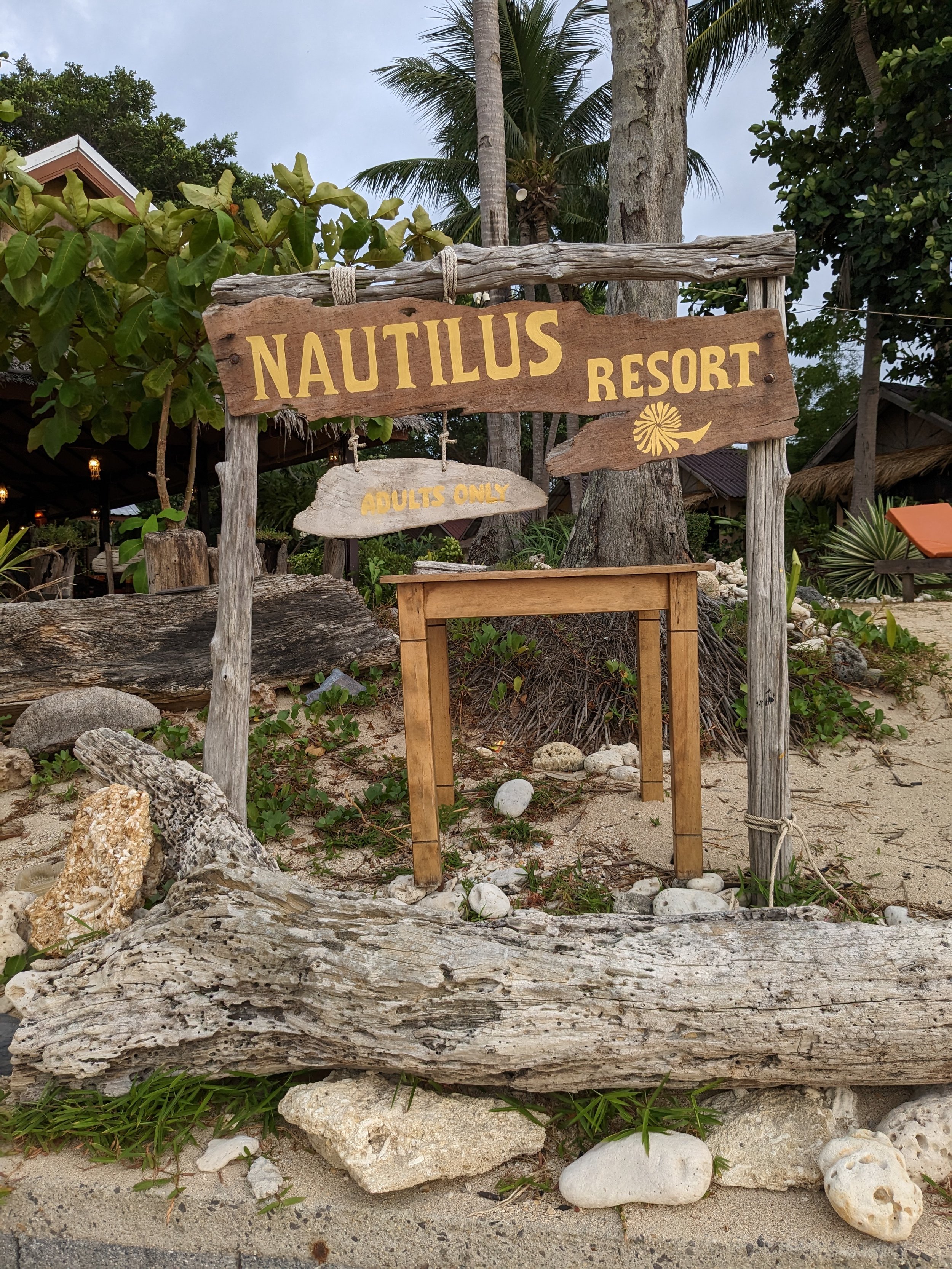
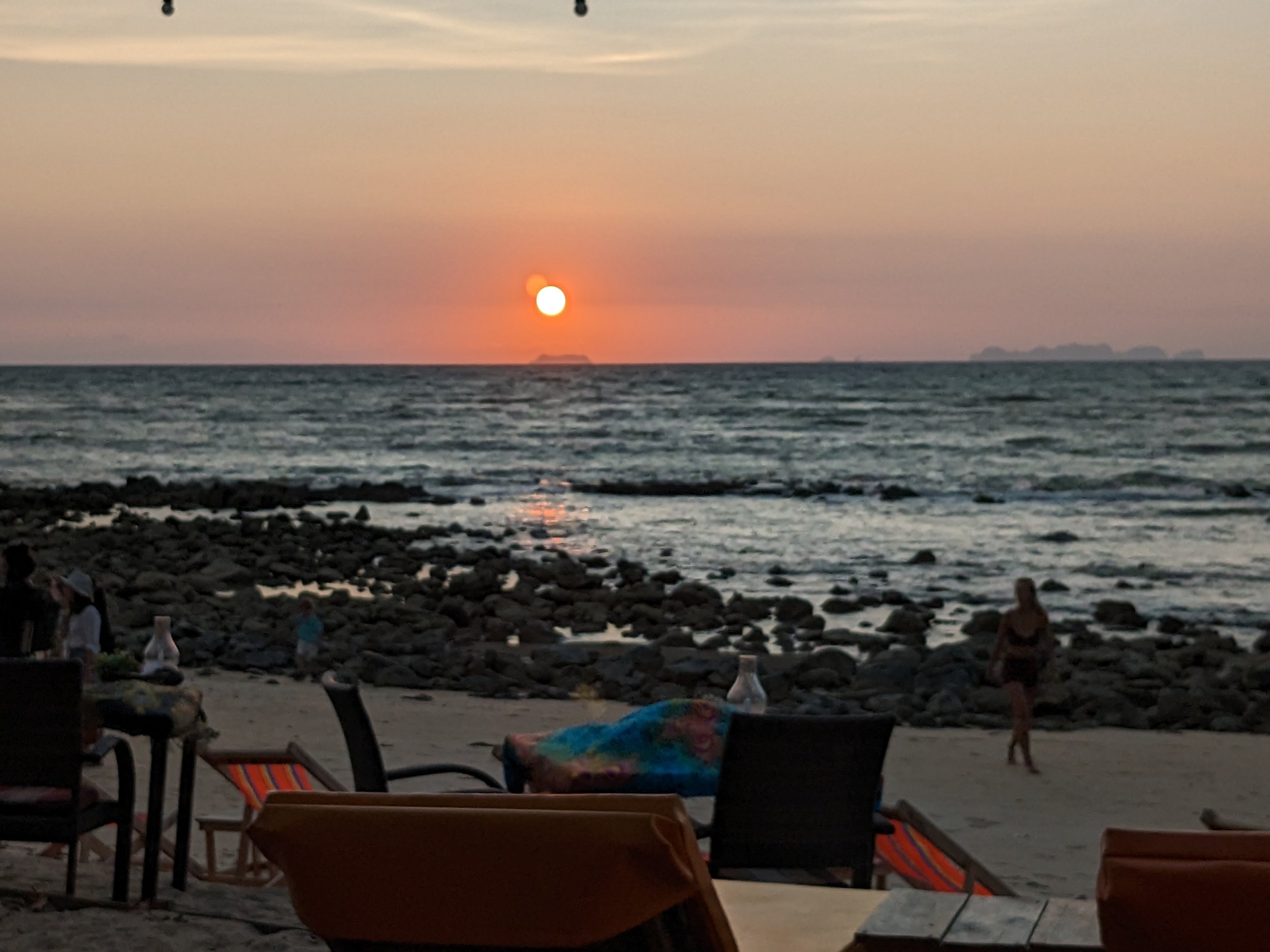
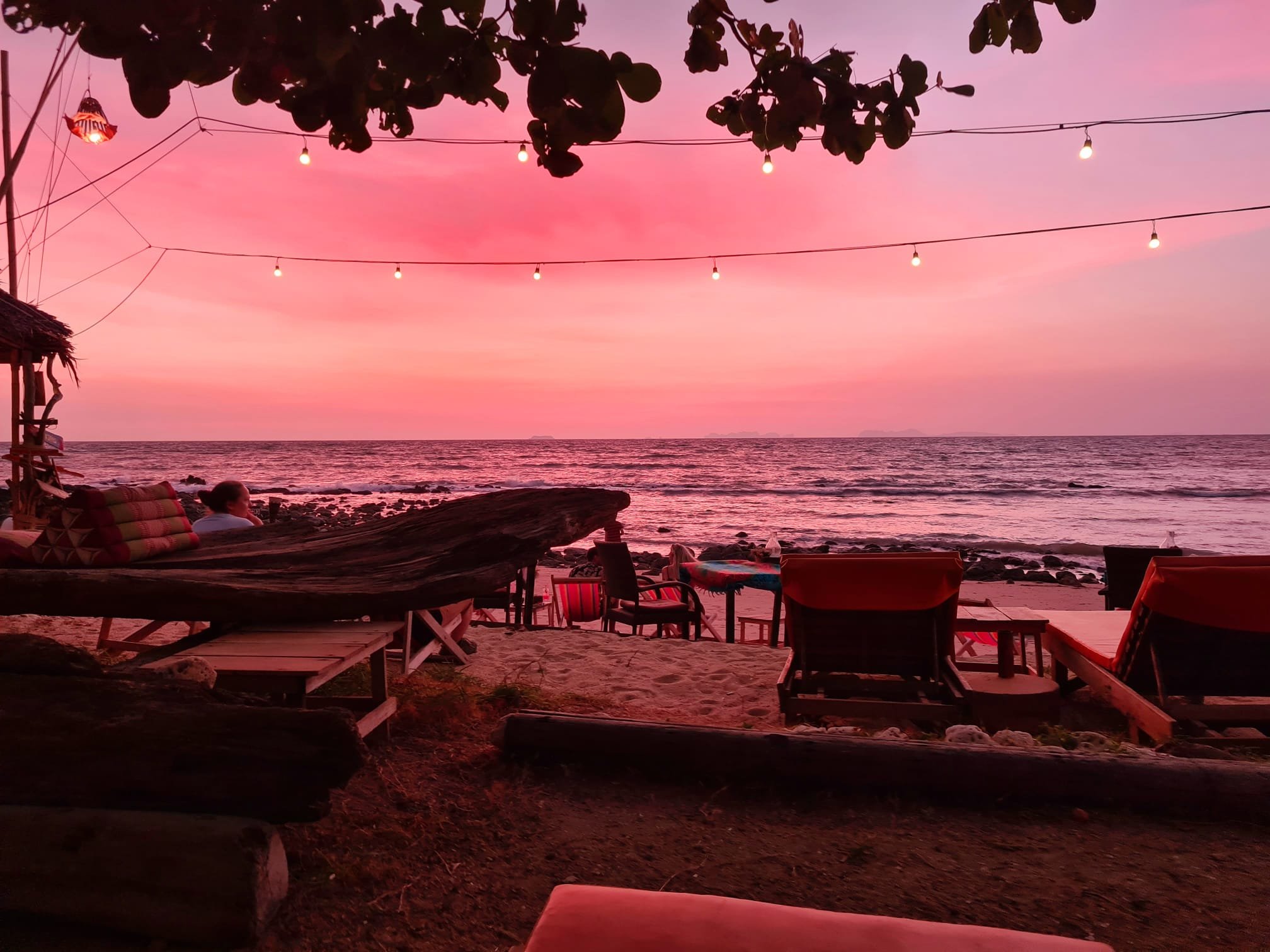
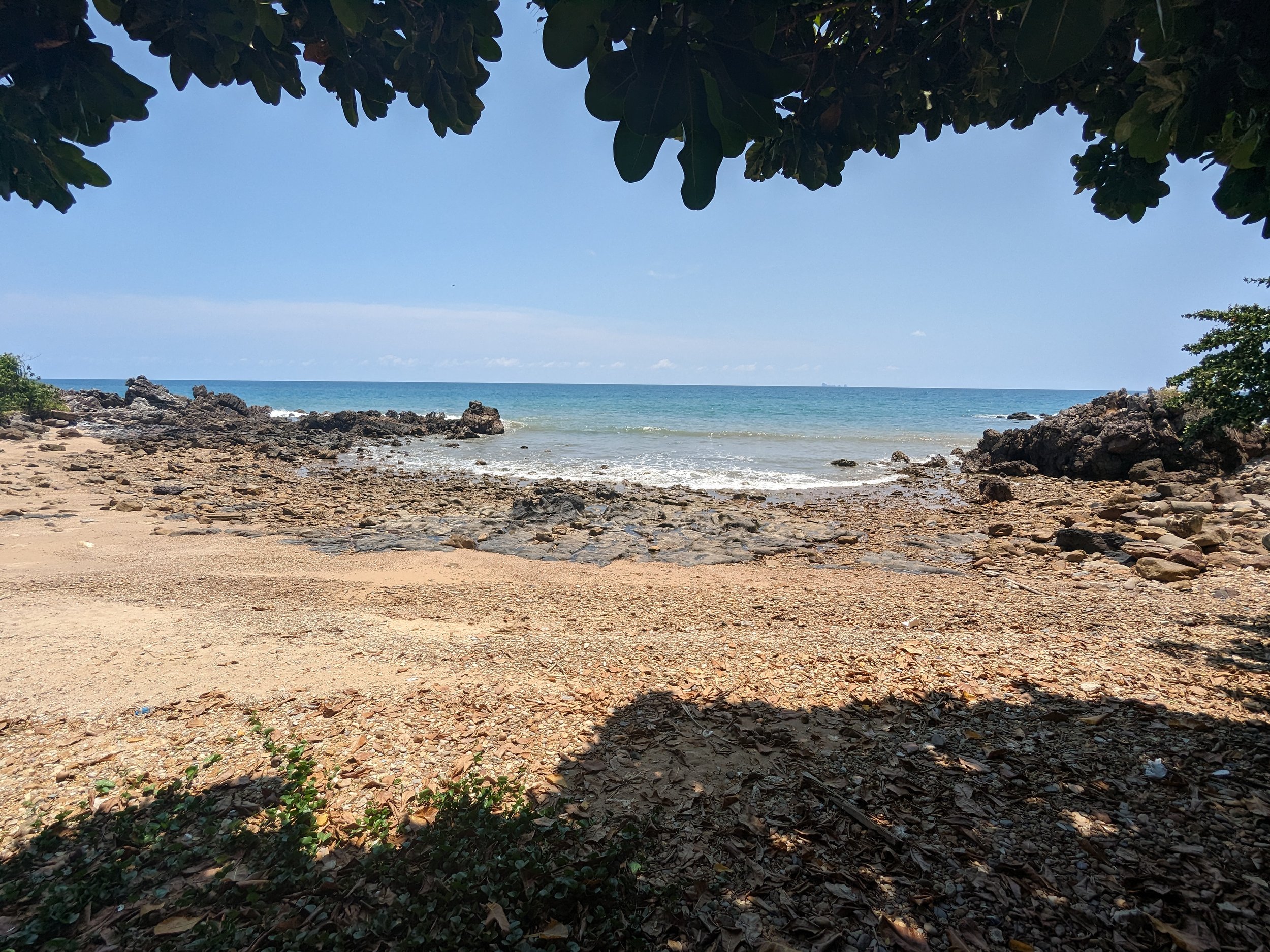
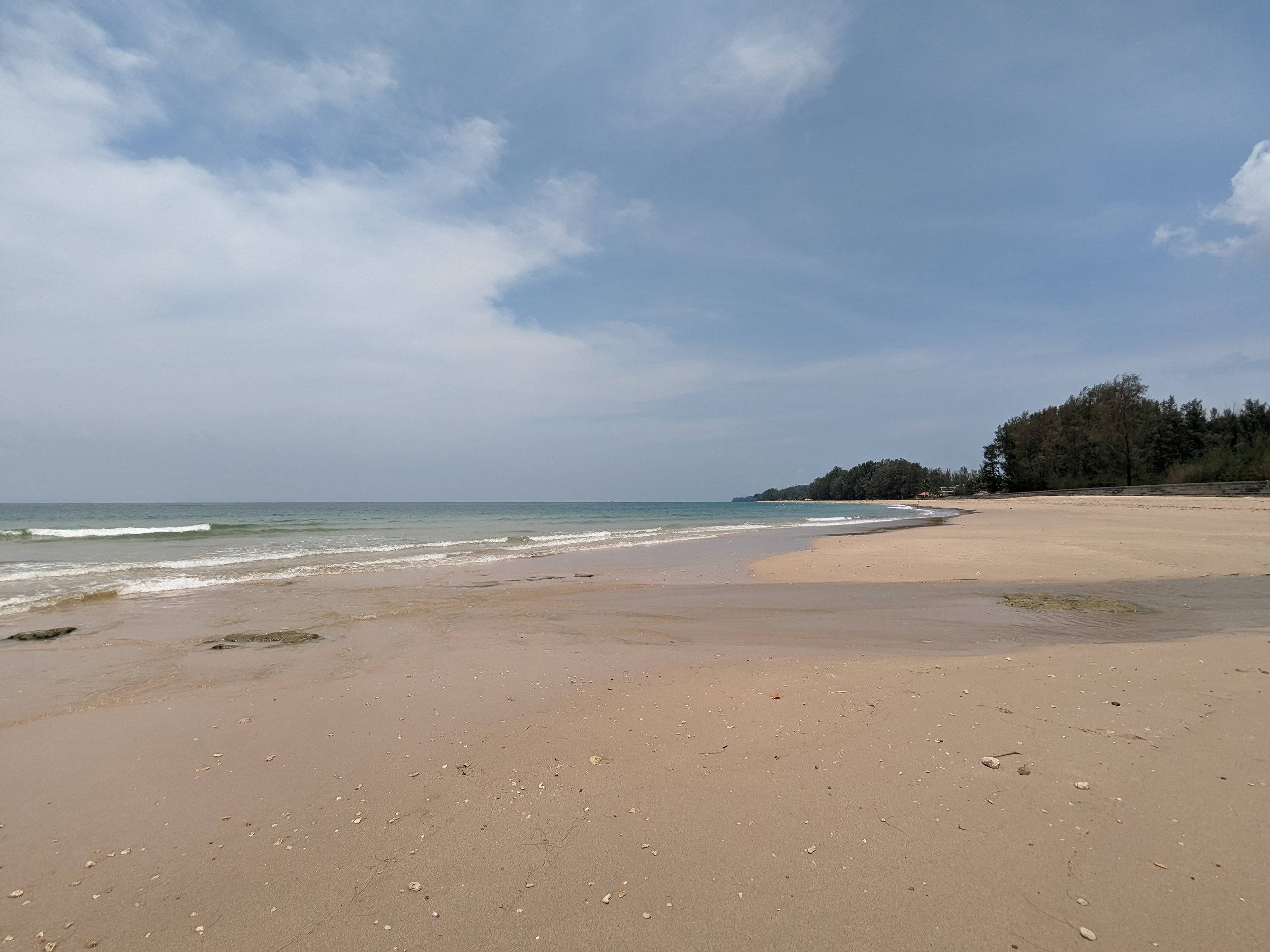
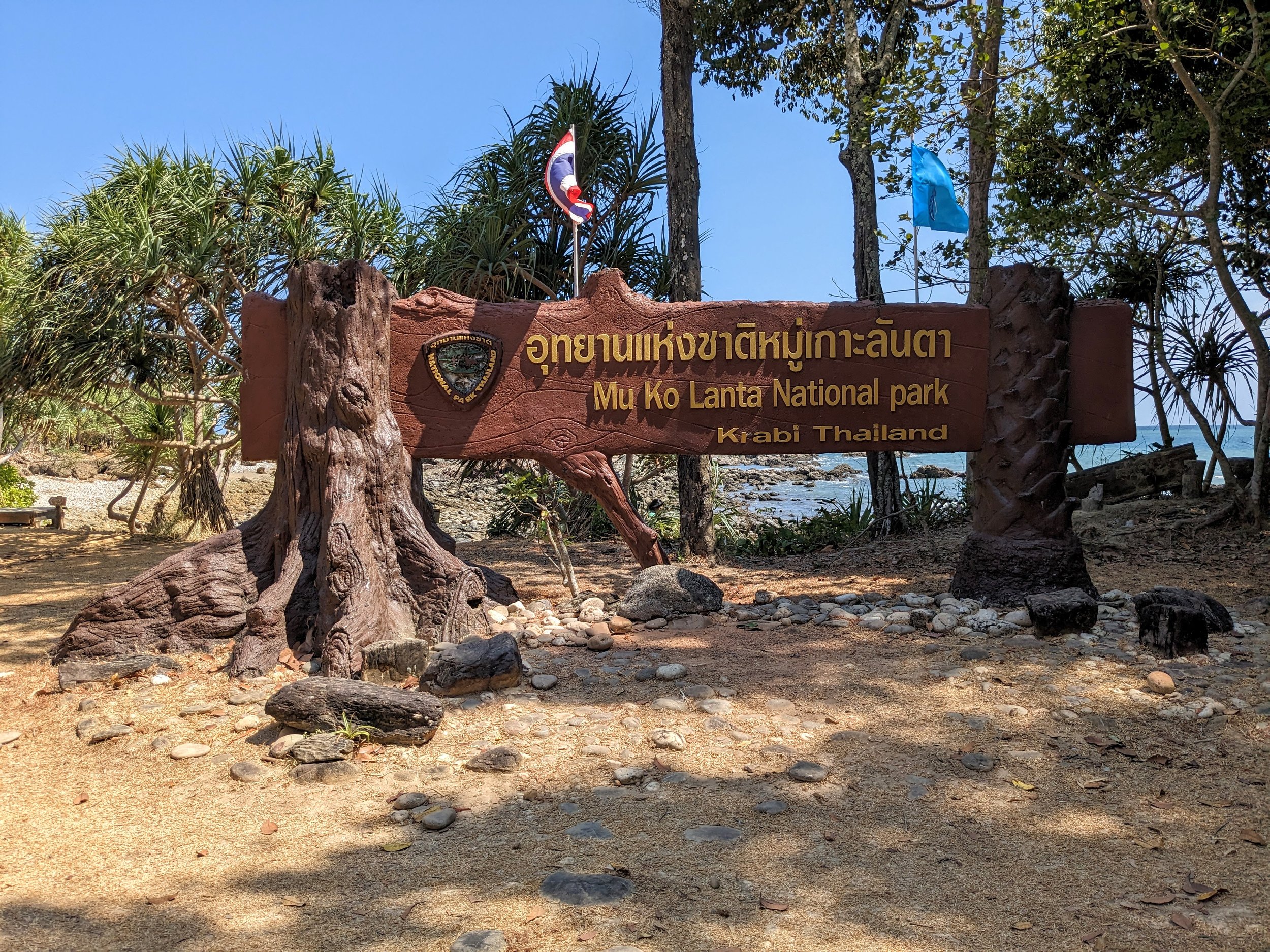
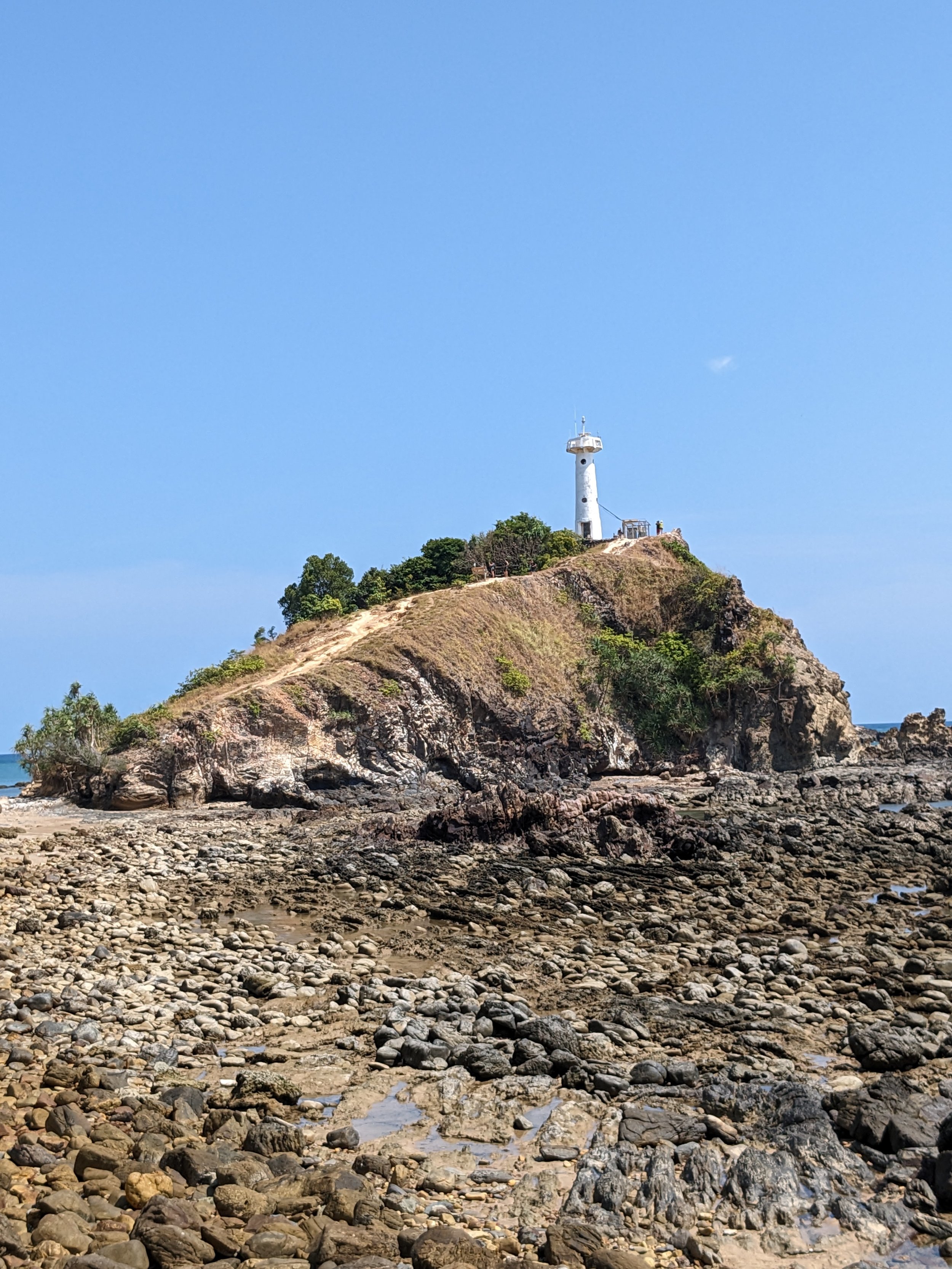
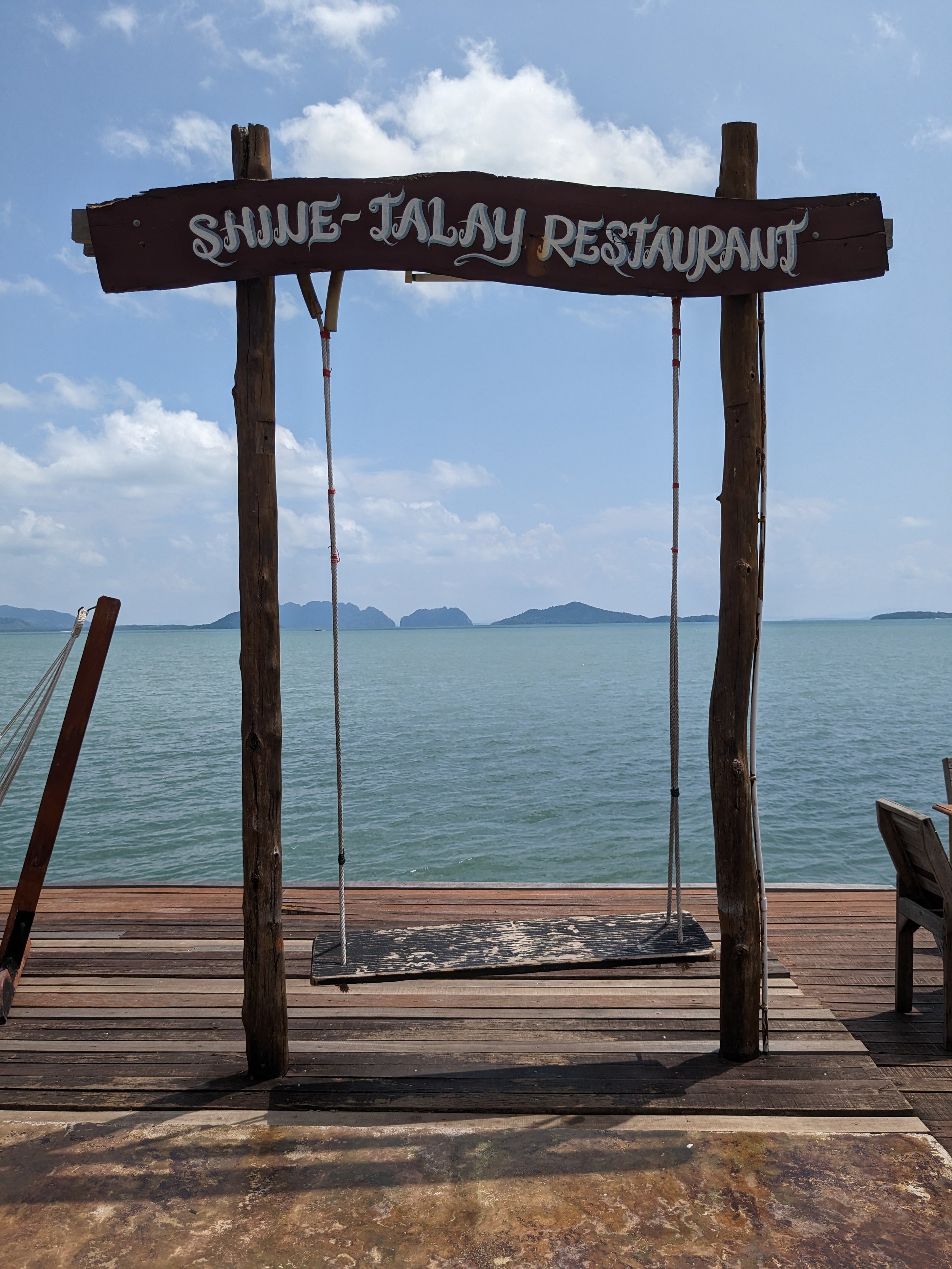
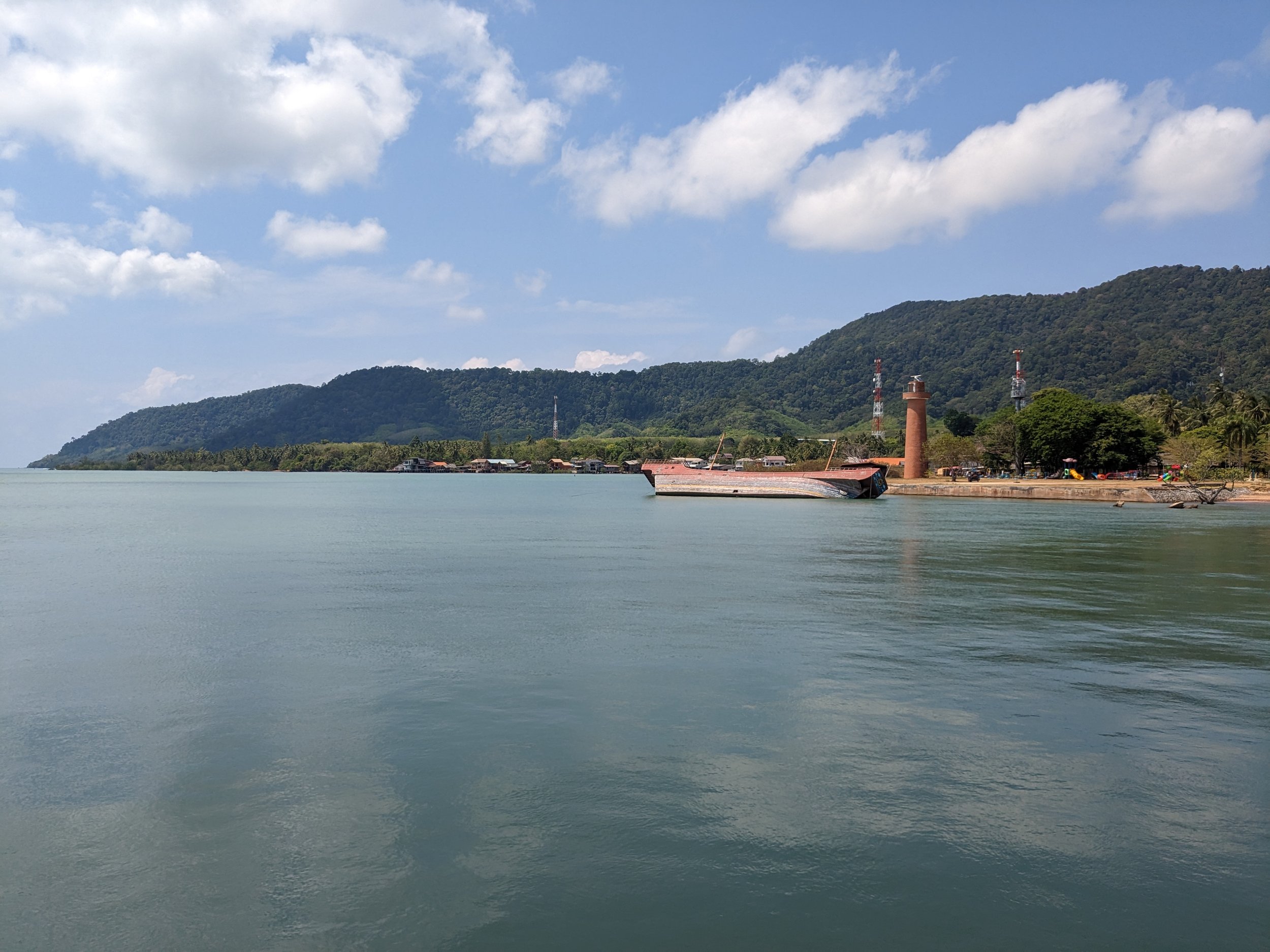

เจอกันคราวหน้า (see you next time!)
